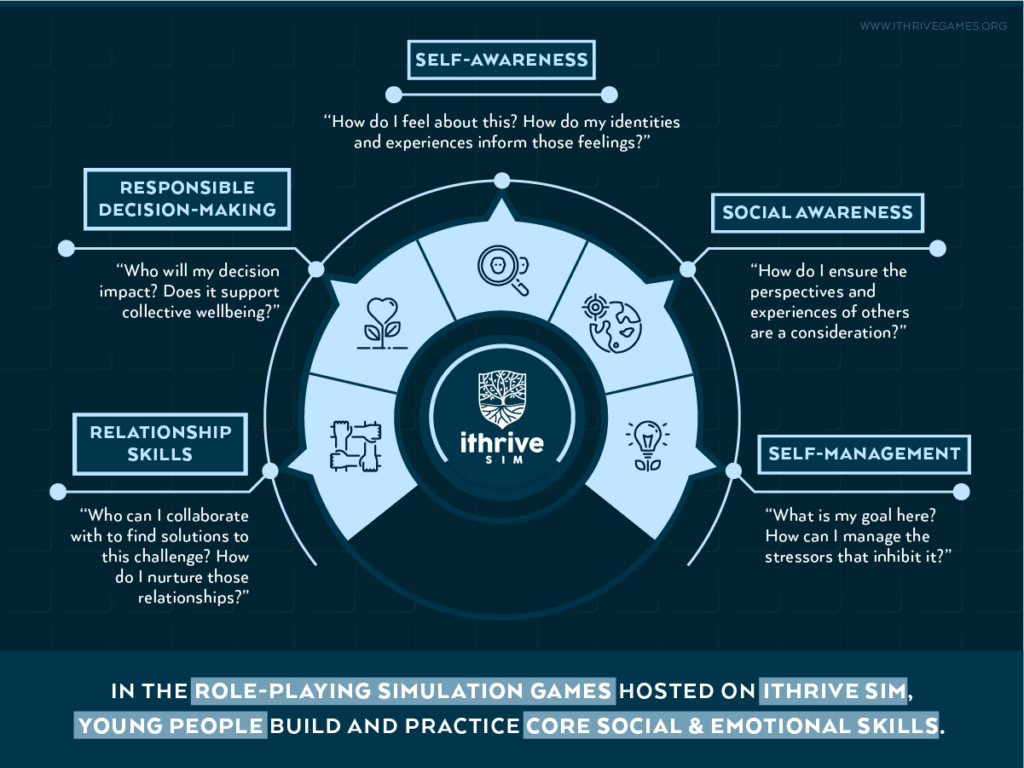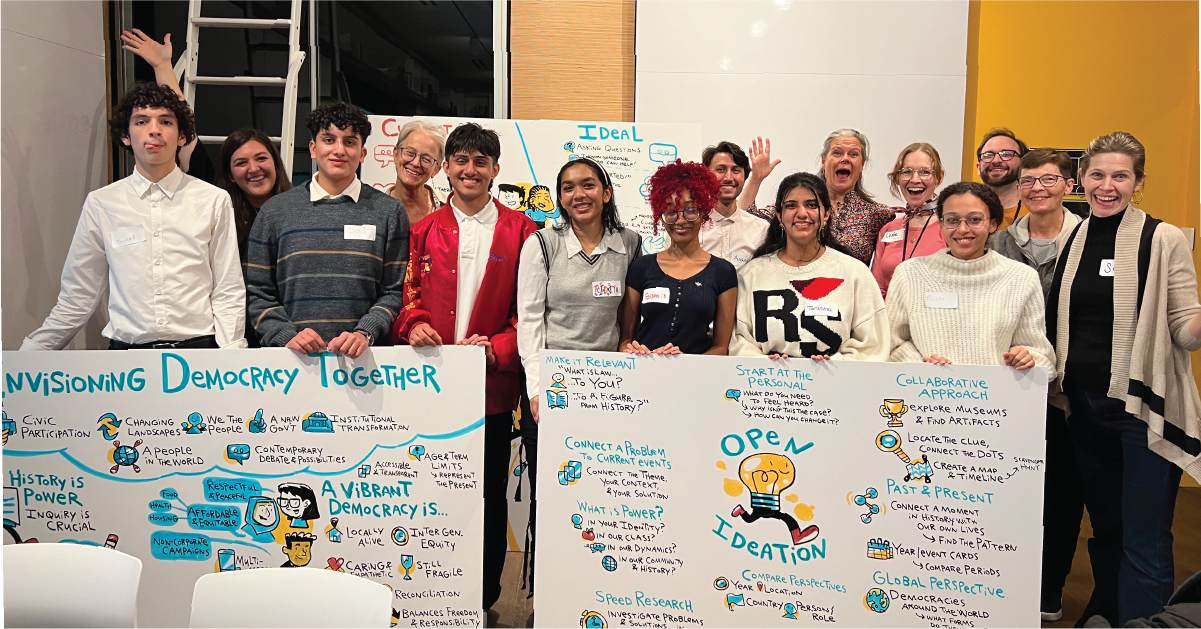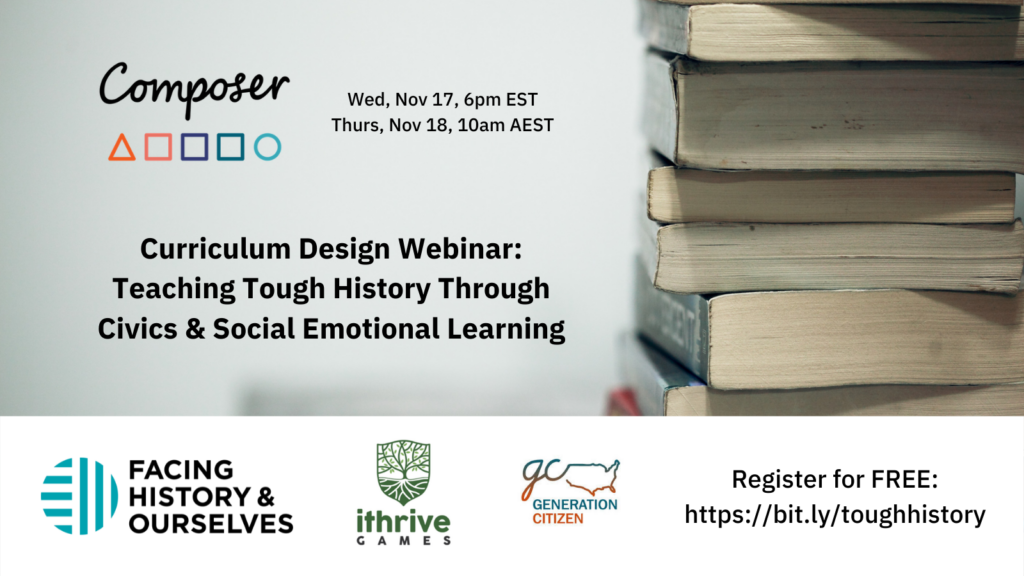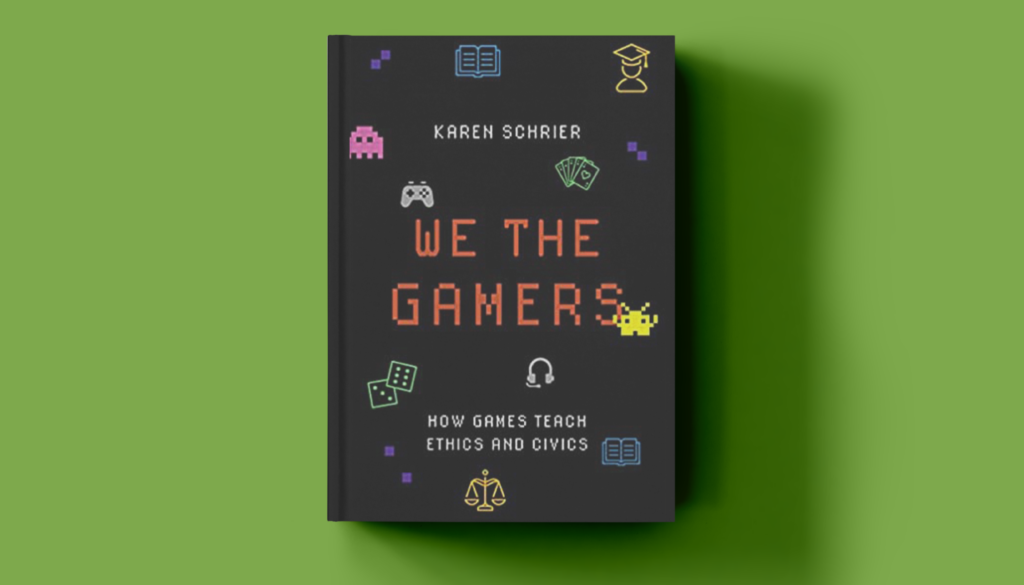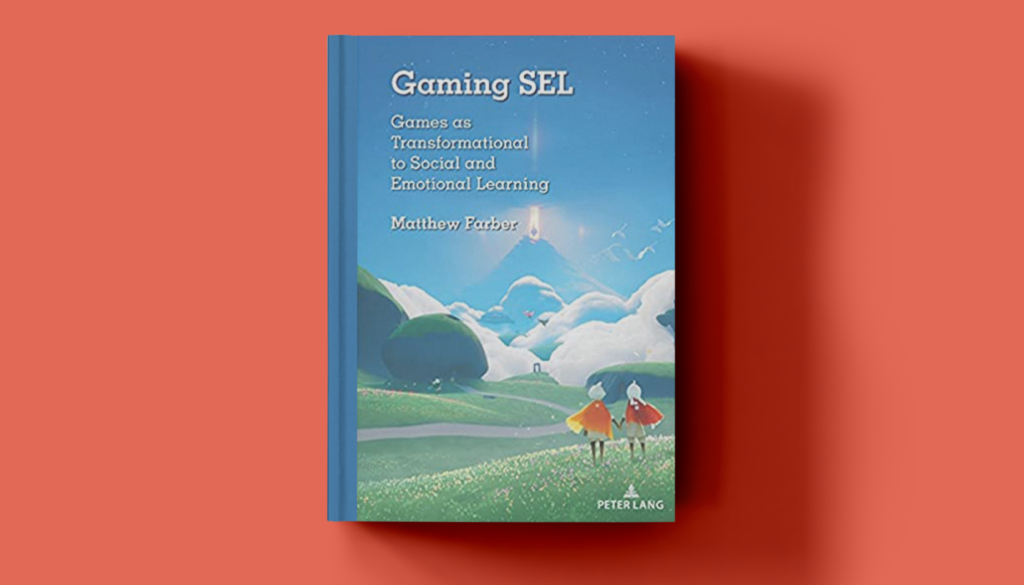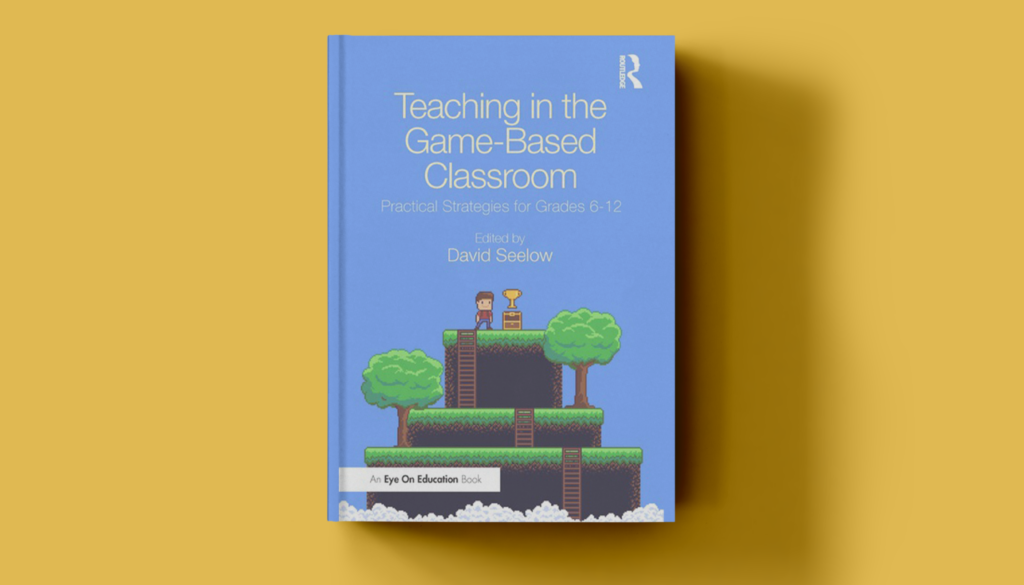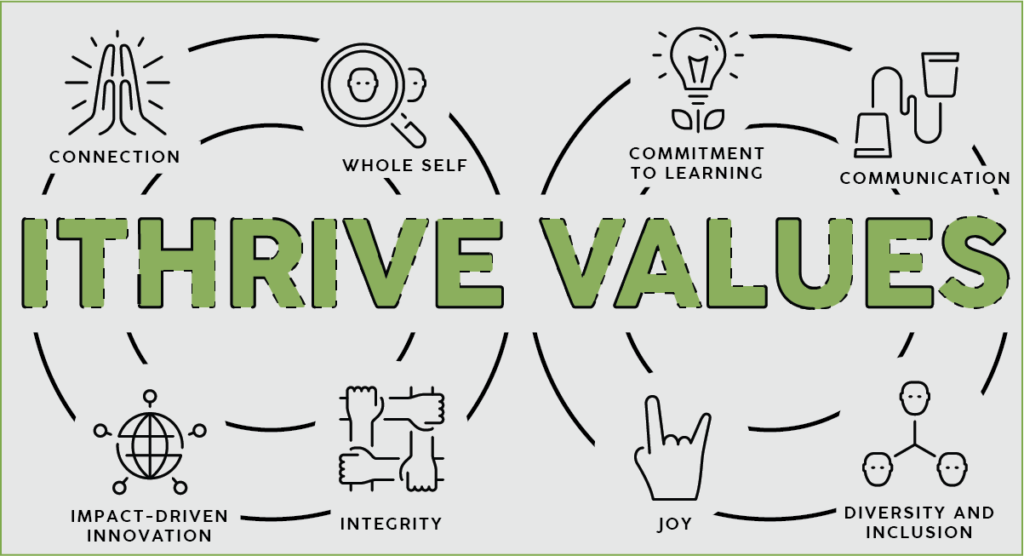Using SEL Tech in Classrooms? Five Questions Every Educator Should Ask
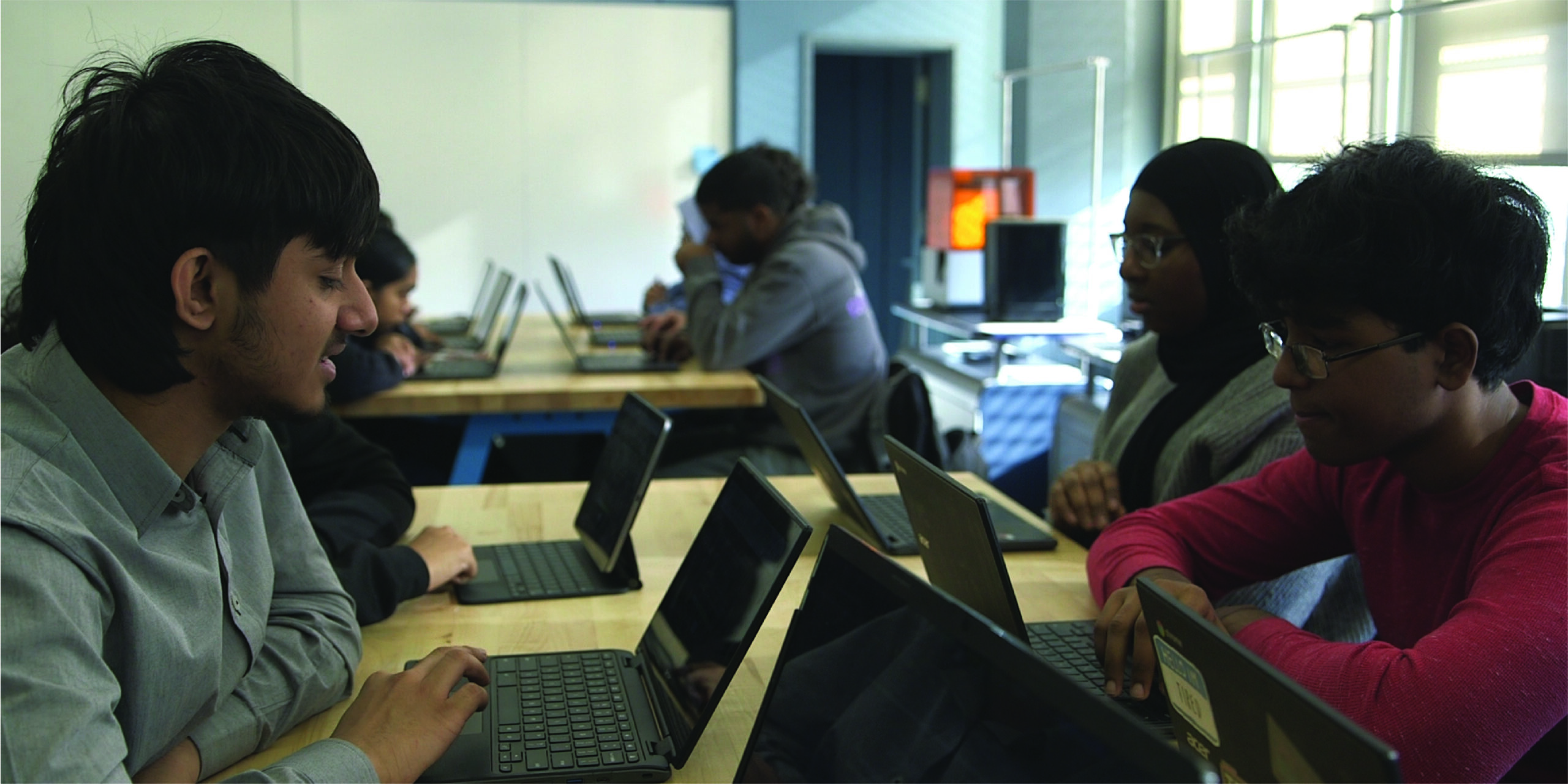
What transforms a classroom into a socially and emotionally supportive space where learners thrive? At its heart, it's connection—the relationships that make students feel seen, supported, and valued.
Research consistently shows that students excel when they trust their teachers and feel a sense of belonging with their peers. These bonds fuel engagement, emotional growth, and academic success.
As educators, you already know the power of relationships. But in today's classrooms, technology is also shaping how we connect, teach, and learn. In fact, roughly nine in ten K-12 educators in the U.S. believe education technology positively impacts student engagement and use it in their classrooms (Zipdo, 2023). The potential for tech to enhance learning is immense—but how can it be used thoughtfully to strengthen the relationships and skills at the core of social and emotional learning (SEL)?
In the "SEL and Technology" chapter of the newly released Second Edition of the Handbook of Social and Emotional Learning, co-authors Susan Rivers and Michelle Bertoli of iThrive Games/History Co:Lab, alongside Urban Assembly's David Adams and Eaton Middle School's Letha Mellman, explore how technology, by design, "must value and center learners in all their diversity of capacities, interests, motivations, contexts, and experiences." They emphasize that social and emotional learning (SEL) technology should "center and enable meaningful relationships between learners and the adults involved in their learning, as well as with themselves, other learners, and the larger community and planet."
To fully harness the potential of SEL tech, educators must intentionally choose technology that will support relationship building in classrooms. Doing so ensures that learning environments remain human-centered and that learning remains relationally driven.
SEL TECH USE IN THE CLASSROOM: FIVE CRITICAL CONSIDERATIONS
SEL tech offers tools to foster connection, amplify engagement, and help students practice essential skills like empathy, self-regulation, and collaboration. However, realizing its promise requires intentional integration. Educators, here are a set of five questions to ask yourself when evaluating and using SEL tech that help ensure it supports a meaningful, learner-centered classroom.
- How does it strengthen relationships?
Technology should enhance, not replace, human interaction. Tools that create opportunities for meaningful teacher-student and peer-to-peer relationships can deepen trust and foster collaboration. Tools like OKO provide a platform for students to build knowledge together, engage in creative problem-solving, and make learning a shared experience supportive of connection and care in classrooms.
- Does it prioritize ethical data use and privacy?
Many SEL tools collect sensitive information, such as students' emotions or behavior patterns. Protecting this data is critical to maintaining trust and establishing emotional safety. Educators should assess terms of service and privacy policies to ensure that any tool they use is transparent about its data practices, protects student data and is used solely for their benefit. Common Sense Privacy Program offers helpful resources for rating and reviewing the privacy standards of ed-tech tools.
- How does the technology offer accessibility for all learners?
Technology should bridge gaps, not widen them. SEL tools must be designed to serve students of all abilities, backgrounds, and contexts. When choosing a tool for your classroom, evaluate its inclusivity and accessibility. Use CAST's Universal Design for Learning (UDL) principles as a guide to ensure the SEL tech you integrate supports diverse learning needs and fosters equity in every learning experience.
- How does the technology support emotional readiness and safe engagement?
SEL tech should help students learn how to manage their emotions and prepare for meaningful learning by fostering calm and focus. Tools that include emotion-regulation exercises or gamified experiences can help students build self-awareness and manage stress effectively. For example, apps like Calm teach students strategies to regulate emotions, enhance focus and navigate social dynamics in collaborative learning environments.
- How does the technology provide opportunities for practice and feedback?
Interactive tools are uniquely positioned to offer repeated practice and immediate feedback—essential for helping students actively refine their SEL skills and master SEL competencies. Apps, simulations, and games can help students develop skills like empathy, decision-making, and collaboration in dynamic, low-risk scenarios. For instance, iThrive Sim, our award-winning digital platform that hosts a library of tech-supported, role-playing simulation games, lets students role-play real-world challenges, giving them a chance to practice SEL skills in a safe and engaging environment.
RELATIONSHIPS FOSTER GROWTH
Technology is a powerful tool, but it is relationships—with and between teachers, students, and communities—that drive true growth. To be effective, SEL tech needs to support and amplify relationships that make classrooms thrive, not replace them. As Rivers, Adams, Bertoli, and Mellman highlight in the Handbook of Social and Emotional Learning, "Caring relationships are the lever, driver, and home-base of successful SEL,and technology must be designed and deployed in service of the warm and supportive connections that nurture, sustain, and motivate each learner."
Achieving this vision for SEL tech means designing to support optimal learning conditions for all learners and "putting learners and their relationships at the center." By integrating SEL tech in ways that prioritize human connection, educators contribute to this vision, creating classrooms where students feel valued, engaged, and ready to thrive.
Explore iThrive Games' free library of game-based and tech-supported social and emotional learning resources to enrich your classroom, and sign up for our mailing list to stay informed about our new tools and updates!
The chapter SEL and Tech can be found in Handbook of Social and Emotional Learning, Second Edition, edited by Joseph A. Durlak, Celene E. Domitrovich, and Joseph L. Mahoney, published by Guilford Press.
iThrive Sim: A Game-Changing Tool for Adolescent Research

For researchers studying youth behavior, development, mental health, education, and social dynamics, a youth-centered approach is crucial.
Choosing a method that allows young people to be seen, heard, valued, and supported directly impacts the quality and authenticity of study outcomes. At iThrive Games, we know from experience that play offers a viable and valuable research method that meets young people where they are with what they know. Our award-winning iThrive Sim game engine is an example of this, creating simulation games that serve as rich conduits for exploration, experimentation, and learning. When used by psychologists, sociologists, and education researchers, iThrive Sim offers a game-based way to explore how young people confront challenges and navigate decision-making. We invite all with inquiry to connect with us to learn how they can use the platform in their research.
WHAT IS ITHRIVE SIM?
iThrive Sim is an accessible, web-based, and device-agnostic digital game engine to engage young people in any in-person setting or home with Wi-Fi. Designed for classroom use meeting in-person and virtual learning needs, it meets classroom requirements including low internet speeds, firewalls, time constraints, student absences, and child protection laws.
Named a 2022-2023 Learning Engineering Tools Competition Growth Award Winner and having won multiple industry awards, iThrive Sim offers single and multiplayer role-playing simulation games. Players step into assigned roles and encounter unique stressors as they navigate challenges and make real-time decisions that shape the unfolding narrative. Each player's experience concludes with a customizable outcome report, reflecting their in-game engagement and behaviors.
WHY ITHRIVE SIM WORKS AS AN ADOLESCENT RESEARCH METHOD
In adolescent research, finding methods that truly engage young people while delivering meaningful insights can be challenging. iThrive Sim bridges this gap with its plug-and-play technology, interactive capabilities, and thoughtful design, creating a robust environment for research. Its tech specs and unique approach to gameplay and learning make it an ideal tool for studying the complexities of adolescent development and social interactions. Here are five reasons why:
1. ENHANCED ENGAGEMENT AND MOTIVATION
Using a game-based research method like iThrive Sim increases engagement and motivation for adolescent participants by leveraging the immersive and interactive nature of games. Games provide a familiar and enjoyable environment where teens can explore scenarios, make decisions, and see the immediate consequences of their actions. This dynamic approach keeps participants interested and invested, as it feels more like play than traditional research. Additionally, the challenge and rewards encourage sustained participation and deeper involvement, leading to richer data and more authentic insights into adolescent behavior and decision-making.
2. REAL-TIME DATA COLLECTION
iThrive Sim supports data collection of in-game behaviors. Real-time interactions in the game platform allow adolescent researchers to gather time-sensitive data linked to in-game decision-making, stressors, information processing and sharing and more. Researchers can add video capture to support observational data collection of interpersonal interactions and nonverbal behaviors. Surveys administered pre, post, and during gameplay support for additional insights.
3. SIMULATION OF REAL-WORLD SCENARIOS
iThrive Sim's role-playing games offer a unique window into adolescent behavior. Role-playing games (RPGs) are known for fostering creativity, collaboration, and problem-solving. iThrive Sim goes further, providing a powerful tool for studying complex psychological processes in a natural setting. In the safe, playful environment of iThrive Sim, researchers can simulate real-world scenarios, allowing teens to make decisions and observe the outcomes without real-world risks. This approach yields valuable insights into behaviors and decision-making processes that are challenging to study through traditional methods, making iThrive Sim a unparalleled tool for adolescent research.
4. CUSTOMIZATION AND FLEXIBILITY
iThrive Sim's dynamic features empower researchers to create tailored experiences that precisely meet their study's needs. The platform's authoring tools allow for full customization of the research environment, enabling adjustments to difficulty levels, roles, decision points, and scenarios. Through this, researchers can also focus on specific variables, making iThrive Sim a versatile tool for targeting precise questions. This flexibility is particularly valuable in adolescent research, where the ability to adapt and refine the experience ensures that the study remains relevant and impactful, providing deeper insights into complex behaviors and decision-making processes.
5. SCALABILITY AND ACCESSIBILITY
With iThrive Sim, adolescent researchers can significantly broaden their reach. The platform is designed to engage a larger and more diverse population, including remote or hard-to-reach groups. Researchers can scale their studies to include participants from various regions and demographics, thereby enhancing the generalizability of their findings. iThrive Sim's user-friendly technology and adaptability to different internet conditions and hybrid settings ensure seamless scalability. This flexibility allows researchers to effectively conduct large-scale studies, reaching diverse populations and gaining richer, more comprehensive insights into adolescent behavior and development.
ENLIST ITHRIVE SIM IN YOUR ADOLESCENT RESEARCH
In adolescent research, it is crucial that young participants feel seen, heard, and valued as active contributors to science rather than just subjects. This approach not only enriches the data collected but also upholds ethical standards that prioritize the well-being and agency of young people. iThrive Sim embodies this philosophy, offering a platform where teens can engage deeply, explore real-world scenarios, and provide authentic insights in a safe and supportive environment.
By choosing a research method that resonates with the needs of young people, adolescent researchers can ensure their work is both meaningful and impactful. At iThrive Games, now part of the History Co:Lab, we work as an interdisciplinary team of game and experience designers, developmental psychologists, and learning science experts who are committed to unlocking the potential of games as tools for positive youth development. Contact us today to find out more about using iThrive Sim in your research!
Turning FEMA’s Lifeline Info Into an Immersive Game with iThrive Sim
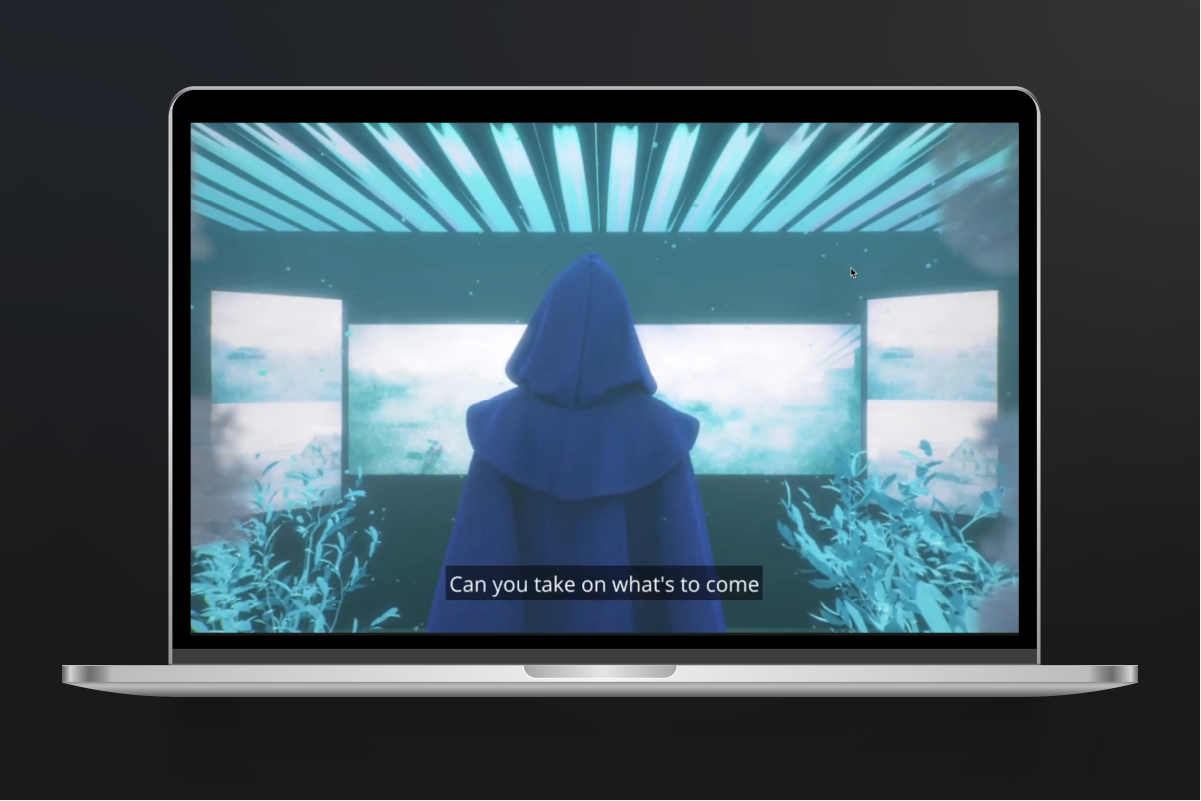
Young people feel the emotional weight of the world's challenges. They see the stories on their social media feeds and TV screens that bring forth questions, sometimes grief, and almost always hope for solutions that move us toward a world grounded in empathy, safety, and communal care.
Young people want to be a part of imagining and co-creating solutions that get us there, too, ones that bring forth better ways of being and doing that are supportive of their thriving and all our thriving. Teens and young adults already embrace and demand social action, according to the 2023 Deloitte Global Millennial and Gen Z Survey. Young and curious, they are instigators of change, with 83% saying they believe in their generation's power to inspire action in their local networks and impact societal problems, according to a 2020 CIRCLE Survey.
As agents of influence and drivers of transformation, young people wield within them a power to shape and steer both present and future. All in their learning ecosystem who believe in their genius and care about their thriving—from teachers to emergency management specialists—have a duty to nourish and honor that power.
For the Federal Emergency Management Agency (FEMA) Region 8 team, this duty led them to partner with the iThrive Games team to design and develop Disaster Mind, a disaster readiness and resilience-building game that meets young people where they are with play. Disaster Mind is a digital game designed to inspire social action toward community preparedness. Built and hosted on iThrive Sim, an award-winning game engine and development platform that creates and delivers role-playing simulations, Disaster Mind integrates live-saving information with interactive storytelling and an immersive play experience, actively connecting young people to knowledge that prepares them for disasters and activates them as movers and shakers capable of organizing their families, friends, and communities.
"We know that youth can be force multipliers in helping their families and households prepare for emergencies and disasters," shares Kirsten Maltese, the Youth and Adolescent Program Manager and a Community Preparedness Officer at FEMA Region 8. "[This] can spark a conversation with their friends and families but can also be a bridge between them and their local emergency management office. If we spark their curiosity and interest in preparedness at an early age, we can help them develop lifelong habits that will help them in their homes and communities."
A PLAN'S POWER: THE RESILIENCE PART OF DISASTER RECOVERY
Disaster preparedness is a silent sentinel that proves its power in times of chaos. It is core to disaster recovery. A proactive approach and an intentional mindset, reflected in historic taglines popularized by FEMA and on ready.gov like "Disasters don't plan ahead, you can" and "Prepare. Plan. Stay Informed," implore us to take action to reduce our vulnerability to disasters and increase resilience when they strike. "Disaster Mind gives potential survivors the opportunity to simulate real-life situations, " shares Daniel Nyquist, an Executive Officer at FEMA. "They make decisions that would lead to their eventual recovery." Here's how.
ITHRIVE SIM'S GAME-BASED LEARNING: A DIRECT-TO-YOUTH SOLUTION
Care in action means meeting young people where they are to support their thriving. In a world brimming with technology where over 600 million young people play video games, that includes leveraging play in spaces where they learn. Learning science shows that play has power; play supports engagement and can foster active learning through decision-making and problem-solving. In the months following the onset of the COVID-19 pandemic in 2020, as parents, guardians, and educators scoured for new virtual classroom and learning tools, many turned to play as a tool for connection and fun.
iThrive Sim launched in that same year as an accessible web-based and device-agnostic digital game engine capable of engaging young people in any educational setting or home with WiFi and a 1:1 device. The game engine delivers role-playing simulation games with integrated social and emotional skill-building. Players encounter unique stressors as they navigate challenges. They make real-time decisions that impact the unfolding narrative. With iThrive Sim, awarded for its learning engineering and design, we worked with the FEMA Region 8 team to build Disaster Mind, a single-player simulation game where players must navigate severe weather events, stay informed, and make decisions that impact how the story unfolds. The young people who play expand their understanding of disaster preparedness as they contend with unexpected weather events, manage its accompanying stress, and attempt to make the best decisions for the safety of themselves and their communities.
Disaster Mind has been both thought- and action-provoking for young people since its official launch on www.ready.gov this year. After playing, players express their motivation to get prepared, saying, "I should go home and make sure my family is prepared just in case something happens." Others shared in post-game focus groups that the simulation game expanded their sense of responsibility, opening them up to consider what it would be like to navigate a disaster without being accompanied by family or a trusted adult. The game is designed to activate and support young people's planning, involvement, and leadership in their community's preparedness efforts, core goals of the National Discovery Recovery Framework. "As young people navigate from support structures like their families and schools, we intend to help them prepare for their next phase in life," shares Maltese. "This type of engagement ahead of a disaster is what helps build resilience in communities - and we believe youth can be the driver of that."
THE SOCIAL AND EMOTIONAL SKILL-BUILDING IN DISASTER MIND
Vital to disaster readiness is prepping for the social and emotional. iThrive Sim's dynamic features are optimized to deliver experiential learning in a unique and developmentally nourishing way to teens. Disaster Mind is designed to be a social and emotional skill-building play experience that helps teens shift from an automatic mindset of "This won't happen to me" and "Other people will handle it" to an intentional mindset of "I may face an emergency at some point" and "I will think for myself".
Rather than prescribing learning, iThrive Sim encourages teens to make meaning of the content they encounter, allowing them to learn by doing and develop understandings that go beyond the surface knowledge of facts and information. Through a careful combination of game features and mechanisms that purposefully ignite feelings, teens are prompted to draw on their own experiences and skills while they make decisions. The game gives them opportunities to practice critical thinking, acquire and interpret information, and make real-time decisions while navigating challenges.
This active learning is transformative social and emotional learning.
WHAT A GAME LIKE DISASTER MIND CAN DO
The impact is in their testimonies.
Young people who've played the Disaster Mind simulation game walk away from it with a sense of ownership of the plan and investment in the outcomes, leading to greater participation and collaboration, too. "I've discussed with my family about disasters. We are making plans for them and intend on making them as clear and as direct as possible for everyone to stay safe during disasters," shared one of the first teens who tested Disaster Mind.
The scaffolded challenges, personalized feedback loops, and real-world applicable social and emotional skill-building that young people who play Disaster Mind experience makes them more familiar with the work of preparedness and the network- and community-wide planning and capacity-building efforts it entails.
"We often hear phrases like "if I only knew I would need..." or "I wish I had known that.." in the aftermath of disasters," says Nyquist. "Disaster Mind enables players to understand those needs in a safe and engaging setting before a disaster happens. This results in players being better prepared and equipped with information and strategies they need to maximize recovery resources and be resilient in their own recovery."
We knew that the effectiveness of Disaster Mind depended on young people wanting to play it. To ensure it would be engaging, relevant, and motivating for young people, we brought them into the design process using iThrive's as the participatory youth co-design approach. Their input shaped the story, the look and feel of the game, and the game mechanics. The impact and influence of Disaster Mind reflect the power of both co-design and game-based learning to engage young people in the work of inquiry, discovery, and reflection. Designed with collaboration and care and learning science, Disaster Mind animates and introduces life-saving strategies to agents of change and shapers for safe and resilient tomorrows: young people.
| |
PLAY THE DISASTER MIND SIMULATION GAME ON ITHRIVE SIM! 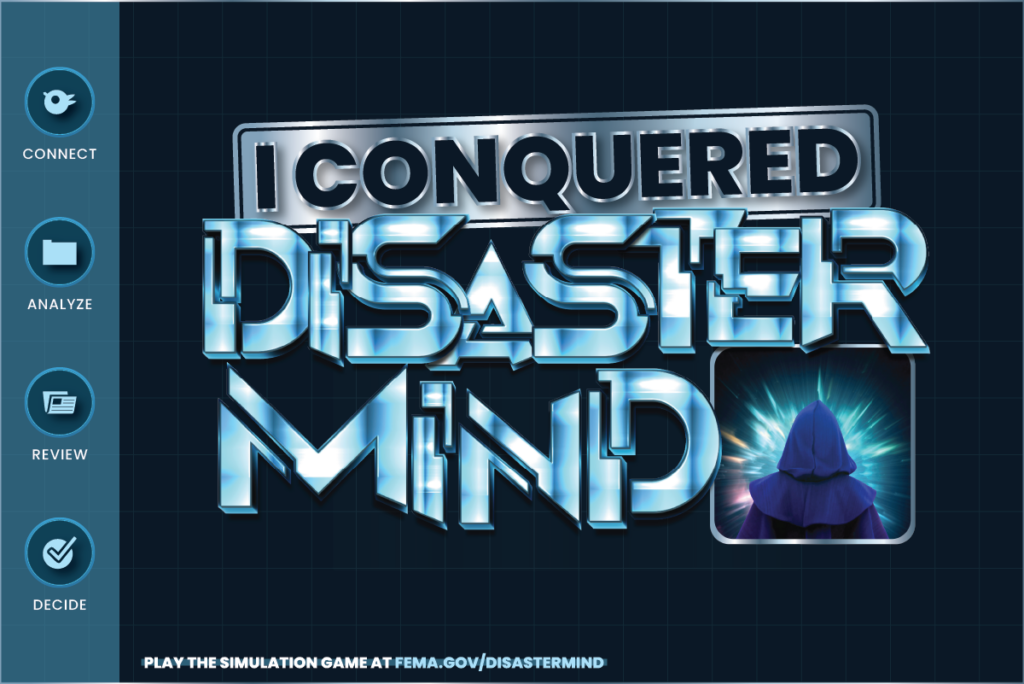 |
Our Year of Knowledge-Building, Knowledge-Sharing & Play
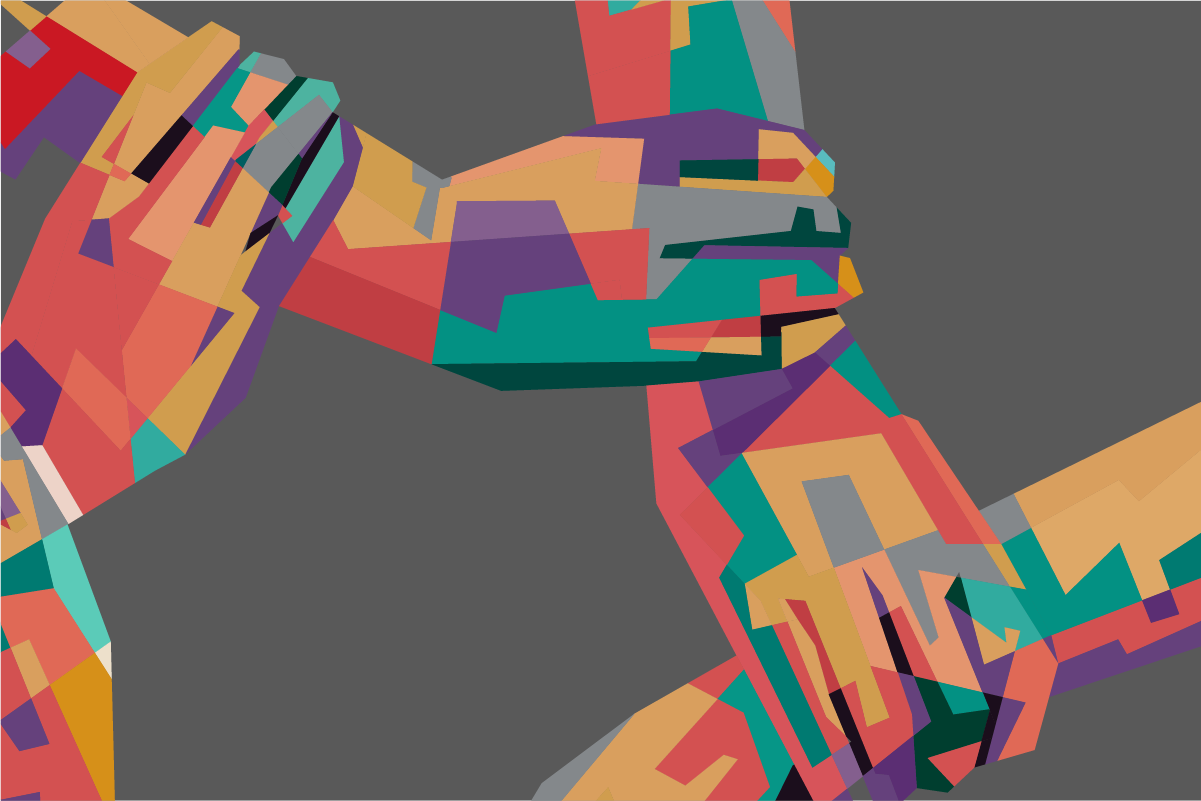
Joy enriches. As a connector, joy helps realize the 'we' and nourishes the 'us' that directs how we gather, steers how we imagine, and inspires what we create.
This year, joy guided our work alongside young people, nonprofits, government agencies, school communities, research institutions, game developers, subject matter experts, and learning experience designers. With teens and our partners, we built knowledge, shared knowledge, and co-designed transformative experiences for teens supportive of their learning, mental health, and thriving.
Throughout 2023, partnership propelled impact and possibility, helping us and those we collaborated with expand it in places where teens learn and play. Collaboration and community-building were consistently parts of all we did this year— from our co-design sessions that led to co-created games and learning experiences to the conferences and panels we were part of. In togetherness, we pooled strengths with teens and others. We leveraged the diversity of our experience and expertise and those we merged genius with to accelerate progress toward the world we each yearn—one where young people have the tools to live full, safe, healthy, and purposeful lives. It was amazing.
In celebration of what the year has been and all that is to come, here is a look back on eight joy-filled memories in no particular order, as well as our favorite collaborative moments, and unforgettable highlights from 2023:
#8. PLAYTESTING CADENCE FORD AT PLAY NYC
At Playcrafting's Play NYC this year, an event that magnified the power of play and brought hundreds of game industry professionals, indie game developers, and game designers together to exhibit their games to players and peers, we shared an iteration of Cadence Ford, the single-player, text-based strategy game we created with the One Love Foundation and Playmatics, LLC.
 |
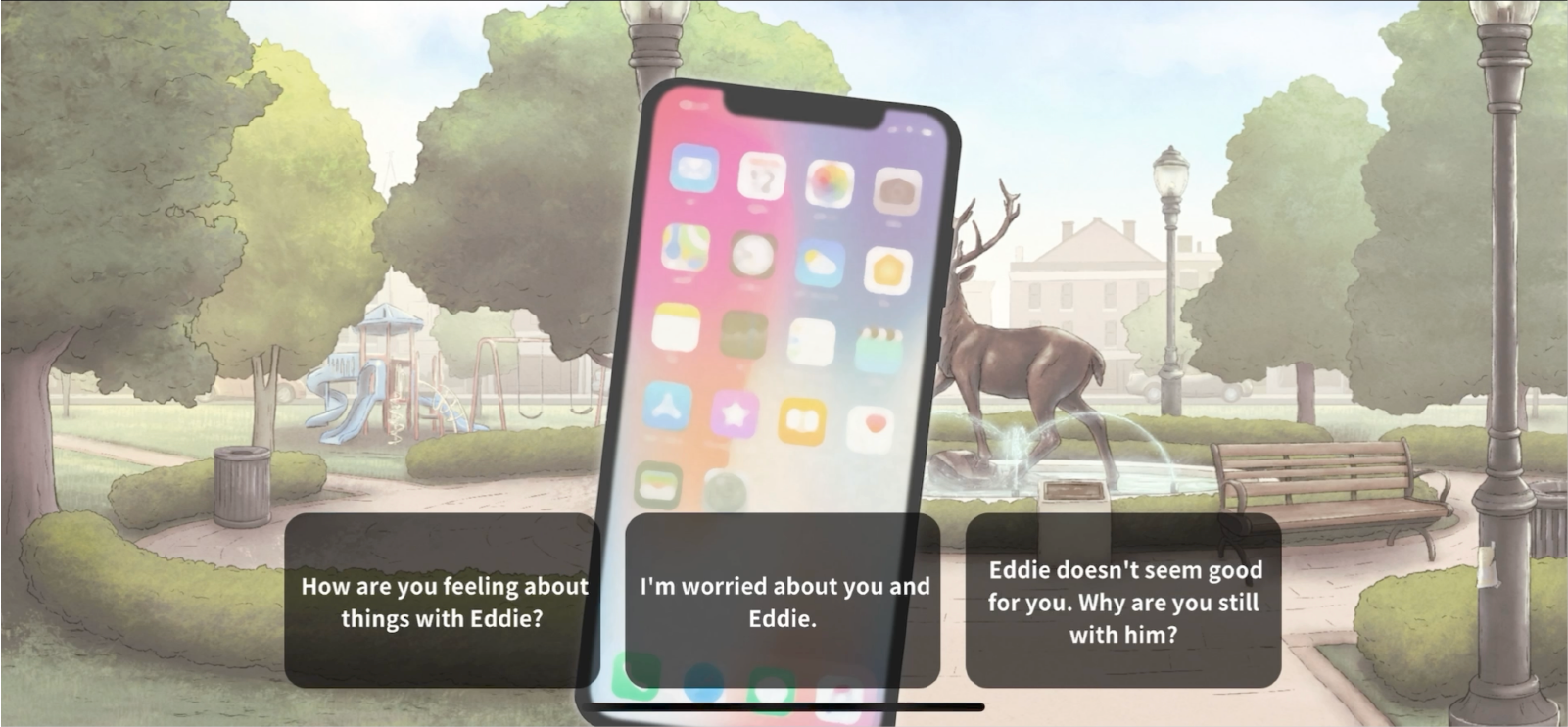 |
Building on One Love's mission to empower young people with the life-saving prevention education, tools, and resources they need to see the signs of healthy and unhealthy relationships, Cadence Ford supports young people in learning to love better, in being with partners who practice healthy Love and communicating with loved ones who are in unhealthy relationships. While New Yorkers of all ages played the game demo and shared feedback, teens, many of whom went on to become members of our Teen Hub, were particularly moved by the game's storyline, mechanics, and captivating 2D art. Read about Cadence Ford's co-design process and the forum for listening to and learning from young people we created at Play NYC.
#7. OUR CO-DESIGN WITH TEENS AT THE NEW YORK HISTORICAL SOCIETY
For the students from Thomas A. Edison High School who gathered at the New York Historical Society with us, History Co: Lab, a graphic notetaker, and others in Educating for American Democracy (EAD)'s network in November 2023, the co-design workshop presented an opportunity rare in their worlds—a chance to share how they envision democracy and impact civic learning that supports the future of it.
Our Game Design Studio model at the center of the co-design experience engaged them not just as students at the end of learning experiences but also as thought partners in co-designing them, setting the stage for meaningful co-creation. The teens, who ended up devising and developing a prototype for a new interactive EAD-inspired card game created to inspire high-quality civic learning experiences by the end of the workshop, called it "promising," "progressive," "unique," "revitalizing," and "relief." Read how the model brought many across the civic education ecosystem together and what came of the teens' collaborative experience.
#6. THE LAUNCH OF OUR DESIGNING FOR TEEN THRIVING MAILING LIST
Impact-driven nonprofits, youth-serving programs, and government agencies trust us to preserve their commitment to teen wellness and thriving.
This year, we launched Designing for Teen Thriving, a mailing list that gives people like them access to the resources and insight of iThrive's game designers, learning experience designers, and teen social and emotional development experts. Subscribing to the list helps individuals looking to create developmentally nourishing experiences and wellness-supporting games for teens (with us or on their own) ensure what they create meets young people where they are and supports their thriving.
Join the Designing for Teen Thriving mailing list today!
#5. THE SOFT LAUNCH OF DISASTER MIND, AN ITHRIVE SIM GAME MADE WITH FEMA
The work of disaster preparedness, response, and recovery is as emotional as it is manual. Disaster Mind, the single-player simulation game built on the iThrive Sim platform with Federal Emergency Management Agency (FEMA) Region 8, supports young people's understanding of it.
This year, the FEMA Region 8 team soft-launched the game after one and a half years of development.
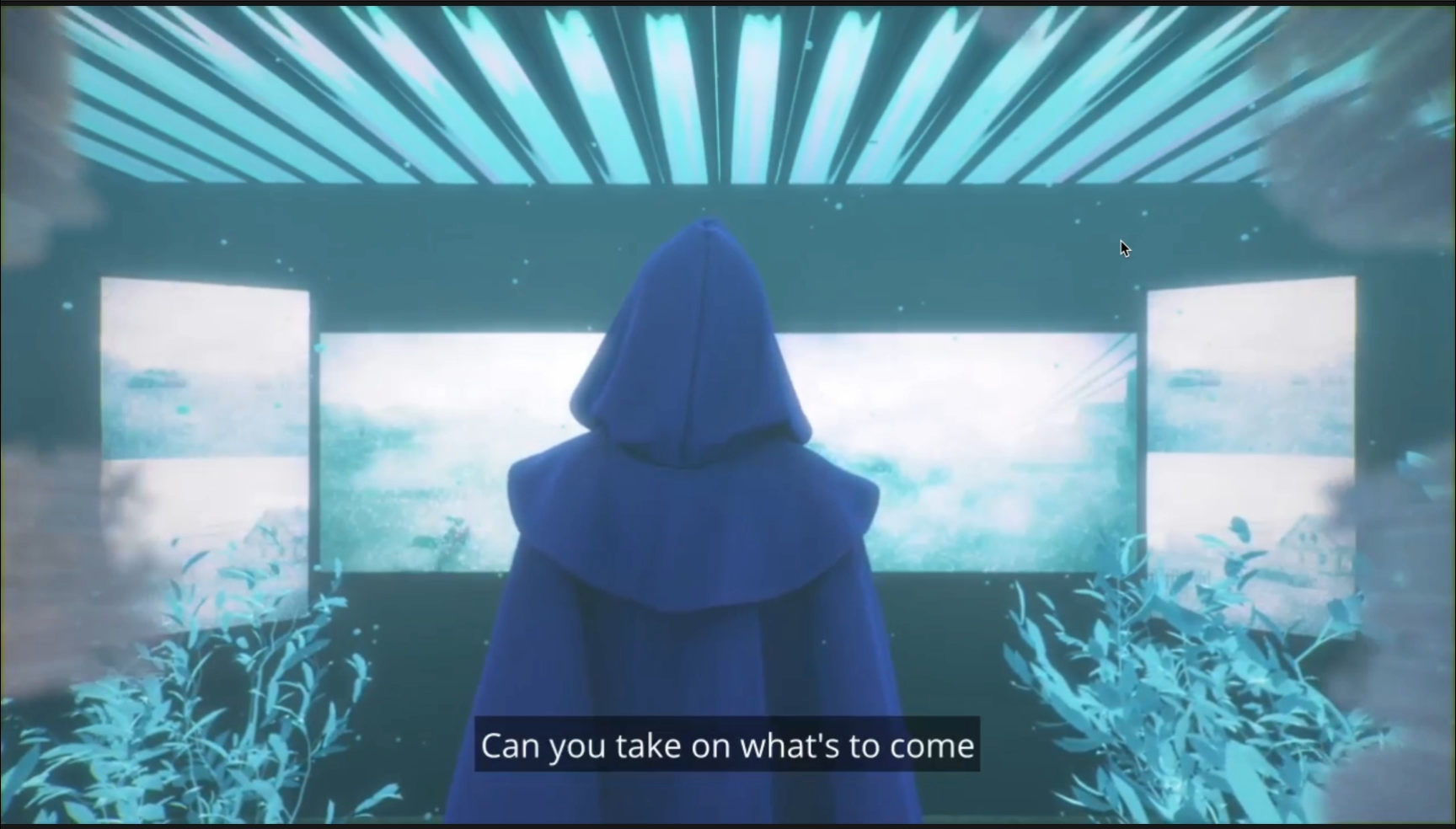 |
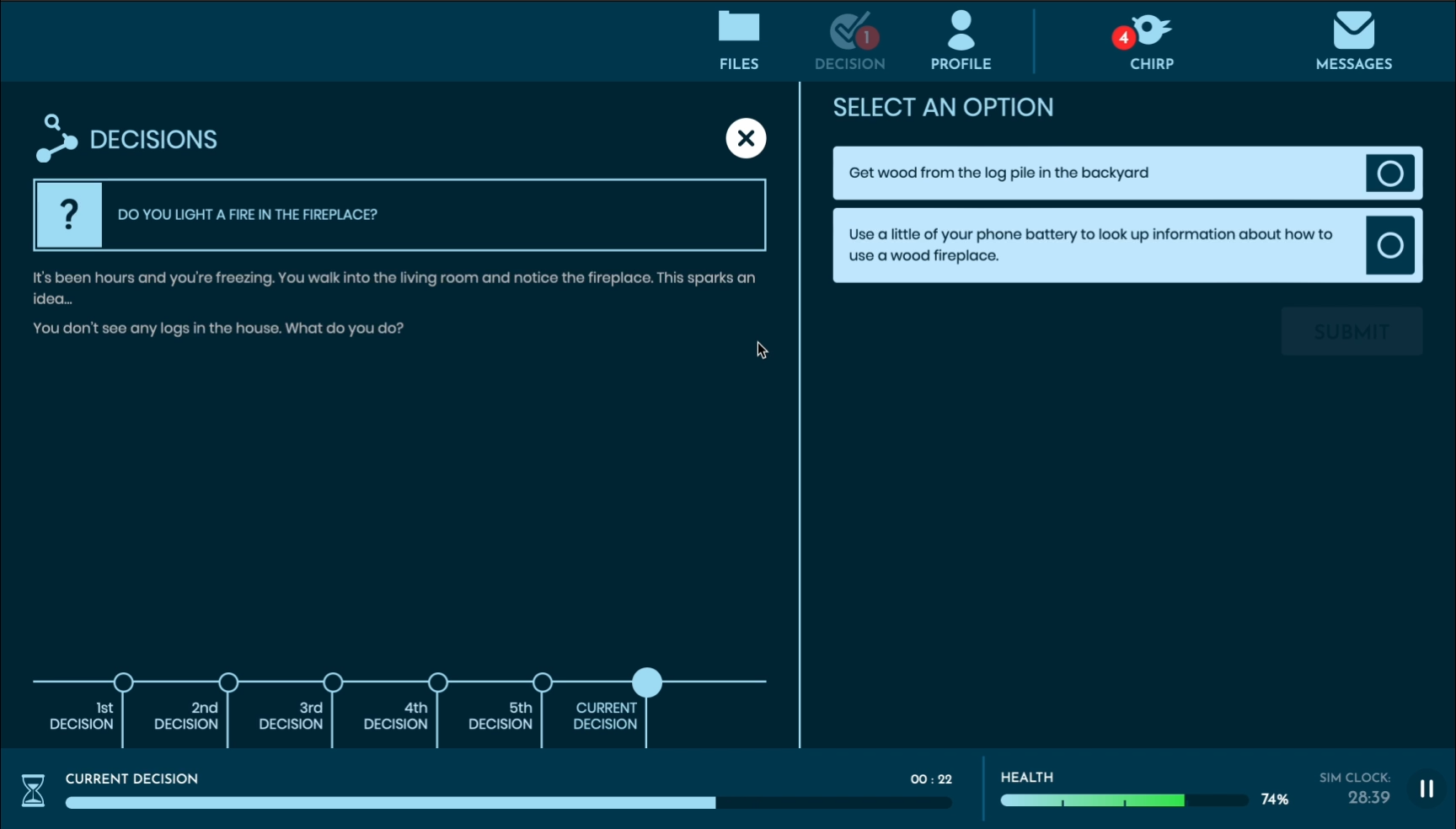 |
Young people who've playtested the game have reported feeling more confident in preparing for an emergency, managing the associated stress, and understanding the intentional mindset that underpins disaster preparedness. Many also have relayed plans to turn their awareness into action, mentioning specific disasters and sharing plans to talk to their families about exit plans, emergency kits, and meeting locations. Dive into the Disaster Mind's co-design process and explore what teens had to say about its readiness and resilience-building play experience.
#4. OUR CO-DESIGN WITH H.S. STUDENTS FROM THE GLOBAL NOMADS GROUP
Also this year, as part of an exciting learning experience design project currently underway with History Co: Lab and the XQ Institute, members of the iThrive Games team had the opportunity to gather virtually with high school students from the Global Nomads Group across two co-design sessions.
True to our norm of iterating for impact, the young people, hailing from several countries across the world, met with us to go over parts of the game-based, social and emotional skill-building experience we're creating, lending their ideas, feedback, and expertise to make it as engaging, accessible, inclusive, and resonant as possible. The play-filled meetings featured icebreakers, stretches, constructive questions, and Jamboards. It was an honor to learn from them while supporting their design thinking in the connective experience.
#3. ITHRIVE SIM NAMED A LEARNING ENGINEERING TOOLS COMPETITION WINNER
This year, the iThrive Games team was named one of the 32 winners of this year's Learning Engineering Tools Competition, selected from over 1,000 edtech innovation proposals submitted worldwide.
The win and accompanying $100,000 Growth Phase award in the Transforming Assessments track enables our team to expand iThrive Sim, our playful engine that hosts, powers, and evaluates immersive and interactive role-playing simulation games, with new ways to measure and assess the teen social and emotional learning fostered in them while developing alongside others in the growing learning engineering discipline. We are honored to share this win with our software development partners at Affordance Studio and EdTech Recharge's Kripa Sundar. Learn more about the Tools Competition and the expanded iThrive Sim to come.
#2. THE CONFERENCE CONNECTIONS
Attending game-filled, educational, and ed-tech conferences was an absolute favorite for us this year.
At Games for Change, we learned tons from designers, researchers, and changemakers, and at ED TECH WEEK NYC, we explore how tech innovation continues to support access, learning, and workforce development.
Members of our team also had the opportunity to showcase our co-designed games at ED Games Expo and PLAY NYC and lead discussions elsewhere too. In March, as part of MA Civic Learning Week, we shared on iThrive Sim's transformative civic learning games for high school classrooms. At ASU+GSV Summit in April, our Executive Director and Chief Scientist Susan Rivers talked about the necessity of social and emotional skills in today and tomorrow's careers on an American Student Assistance panel alongside others invested in the thriving of this generation's learners. At NSLA's Summer Learning Summit in October, she joined the Education Innovation Stage with other thoughtful experts to discuss learning and youth development that can inspire, challenge and deepen summer learning.
Each space we shared with others was carried by joy and animated by an eagerness to connect and collaborate with others eager to merge genius and create better systems of care and learning.
#1. OUR CREATIVE COMMONS-LICENSED, GAME-BASED LEARNING LIBRARY
Access enables impact. This year, we opened access to our game-based, social and emotional learning educational resources by licensing them under Creative Commons. Educators and teen-serving adults who care deeply about young people's thriving can merge it with their work and expertise.
Each iThrive Curriculum unit, iThrive Sim curricular surround, iThrive Game Design Kit, iThrive Game Guide, and iThrive-authored PDF resource can be remixed, redistributed, and built upon. Dive into them!
Whether you're a teen who co-designed or playtested with us, a partner or collaborator who co-created with us, an educator who brought our resources to your students, a game designer who used our game-making resources, or a supporter who read our blogs and cheered us on, we appreciate each of you for the many ways you engaged with us this year. A heartfelt thank you for sharing in our vision of teen learning and thriving, and happy new year to you and yours!
FEMA’s New Game, Built on iThrive Sim, Preps Teens for Natural Disasters
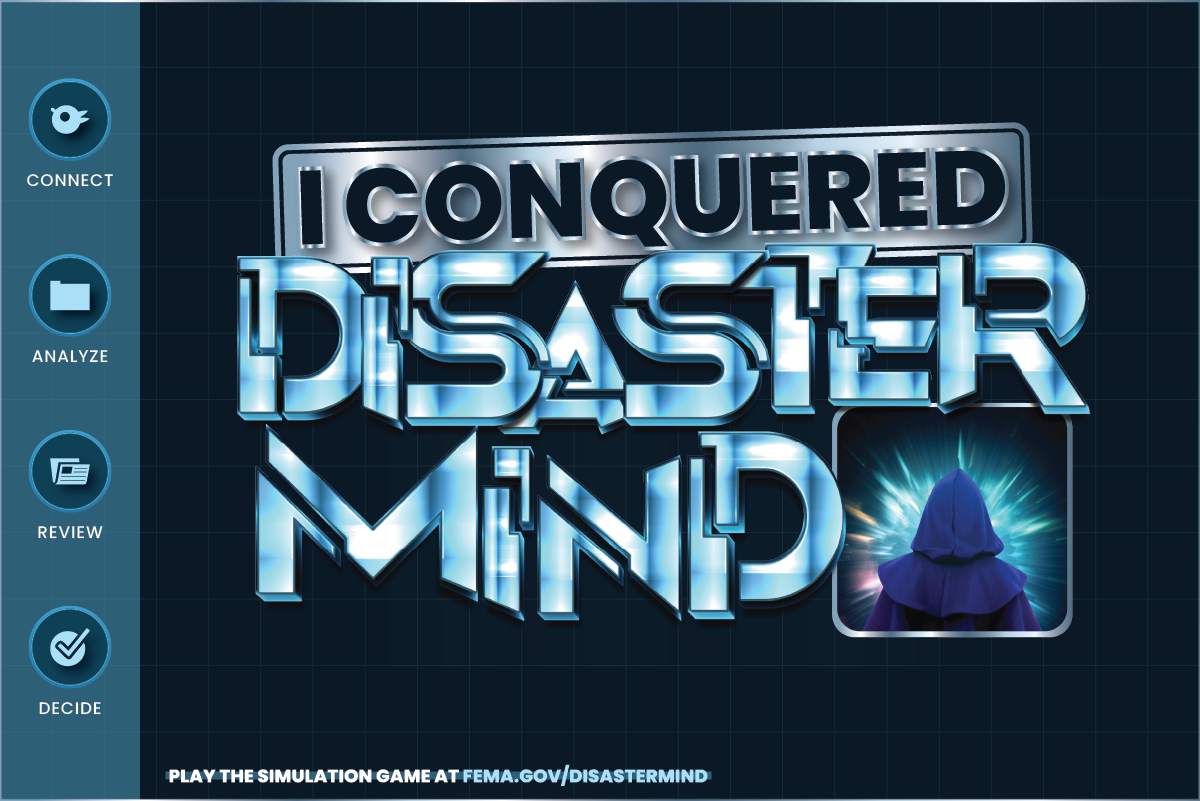
With natural disasters come disruptions and decisions.
Disaster Mind, a game created by the Federal Emergency Management Agency (FEMA) in partnership with iThrive Games, simulates all three in an immersive experience that makes the power of preparedness clear to all who play it.
The game puts the player in a world where they must navigate severe weather events, stay informed, and make decisions that impact how the story unfolds. Players expand their understanding of disaster preparedness as they contend with the unexpected, manage its accompanying stress, and act timely and effectively while under it.
Disaster Mind has been both thought- and action-provoking. The teens and young adults who have playtested it tell us that they are applying their game-based learnings to their real worlds and real lives soon after playing. "I should go home and make sure my family is prepared just in case something happens, " shared one teen after playing. "I've discussed with my family about disasters. We are making plans for them and intend on making them as clear and as direct as possible for everyone to stay safe during disasters," shared another.
As a resilience-building game, Disaster Mind seeks to empower young people with transformative education that helps them reach similar realizations. The impactful gameplay aims to activate and support their planning, involvement, and leadership in their network's preparedness efforts. "Young people are agents of change in their households, schools, and communities," shares Daniel Nyquist, the National Preparedness Deputy Director of FEMA Region 8. "iThrive helped us lean into their wisdom and lived experiences to design and produce Disaster Mind, and in the end, we have a compelling game that meaningfully helps their peers build skills supportive of their resilience and practices reflective of an intentional mindset."
DESIGNING FOR IMPACT: THE CO-DESIGN PROCESS
Our co-design process with and for teens is care in action and when brought to collaborations with partnering organizations, like FEMA, helps create a supportive context for discovery and powerful game design.
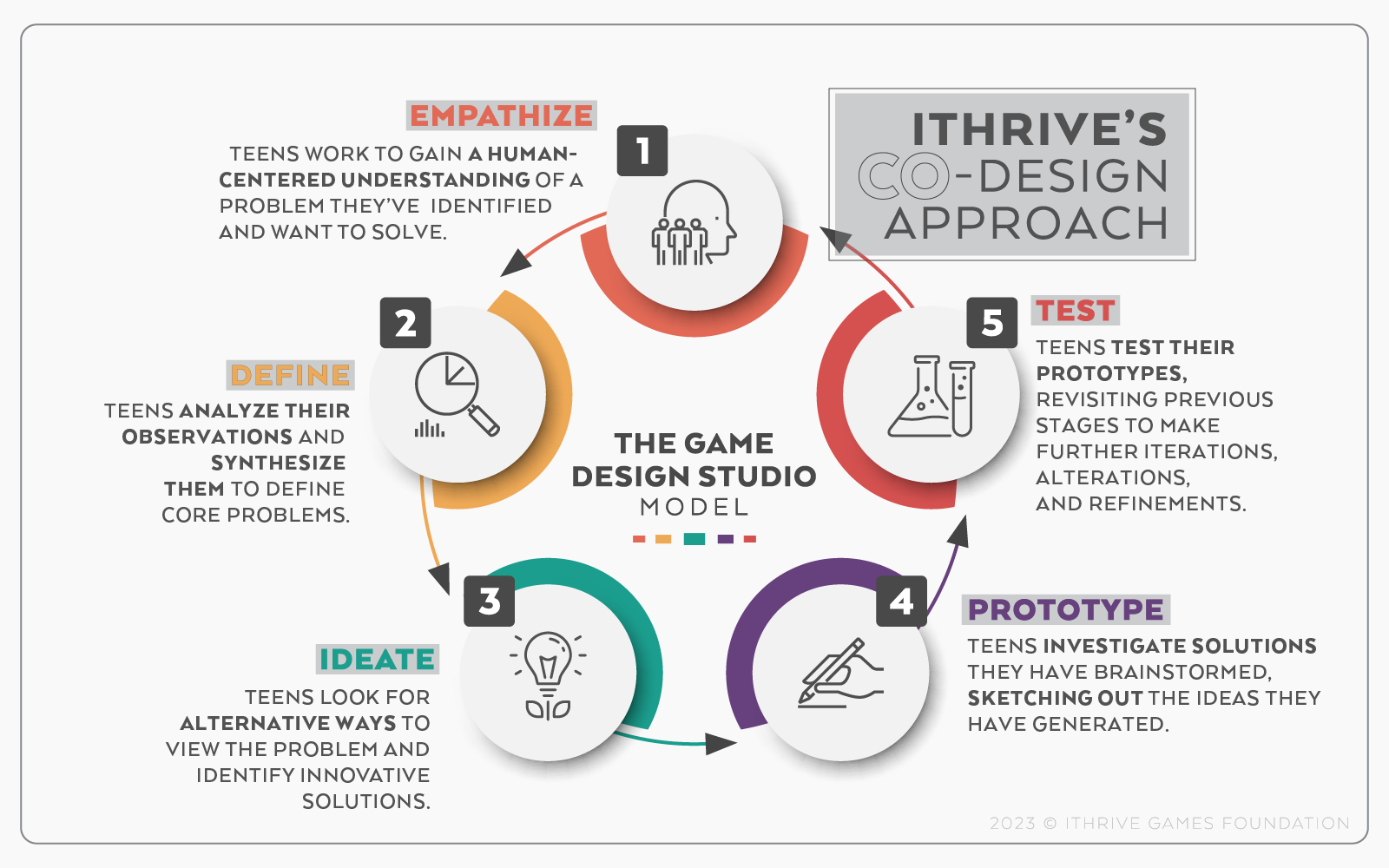
Explore some of the activities that make up iThrive Games' Game Design Studio model here.
The development of Disaster Mind began with co-design workshops with teens living in the states and territories served by FEMA Region VII (twenty-nine Tribal Nations, Colorado, Montana, North Dakota, South Dakota, Utah, and Wyoming). These gatherings sought to gauge their needs and understanding of the challenge Disaster Mind seeks to address. Teen co-designers surfaced themes that were top-of-mind for them, including the wellbeing of their pets, resource coordination, knowing which experts to trust, and cultivating the emotional ability to cope with disasters.
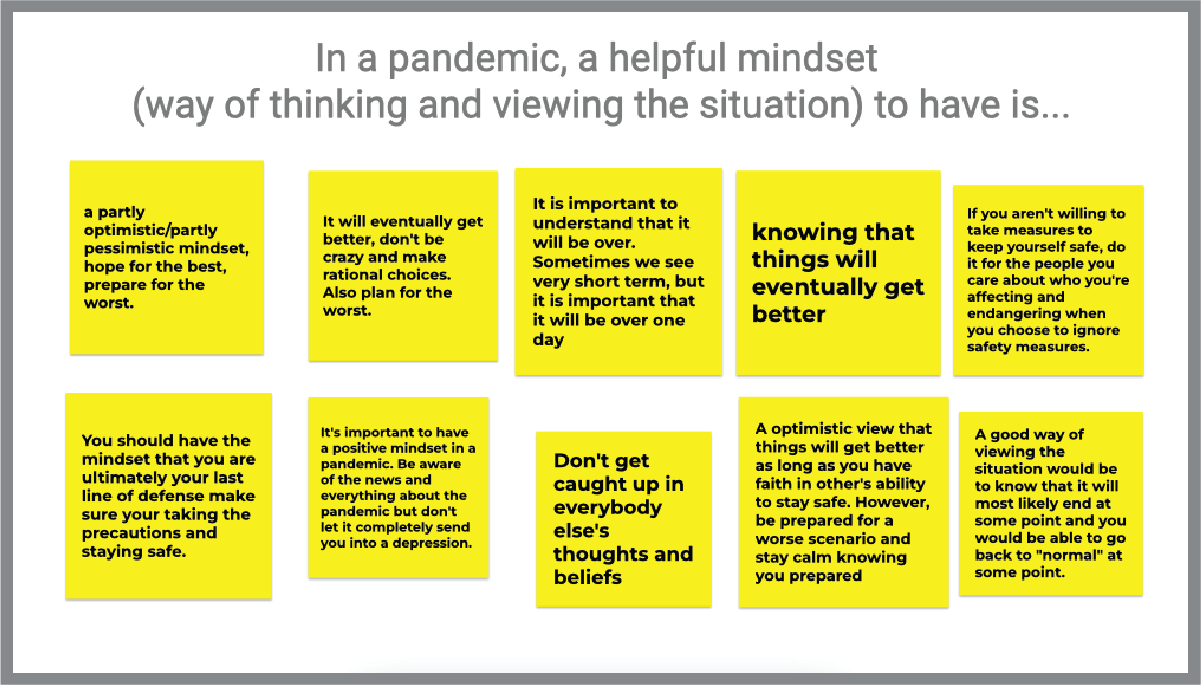
A snapshot of a Google Jamboard from an early co-design session held with teens virtually.
"Throughout this process, teens have been vulnerable, open, and generous in the sharing out of their ideas and wisdom. In their self-awareness, they've tapped into their firsthand experiences with hard topics to help make Disaster Mind relevant and responsive to their needs," shared Jane Lee, Senior Director of Operations and Mental Health at iThrive Games after our first co-design session in March 2022. "What they have contributed with their time, creativity, and retelling of their experiences navigating disruptions and shifts, has translated into a resonant resilience-building activity for their peers."
The themes and experiences teens shared with the design team and FEMA's emergency management specialists turned into actionable insights that informed Disaster Mind's content, ensuring the play experience we created was relevant, memorable, and responsive for teens.
MINDSET MATTERS IN DISASTER MIND
The work of disaster preparedness, response, and recovery is emotional. To convey this authentically and meaningfully in Disaster Mind, iThrive Sim—an award-winning platform that hosts single-player and multiplayer social and emotional skill-building simulations—was selected as the game's engine.
"iThrive Sim supports a 'learn by doing' approach where teens' emotions are ignited and used to support their active social and emotional skill-building," shares Dr. Susan Rivers, iThrive Games' Executive Director and Chief Scientist. "Each game offered via the platform is steered by teens' improvised interactions and real-time decisions, while the tech enables the modulation of stress and monitors in-game behaviors taken in response."


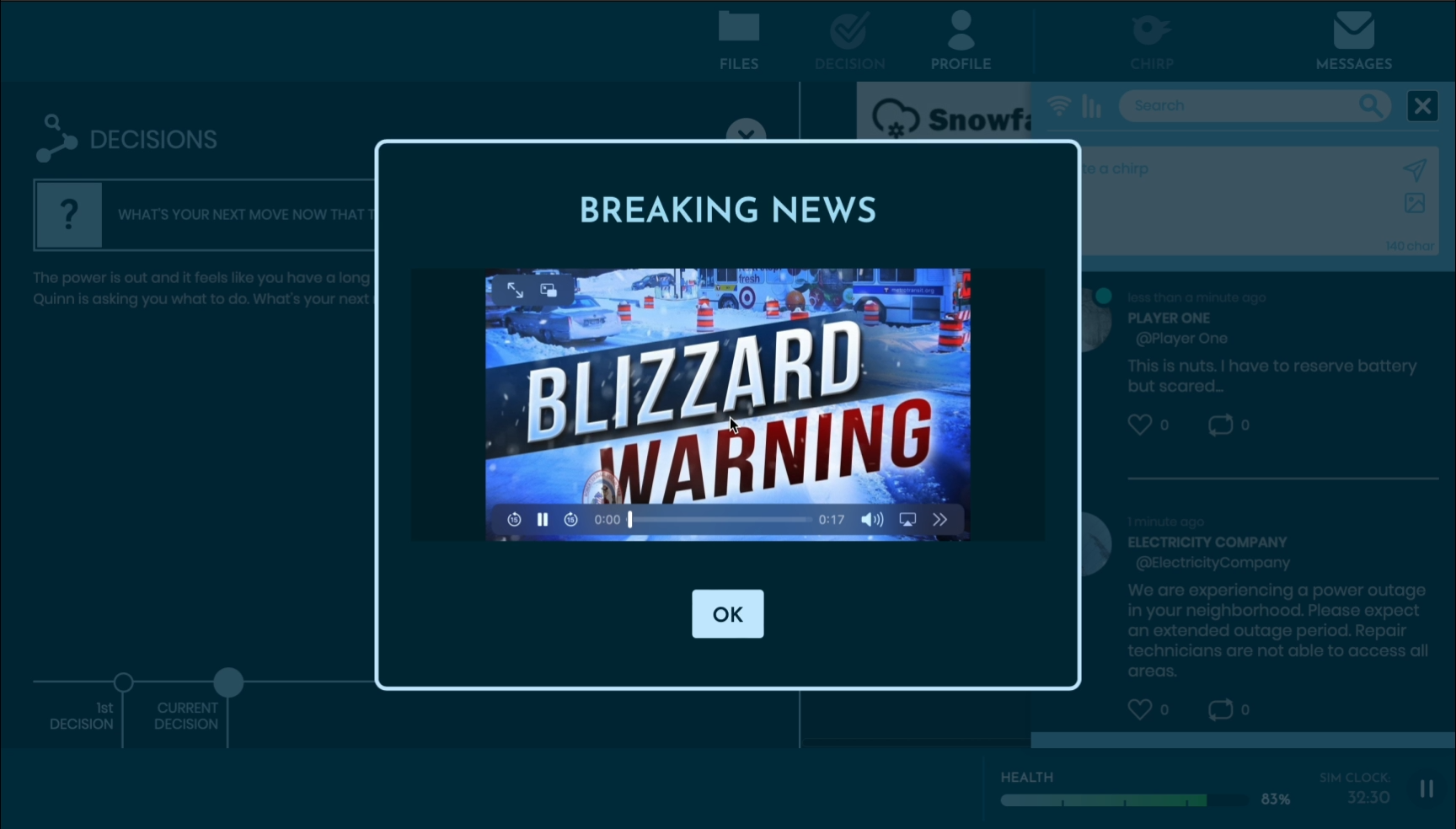
Screenshots of Disaster Mind, hosted exclusively on the iThrive Sim platform.
Using iThrive Sim's game mechanics, Disaster Mind invites players to practice social and emotional skills, like emotional regulation and responsible decision-making, while strategizing and solving their way through the game. By scaffolding this valuable skill-building with educational content meant to prepare teens for disasters, players grow familiar with the practices to lean on when complex emotions surface and the constructive mental pathways to call on when a natural disaster occurs.
Mindset matters as gameplay supports young people in being aware and actionable. Teens come to see through Disaster Mind's impactful play experience that underpinning the creation of a supply kit, or emergency go bag is an intentional mindset where one believes emergencies can happen to them and knows how to prepare.
'KNOW WHAT YOU PLAN TO DO': WHAT TEENS SAY ABOUT DISASTER MIND
True to our co-design process, teens across the country have been playing and testing Disaster Mind ahead of its launch later this year. Players reported feeling more confident in being able to prepare for an emergency and in managing the associated stress. Most report that they intend to talk to their family about an emergency preparedness plan, with many mentioning specific disasters, exit plans, emergency kits, and meeting locations.
After playtesting Disaster Mind, teens shared the following:
- "This game made me realize these types of disasters can really happen to anyone and you should always be prepared for the worst."
- "I think that it would be important in terms of cell service or other accidents to have a solid plan."
- "I now know to have a defined plan to be prepared if there were to be a natural disaster, especially if the family gets split, we should have a meeting spot."
- "Like it said in the game, you never know or never expect it to happen to you but it very well can."
- "I do intend on asking my parents if we do have a plan for if there were an earthquake. Living in an earthquake prone place, I realized that it is essential to have a plan with my family."
- "After [this] simulation, I feel like it is important to know what you plan to do."
The post-game reflections shared by young people attest to the power of the simulation. "Natural disasters are a challenge in today's world and will surely be one in the world teens and future generations will inherit," shares Stephanie Poore, the National Preparedness Branch Chief of FEMA Region 8." With Disaster Mind, our goal is to ensure teens are ready, aware, prepared, and practicing the skills that support their capacity when they strike."
New One Love Game Uses SEL to Help Young People Learn to Love Better
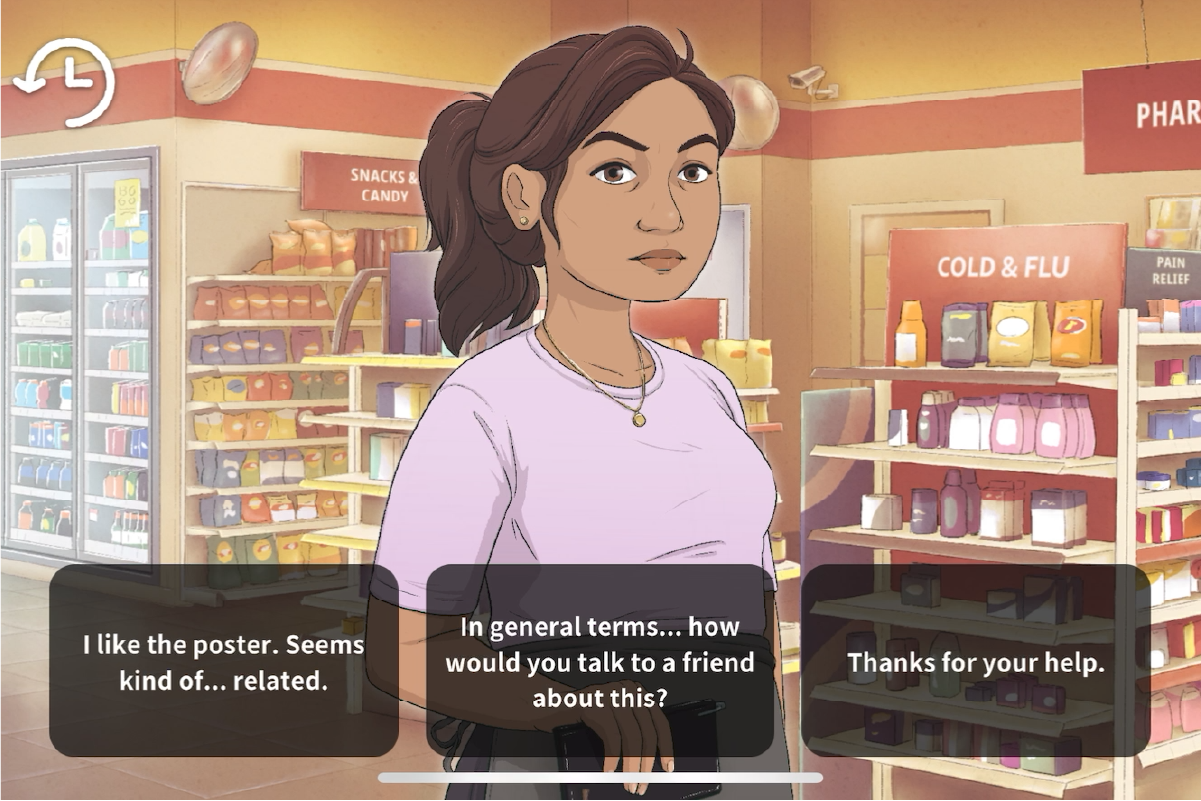
One in three young people will have an unhealthy relationship before reaching adulthood.
Interpersonal violence remains the third leading cause of adolescent death, contributing to one in every five teen suicides.
The need for more awareness-building and preventive interventions that help teens live full, safe, and healthy lives is unmistakable. Cadence Ford, a new mobile game made by the One Love Foundation in partnership with iThrive Games and Playmatics, LLC, responds to it with a safe and playful space for young people to familiarize themselves with unhealthy behaviors that may surface in relationships. As players interact with each story in the game, they are tasked with figuring out how to talk with their friends about uncomfortable issues and how to offer assistance in each of their unique circumstances. Through play, the game meets teens and young adults where they are to support their social and emotional learning and practice of constructive relationship skills.
"Cadence Ford builds on One Love's mission to bring life-saving prevention education to young people and expands on our honoring of Yeardley Love—a daughter, friend, and student-athlete whose life was tragically cut short by an ex-boyfriend in 2010 three weeks shy of graduating from the University in Virginia," shares Madeline Hopper, Senior Product Manager at the One Love Foundation. "Our goal with this game is to equip young people with the tools to love better, be with partners who practice healthy love, and advocate for healthy relationships. Because those tools are social and emotional, we were glad to have iThrive Games—experts in young people's social and emotional learning—be our partners throughout its development."
Our team joins One Love, and the teens and young adults who have played the game so far in hopes that Cadence Ford helps every person it reaches be aware, self-preserving, and better support systems for their friends in a world where antisocial interactions and unhealthy relationships are likely to be encountered. "We want all who play Cadence Ford to come to it with curiosity," shares Susan Rivers, Ph.D., iThrive's Executive Director and Chief Scientist. "And we want them to leave it empowered and better prepared to be ambassadors and practitioners of safe love and healthy communication."
MEANINGFUL GAMEPLAY, MEANINGFUL LEARNING
Cadence Ford sets forth a time-bending adventure in a charming town. Clocks have stopped, and the once-thriving community has fallen apart. The player must travel back to meet former friends, explore their stories, solve their mysteries, unearth past mistakes, and change the future before the present takes hold.
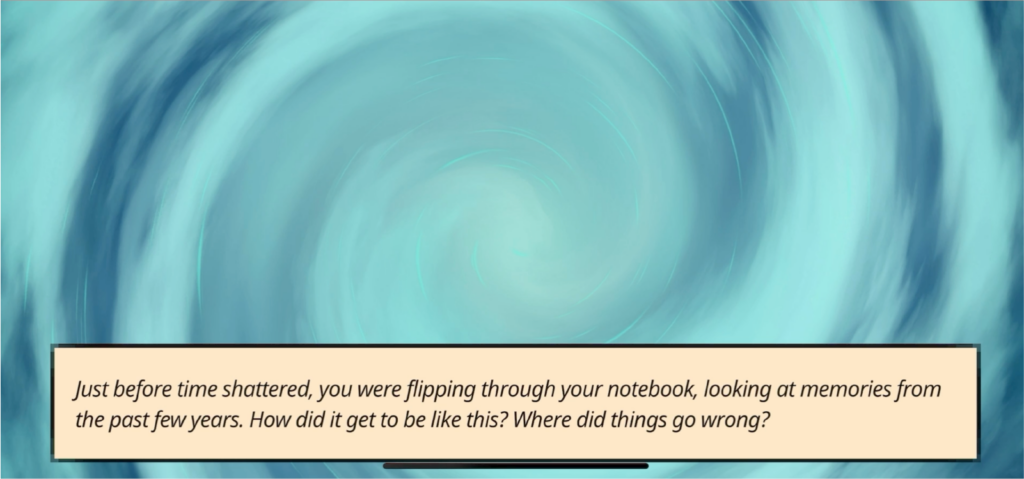
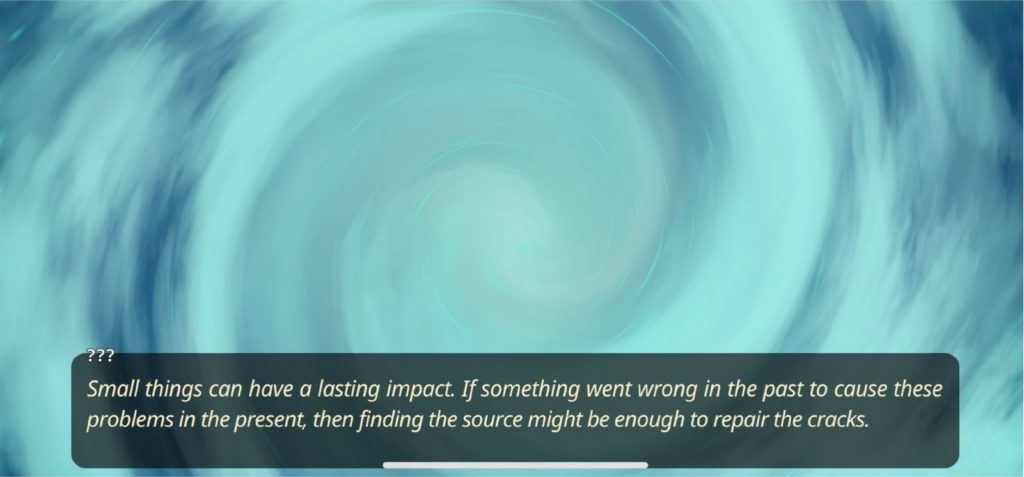
To do this, the player must make critical decisions throughout the game with how they communicate and interact with those past connections. Words must be chosen carefully since their friends' futures depend on it.
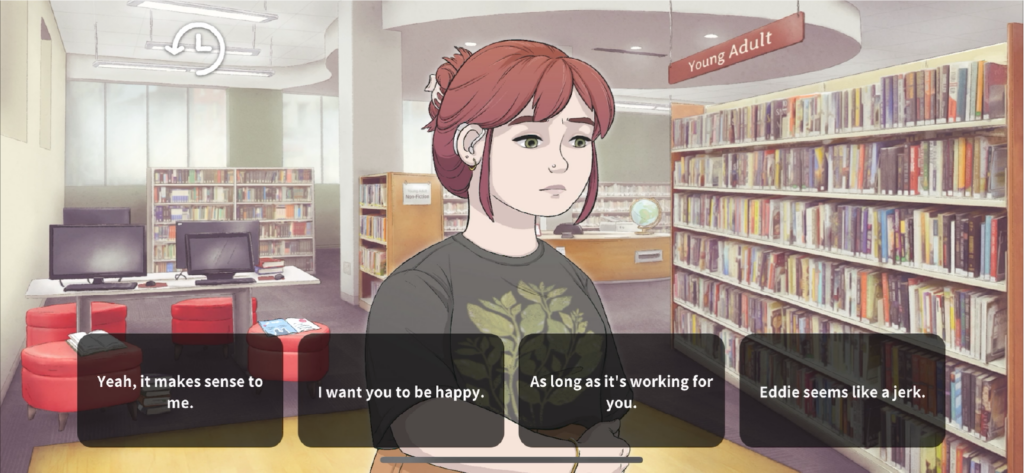
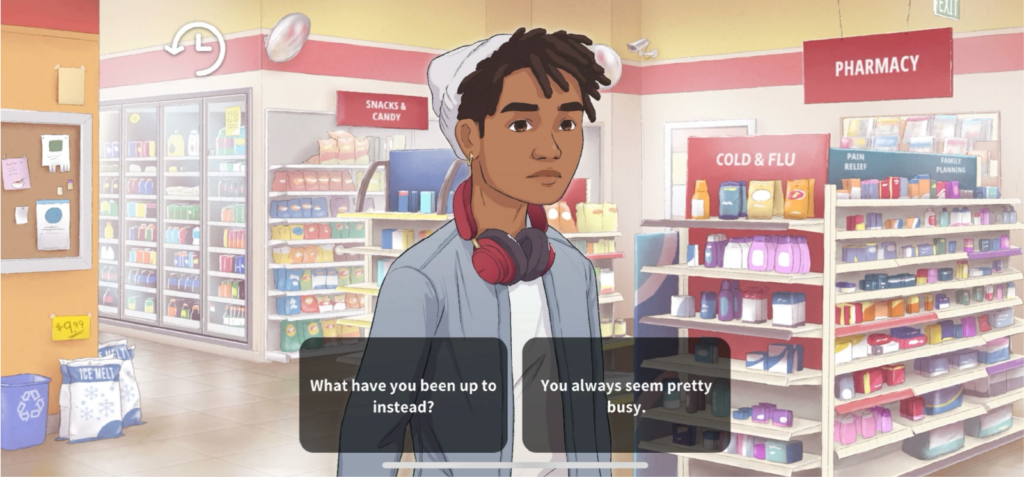
iThrive's teen social and emotional health expertise helped direct Cadence Ford's development cycle and supported the team's decision to make the game a text-based strategy one. In doing so, the play experience would build players' relationship skills by enabling their agency to make decisions and learn from them. "Games have always been microcosms of the real world, making them a springboard for exploring new ways of doing and being," shares Jane Lee, iThrive's Senior Director of Operations and Mental Health. "With Cadence Ford, we wanted to create a low-stakes, thought-provoking environment for young people to arrive at new understandings of who they are and the world around them. By making it a choice-filled offering, we offer young people a context to think expansively, arrive at learnings authentically, and fail safely."

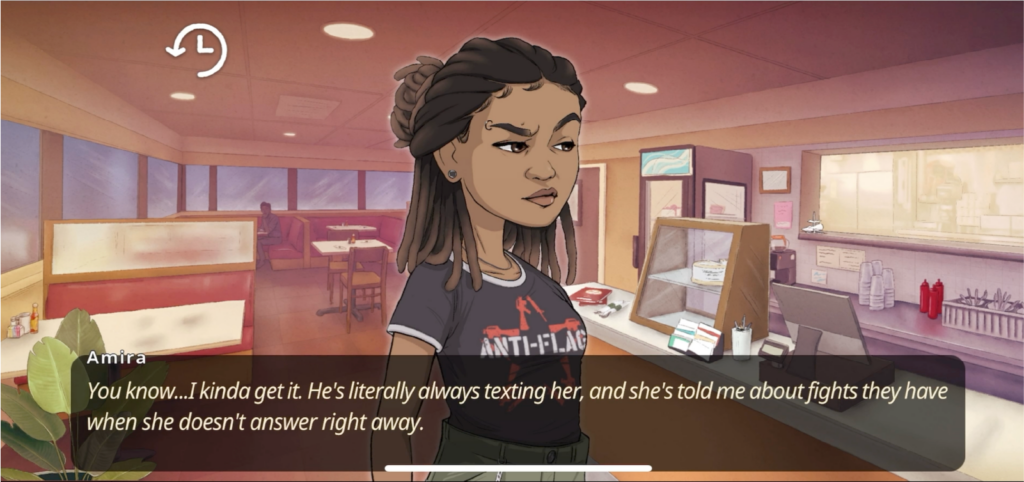
The game's mechanics assist players in navigating uneasy settings. Each of its interactive character stories helps sharpen the players' ability to listen actively, attend to conflict through productive communication, better understand restorative practices, recognize unhealthy behaviors, and uphold healthy ones.
Young people demand and deserve an ecosystem of care to do the social and emotional work that starts in early adolescence safely. Cadence Ford fits into that ecosystem by connecting them to this transformative social and emotional learning through play—a tool they're familiar with.
CO-DESIGNING STARTS WITH AND NOURISHES TEEN GENIUS
Beyond just using play as a lever for meaningful learning, the resonance of Cadence Ford is due mainly to its development alongside teens. iThrive's innovative co-design approach with young people was employed from the beginning to support us in folding in the wisdom of teens whose insights and feedback were integrated into the final play experience.
Everyone involved in the design and development of this game values the inquiry and imagination of young people. Teens and young adults in One Love and iThrive Games' networks were at the table from start to finish and developed their game design and social and emotional skills throughout the process.

Explore some of the activities that make up iThrive Games' Game Design Studio model here.
The Game Design Studio model at the heart of our co-design approach is a strengths-based one, and bringing it to the young people we co-created Cadence Ford with helped them uncover and share their thoughts. In co-design workshops, they shared perceptions on the importance of healthy relationships, defining what healthy and unhealthy signs of a relationship look like in their worlds and minds, and exploring with peers how to best navigate discomfort when it appears in the body and in peer relationships. Each of the co-designers and playtesters who lent their genius to Cadence Ford was compensated for their ingenuity as thought partners throughout this shared endeavor.
WHAT YOUNG PEOPLE SAY ABOUT CADENCE FORD
The play experience in Cadence Ford is yet another testament to the power of game-based learning. When young people who played the game for the first time were asked, "What did you learn about talking to friends in unhealthy relationships?" they shared responses that reflected their sharpened relationship skills and communication practices like "star[ing off small before jumping into the topic" and aiming to "understand their situation while encouraging healthy habits." Others shared that through the game, they "learned some new lines to help [themselves] and friends cope with relationship and friendship situations," "how to spot unhealthy behavior in a relationship," and "how to respond in situations where you see someone you know in these unhealthy relationships."
Like the many who have played the game and been a part of its making, we want Cadence Ford to assist young people in learning to be champions of healthy love and be with partners who practice it. "Yeardley's legacy of joy lives on in this game," shares Hopper. "At One Love, we work to change the statistics around relationship abuse one conversation at a time. With Cadence Ford, we're promoting that change one play session at a time."

Make It A Gameful School Year: Meeting Teens Where They Are With Play
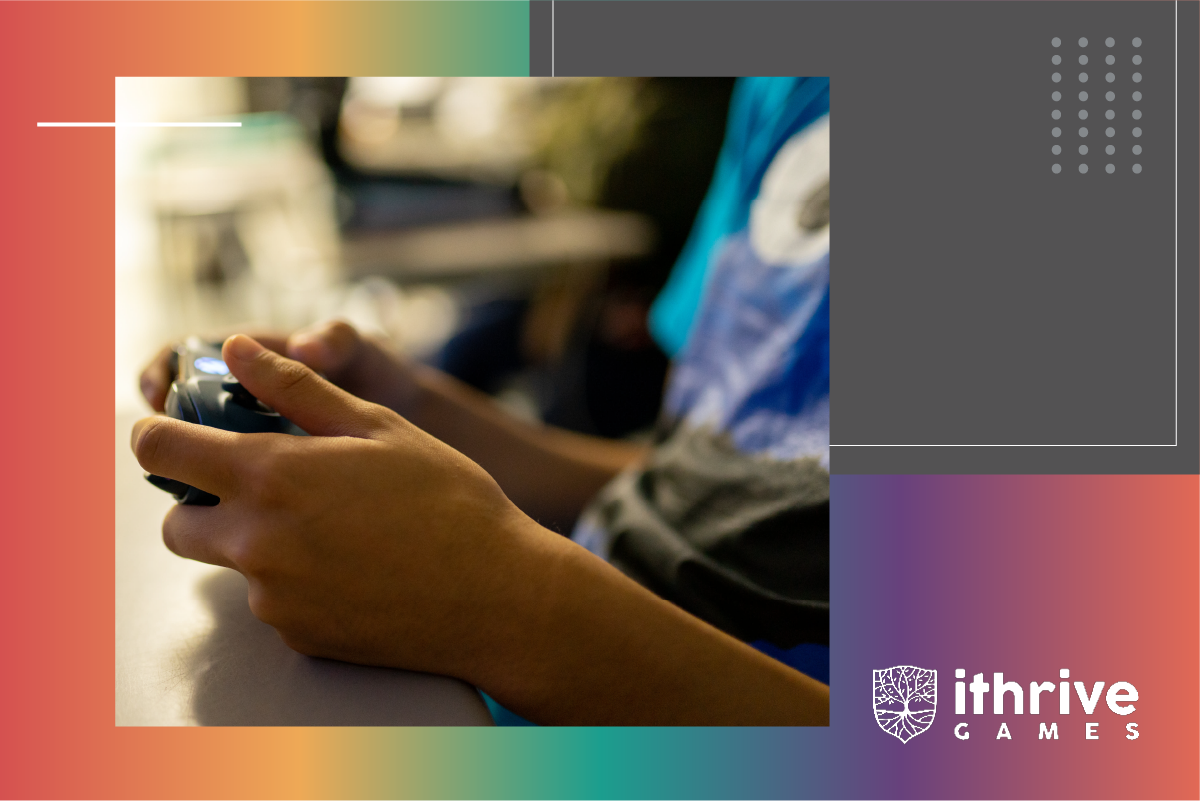
"I'm always going to enjoy a lesson where you can learn and have fun... It helps keep the students focused and even helps motivate them. I know I'm motivated to find out what happens next," shared a high school senior who, along with peers in his humanities class, was one of the first to gather around an Xbox One, play What Remains of Edith Finch, and meaningfully learn from it using our iThrive Curriculum unit, Museum of Me.
Games like What Remains of Edith Finch merge mechanics, worldbuilding, and challenges to deliver emotional and immersive experiences to all who play them. For the 85% of teens in the United States who play them (International Journal of Mental Health and Addiction), they are a solid and steady source of joy, connection, and entertainment.
At iThrive Games, we see the curiosity, embrace, and eagerness activated in teens by a never-before-seen start screen as a launchpad for social and emotional learning (SEL)—a transformative skill-building practice proven to protect and promote their mental health. Our team folds in what we know about the transcending and emotion-evoking power of games into a unique multidisciplinary, user-centered, and participatory approach that brings teens, researchers, game developers, and our adolescent development experts to the table to envision, create, and test tools that support teen thriving.
The games and game-based learning experiences we've co-designed alongside libraries, museums, schools, and youth-serving organizations we work with fully recruit the feelings conjured through play to create a wellness-supporting experience that centers teens' social and emotional needs. We use play to bring SEL to young people in a developmentally responsive way with games that invite them to uncover and nourish their strengths, craft and answer their own questions—activities that expand their understanding of themselves, others, and the world around them.
Beyond enthusiasts, we are ambassadors of play. Our team's first-hand witnessing of what games do (and can do) over the last five years has affirmed our belief in their unique capacity to support young people's thriving. We fully encourage educators, program coordinators, and all working with teens this school year to bring them into the spaces they share with them to see the power of play first-hand, too. Keep reading for resources, recommendations, and insights that support the integration of games in teen-serving settings and their use in teen-centered ways.
WHAT PLAY DOES (AND CAN DO) FOR TEENS
Play is beneficial for all of us, but for teens especially. Here are five things play does for young people, and can support, enable, and elevate when brought into the spaces where young people gather and learn:
Play activates deep learning and personal growth. Games present opportunities for teens to engage interactively and think expansively. Environmental storytelling coupled with mechanics that govern and guide the player's actions and the game's response to them give way to an experiential context where teens build knowledge while exercising personal agency—the conditions for deep, meaningful learning. "Games offer teens the ability to fully inhabit the world of a video game, to embody characters with agency along with the chance to impact the world and characters around them," shares Susan E. Rivers, PhD, iThrive's Executive Director & Chief Scientist. "They offer the agency and low-risk experimentation that teens rarely get but sorely need to discover who they want to be."
Play supports social and emotional development. Games make us feel. They delight us, challenge us, calm us, frustrate us, and excite us. They can prompt problem-solving, conflict resolution, and empathy, provoking opportunities that support teens' social and emotional learning. Social and emotional learning is defined by the Collaborative for Academic, Social, and Emotional Learning (CASEL) as "the process through which all young people and adults acquire and apply the knowledge, skills, and attitudes to develop healthy identities, manage emotions and achieve personal and collective goals, feel and show empathy for others, establish and maintain supportive relationships, and make responsible and caring decisions."
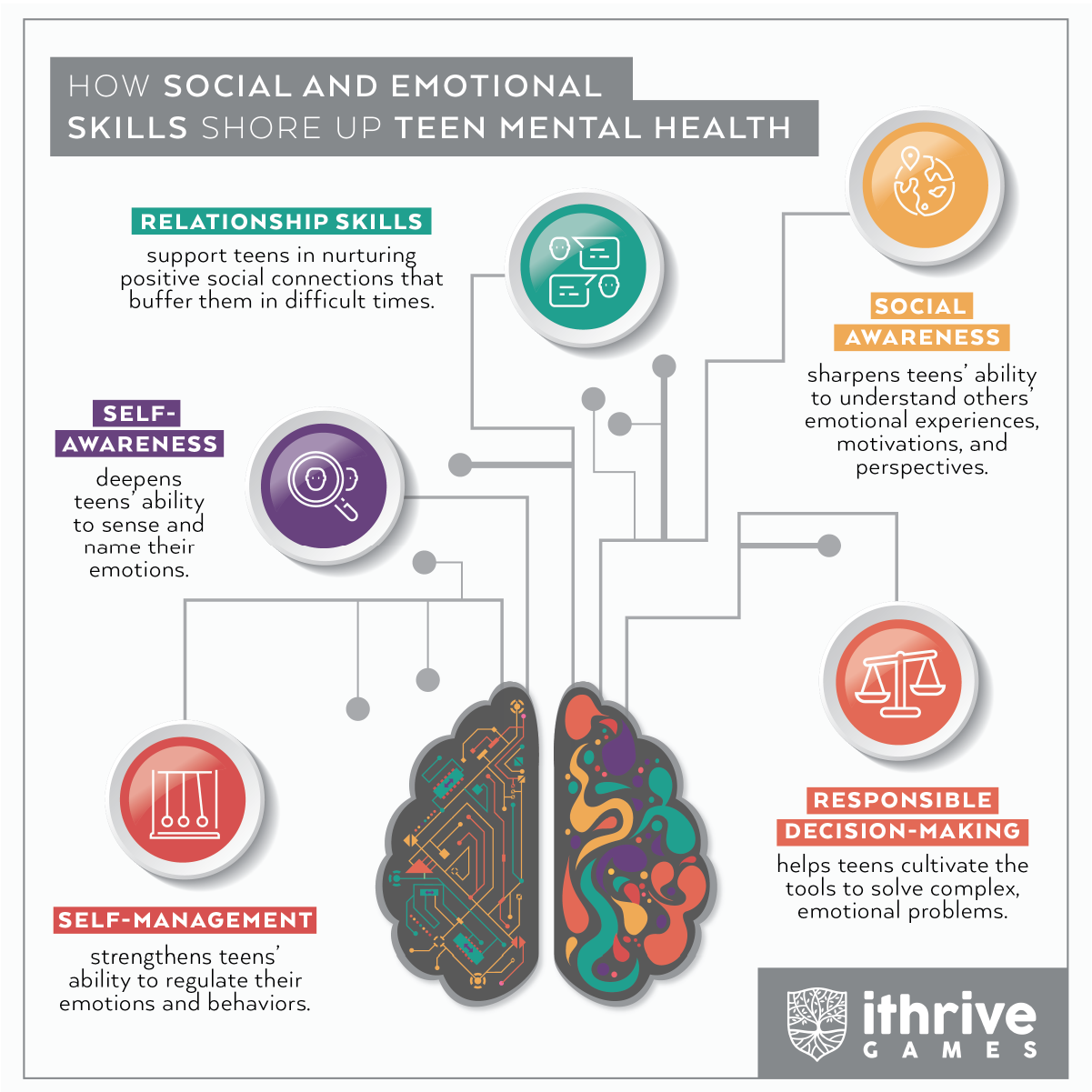
"How Social and Emotional Skills Shore Up Teen Mental Health." iThrive Games. https://tinyurl.com/what-sel-does-for-teens
Games provide a social space ripe with opportunities for young people to lean into these tasks, as well as developmental ones like identity exploration, establishing and exercising independence, and finding their place in community.
Play soothes. Games transport and immerse teens in new worlds, and with the space to interact as a new character and confront conquerable challenges comes the opportunity for stress reduction, self-gratification, and flow states. In countless co-design sessions with teens, we've heard that games are an outlet for relaxing and unwinding, providing a constructive space for coping, breaking for a bit, and pressing pause in challenging moments.
Play fosters connection. When teens play with peers, be it competition or collaboration, they socialize and connect, tasks paramount to their mental health. In the connective spaces games offer, teens can share their triumph and joy with others. They can work together toward a shared in-game goal and, sometimes, tackle the fallout of a shared loss in powerful bond-building experiences.
INTEGRATING PLAY WHEREVER TEENS LEARN AND GATHER
The work of adolescence has always been social and emotional, and young people need tools and strategies to help them navigate it. What games do for teens make them a useful means of support, and when enlisted by adults in their world as a medium of engagement, they are further solidified as valuable parts of young peoples' toolkits.
For all looking to leverage the power of play this school year while in community with teens, here are three ways to do so:
1. Pull in a game-based learning curriculum, or create your own.
Game-based learning supports educators in using the power of games to define and support their students' learning outcomes. When lesson plans leverage video games—an entry point familiar to most teens—they pave the way for a culturally responsive learning experience supportive of innovative thinking, deep learning, and in the case of our standards-aligned iThrive Curriculum units, A Moment in Time, Museum of Me, and Sam's Journey) that center themes relevant to teens like navigating identity exploration, relationships, and social media, their social and emotional development too. For educators who value accessibility also, game-based learning aligns with Universal Design for Learning principles. As a stark differentiation from traditional learning approaches, games help educators reach and engage teens with a practice that acknowledges that teens are vast and wonderful, engaging with concepts from different access points. Here's how to choose a video game for a high school humanities or English class and a case example of how iThrive Games does so.
2. Employ role-playing simulations to support a 'learn by doing' approach.
Role-playing simulations engage teens in a high-energy experience with hands-on learning as they are challenged to strategize and act. Multiplayer ones, particularly, invite them to interact and investigate with each other and pursue shared goals. The embodied learning accompanying the role-playing propels their curiosity and motivation to explore possibilities transferable to real-life contexts.
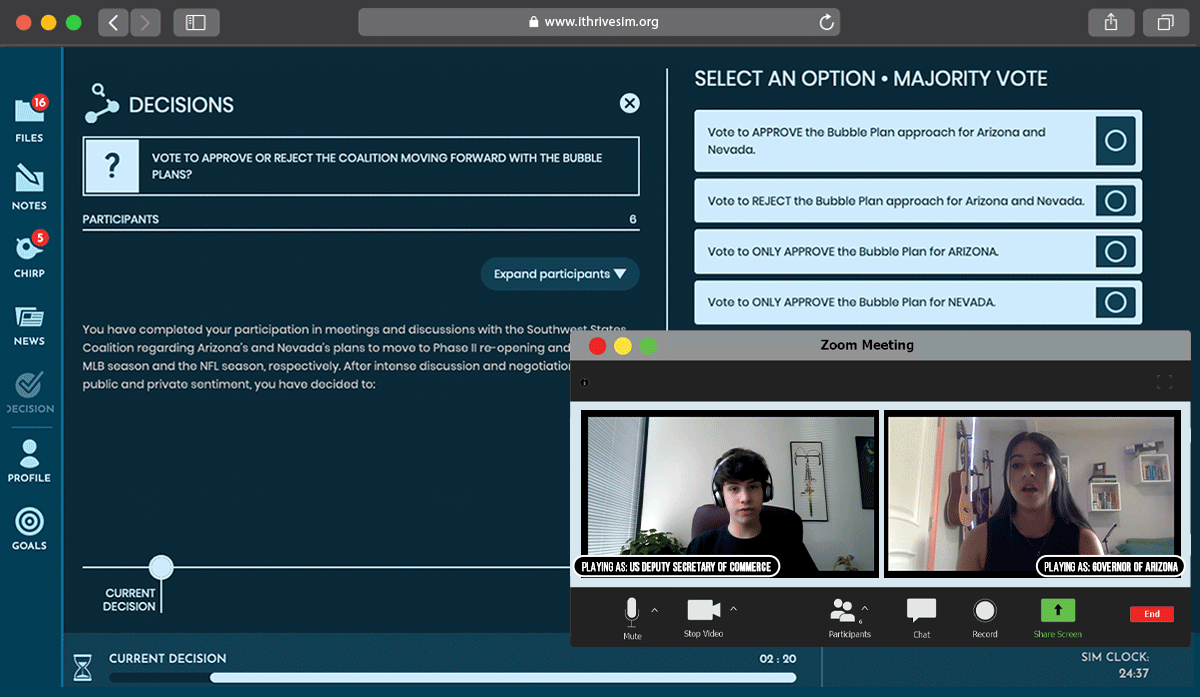
High school students playing iThrive Sim: Lives in Balance. See the gameplay in action here.
The simulations offered via iThrive Sim, our award-winning simulation platform that hosts dynamic role-playing games that scaffold educational content with social and emotional skill-building activities, encourage teens to learn by doing. Each one in our core civics library (Lives in Balance, Leading Through Crisis, and Follow the Facts) invites teens to play alongside their peers, prompts them to draw on their own experiences and their social and emotional skills while making decisions, demonstrate critical thinking, acquire and interpret information, and navigate challenges collaboratively. Dive into the social and emotional skill-building and civic learning that happens in each iThrive Sim game experience here.
3. Unleash teen creativity by inviting them to be game designers.
Why? As teens progress through adolescence and develop their capacity to reason thoughtfully and think critically, this three-letter question becomes all the more important and prominent in their lives. The cognitive growth teens undergo propels them to investigate the 'whys' that shape how they live and see their world. They move from thinking concretely and heavily relying on physical observations to thinking abstractly about possibilities. In this last major phase of development, where teens are primed to learn and adapt, curiosity becomes a growth point, and game design uniquely nurtures it in them. Our Game Design Studio Toolkit, developed in collaboration with EdTogether, sandbox games like Minecraft, and game-making tools like Roblox, provide teens with a springboard for unpacking complex challenges, investigating questions, and stepping fully into their creativity.
Games are unsurpassed in their ability to engage teens in physical and virtual worlds deeply. They offer teens a safe space to wander and wonder, exercise their innate curiosity, and build new understandings of themselves and each other. When used as a medium for engaging with young people in the spaces where they gather, they become more than entertainment—they become levers for social and emotional support.
How are you using play this school year? Let us know on Twitter by tweeting us @iThriveGames using the hashtag #GamesforThriving, and stay updated with our game-based resources and game design work, done with and for teens, by subscribing to our monthly newsletter.
iThrive Games Named a 2022-2023 Tools Competition Winner
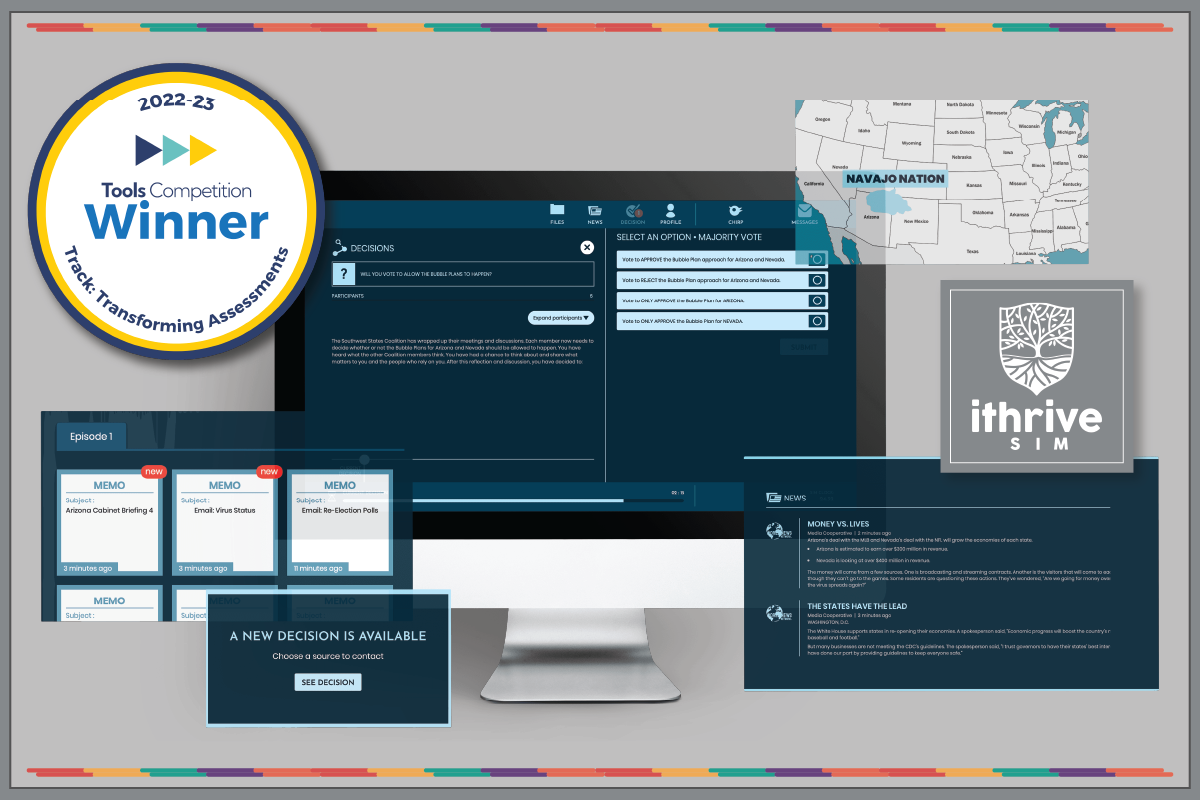
NEWTON, MA - Today, iThrive Games was named one of 32 winners of the 2022-2023 Tools Competition. The nonprofit, which leads the development of wellness-supporting games and interactive experiences designed with and for teens, joins teams from 12 countries being awarded more than $4 million to develop and expand tools that will impact 35 million learners by 2026.
As winners in the Transforming Assessments track and recipients of a Growth Phase award, iThrive Games will receive $100,000 to expand its proprietary simulation game engine, iThrive Sim, with new ways to measure and assess the teen social and emotional learning (SEL) happening on the platform through play.
iThrive Sim authors and delivers immersive and interactive simulation games for teens that translate into meaningful learning experiences in the spaces (in-person and online) where they gather. Since launching in 2020, the game engine, built with iThrive Games' software development partners Affordance Studio, has been cemented as an ed tech tool supportive of deep and enduring social and emotional learning, peer connection, and collaborative problem-solving, earning recognition for its innovative approach to learning and unique response to the educational needs of the COVID-19 classroom. Explore iThrive Sim's dynamic features here.
The Tools Competition win enables the iThrive Games team to build new data collection and assessment capabilities onto the iThrive Sim platform that will allow teens, educators, and teen-serving adults who facilitate games on the platform to measure and evaluate the social and emotional skill-building iThrive Sim games facilitate, expanding the game engine's responsiveness to a growing demand for holistic and experiential learning tools that support social and emotional needs as well as academic ones. Self-reported assessments and expanded monitoring of in-game behaviors will help teen players reflect and become aware of how they collaborate and respond to stress and connect them with tools to calibrate. With the expansion too,iThrive Sim game facilitators will be able to access individual and aggregate reports after each play experience, empowering them with valuable insights to support the planning of personalized SEL interventions.
"iThrive Sim embeds SEL opportunities to support and enliven teen-centered learning across so many topics, from civics education to counterterrorism, from game theory to emergency preparedness, and more," says Susan Rivers, Ph.D., iThrive Games' Executive Director and Chief Scientist. "This Tools Competition win enables our team to continue designing interactive experiences with and for teens on the iThrive Sim platform that are as fun as they are impactful, ones that not only amplify teens' strengths but also equip them with a play-driven way to measure and grow them."
As one of the largest edtech competitions in the world, awarding nearly $10 million to 80 ed tech innovators to date, the Tools Competition aims to grow the field of learning engineering by spurring ed tech innovations that leverage big data to support learning science research and the needs of learners worldwide. This year was its third cycle, generating more than 1,000 proposals from 73 countries.
The 32 winning teams from the 2022-203 cohort hail from institutions and organizations across North America, Europe, Asia, South America, the Middle East, and Africa, and it is an honor for iThrive Games to be among them. Recognized and supported through the Tools Competition, the win recognizes and supports each team in tackling solutions to improve students' K-12 math competency following the sharpest declines in decades, address equity in education, bolster students' problem-solving and emotional skills, and unlock career training opportunities for adults via virtual reality. The next cycle of the Tools Competition will launch on September 21, 2023. To learn more, sign up to attend the virtual competition launch event here.
"It's been an honor to take part in the Tools Competition this cycle and learn alongside other ed tech innovators who are bridging their expertise with others from different disciplines to craft solutions that accelerate learning and maximize our understanding of what works for young people's wellness and learning," shares Dr. Rivers and the iThrive Games team. "Our work as a nonprofit over the last five years has centered young people's learning and their social and emotional health. We're eager and excited to build on this mission and on what we know already to deliver even more transformative solutions powered by iThrive Sim and impactful play."
To stay updated with iThrive Games' impact-driven game development and experience design work as well as iThrive Sim's expansion, subscribe to iThrive's monthly newsletter here.
A full list of the 2022-2023 Learning Engineering Tools Competition winners and their projects can be found here.
CONTACT INFORMATION
Eghosa Asemota, Senior Director of Marketing and Communications, eghosa.asemota@ithrivegames.org
ABOUT ITHRIVE GAMES
iThrive Games Foundation is a 501(c)(3) nonprofit organization that leads the development of wellness-supporting games and tools, designed with and for teens. Our team of adolescent development experts builds on 30+ years of combined instructional and game design experience to create compelling and accessible experiences that nurture teens' genius by folding in social and emotional skill-building—a practice proven to nourish mental health and learning.
ABOUT THE LEARNING ENGINEERING TOOLS COMPETITION
The Tools Competition ran two funding opportunities this year: The Learning Engineering Tools Competition focused on Pre-K-12 learners and was supported by Schmidt Futures; Kenneth C. Griffin, Citadel, and Citadel Securities; the Walton Family Foundation; the Bill & Melinda Gates Foundation; and AlleyCorp. The DARPA AI Tools for Adult Learning opportunity is supported by the Defense Advanced Research Projects Agency (DARPA). The competition is administered by Georgia State University and The Learning Agency.
We Asked Gamers About Their Hard Days at Play NYC. Here’s What We Learned.
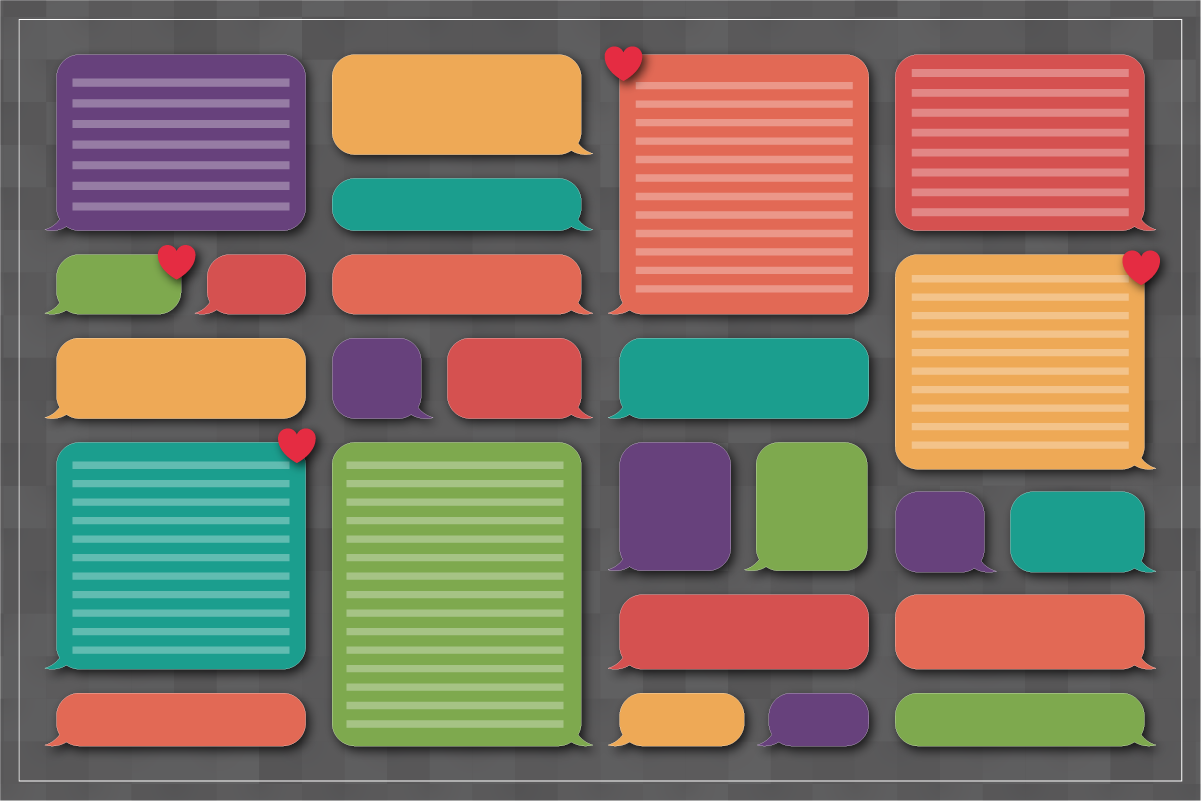
Our ability to feel is what makes us human. It is fundamental to who we are, underlying how we connect and the realities we co-create.
It supports our sense of self, helping us unpack our thoughts and reactions, build awareness of what's happening around us, and deepen our knowledge of ourselves in relation to the world we live in.
Games make us feel. They delight us, challenge us, calm us, frustrate us, connect us, and excite us. They're also uniquely captivating, not just in what they portray aesthetically and demand mechanically, but because of the state of embrace they insist on those who play them. Encountering a never seen start screen or the unopened box of a new tabletop game, we are ready, willing, and receptive to knowledge. Play's ability to get us to put our guard down, be curious, and engage with new possibilities helps create the conditions for transformation and meaningful learning.
Earlier this month, the iThrive team showcased at Playcrafting's Play NYC—an event that magnified the power of play and brought hundreds of game industry professionals, indie game developers, and game designers together to exhibit their games to players and peers. There, we shared Cadence, a single-player, text-based strategy game we created with the One Love Foundation and Playmatics, LLC. Cadence invites players to explore three of their friends' stories and converse with them via real-time dialogue choices that affect their friendships and outcomes. Building on One Love's mission to empower young people with the life-saving prevention education, tools, and resources they need to see the signs of healthy and unhealthy relationships, Cadence supports young people in learning to love better, in being with partners who practice healthy love, and communicating with loved ones who are in unhealthy relationships. While New Yorkers of all ages played a demo of the game and shared feedback, teens, many of whom went on to become members of our Teen Hub, were particularly moved by the game's storyline, mechanics, and captivating 2D art.
Beyond the valuable feedback we received on Cadence, slated for release later this year, the experience provided another opportunity for our team to create a forum for listening to and learning from young people. At PLAY NYC, we marked a large glass bowl with the question, "What makes you feel better on your hard days?", and teens and young adults anonymously shared the following:
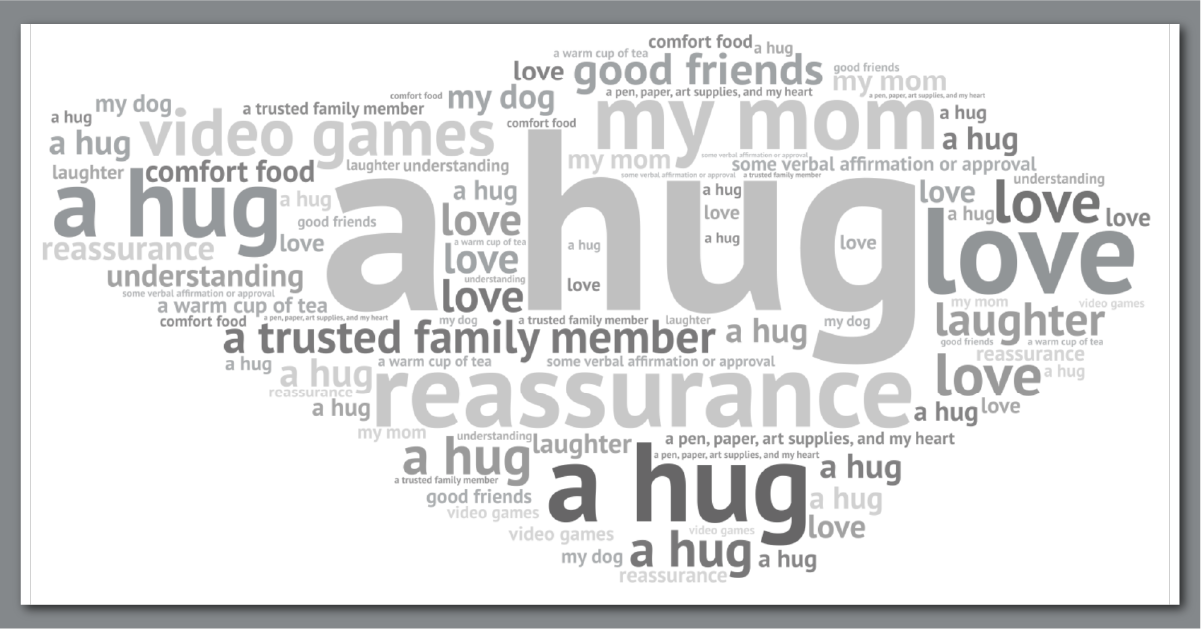
ARE WE LISTENING?
Tucked in each of these answers is a guidepost for innovation—caring, joy, connection, self-expression. Creating safe spaces where teens are heard and listened to with the intent to understand them has guided our game development and experience design work over the last five years, and empathic listening and design is what has made the impactful play experiences we've designed with and for teens possible. The needs echoed and desires illuminated in the responses we elicit from young people in the safe spaces our social and emotional learning experts create (in this case, a glass bowl, and lime green Post-it notes) are folded into the game concepts we envision with clients and collaborators
Empathic listening has long been a driver of breakthrough thinking. Being in community with teens and young adults has helped us think expansively and collaboratively. We've found that empathy, when practiced consistently, is essential to transformative change and central to the knowledge-building and knowledge-sharing that informs the design of meaningful solutions.
iThrive's co-design approach, which gives teens the tools to step into their genius and explore their needs, is care in action. Our approach creatively empowers young people with new ways to tap into their genius, share their experiences and wisdom with others, advocate for the support they deserve, and create with us the experiences they want to see.
With the Centers for Disease Control and Prevention (CDC) reporting that nearly half of U.S.-based high school students are experiencing persistent feelings of sadness and hopelessness, it is on all of us in the game design ecosystem to create the spaces, in person and digital, to listen and effectively gauge the thriving of end users. With over 90 percent of teens and young adults self-identifying as gamers, every game designer, developer, and writer has the tools to meet them where they are and equip them with valuable knowledge, tools, and support. It is on all of us always to ask, "Are we listening?"
ARE WE SUPPORTING?
The learning that comes from listening allows all designers and developers to respond constructively, and offer support in meaningful ways. Games are already socially and emotionally valuable, and when tailored to teens and young adults' strengths, developmental needs, and insights, they become vessels for further social and emotional support.
Our adolescent development experts work with and for young people, and in partnership with libraries, museums, government agencies, and organizations that care about them, fully recruit the feelings that play evokes to support teens' social and emotional health. The science of adolescence and evidence-based practices that support positive teen growth are folded into the games, game-based tools, and interactive learning experiences we create. Questions like "How does this enliven teens to practice healthy skills like exploring their identity, engaging with their community, and taking purposeful action in the world?"; "How does this invite teens to regularly notice emotions, helping them notice the thoughts, sensations, and behaviors that accompany their feelings?"; or "How does this normalize help-seeking?" steer the game development process we lead, ending in a play experience that nourishes young people in ways supportive of their wellness, learning, and thriving.
At Play NYC, we shared questions like these on a printout version of our 10 Things to Know When Designing for Teens resource, given to other game designers and developers eager to go beyond listening and to start responding and supporting young people's social and emotional needs. We're happy to now make that resource accessible to everyone and downloadable via the Resource Hub on our website.
Asking and listening helps us understand people and ideas. That insight and evidence-based practices nudge us toward wellness-supporting games and more impactful play experiences for young people. For the design team or studio looking to elevate the impact of the games they create for young audiences, connect with us today for a consulting report benchmarking your game in development against the science and sharing recommendations on ways to fold in social and emotional skill-building—a practice proven to protect and promote teen mental health.
Together, we can and should advance wellness wherever young people are. Join in.
When Museums Design Experiences for How Teens Learn and Develop

The COVID-19 pandemic affected all spaces where gathering happens—museums included.
In the face of unprecedented shifts and challenges, museums innovated and devised new ways to engage with young people safely. iThrive Sim: Lives in Balance, for example, is a tech-powered simulation game we created with the masterminds behind the Situation Room Experience at the Ronald Reagan Presidential Library and Museum to bring forth new digital spaces for teen collaborative learning and play at their museum. The in-person and virtual classroom-optimized experience won a gold American Alliance of Museums (AAM) MUSE Award and a bronze MuseWeb GLAMi Award in 2021.
As museums work to recover pre-pandemic visitation numbers, the opportunity to lean into innovation presents itself once again. Building appeal to teens, who are already deepening their social awareness in informal spaces and are actively engaged in civic discourse, offers a promising pathway for increasing visitation and cultivating a pipeline of lifelong museum supporters and allies in the missions of museums too. Data from the National Awareness, Attitudes, and Usage Study shows that over 60% of adult museum visitors first attended them as adolescents, building the case and design directive for more experiences meaningfully showcasing history to young people. The science of adolescence lends valuable insight that can support the design of exhibits and experiences that are engaging, relevant, and accessible to teens—ones that prepare them for the world they are already asking questions about and are eager to inherit. Centering how teens learn supports museum design teams in building on these entry points meaningfully and fostering transformative learning in each of their youth visitors.
WHY YOUTH VISITATION AT MUSEUMS MATTERS
Curiosity has always been the emotional engine behind discovery. When young people visit museums, they exercise curiosity as they engage with history, art, cultures, science and more. The social awareness they build is vital in a world where empathy inspires and steers co-creation. "Museums offer critical spaces, beyond the walls of the classroom, where effective learning can, or rather needs to take place," says Dr. Fernande Raine, founder of History Co:Lab. "Museums are a chance for young people to see what is possible, what dreams have been held, what fights have been fought, what pitfalls must be avoided, and which horizons we might steer towards. When museums really invite young people in, they have the chance to activate them as changemakers."
HOW MUSEUMS SUPPORT SOCIAL AWARENESS IN YOUNG PEOPLE
Museums hold cultural knowledge and are a celebration of our collective heritage. Highlighting the genius and experiences that have existed throughout human history, museums support youth visitors in exploring stories different from their own, deepening their understanding of other cultures and perspectives, naming our connective threads, and developing an appreciation of them. The Music HerStory: Women and Music of Social Change exhibit at the National Museum of American History: Kenneth E. Behring Center, for example, expertly weaves and displays media collections from the Smithsonian Libraries and Archive and the Center for Folklife and Cultural Heritage to highlight the central role women changemakers, groundbreakers, and tradition-bearers have played in shaping America's musical landscape and steward social progress. Experiences like this deepen social awareness in young people of our connectedness and catalyze wonder and curiosity into how the past connects with our present.
Museums also cultivate togetherness by creating a communal space where all attendees, young and old, seek and engage with novelty at the same time. This shared activity brings forth a sense of coherence that museum educators have used as a springboard to enhance community and enrich young people's understanding of the world and their place in it. For instance, the National Museum of African American History and Culture (NMAAHC) in Washington, DC hosts artifacts like Harriet Tubman's hymnal and Nat Turner's Bible and highlights the richness of the African-American experience and the profound influence of African-Americans. Striving to ignite critical thinking and stimulate thinking that supports community-building, NMAAHC provides educational resources that foster discussions and reflections on race and identity that helps youth attendees arrive at the understanding reflected in James Baldwin's words displayed on its atrium wall: "...history is literally present in all that we do."
Reflected in each of these museums is a desire to empower visitors to take the learning they acquire to the world. Creating compelling experiences and exhibits at museums that engage young people in their genius ensures this happens at scale, as teens, now and always, have always been the disruptors of norms and devisers of change. "We need our museums to choose to intentionally design their spaces for young people so that the social awareness they build while there effectively prepares them to lead social change," shares Dr. Raine. "When we connect young people to experiences that prompt their curiosity and sharpen their capacity to fully engage in it, we're prepping them for the world they'll inherit."
DESIGNING MUSEUM EXPERIENCES FOR YOUNG PEOPLE
When exhibits and experiences are designed to evoke curiosity in young people, museums enable them to deepen their grasp of the past, present, and future, and engage in empathy and perspective-taking while doing so. This work falls in the realm of social and emotional learning—a process defined by the Collaborative for Academic, Social, and Emotional Learning (CASEL) as one where young people "acquire and apply the knowledge, skills, and attitudes to develop healthy identities, manage emotions and achieve personal and collective goals, feel and show empathy for others, establish and maintain supportive relationships, and make responsible and caring decisions."
Over the last five years at iThrive Games, we have partnered with museums, libraries, nonprofits, and youth-serving programs to co-create games, tools, and experiences for and with teens that center what they want, need, and how they uniquely learn. Folding the brain science of adolescence into each of these has allowed us to turn them each into social and emotional skill-building experiences that are developmentally nourishing and memorable for young people.
TIPS FOR DESIGNING MUSEUM EXPERIENCES FOR TEENS
With social awareness already in play, museums have a one-up in adding transformative, social and emotional learning-rich experiences and exhibits to their museums that are appealing to teens, invite them to meaningfully exercise their curiosity, and add to a resonant showcasing of history. Here are five expert-informed tips and recommendations for museums looking to build their appeal to young visitors and create resonant experiences for youth groups:
AIM TO CREATE AND FACILITATE MEANING-MAKING LEARNING EXPERIENCES, NOT DIRECTIVE ONES.
In adolescence, teens reach a cognitive peak and get wiser about the world. They easily see through attempts to manipulate or preach to them and don't respond well to hypocrisy, unfairness, or imposition. The most supportive and engaging form of learning for young people at this stage of development are experiences that invite meaning-making.
Meaning-making experiences effectively account for what teens already know and the questions they are asking themselves while empowering them to be active in their learning. "The best museum exhibitions and interpretive programs ask visitors to make meaning for themselves," shares Sarah Jencks, History Co: Lab's Deputy Director of Museum Learning. "They establish dialogic frameworks, asking visitors to connect their personal experiences and the current world to their collections and places and the stories and people that bring them to life. The work of museum educators is to cultivate curiosity and empathy in visitors, setting up conditions that allow the visitors to make their own meaning and then, in the right circumstances, to share them with one another."
When meaning-making experiences happen at museums, they become settings for young people to construct valuable knowledge and learn lifelong understandings.
ENLIST THE BODY IN TEENS' LEARNING AND DISCOVERY.
As white matter increases in the brain's command center during adolescence, teens' brains form new connections, optimizing how they communicate information and how quickly they process it. Uniquely wired to learn, teens have an expanded ability to troubleshoot, problem-solve, multitask, and turn what they think, feel, see, hear, taste, and experience into wisdom. Embodied activities that enlist the body in teens' discovery and construction of new knowledge can be offered at museums to fully engage and build on this magnificence. At iThrive Games, we advocate for play and often enlist it in the tools and experiences we co-create with our partners as a lever for meaningful learning. "Play, both solo and interactive, invites new ways to be creative," shares Dr. Susan Rivers, iThrive Games' Executive Director and Chief Scientist. "It forces a novelty on all involved, often evoking emotions and compelling full-body engagement—two parts that make games uniquely nourishing spaces for young people to learn."
SUPPORT TEENS IN CRAFTING THE WORLD THEY'RE YEARNING FOR.
A 2022 survey developed by CIRCLE at Tufts University reported that 32 percent of youth have signed a petition or joined a boycott, and 1 in 7 have participated in a march or demonstration. The Tufts survey also revealed that 76% of respondents believe they have the power to change the country. Creating experiences at museums that sharpen teens' social and emotional skills, especially relational ones, help teens take on the 'wicked' challenges of the world they are already curious about. iThrive Sim games, for example, invited digital youth visitors of the Reagan Museum to strengthen their capacity to make responsible decisions, disagree constructively, analyze problems, and solve complex issues through collaborative play. Experiences that prepare young people for the problems of today and tomorrow empowers them with the wisdom and cognitive tools to co-create the world they are yearning for.
DESIGN FOR ACCESSIBILITY TO DESIGN FOR IMPACT.
When museums account for the diverse ways young learners gain access to, interact with, or benefit from the information in the experiences and exhibits they offer, they become all the more impactful. The best accessibility practices, like the ones outlined in Universal Design for Learning (UDL) principles, affirm that multiple means of engagement, representation, and action/expression optimize relevance, value, and authenticity for learners and promote deeper understandings. When these practices are paired with robust testing across different groups of young people, the end results are transformative museum experiences and exhibits that make an impact on how teens view themselves, each other, and the world.
"There is an opportunity," shares Dr. Gabrielle Rappolt-Schlichtmann, Executive Director and Chief Scientist at Ed Together and long-time iThrive collaborator, "for museums to affirm young people's identities, respond to their diverse learning styles, and also present more productive and generative ways of gathering to the world." Dr. Rappolt-Schlichtmann says, "How we invite young people into the work of learning is how museums facilitate transformative impact."
By designing experiences and exhibits that account for how young people learn and what they want to learn, museums can create compelling and accessible invitations for teens to work in their genius and be curious about the past and present while developing the skills and wisdom essential to building the future they're eager for. iThrive and its network of collaborators are excited to take on this design challenge with museums and steer this innovation together.
LOOKING FOR MORE INSIGHTS ON HOW TO CREATE MUSEUM EXPERIENCES FOR YOUNG PEOPLE?
Join our Designing for Teen Thriving mailing list for free resources and tips on how to design meaningful youth programs, products, and experiences informed by the science of adolescence.
Your Workforce Development Program Needs This Crucial Component

Today's workforce development programs crafted for adults and young people draw their directive from the everpresent skills gap in the U.S.'s ever-evolving labor force.
Seeking to sustain a pipeline of talent for the estimated 165.4 million jobs that will exist by 2030, these programs enlist an array of approaches that address the mismatch between the abilities employers want in a candidate and those that job seekers possess. Creating pathways for high-attrition sectors with growing needs at a time of unseen technological sophistication has brought forth programmatic focuses on industry-specific and technical skill-building.
Lacking in emphasis are the social and emotional skills vital to any collaborative setting. And all jobs are collaborative when they encompass human interaction. Be it a high-tech, low-tech, or no-tech job, having a growth mindset, the ability to work collaboratively, responsibly, constructively, adaptively, and empathically, and the competence to manage stress and regulate emotions is remarkably valuable.
These essential skills are powered by social and emotional learning (SEL). SEL, defined by the Collaborative for Academic, Social, and Emotional Learning (CASEL), is "the process through which all young people and adults acquire and apply the knowledge, skills, and attitudes to develop healthy identities, manage emotions and achieve personal and collective goals, feel and show empathy for others, establish and maintain supportive relationships, and make responsible and caring decisions." SEL needs to be folded into workforce development programs, especially those designed for young people, to enhance the resilience and capacity of tomorrow's problem solvers, communicators, and critical thinkers, arming them with the tools to show up in the workplace productively in a human-centered way.
THE SOCIAL AND EMOTIONAL SKILL GAP IN THE U.S. WORKFORCE
A wealth of data exists that builds the case for integrating social and emotional learning in workforce development programs preparing candidates for the demands of today's world and tomorrow's.
WHAT EMPLOYERS SAY, WANT, AND VALUE
A recent Zety survey of 200 hiring managers revealed that 61 percent of people in recruiting positions view transferable social and emotional skills as more important than technical ones in the U.S. workforce, ranking teamwork, emotional awareness, decision-making, and stress management amongst the top 10. A 2018 McKinsey Global Institute discussion paper affirms too that social and emotional skills are becoming more crucial as artificial intelligence takes over more physical, repetitive, and basic cognitive tasks, reporting that the top three missing in automated industries are problem-solving or critical thinking, the ability to deal with complexity and ambiguity, and communication skills. [1]
'THE TALENT MISMATCH'
Research not only shows that employers view the skills acquired through social and emotional learning as necessary for employability, but it also shows they face a real challenge in finding job candidates that possess them. A report shared by the Association for Career and Technical Education (ACTE), the National Association of State Directors of Career Technical Education (CTE) Consortium, and the Partnership for 21st Century Skills (P21) reported that 31 percent of employers in the U.S. and globally find it hard to recruit qualified workers because of "a talent mismatch between workers' qualifications and the combinations of skills employers want." [2] In the manufacturing industry, for example, while prospects have the necessary technical skills, problem-solving is the number one skill deficiency employers report. [3]

Responding to the current demand for social and emotional skills, multiple workforce development frameworks recommend that employers support their employees with lifelong learning and training opportunities. To build a workforce for the future, these approaches also call for sustained efforts and initiatives to strengthen youth's employability and work readiness that reflects the behavioral and technical skills valued both in the workplace and society. When delivered in a way that accounts for how young people learn, social and emotional learning is the lever through which this meaningful preparation of youth happens.
INTEGRATING SOCIAL AND EMOTIONAL LEARNING INTO YOUR YOUTH WORKFORCE DEVELOPMENT PROGRAM
Our work with teens and young adults over the last five years at iThrive Games gives us the honor to witness their genius firsthand and join our wisdom with theirs to bring a deep understanding of what youth need and want to programs, initiatives, and products aiming to support them meaningfully. Our team's expertise in adolescent development and learning, along with our co-designing approach, has effectively made the result of every design challenge our partners present us with into a wellness-supporting tool or experience for young people.
WHAT THE SCIENCE OF ADOLESCENCE SAYS
Integrating social and emotional learning into workforce development programs geared to engage youth makes those vital career readiness initiatives wellness-supporting ones too. Brain science shows that young people are neurologically wired for lifelong learning and are shaped by the experiences they are connected to. [4] Presenting them with meaningful experiences allows teens and young adults to experiment, build vital social and emotional competencies, and develop a growth mindset that is psychologically nurturing and supportive of the emotional intelligence needed to thrive in all collaborative spaces, including the workplace.
HOW TO ADD SEL TO YOUR YOUTH CAREER READINESS OR WORKFORCE DEVELOPMENT PROGRAM
For anyone looking to cultivate career readiness for youth that accounts for the importance of emotional intelligence in the workplace, here are three evidence-based and expert-informed tips on how to integrate social and emotional learning in a youth job training and workforce development program, proven to support youth meaningfully:
MAKE IT A COMMON PRACTICE TO DELIBERATELY MODEL SOCIAL AND EMOTIONAL SKILLS, BEHAVIORS, AND ATTITUDES.
Demonstrating and modeling bodily awareness helps young people build their skills for recognizing and naming emotions, which is critical to being able to manage them, and supports their comfort in displaying and communicating them with others. "Being able to name emotions with specificity, especially unpleasant ones, actually helps to lessen their intensity," shares iThrive's Dr. Susan Rivers. "When the adults in young people's lives work to expand their own emotional vocabulary and share with youth how emotions show up in their lives, they create a transformative precedent. Being fulfilled requires being aware of our emotions, and not knowing how to label feelings as they arise can create feelings of shame, and unexpressed shame can be incredibly destructive."
INTEGRATE RESTORATIVE PRACTICES THROUGHOUT YOUR WORKFORCE DEVELOPMENT PROGRAM.
Restorative practices outlined by organizations like the Center for Restorative Process and the National Education Association (NEA) align with the aims of social and emotional learning by helping to create an intentional setting that allows teens to build familiarity with the behaviors, skills, and norms of engagement most conducive to community-building and collective thriving.
CREATE OPPORTUNITIES FOR PLAYFUL EXPERIENCES THAT DYNAMICALLY ENGAGE YOUTH (AND ADULTS).
Despite the heat that video games get, it has been proven that teens learn best through play—a tool they know well. "Playfulness allows for a deliberate shift into curiosity and readiness to learn and engage with others and with new knowledge," says Dr. Susan Rivers. "We approach play with an open mind and often with anticipatory joy, this reduces some of the pressure to perform and impress." In these spaces, young people are free to try on different ways of thinking, relating, and interacting with each other and the world, expanding their flexibility and repertoire of skills for navigating the real world. Our iThrive Sim role-playing simulation games, for example, offer a playful addition to any youth program seeking to support teens in strengthening their capacity to make responsible decisions, disagree constructively, analyze problems, and solve wicked and complex challenges.
Social and emotional learning is an always practice that has a permanent place in a world where relational work exists. Integrating it as a component of workforce development programs, especially career readiness ones developed for young people, favors a holistic approach that not only aligns with cross-sector demand but also accelerates progress toward a world where all have the tools and opportunities to live full, healthy, safe, and purposeful lives.
LOOKING FOR MORE INSIGHTS AND TOOLS TO HELP ENRICH YOUR WORKFORCE DEVELOPMENT PROGRAM?
Join in on the knowledge-building and knowledge-sharing at the 2023 ASU+GSV Summit on Tuesday, April 18, from 2:30 to 3:10 pm PT for Skills for Tomorrow's Careers, an insightful and interactive panel discussion on youth career readiness featuring Next Gen HQ's Dylan Gambarella, iThrive's Susan Rivers, America Succeeds' Stephanie Short and Data Science 4 Everyone's Zarek Drozda and moderated by Skillsline's Courtney Reilly. In the meantime, join our Designing for Teen Thriving mailing list for free resources and tips on how to design meaningful youth programs, products, and experiences informed by the science of adolescence.
References:
[1] McKinsey Global Institute, Skills Shift Automation and the Future of the Workforce (May 2018)
[2] Association for Career and Technical Education, National Association of State Directors of Career Technical Education Consortium, & Partnership for 21st Century Skills. (2010). Up to the challenge: The role of career and technical education and 21st century skills in college and career readiness.
[3] Committee for Children, Why Social and Emotional Learning and Employability Skills Should Be Prioritized in Education.
[4] Matthias J Gruber, Yana Fandakova. Curiosity in childhood and adolescence — what can we learn from the brain. https://doi.org/10.1016/j.cobeha.2021.03.031.
Questions to Ask When Creating Meaning-Making Experiences for Teens

Knowledge is personal. Learning happens in context.
As mirrors, makers, and conduits of life, our brains are influenced by our surroundings. What we know reflects the sum of our past experiences in the settings we've navigated. What we learn rests on how we integrate new discoveries with what we already know. We construct novel understandings as we work to make sense of what we learn — to make meaning of it.
This psychological process, termed meaning-making, is an active one that uniquely meets the needs and strengths of the magnificence of the teen brain. Research shows that when encouraged in educational settings, meaning-making nourishes the developing brain, maximizing learning for teens.. For everyone working in teen-serving spaces and settings, then, the design challenge is to create more experiences that enable discovery, ones that prompt the construction of knowledge rather than the passive acceptance of it. [1]
WHAT MEANING-MAKING EXPERIENCES DO FOR THE TEEN BRAIN
For teens, meaning-making experiences are psychologically nurturing. They are also formative experiences for teens because of how they uniquely respond to the activity and changing connectivity of their growing brains. As myelin (or white matter) increases in the frontal lobe (the brain's command center) throughout adolescence, the neurons in teens' brains form new connections, optimizing how information is communicated and how quickly it gets processed. This strengthened neurocircuitry supports an enhanced ability to troubleshoot, problem-solve, multitask, and turn what young people think, feel, see, hear, taste, and experience into wisdom. [2] The brain's emotional centers in the limbic system also develop during this period of neurological change, prompting a hypersensitivity to risk and reward, and a tendency to react quickly in response to surroundings. [3]
Teachers and students share reflections on the meaning-making experience in iThrive Curriculum: Museum of Me, a game-based learning curricular unit designed for 11th and 12th-grade classrooms.
Meaning-making experiences meet teens where they are developmentally by creating the settings for teens to safely engage in identity exploration, novelty seeking, and other behaviors that accompany this time of rapid brain maturation.
DESIGNING MEANING-MAKING EXPERIENCES AND ENVIRONMENTS
At iThrive Games, we know teens' personal interpretations, including their emotions, are pedagogically significant. We value their interpretations, and our co-design experiences leverage and expand them. From our iThrive Sim role-playing games developed with museums and government institutions to the downloadable game-based curricular units we've co-authored with educators, the meaning-making experiences we create with our clients and partners are intentionally designed to build social and emotional skills vital to teen thriving.
We ask ourselves four fundamental questions when engineering meaning-making experiences for teens. We encourage others who are designing meaning-making experiences to ask these as well.
WHAT WILL LEARNER ACCOUNTABILITY LOOK LIKE?
Creating optimal pathways for learner-generated understandings means there will need to be multiple methods to demonstrate learning. True to Universal Design for Learning (UDL) principles, we design meaning-making experiences that place as much importance on the process of learning as the demonstration of learning. We invite teens to exercise their need for agency as they make choices in how they express and reflect on their learning.
WHAT OPPORTUNITIES ARE THERE FOR INTERACTIVE AND/OR INQUIRY-BASED LEARNING?
Hands-on activities that present wicked challenges, create dissonance, and support experimentation in teen learners help create meaning-making experiences for them that enable real-world applications.
HOW ARE KNOWLEDGE AND AUTHORITY SHARED?
Meaning-making experiences often shift the power dynamics traditionally seen in educational settings where teens learn "from" rather than alongside teachers. Deliberate norm-setting discussions, like the ones included as Pre-Sim activities in our iThrive Sim curricular surrounds, support turning the teacher's role from a directive one to an interactive and facilitative one where learners' questions and interests are elevated, and learners direct their learning.
HOW DOES EMOTION SURFACE IN THE LEARNING PROCESS, AND HOW DOES IT ENRICH IT?
Because emotions substantially influence cognitive tasks like perception, regulation, recollection, reasoning, and problem-solving, they also guide meaning-making. Embodied activities, like playful ones that enlist the body and mind in the learning process, use emotion to maximize meaning-making experiences, enriching them with opportunities to sharpen teens' social and emotional skills.
The wondrous changes that occur in the teen brain uniquely wire young people for learning, and meaning-making experiences help add to this magnificence. Our duty as adults who care about positive teen development is to connect young people to meaning-making experiences along with other preventive and protective tools that serve their wellness and thriving.
Get actionable insights, resource-rich tips, and updates on our work partnering across sectors to design experiences for teen learning and wellness by signing up for our monthly newsletter and following us on LinkedIn!
References
[1] Elliott, S.N., Kratochwill, T.R., Littlefield Cook, J. & Travers, J. (2000). Educational psychology: Effective teaching, effective learning (3rd ed.). Boston, MA: McGraw-Hill College.
[2] Arain, M., Haque, M., Johal, L., Mathur, P., Nel, W., Rais, A., Sandhu, R., & Sharma, S. (2013). Maturation of the Adolescent Brain. Saint James School of Medicine, Kralendijk, Bonaire, The Netherlands: Dove Medical Press Ltd. Neuropsychiatric disease and treatment, 9, 449-461. https://www.ncbi.nlm.nih.gov/pmc/articles/PMC3621648/
[3] Giedd, J.N., Blumenthal, J., Jeffries, N.O., Castellanos, F.X., Liu, H., Zijdenbos, A., Paus, T., Evans, A.C., & Rapoport, J.L. (1999). Brain development during childhood and adolescence: a longitudinal MRI study. Nature neuroscience, 2(10), 861-863. https://pubmed.ncbi.nlm.nih.gov/10491603/
Discovery, Expansion, and Design: Our Five Most Popular Blog Posts in 2022

Imagine a world where every teen has the tools to live a full, healthy, and purposeful life.
At iThrive Games, we view play as a vehicle capable of supporting the shaping of that world and the realization of it. Games, with their lure and immersiveness, invite and reward a wonder that nourishes young people's social and emotional selves by offering them safe spaces to reflect, discover, inquire, experiment, and sharpen essential skills. Our team of adolescent development and instructional design experts see these playful spaces as generative ones ripe with entry points for meaningful learning and mental health support. Working closely with and for teens, we develop social and emotional skill-building games and experiences that bring wellness to the spaces they learn and gather in. The iThrive approach has helped organizations, institutions, and schools that care deeply about teen thriving, envision, create, and test interactive tools that complement and expand on their work and mission while accelerating progress toward a world where young people can thrive.
In 2022, our work continued with more co-design and co-creation, more knowledge-building and knowledge-sharing, and more insights and moving stories shared on our blog that highlight the genius of young people and the transformative power of embodied play. Here is a list of the top five most-read pieces of the year:
New Narrative Game Raises Awareness of ACEs & Their Impact on Youth Mental Health
The SEED Institute, a collaborative effort between Transition HOPE, iThrive Games, and BMA Ten Point Coalition, was a game design studio led by youth of color (ages 14 to 28) who used their experiences in and adjacent to the cradle-to-prison pipeline to create games that depict inequities and advocate for social change. The tabletop, desktop, and virtual reality (VR) games and game prototypes SEED designers created were developed using the iThrive Studio model. Take a look back at this write-up on Children of the Flame, a game envisioned by the young designers in partnership with iThrive and FableVision Studios. The design team's goal: Get everyone who plays it to understand the impact of adolescent childhood experiences (ACEs) and commit to trauma-informed practices that help reduce the harm.
Teens Know What They Need to Be Healthy and Thrive. It's Time We Listen.
At iThrive, we have long centered social and emotional skill-building in our understanding of teen thriving. In adolescence, this is important, but it is not sufficient in the world young people are navigating. From being in community with teens over the last five years and asking them what thriving means to them comes our new, expanded definition of teen thriving that amplifies what they most want and need. Here's how it will instruct iThrive's next chapter of co-creation.
HS Students Learn How to Be Conscious Consumers of Media Through Play
Teens live in a digital world marked by a never-ending stream of information. Supporting their ability to access, evaluate, analyze, communicate, and act on that information is a crucial part of their thriving. iThrive Sim: Follow the Facts builds these media literacy skills through immersive play, inviting high school students to step into the newsroom as journalists and editors tasked with reporting on a breaking story. The game, hosted exclusively on the iThrive Sim platform, mirrors the stressors members of the media navigate providing teens with opportunities to flex and sharpen their social and emotional skills. In July, students at the Collegiate School in Richmond, VA played the simulation game in groups of five. Read what they took away from it.
Game Design for International Relations: iThrive Studio in Olang, Italy
iThrive Studio: Olang, hosted by iThrive's Susan E. Rivers, PhD and History Co:Lab's Fernande Raine, PhD in October, as part of Studienstiftung des Deutschen Volkes' Summer Academy, invited university students to use game design as a tool for unpacking challenges in international relations. Using history as a guide and design as a lever for imagining and calibrating ideas, 20 students conceived, constructed, and pitched six game prototypes by the end of the two-week experience, each presenting solutions to social issues that matter to them. Read what the student game designers learned about power and play.
Supporting a Friend in an Unhealthy Relationship Takes Courage. Teens Say That Takes Practice.
This year, we continued our work supporting One Love, a foundation that connects young people to life-saving prevention education, on a game that will empower the teens who play it with the know-how and skills to recognize and reduce unhealthy behaviors and advocate for healthy relationships. Core to the game's development are the teens we are co-designing with and learning from. Read what they've shared with us so far.
This year has been one of exciting collaboration and tremendous learning. Whether you're a teen who co-designed or playtested with us, a collaborator who trusted our insight, an educator who brought one of our resources to your classroom, or a supporter who cheered us on, we appreciate each of you for the many ways you engaged with us this year. A heartfelt thank you for your commitment to teen thriving!
iThrive Sim: What Embodied Play Ignited in a HS Social Studies Class

Play—like the learning and connection it fosters—is transformative.
To psychologist Peter Gray, Ph.D., play is an imaginative and active pursuit where the means are valued more than the ends. At iThrive Games, we know its power and use it to engage teens in their genius and meet their unique developmental needs, like identity exploration, social engagement, creative expression, and novelty.
A recent Nature article written by researchers from the UCLA Center for the Developing Adolescent affirms what we've known from being in community with teens over the last five years: experiences matter. The data shows that as the teen brain develops, nurturing it with opportunities for young people to explore, make meaning, connect, and discover purpose fosters mental health and reduces the likelihood of a crisis. The interactive, embodied learning experiences we create with and for teens expertly embed these wellness-supporting opportunities, enlisting the body, mind, and emotion-evoking power of play to build social and emotional skills vital to teen thriving.
The experiences our iThrive Sim role-playing simulation games have created in classrooms across the nation are testaments to what embodied play can and continues to do for young people. Using online play and tech—two mediums teens know well—standards-aligned civic learning is fully integrated with interactive opportunities for self-regulation, peer connection, and real-world applications. Since iThrive Sim launched, over 2,500 middle and high school students have played a game on the platform, where they have had the chance to compromise, negotiate, and collaborate meaningfully with peers in real-time to work through complex crises and 'wicked' challenges. Middle and high school educators who have brought iThrive Sim into their classrooms and facilitated one or more of its tech-supported games have remarked on how the experience enriched their classroom with a new way of learning and connecting.
Below, high school social studies educator Anthony Maida from the Methacton School District in Philadelphia, PA, shares his experience bringing iThrive Sim: Follow the Facts to his classroom and witnessing firsthand transformative learning in his students.
Q: What is your philosophy on teaching and how does iThrive Sim: Follow the Facts fit into it?
A: I guess I'd sum up my philosophy of teaching by saying that this job isn't really academic. Much like parenting, teaching seems much more like a relational pursuit than an academic one, so building good relationships with kids is the most important step in the educational process for me. With that, I'm trying to create experiences and opportunities in my classroom that move away from the transactional relationships that students and teachers often have with one another and more toward the transformational experiences necessary to show true student growth. This is where iThrive and Follow the Facts stand out to me. I've watched 17- and 18-year-old students who might otherwise be disengaged in their own learning step up and take an active role. I'm seeing kids with their own challenges really engrossed in what they're experiencing.
Q: What does social and emotional learning (SEL) mean to you, and how has iThrive Sim: Follow the Facts supported it in your classroom?
A: When I hear social and emotional learning (SEL), my mind immediately goes to building and fostering empathy in students. More than any content I teach, I'm hoping that kids walk out of high school in their senior years a little more willing and able to understand what their peers might be experiencing. While running Follow the Facts, I can see students interact with peers they may have never spoken to or even considered in their previous 12 years of school together. The content on the platform is so engaging that it brings together a group of students with really diverse backgrounds and experiences, and they all work toward a common goal.
Q: What shifts or moments during the play experience stood out to you?
A: When my classes are going through Follow the Facts, I am listening and watching as they have conversations with one another surrounding the issues presented in the Sim, such as keeping people safe or being honest in their reporting. It is no secret that many students are coming to schools today experiencing anxiety around a whole host of issues, especially in the wake of the pandemic. The most rewarding part of the experience for me was seeing students who may experience some level of anxiety in every other interaction during their day come out of their shells and totally engage with their peers in a way that might not otherwise have been possible. Students who might have struggled to find their voice in a large class suddenly spoke up, advocating for a position in our class simulation. I think that gets to the transformational part of education.
Learn more about iThrive Sim and register to bring iThrive Sim: Follow the Facts and our other tech-supported simulation games to your classroom.
Supporting a Friend in an Unhealthy Relationship Takes Courage. Teens Say That Takes Practice.

Adolescence is a time of rapid social development. The bonds teens make during this time play a crucial role in helping them begin to establish independence from family and make their way into the wider world. Healthy peer relationships are a reliable support for teens as they navigate and cope with the wonders and challenges that come with growing into young adulthood. Unhealthy relationships, on the other hand, can gnaw at self and safety and may have life-altering consequences.
Social and emotional skills are the building blocks of healthy relationships. Far from 'soft,' they are essential. At iThrive Games, we use play to build these crucial skills in teens to support their thriving as individuals, members of their communities, and members of the world at large. Our social and emotional learning games and tech tools nurture empathy and curiosity in young people while strengthening their ability to name and understand their emotions, and recognize and reduce unhealthy behaviors.
We are excited to continue our work supporting emotional resilience in teens with a new collaboration with One Love, a foundation working toward a world of healthier relationships by educating and empowering young people to bring life-changing relationship education to their communities.
One Love shares immersive content as part of its work to empower young people with the tools to identify unhealthy relationship behaviors. Unhealthy Connections is their latest public service announcement (PSA) campaign spotlighting unhealthy digital communication.
One Love is creating a game that builds on its mission of connecting young people to life-saving prevention education, empowering all who play it with the know-how and skills to have and advocate for healthy relationships. iThrive is supporting the design process with positive youth development insights that make the game a meaningful opportunity for teens to build social and emotional skills.
"Meeting teens where they are means meeting them in the digital spaces they spend time in and with the tools they are familiar with," shares Jane Lee, iThrive's Senior Director of Operations and Mental Health. "The game One Love is creating builds on what we already know about play and its unique ability to inspire young people to try on new ways of being and doing. The goal is to support One Love in creating something teens can take into their communities and use in their own personal lives."
Both iThrive and One Love center young people's genius and rely on their strengths, creativity, and influence to create tools with a wide-reaching impact. We're co-designing with teens to build nuanced understandings of how they view the work of helping a friend navigate an unhealthy relationship. Asked how they would define care and support in this circumstance, here are some the insights teens shared:
-
Care and support start with building knowledge and sharing resources. In our co-design sessions, teens who knew the 10 Signs of Unhealthy Relationships and completed a One Love workshop rated their confidence and responsibility to help a friend much higher than those who had not. "We know the signs and have the ability to help." "We all have a responsibility to do something when we see something wrong, especially for those of us who have the resources and the information." Strengthening teens' ability to recognize unhealthy relationship behaviors empowers them to intervene when they surface.
-
Being curious is a critical part of care and support. Teens shared that their genuine care for friends helps them gauge changes in their friends' emotional states and moods. "You want to see your friends happy, and when a friend is in an unhealthy relationship, they're not happy." "Friends can be losing parts of themselves; their identity." When friendships are close, care in them often looks like keeping a pulse on what's inhibiting thriving, and asking questions to help restore health.
-
Having the opportunity to role-play or practice having hard conversations would help teens build the courage to follow through. Teens shared that having the ability to practice what to say and see the possible outcomes of hard conversations with friends about their relationships would support them in building confidence and courage to help a friend. Games excel at providing these opportunities for safe practice. When young people are immersed in worlds that mirror their own, prompted to confront similar tensions, and exposed to all plausible what ifs, they build skills they can bring back to their real lives.
iThrive is eager to fold these insights into the game One Love is creating and help make a meaningful play experience where teens learn skills they need to actively take part in creating a healthier, safer, and more loving world. Follow One Love on Facebook and Twitter to be notified when the game is available for play!
Teens Know What They Need to Be Healthy and Thrive. It’s Time We Listen.

What does it mean for teens to thrive?
At iThrive, we use games and game design to support teen thriving. In our 2017 white paper, we defined teen thriving as teens' "accumulating intrapersonal and interpersonal assets while progressing forward through adolescence." This is true, but it's not sufficient.
We see and hear firsthand that teens are uniquely positioned to see injustices and hold society to a clear and higher standard. Over the past 5 years, we have asked hundreds of teens what thriving means to them, and what they most want and need to thrive. We have listened deeply as we've worked side-by-side with them to envision and design elements of a more just, supportive world.
Our revised definition reflects the heart, admiration, and dedication we see and feel when we do this youth-centered work. They come away from it saying things like, "I realize now the change I can have on the world" and "This process ... has given me the empowerment not only to make decisions in my daily life but also to learn about how the systems that have already been created work and how to disrupt them through games. I feel very happy to be part of this and help promote social change."
Our revised definition also incorporates the latest scientific advancements in the teen brain and evidence about what works in positive youth development, social and emotional learning, and mental health.
The world and our perceptions of it have undergone seismic shifts in the years since iThrive was formed, and the ways we define and aim to support teen thriving have adapted in kind. The work of adolescence has always been social and emotional, but it is uniquely demanding for teens today who are navigating unprecedented social issues, all of which require action and accountability. At the forefront of movements demanding both are young people who are imagining what a just, supportive world could be and who are diligently and inventively pushing for new possibilities in the world they'll inherit. But their vital engagement in the world is being threatened by a youth mental health crisis that has been deemed a national emergency, so there is great urgency for adults and society at large to do more to support teens' mental health and well-being.
A NEW DEFINITION
Teens thrive when they, and the settings that serve them, take full advantage of the unique magnificence of the teen brain to optimize personal growth and well-being, establish healthy interdependence in supportive and affirming communities, and propel progress toward a more just world and a healthier planet.
"THE UNIQUE MAGNIFICENCE OF THE TEEN BRAIN."
What's uniquely magnificent about the teen brain? Research in the last two decades has revealed that the teen brain changes at an astonishing rate and is more "plastic" than it will ever be again. When teens have supportive relationships, experiences, and settings, the brain changes they're undergoing result in young people who, compared to adults, are generally more zestful and vibrant, more willing to take healthy risks, better positioned to think creatively about innovative solutions to problems, and more driven to engage and connect socially. In a world in which teens are thriving, both teens and the settings that serve them are aware of and supporting the development and healthy channeling of these amazing superpowers.
Of course, a magnificent teen brain exists within an individual self, nested within a community of people and resources, further nested within the world at large. Teen thriving needs to consider and encompass what is happening in each of these domains.
SELF: "OPTIMIZE PERSONAL GROWTH AND WELL-BEING."
Teens who are thriving in the domain of "SELF" feel physically and emotionally healthy and "alive" and are engaged in regulating their behavior and pursuing and accomplishing things that matter to them. OR, they have the internal awareness and tools they need to notice when something feels "off" and to skillfully manage difficult emotions or advocate for extra help. Settings that support teens to thrive in the domain of "SELF" meet their physical and emotional needs (including the need to build social and emotional skills) and provide meaningful opportunities to learn, achieve, and grow on each teen's unique path.
In teens' words: Thriving is "passion," "feeling confident in themselves," "being happy with where you are mentally, physically, and socially," "having goals and working towards those goals," and "being organized" and "able to deal with pressure."
COMMUNITY: "ESTABLISH HEALTHY INTERDEPENDENCE IN SUPPORTIVE AND AFFIRMING COMMUNITIES."
Teens who are thriving in the domain of "COMMUNITY" can make meaningful contributions to social settings where they experience caring and connection with people who affirm their evolving identities by offering them freedom and time to be themselves. They are also learning and using the skills of interdependence, balancing trust and reliance with satisfying levels of autonomy. OR, they are noticing a mismatch between their needs and available resources and are learning the skills to identify and advocate for how their communities could better support them. Settings that are supporting teens' thriving in communities see and affirm all teens for who they are, connect them with services and resources they need, and set high expectations for teens accompanied by the guidance and opportunities to meet those expectations.
In teens' words: "Teens thriving means that they are in an environment where they can be completely themselves," and "where their needs, both mental and physical, are heard, understood, and met." Thriving means having "a space of love" and "sharing your ideas with each other and helping people in need," like through "volunteering, cleaning up places, or advocating for small-scale reform." It also means "having a healthy balance between home and school life," "time for activities one enjoys as well as opportunities to recharge," and "time to process and explore our identities."

At the PLAY (Policy, Leadership, and Advocacy by Youth) Program last month, high school students from across the Piedmont region of Virginia gathered with staff from iThrive Games and UVA Batten for a week-long program. There, they used game design activities from our Game Design Studio Toolkit to explore policy issues that impact them and today's teens along with potential solutions. In response to one of our world-building activities, teens shared and illustrated their visions of thriving (pictured above).
WORLD: "PROPEL PROGRESS TOWARD A MORE JUST WORLD AND HEALTHIER PLANET."
Finally, teens who are thriving in the domain of "WORLD" show a curiosity and striving towards understanding the "bigger picture" and having an impact beyond their immediate lives and surroundings. OR, they can notice a desire for greater meaning and purpose and seek guidance on healthy ways to establish that meaning. Settings can support teens' thriving in the "WORLD" domain when the adults within them model ethical and effective leadership and informed and prosocial cross-cultural engagement, and when they remain open to the innovative and out-of-the-box solutions to global problems that teens are uniquely positioned to try.
In teens' words: Teens who are thriving are "going out of their comfort zone to give their input and effort to a situation or problem that needs help" and "advocating for change where we can and when we can." Some teens said, "My friends and family and getting to learn and experience new things gives my life purpose or meaning" and "I derive meaning out of my everyday life, I have goals that I would like to achieve..., I have friends and family I care for, and I have things I enjoy doing....I'm just alive so I might as well find purpose in the things that come my way every day."
The question of 'how do we support teens?' cannot be answered unless we are in community with teens and commit to actively listening to them. Their perceptiveness and ingenuity inspire us and guide the programming, resources, and partnerships we put into the world in support of their thriving.
Stay tuned to learn more about how our work is supporting this vision of teen thriving and sign up for our newsletter to receive updates on ways to get involved.
How Games and Play Support Transformative Civic Engagement in Teens

The teen brain is magnificent, and youth-led efforts to organize and realize gun safety, climate action, and reparative racial justice within their lifetime attest to it.
Our work as adults who care about young people is to meet them where they are developmentally and shower them with experiences that build on and add to the breadth of their genius. Games engage teens deeply and can prompt the connection, reflection, and creativity needed to support them in building the social and emotional capacity to co-create transformative solutions together.
Transformative civic engagement that centers our collective well-being begins and ends with our sense of community. This definition of community widens as we deepen our understanding of ourselves, others, and the world around us. By providing a safe space to wander, learn, test, and create, games become learning environments for young people to do this. Games offer contexts where young people can explore and practice self-awareness, social awareness, responsible decision-making, navigating relationships healthily, and regulating emotions. These core social and emotional skills are civic skills that help young people be informed and responsible members of society.
At iThrive Games, we create with and for teens game-based learning experiences that support them in being in the world they'll inherit with empathy and curiosity. Our resources and the games we've co-designed and launched offer experiences that build teens' social and emotional competence in a meaningful way. In Accidental Queens' A Normal Lost Phone, for example, players are invited to explore a lost smartphone and uncover the story of who it belongs to. Players must stay in the space of curiosity to 'win' the game. In doing so, they build their social awareness of how others think, behave, and feel as they sift through the phone's content and decode what they encounter. High school students who've played the game while using iThrive Curriculum: Sam's Journey in their classrooms have remarked on the transformative learning that comes from the game's immersive storytelling and the investigative lens players put on while working through it. After playing the game, one high school senior shared, "We had a long discussion about our original perceptions of people. This just completely changed my understanding. It made me feel a certain way. It made me think a certain way."
This approach of using play as an avenue for young people to practice core social and emotional skills is also enlisted in our iThrive Sim collection of games. Like A Normal Lost Phone, iThrive Sim role-playing games enable embodied learning that nurtures young people's change-making abilities. Young people are invited to play as government officials who must gather information sent in real-time, analyze it, and think critically about alternatives and consequences before making decisions in times of crisis together. Teens who've played through an iThrive Sim game try on new perspectives and get needed practice as they embody the self-management that negotiation and compromise require, learn to honor dissent, and strengthen their ability to make responsible decisions in collaborative settings. These faculties are central to a well-functioning society.
Games mirror our world and have the capacity to ignite new possibilities in it and in the young people who play them. We see games not only as valuable tools for social and emotional learning but also as springboards for knowledge-building and knowledge-sharing. At this year's Games for Change Festival, iThrive's Executive Director and Chief Scientist Susan Rivers will be continuing the conversation with a virtual session titled, 'Designing Games for Civic Skills: The Power of Creation.' There, she'll be diving into how iThrive's Game Design Studio approach uniquely supports systems thinking in young people through game design, helping them magnify their civic voice, and co-create solutions to challenges in their communities. Register to tune in on Saturday, July 16 at 2:30 p.m. EDT and be a part of the discussion!
How Social and Emotional Learning Nurtures the Teen Brain
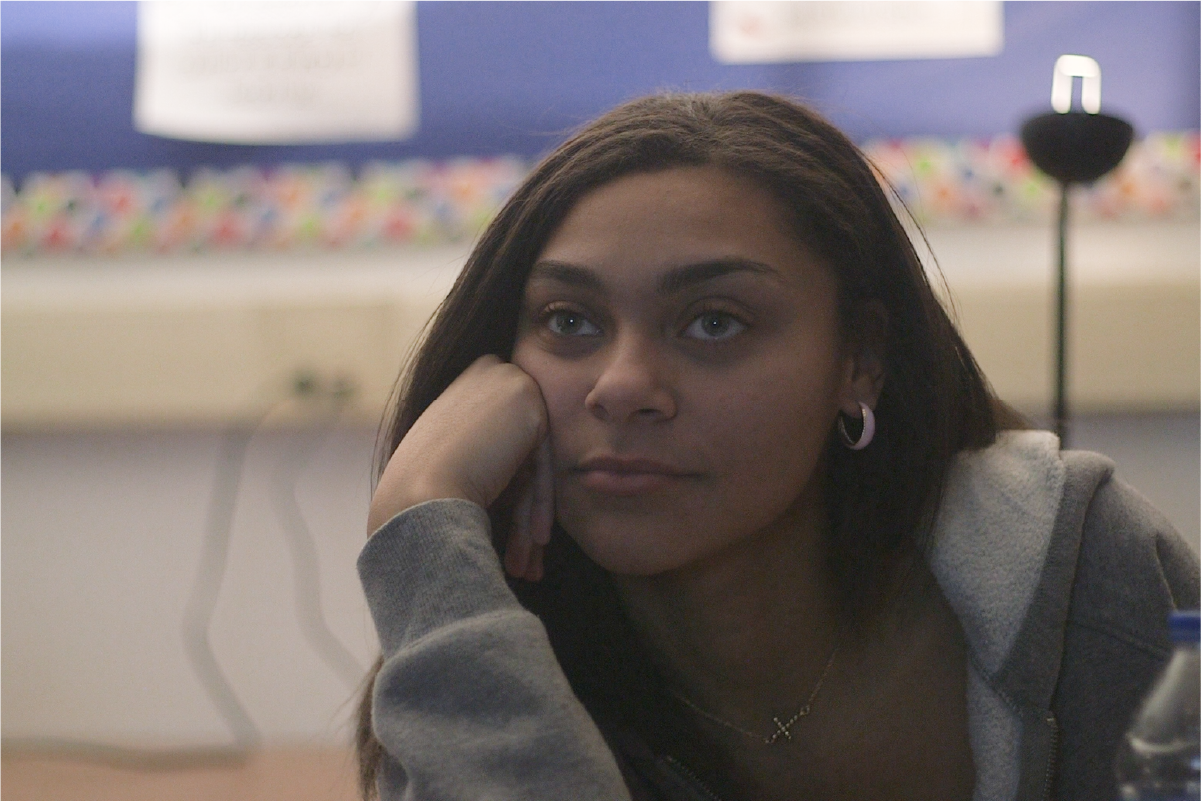
This post is the next in our series, Supporting Teen Mental Health, which shares tools and insights that support educators, parents, and youth-serving adults in showing up for teens in this moment of need. Read earlier posts in the series about mindfully managing difficult emotions and using social media actively and intentionally.
"My understanding of myself changed a great deal."
"I learned how to be a better friend."
"I was able to deal with aspects of myself that I never really had before."
"It's nice to know that you're not alone in seeing yourself a certain way."
Each of these quotes shared by teens is a testament to what happens when schools provide them with meaningful opportunities to actively explore who they are and who they want to be in the world and to build the social and emotional skills that support their mental health and development.
Adolescence is the last major window of neuroplasticity, a time when the teen brain is open to incredible learning potential, on one hand, and heightened vulnerability, on the other. Half of all serious mental health disorders in adults begin by age 14, making early prevention and intervention critical. High quality social and emotional learning interventions have been linked to reduced symptoms of anxiety and depression and lower levels of emotional distress among young people. But even teens who are not experiencing mental health struggles have specific developmental needs when it comes to maintaining and improving mental health. These include having opportunities to figure out who they are, to experience autonomy and independence, and to refine their relationship skills as interactions with both peers and adults in their lives become deeper and more complex. Each of these skills, and many more, are the aim and outcome of quality school-based social and emotional learning efforts.
The U.S. Surgeon General's Advisory on Protecting Youth Mental Health notes the role school communities can play in helping young people find "a sense of purpose, fulfillment, and belonging," supporting them in "managing their mental health challenges." Accordingly, they recommend that educators, school staff, and school districts continue to "expand social and emotional learning programs and other evidence-based approaches that promote healthy development." Mental health supports fall on a continuum of care, and high quality social and emotional learning programs are a "Tier 1" intervention, meaning they provide fundamental coping skills all students in a school community need, even as some students will require more intensive and targeted types of mental health support.
The Advisory mentions that creating the foundation for "a healthier, more resilient, and more fulfilled nation" where young people can thrive begins with creating "accessible space in our homes, schools, workplaces, and communities." To us, "access" means meeting teens where they are developmentally with tools they are familiar with and inviting them to the table when those tools are being developed to share how and what they want to learn. At iThrive, we specialize in creating social and emotional learning experiences that enlist the power of play and respond to teens' unique developmental needs. By design, we prioritize teen voice, personal relevance, and student choice in what we create with and for young people. The genius, creativity, and insight of the teens we work with continues to steer our game and curriculum development work, resulting in memorable and meaningful learning experiences that engage them deeply.
For educators and administrators looking to prioritize their students' mental health, social and emotional learning opportunities and the core skill-building they foster can be a powerful and transformative lever.
HERE ARE THREE WAYS TO ENHANCE YOUR SCHOOL OR DISTRICT COMMUNITY'S COMMITMENT TO SOCIAL AND EMOTIONAL SKILL DEVELOPMENT IN TEENS:
1. CALL SOCIAL AND EMOTIONAL SKILLS WHAT THEY ARE: ESSENTIAL SKILLS.
We've written about it before, and it bears repeating. How we talk about something impacts how it is received and regarded. In a world where polarization and hatred threaten our unity, we can't afford to downgrade competencies like self-awareness, self-regulation, showing empathy and care, effectively advocating for ourselves and others, and making responsible decisions for the greater good to "soft skills." Raising the profile of these core skills to an educational and humanistic priority sets the scene for innovative programming and instruction that responds to and addresses students' needs. To quote a member of our Educator Advisory Council, "Education is not an academic pursuit, it's a relational one. They listen to me because of the relationship, not because I'm the teacher." Meeting social and emotional needs is, simply put, the foundation for effective learning.
2. FIND TOOLS THAT EMBED SOCIAL AND EMOTIONAL LEARNING INTO CORE ACADEMIC CONTENT.
Social and emotional learning efforts are powerful when evidence-based tools are embedded into the content students are already learning, and there's often a natural alignment. Our iThrive Sim role-playing simulation games designed for high school social studies classes, for example, build on the natural synergy between civics education and social and emotional competencies. As students collaborate to make decisions that drive each iThrive Sim scenario forward, they expand their civic knowledge while practicing core social and emotional skills like managing stress, regulating emotions, and making responsible decisions. Likewise, iThrive Curriculum's learning units pair with immersive games to support high school English and humanities educators in discussing self- and social awareness, self-management, and relationship skills with their students. As students work through these curricular units together, the narrative at the center of the game becomes an organic springboard for meaningful reflection and conversations about identity, relationships, and communication.
3. ADOPT AN EQUITY LENS.
Emotions and social connections drive learning. In that sense, social and emotional learning is ultimately about ensuring students' preparedness and ability to learn; all students deserve that fair chance. Implementing high-quality and evidence-based social and emotional learning experiences is a key step toward equity in your school or district community. Taking it a step further, social and emotional learning experiences themselves should be designed with equity and access in mind. iThrive's tools are designed to be representative of and accessible to diverse learners in line with our commitment to equity and universal design for learning principles. Gabbrielle Rappolt-Schlichtmann, an internationally recognized expert in learning science and accessible learning, calls our offerings, "the most innovative, integrated social and emotional learning work I've seen in the high school space."
Social and emotional learning opportunities tend to teens' whole selves. They help young people look inward and deepen their ability to know themselves, name their needs, regulate their feelings and behaviors, and embrace others with empathy and curiosity. Committing to these three practices to support social and emotional learning efforts will meaningfully move school communities toward helping students develop core skills and competencies that support their mental health and emotional resilience, setting them up for thriving far beyond school walls.
iThrive’s 2021 Annual Report Celebrates Teen Genius, Community, and Play

Connection brings healing the same way co-creation brings innovation—through intention.
In 2021, we intentionally leaned into both, connecting with teens, educators, game developers, university partners, museums, and youth-serving organizations across the globe to co-design meaningful learning experiences that enlist the power of play to support teen thriving.
True to our mission and vision, we actively sought partners who want to engage young people in their genius and support them in developing the social and emotional skills to be in the world they will one day inherit with both empathy and curiosity. Bridging our partners' subject matter expertise with our co-design approach ensured that teen voice remained at the center of every tool, experience, and resource that sought to engage them. Our 2021 Annual Report, Building Community In Service of Teen Thriving, highlights all that we co-created, refined, and shared last year. Here are a some of the report's highlights:
- Our commitment to knowledge-building and knowledge-sharing brought us to conferences where we connected, learned from, and shared with game designers, researchers, educators, administrators, policymakers, and other intersectional experts across the globe.
- iThrive Sim, our award-winning ed tech tool that hosts immersive civic learning experiences, expanded with two new role-playing simulation scenarios: Leading Through Crisis and Follow the Facts, both of which were created with guidance and input from students, teachers, and subject matter experts.
- In May, we launched iThrive Curriculum's third game-based learning unit, A Moment in Time, an eight-lesson social and emotional learning experience that pairs with the mobile game Florence and supports teens in reflecting on relationships, grief, loss, and life shifts.
- Working in partnership with iThrive, youth designers at the SEED Institute created and launched The Run Around, a board game that mirrors their lived experiences in the juvenile justice system, authentically communicates its harm, and advocates for structural supports capable of disrupting it. Since launching, The Run Around has garnered press in The Boston Globe and won gold at Serious Games' 2021 Serious Play Awards.
- Working with High Resolves Group and Rise, an initiative of Schmidt Futures, we have been working on curating transformative educational experiences and making them widely available through Symphony, a new online tool that supports student-centered and self-directed learning.
An all-of-us approach is needed in supporting youth as they navigate the complex challenges of this time. A special thank you to every teen, educator, and collaborator who connected with us in 2021 and joined us in our commitment to creating learning environments and shared spaces that ignite and value the potential of young people.
Teen Mental Health: Use This 2-Min. Exercise When Difficult Emotions Surface
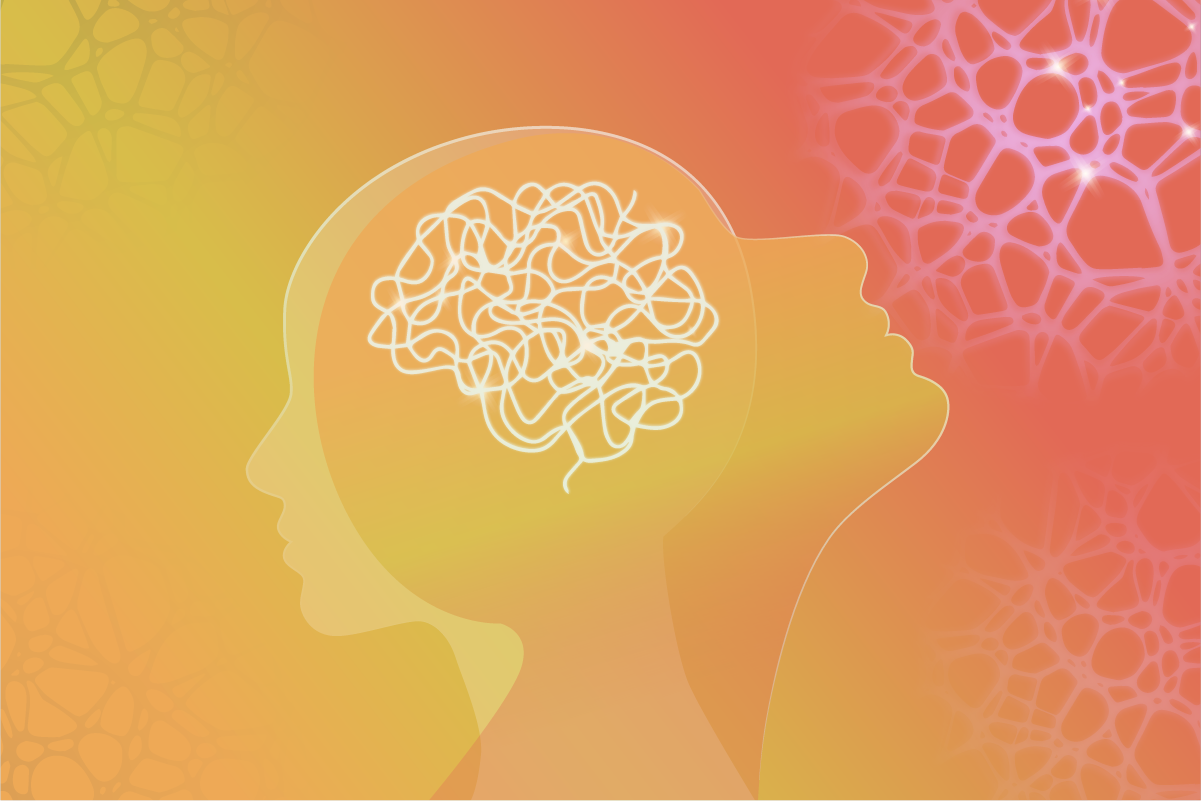
Unprecedented times come with unprecedented challenges, and the ones that today's young people face are tough to navigate. The data shared in the U.S. Surgeon General's Advisory on Protecting Youth Mental Health confirms this. National surveys show that one in three high school students experiences persistent sadness or hopelessness. The world-shifting consequences of an ongoing pandemic coupled with the big emotions that accompany adolescence make our collective need to support teen mental health and well-being both urgent and necessary.
INTRODUCING THE SUPPORTING TEEN MENTAL HEALTH SERIES
The prevalence of mental health challenges amongst youth requires an all-of-society effort to facilitate the individual and structural changes needed to support and protect teen thriving. Over the next few months, we'll be sharing vetted tools and actionable insights as part of a new five-post blog post series titled, Supporting Teen Mental Health. Mapping back to the U.S. Surgeon General's recommendations, each post will feature helpful tips and resources designed to support all youth-serving adults in showing up for teens in this moment of need.
To kick off the Supporting Teen Mental Health series, here's a quick and effective exercise that can be used and shared with teens (and adults!) to support them in getting grounded when big emotions surface.
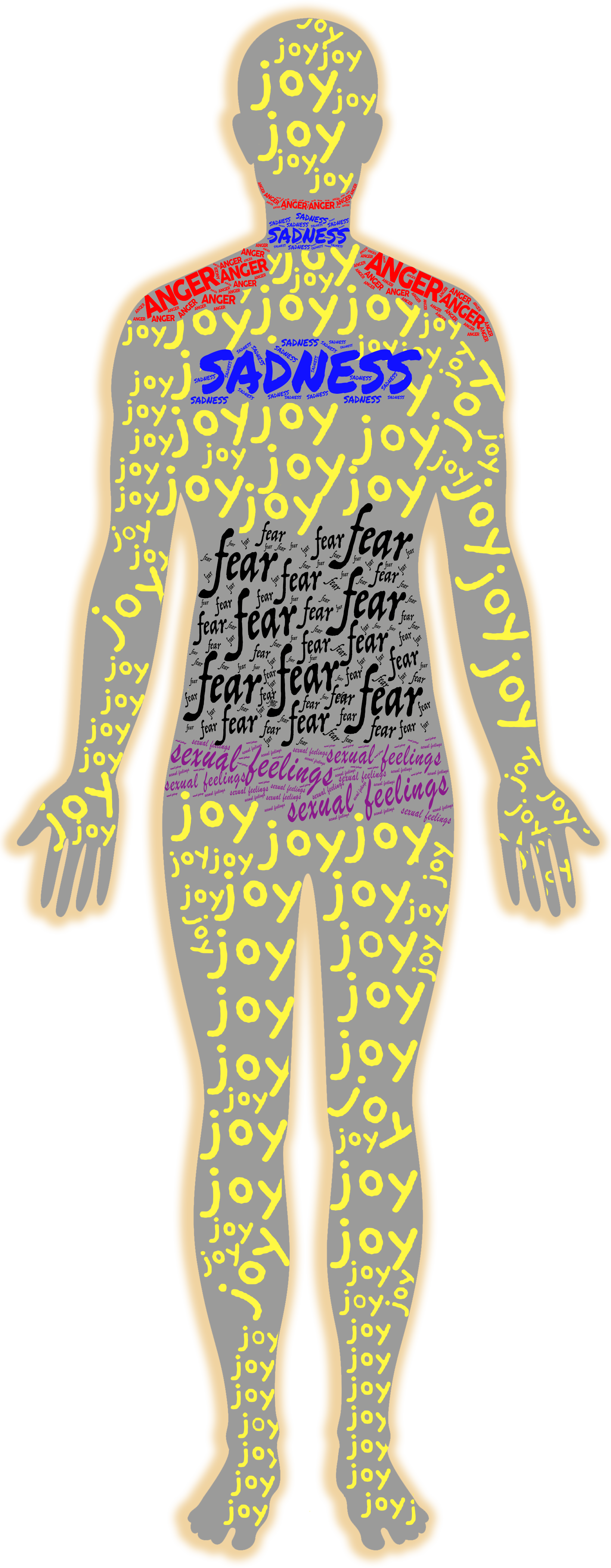 PAUSE-BREATHE-NAME: A 2-MINUTE GROUNDING EXERCISE
PAUSE-BREATHE-NAME: A 2-MINUTE GROUNDING EXERCISE
Whether you're a teen or an adult, chances are you've had moments, shifts, and shocks in life that have brought up strong emotions. In those moments, it can be difficult to regulate those feelings. Pause-Breathe-Name is a quick exercise that can help us manage:
Pause: Start by noticing that a strong feeling has shown up for you and allowing yourself to take a pause before your next word or action.
Breathe: Next, take a couple of breaths. Allow your exhale to be longer than your inhale. This will help to calm your nervous system. As you breathe, try to notice where the strong feeling is showing up in your body. We often feel sadness in our throat, fear in our belly, and anger in our upper back, neck, and jaw. Joy tends to show up all over.
Name: Finally, work on naming the feeling in your head or out loud before returning to what you were doing. The act of naming emotions, especially the more unpleasant ones, actually helps lessen the intensity of those feelings.
This exercise is part of the many social and emotional learning activities in our iThrive Sim role-playing simulation experiences. Students have shared that this exercise has helped them acknowledge moments of discomfort, frustration, and uneasiness they felt while playing as their character, and prepared them to unpack those moments with their classmates. These skills are needed when we have difficult conversations, and practicing these skills helps to strengthen them.
You can use the Pause-Breathe-Name exercise to ground yourself in times of stress and to name the feelings showing up in your body in those moments. What are some other exercises and practices you turn to to get grounded in times of stress? Share with us at contact@ithrivegames.org and stay updated on the latest in the Supporting Teen Mental Health blog series by joining our mailing list today.
Vol. 3 of Journal of Games, Self, & Society Examines How Games Transform Us

BOSTON—January 6, 2022. The global COVID-19 pandemic marked a time of unprecedented social isolation. With it came an uncovering of new ways of doing and being, ones that met our social and emotional need for safe but hearty connection. Amid stay-at-home orders, games played an integral role in cultivating spaces for people to gather, connect, learn, collaborate, and wander. The newest volume of the Journal of Games, Self, & Society examines the ways play supports this level of connection in young people at a crucial time, highlighting the ways games accompany and ignite transformation in how we understand ourselves, others, and society.
Produced by iThrive Games Foundation, published through ETC Press, and guest-edited by Claudia-Santi F. Fernandes and Grace Collins, Volume 3 of the Journal for Games, Self, & Society features novel insights into gaming behaviors that emerged during the pandemic. Finja Walsdorff, Claudius Clüver, and Max Kanderske share a fascinating analysis of how 'tend-and-befriend' games like Animal Crossing: New Horizons, a game that soared in popularity in 2020, respond to human needs and behaviors in times of uncertainty and crisis.
Vol. 3 of the Journal also features a valuable case study for designers looking to create games that highlight systems of harm and erasure, and invoke an empathy capable of disrupting it. In an in-depth retrospective on the design choices made while creating Resilience—a game that centers the stories and plight of refugees, Drexel University's Lily Lauben, Justin Roszko, Alex Gallegos, and Zach Perry share how they cultivated an understanding of refugees' lived experiences that are not their own to create a transformative gameplay experience.
In addition to these two articles, Volume 3 of the Journal of Games, Self, & Society features two book excerpts from some of the most recent scholarship on game-based learning. In an excerpt from Gaming SEL: Games as Transformational to Social and Emotional Learning, Matthew Farber Ed.D discusses the emotions evoked by play, and how educators can leverage them to support growth and connection. The introductory excerpt of Karen Schrier Ed.D's We the Gamers: How Games Teach Ethics and Civics included in this volume of the Journal explores how games supported humanity and connection amid social distancing, and how they encourage teen civic engagement and responsible decision-making.
The Journal ends with an announcement of the Games + Learning + Society (GLS) Conference's return in 2022 and a call for proposals from all who are interested in games and their contribution to cognitive/behavioral change, social movements, sustainability, and joy.
The Journal's editor-in-chief, Susan Rivers, Ph.D., who is also the Executive Director and Chief Scientist at iThrive Games Foundation, says that she hopes the insights featured in this volume support the creation of compelling games and game-based learning experiences for teens that recruit emotions to supercharge learning.
"This volume of the Journal of Games, Self, & Society emerged during the COVID pandemic," she shares. "The scholarship and writing included reflects novel games and design approaches that reflect this moment and inspire new ways for connection, learning, and transformation."
About the Journal
The Journal of Games, Self, & Society (JGSS) is a peer-reviewed journal created and edited by iThrive Games Foundation and published by ETC Press. The journal highlights work focused on how games, game design, and gameplay contribute to a deeper understanding of learning, health, and humanity. It was created to foster interdisciplinary research, conversation, and community around game studies and games-related scholarship. Scholars from all disciplines are encouraged to participate.
About iThrive Games
iThrive Games Foundation prepares teens to thrive by meeting them where they are and working in partnership towards a world where all have the voice, choice, and agency to reach their full potential. We use games and game design to equip teens with the social and emotional skills they need to be healthy and resilient, tools to support and protect their mental health and well-being, systems thinking they need to recognize inequity, and meaningful opportunities to imagine and design a better world.
Media Contact
Eghosa Asemota
Manager of Marketing, iThrive Games Foundation
eghosa.asemota[at]ithrivegames.org
2021 Was a Year of Co-Creation, Collaborative Learning, and Play
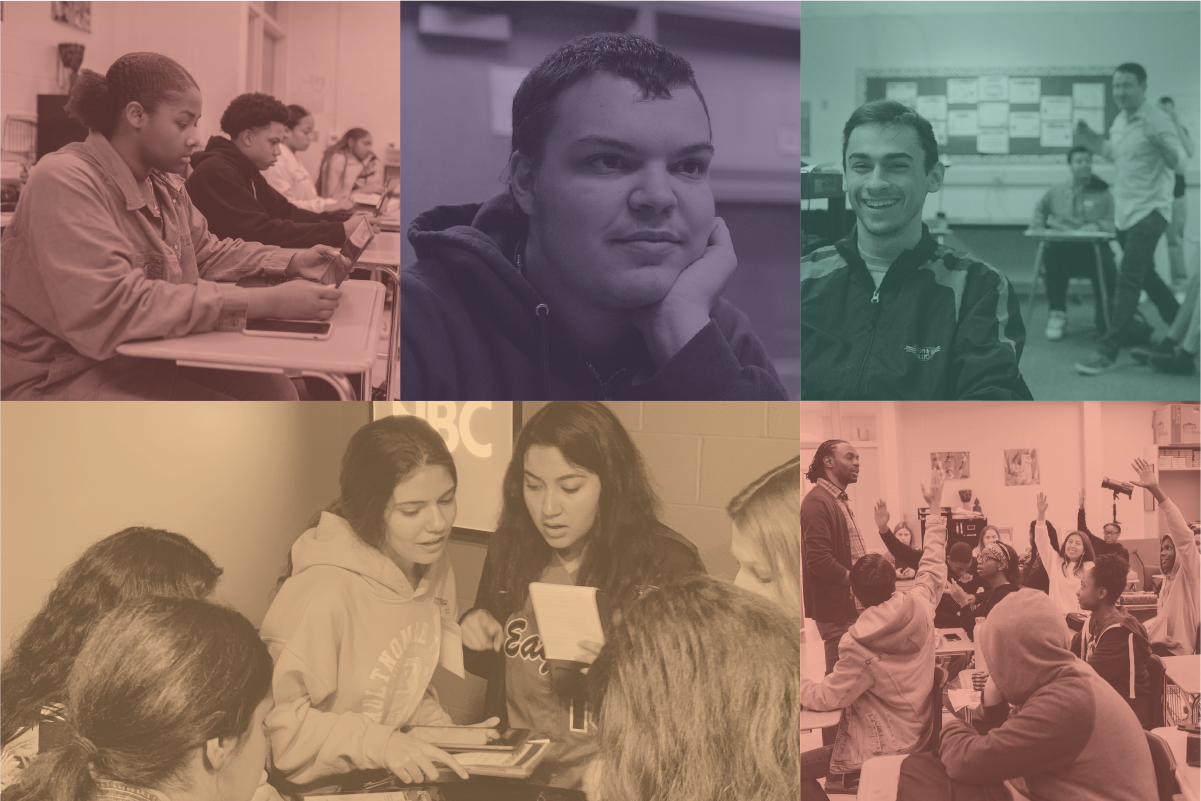
Whenever we are in connection, we learn about ourselves and each other. We entered 2021 with this belief in mind, seeking community with teens and educators to fully understand their challenges, desires, and needs in the classroom and beyond. From our commitment to knowledge-building came co-creation, and the development of new meaningful and collaborative learning experiences that resonate with young people, support their social and emotional development, and meet them where they are through play.
We were happy to release iThrive Curriculum: A Moment in Time, grow iThrive Sim's library with two new scenarios, Follow the Facts and Leading Through Crisis, and launch the Game Design Studio Toolkit after five years of collaboration. After equity reviews of Sam's Journey and Museum of Me, we updated both game-based learning units to include more means of engagement, representation, and action/expression and ensure all learners feel valued, seen, and supported in their genius. At the SEED Institute, we pressed forward in our partnership with Transition HOPE and engaged youth with lived experiences in the cradle-to-prison pipeline via game design, which led to the launch of The RunAround, a board game that highlights the hardships that lie in the journey from 'Maximum Security' to 'Home,' and opportunities to disrupt and dismantle them.
This year, we worked to provide teens with transformative opportunities to see possibilities they never before imagined, open up their thinking about themselves, each other, and the world, and build essential social and emotional skills that support them in stepping fully into their genius. Whether you downloaded an iThrive Curriculum unit, brought an iThrive Sim role-playing simulation scenario to your classroom, or read an article we shared, we appreciate you for the many ways you engaged with us this year. Below is a snapshot of the top five blog posts our readers viewed the most this year:
1. Teens Have Big Emotions. How Can We Help HS Students Navigate Them?: A rapidly developing brain in an increasingly complex world makes for big emotions. How can we help teens cope with them? HS educator and co-author of our game-based learning unit iThrive Curriculum: A Moment in Time Lauren Geschel shares: "recognize them as individuals," "validate their feelings," and "help them be self-aware and deliberate."
2. High School Teachers, Share Your Feedback on the New, Improved iThrive Sim: Read about iThrive Sim's teacher-friendly interface, a feature recently added to the award-winning tool to support high school educators in customizing, facilitating, and steering iThrive Sim's role-playing simulation scenarios in a way that best meets their students' social, and emotional needs.
3. Game-Based Learning Reads: Three Books That Will Make You a GBL Believer: With game-based learning, teachers use play to engage their students in their own learning, embracing student agency over student compliance. Read what seasoned educators and game-based learning experts Matthew Farber, Kat Schrier, and David Seelow say about it in this aggregate book review of their latest reads.
4. Burgeoning Journalists Try on Their Roles in New Media Literacy Game: In this digital age, more data is produced in a second than can be consumed in a lifetime. Our new role-playing simulation game iThrive Sim: Follow the Facts centers media literacy and nurtures players' ability to analyze, evaluate, and report on that data. Read what playing it did for two dozen high school students and burgeoning journalists at the Arizona State University's Summer Journalism Institute.
5. Use this SEL Activity to Help Your Students Process Pandemic Grief and Loss: For teens, grief and loss have been palpable both personally and collectively over the last two years. This social-emotional learning activity invites your students to unpack and process their experiences of these emotions during the pandemic.
As the year winds down, we hope you continue prioritizing connection and wellness throughout the holiday season. Stay connected with us next year by signing up for our monthly newsletter, stocked with updates on our game-based learning products along with exclusive opportunities to try them with your students. Here's to more community, co-creation, and play in 2022.
iThrive Sim Helps Homeschoolers Connect And Collaborate With Play
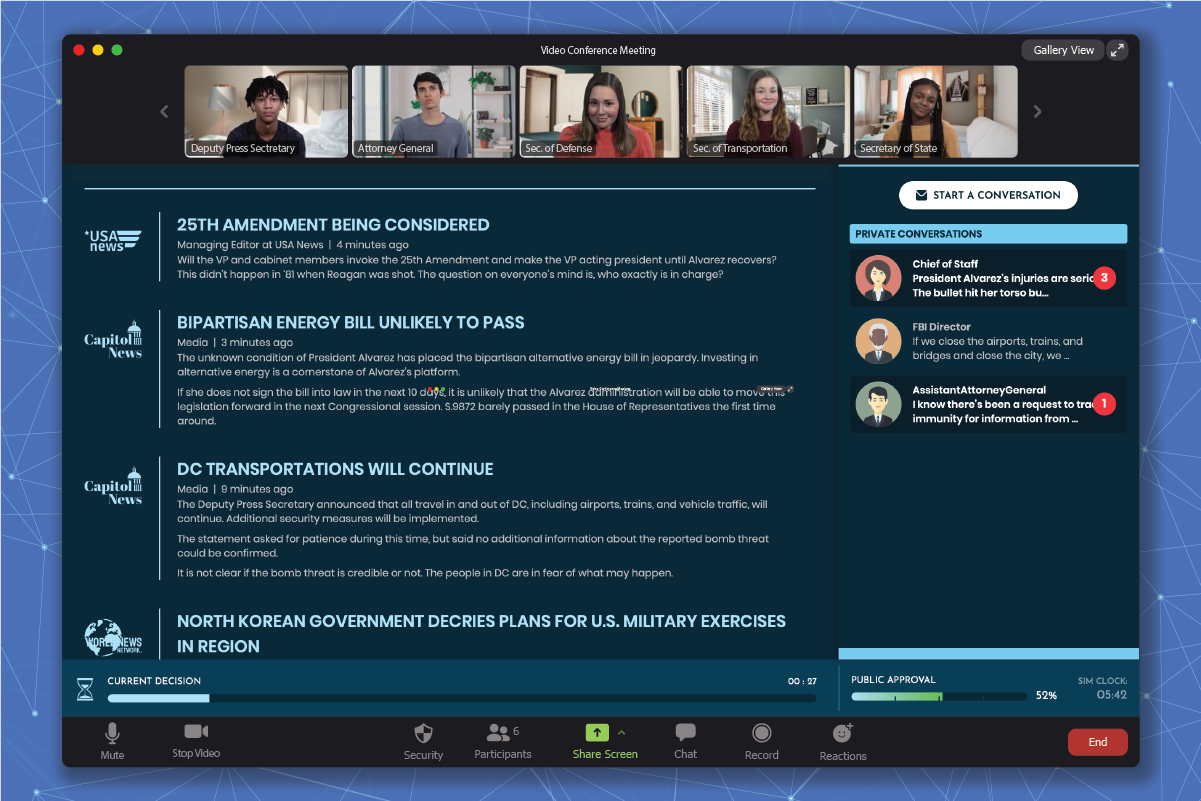
iThrive Sim's first role-playing scenario launched in late 2020, a year that inspired us to elevate and prioritize human connection, and prompted new ways of fostering it. At the time, we heard educators voice a desire for resources that not only met the logistical needs of remote learning but also tended to the social and emotional needs of their students navigating a world of great uncertainty. Responding to this, we developed iThrive Sim: Lives in Balance in partnership with teens, teachers, and the makers of the Situation Room Experience, creating an immersive experience that supported new ways of connecting and engaging with others in learning spaces and beyond. Since launching, over 3,000 people have played an iThrive Sim scenario, activating and nurturing their social and emotional skills in a one-of-a-kind collaborative gaming experience awarded for its innovation and responsiveness.
Educators who've brought iThrive Sim to their in-person or virtual classrooms know firsthand how these civic learning experiences uniquely support engagement, connection, and social and emotional learning through play. Michael Hilbert, co-director of Cupola Academy, a nonprofit that offers weekly collaborative programs for homeschooled students, brought iThrive Sim to two cohorts of teens earlier this year. In the interview that follows, Michael shares how the tool aligns with Cupola Academy's belief in the value of collaboration and curiosity, and supports the learners they serve in embodying and exercising it.
Q: What was your experience using iThrive Sim with your homeschooled students?
My group played Lives in Balance and Leading Through Crisis. My students were very interested in Leading Through Crisis because when we played the simulation, states were actively discussing [the applicability of the 25th Amendment]. The simulation was unfolding in front of them in the news every day, and they enjoyed being able to play out a very contemporary issue. They enjoyed Lives in Balance because of the application of the Constitution to everyday life—it helped to drive home the point that the Constitution is a living document.
Q: How easy was it to use iThrive Sim? What resources did you find particularly useful?
As a group facilitator, I really appreciated the support materials that are available to students, such as the text of the amendments addressed in the simulations. [iThrive Sim] was very easy to use and supported student play though they were not all in the same physical location. The interface is very intuitive for young people, so the amount of tech support needed was very minimal—this makes implementation with homeschoolers very easy.
Q: One throughline in the feedback we get from educators who've used iThrive Sim is the joy that comes from witnessing their students work collaboratively to address the crises in each scenario. From what you observed, how did the experience support connection?
I believe that iThrive Sim is a component of what we strive to achieve in all our programming — creating community and connection. The simulation provides a shared experience that nurtures the group's sense of community. I think that participating in the simulation helped them feel more connected because it creates situations where young people are given responsibility for a role, asked to participate in a fun and engaging way, and end up sharing values and beliefs with others (which is how you build relationships).
Q: Overall, how did the iThrive Sim experience support your engagement approach with homeschoolers? How did it respond to your student(s) learning style(s)?
I believe that the online simulation was an excellent tool for interactive learners. The iThrive Sim platform allowed me to have the freedom to be present in the simulation, take notes on the decision-making process, and have content questions that lead to richer reflection and a complete learning experience.
Q: At iThrive, we like to say that civics is social and emotional, meaning that showing up for ourselves, our communities, and in the world requires social and emotional skills that support us in doing so with care, tact, and empathy. Were there any instances that you observed while your students were playing that attests to this? What do you hope your students take away from their gameplay experience?
Going through the simulations emphasized the difficulty in adhering to a respectful, empathetic process when under challenging time frames to make decisions. My students noted in both situations that they frequently ran out of time to make challenging decisions while having everyone's opinion fully heard, a very frequent situation with governing bodies. One of the opportunities for my groups was initiating a process-conscious approach for decision-making before they entered the next scenario. The reflection element of these exercises is so vital for the social and emotional growth of young people.
Sign up for our mailing list for exclusive opportunities to play and test new iThrive Sim role-playing scenarios. Learn more about iThrive Sim here.
Let’s Start Calling Social & Emotional Skills What They Are—Essential Skills
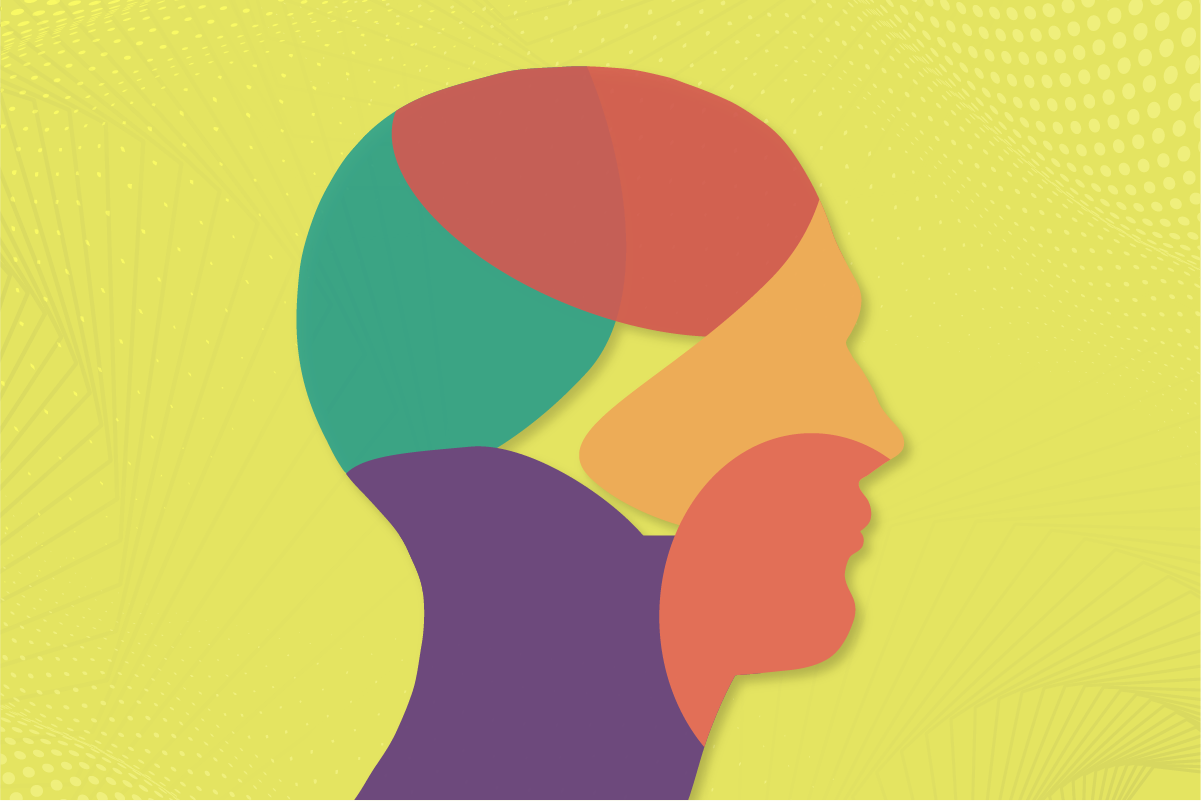
Before you read this article, take a look at your news feed.
You are more than likely to encounter an event or sentiment that attests to the increasingly polarizing and often unsettling world we live in and navigate. A recent survey published by USA Today shows that roughly half of Americans (48%) predict more destructive disagreements over the next ten years, but 93% say it's vital to reduce the country's current divides. How can we move toward realizing this unity amidst enduring divisiveness? We must build social and emotional skills. Social and emotional skills help us get better at togetherness. They are not 'soft'; they are essential, and nurturing them supports us in moving toward the more harmonious, just, and loving future we crave.
The Organisation for Economic Co-operation and Development (OECD) refers to social and emotional skills as "weapons against the greatest threats of our time: ignorance - the closed mind; hate - the closed heart; and fear - the enemy of agency." Social and emotional skills support us in taking an honest look at ourselves, really seeing each other, working together to find solutions to the complex challenges we face, and then persevering in enacting those solutions. Within education, thoughtful and equitable attention to social and emotional skills demonstrates a real commitment to equity more broadly; we can't expect equal outcomes unless we ensure all students are equally ready to learn in the first place. Social and emotional skills are undoubtedly critical to this readiness.
For this generation of teens especially, social and emotional skills are not just important; they are necessary. Social and emotional learning is the process of building and practicing social and emotional skills in schools. At iThrive, we embed this process in the game-based tools we create for and with teens, and use the connective and reflection-prompting power of play to build their social and emotional skills. Our iThrive Curriculum units, Museum of Me, Sam's Journey, and A Moment in Time, pair standard-aligned lesson plans with immersive video games to create learning experiences relevant to teens in high school English classes. These game-based learning experiences use digital media to encourage them to explore their identity, their emotional landscape, and how they navigate social relationships. Our civics-centered iThrive Sim games, Lives in Balance, Leading Through Crisis, and Follow the Facts, engage teens not just by supporting their understanding of the mechanics of government but of themselves, their identities, values, and communities. Each of these online simulations presents an opportunity to try on new perspectives, embody constructive decision-making techniques through role-play, and reflect deeply on how decision-making affects others.
These offerings for high school classrooms and youth-centered spaces were designed to encourage teens to develop the social and emotional resources that enable them to think for themselves and join others, with both empathy and curiosity, in learning, building, and imagining a better world. They also support teens and the adults they share space with in understanding that social and emotional skills are relevant to all subjects and aspects of life. The language we use to describe and advocate for social and emotional learning should reflect its standing as an essential part of the future we're all striving to attain—one that empowers us to live, work and thrive collaboratively, resiliently, and productively. Raising SEL's profile from that of a 'soft skill' to an educational and humanistic priority helps get us there.
What Teaching Hard History Does for Teens’ Social and Emotional Learning
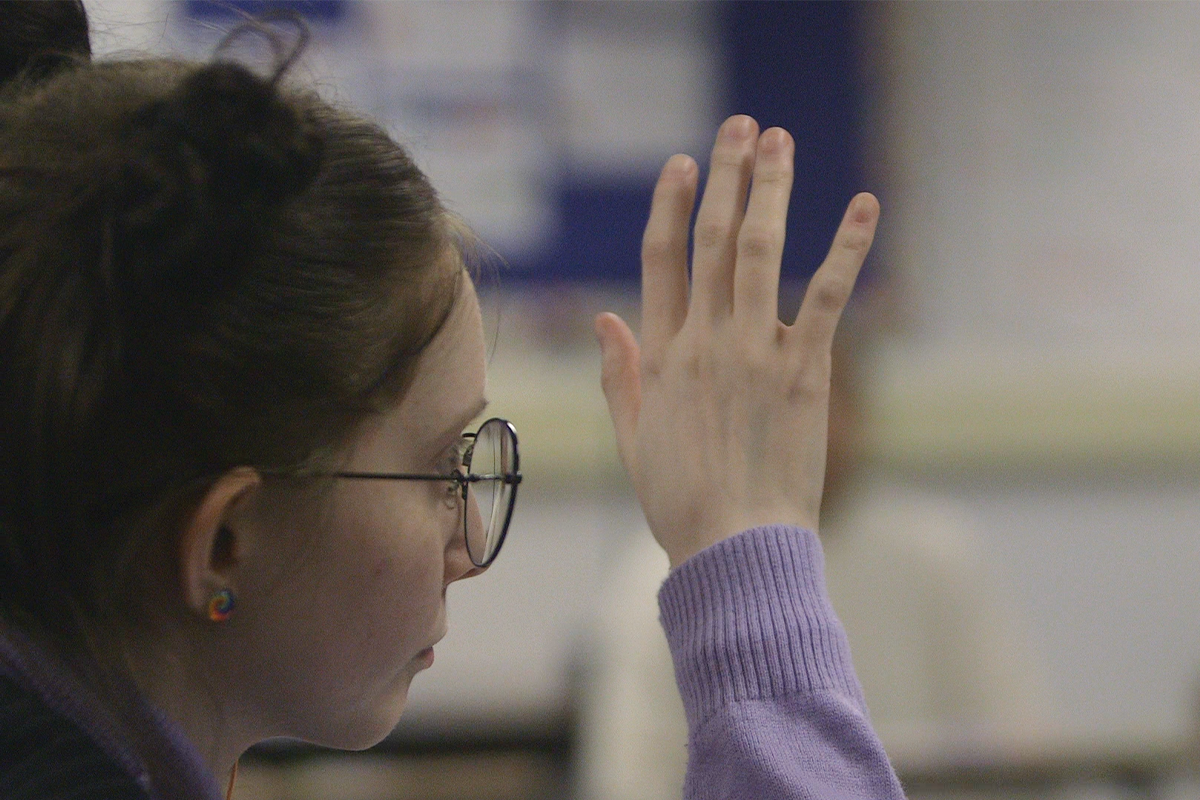
Teaching hard history helps students understand the implications of our past and their connections to our present. With this understanding, students are better positioned to confront future challenges and are primed to embody the social and emotional competencies that support them in being engaged, informed, and responsible members of society.
At iThrive, we're committed to creating civic learning contexts that equip teens with the curiosity, practical experience, and social and emotional learning skills to handle and navigate the complex world we live in. Our iThrive Sim online role-playing simulation games, for example, invite high school students to step into the role of government officials tasked with making high-stake decisions that impact the public in profound ways. As students collaborate to analyze data and sources and chart a path forward in each of iThrive Sim's content-rich scenarios, they practice how to navigate sensitive themes and challenging issues in a healthy, curious, and thoughtful way.
On Wednesday, November 17 at 6 pm EST, we're excited to join forces with Facing History and Ourselves and Generation Citizen at Composer's "Teaching Tough History Through Civics & Social Emotional Learning" webinar to discuss strategies that support the integration of civic and social-emotional learning into history lessons that address tough themes and topics.
Register to join Composer's "Teaching Tough History Through Civics & Social Emotional Learning" webinar here.
There, our Senior Director of Learning, Michelle Bertoli, will highlight some of the social and emotional skill-building opportunities we've embedded in all of iThrive Sim's role-playing scenarios. Attendees will also learn from Dr. Shawn Clybor, who'll share how Composer, an award-winning curriculum design tool, helps teachers like him create dynamic learning experiences that prepare students for transformative civic engagement and meaningful civic action.
When teens who've played an iThrive Sim scenario share that the experience prepares them for "real-life situations and issues" or prompts them to reflect on what "we're all collectively facing, and why and how we should do a certain task," we're reminded of how teaching hard history supports them in showing up for themselves, their communities, and the world.
At the individual level, teaching hard history topics enables them to see themselves as part of the larger historical narrative of our communities, country, and society. This supports students in building the self-awareness to challenge their assumptions, define their values, and figure out where things they love and are skilled at overlap with a need in the world. At the community level, teens build social awareness and relationship skills that support them in developing the competence to try on others' perspectives while expressing and refining their own. In learning about heavy historical topics and events, students also develop an informed worldview along with an understanding of systems of harm and injustice. This understanding equips them with the knowledge and motivation to advocate for a more just society and make responsible decisions for themselves and the collective.
Teaching hard history can be challenging and may raise complex emotions for learners and educators alike, but when integrated with social and emotional learning, it becomes a powerful experience for students to reflect deeply about the world around them and the world they wish to live in. We're excited to dive into this topic further at the "Teaching Tough History Through Civics & Social Emotional Learning" webinar with educators across the globe. We hope to see you there!
Composer is the first digital platform to offer a comprehensive collection of resources for activating a deeper sense of civic responsibility in students. As a one-stop marketplace, Composer enables educators to access a whole ecosystem of content providers in one place. They can search for and find resources that span civics, social justice, social and emotional learning, and global competence. Composer features over 1,000 high quality learning experiences from over 35 organizations, and provides research-based tools and guidance to support educators with curriculum planning. Serving educators working with grades 6-12 in both schools and non-traditional learning environments (afterschool programs, summer camps and/or home school), Composer is free to access for educators around the world.
New Game Design Toolkit Supports Teens in Leading Systems Change
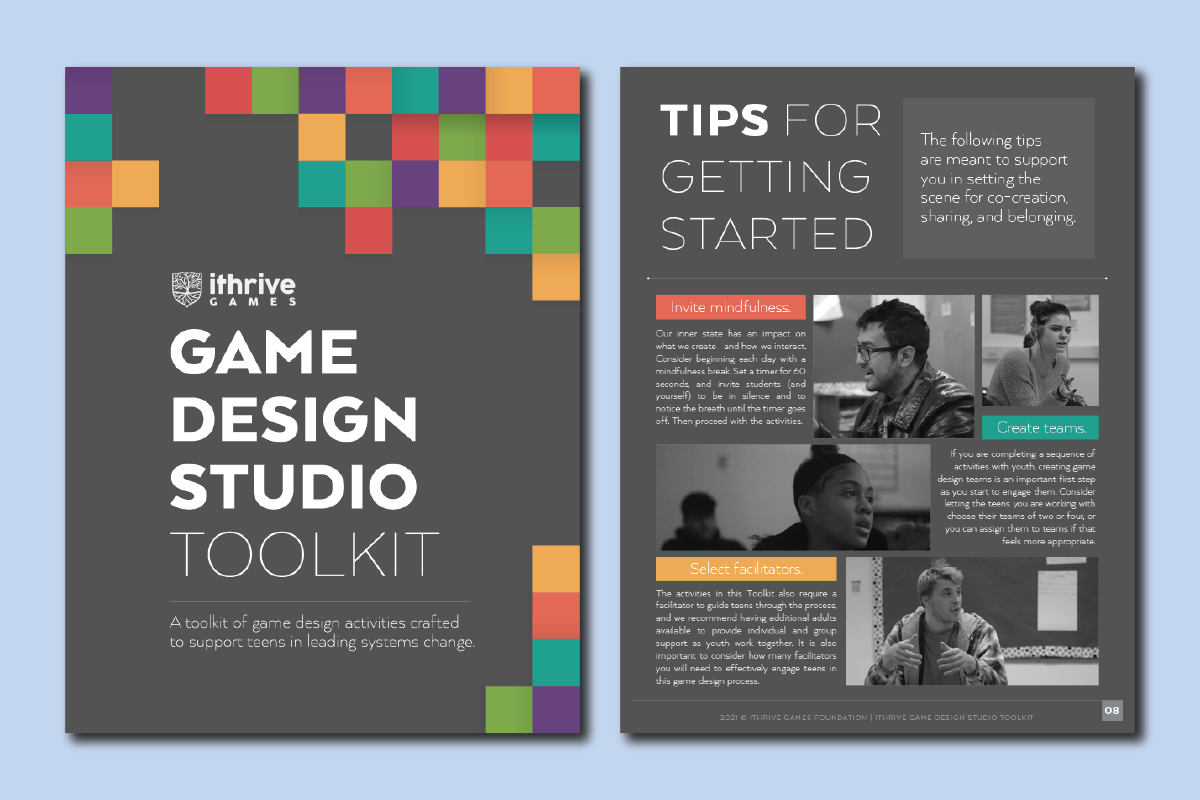
Games are microcosms of the real world, making play and game design springboards for possibility.
At iThrive, we use games to support teens in discovering new ways of doing and being. Our approach centers on their developmental needs, wielding the power of play and emotions to deepen their civic and social and emotional learning. At the core of each tool or experience we've created for and with young people is an unwavering belief in their genius and creative potential to build and imagine a better world. The Game Design Studio Toolkit, created in collaboration with EdTogether and made possible by the generous support from the DN Batten Foundation and the William T. Grant Foundation, assists them in uncovering this within themselves, using game design to reflect, connect, ideate, and lead systems change.
The Game Design Studio Toolkit features 50+ activity guides and accompanying worksheets that merge design thinking, social justice, and social and emotional learning to support teens in exploring societal issues that they experience while thinking collaboratively and creatively about how to respond to them. As teens work through these activities together and create their own games, they engage in individual and collective reflection and action as they challenge their assumptions, redefine problems, and imagine new solutions.
"These field tested activities invite teens to consider their own expertise from their lived experience as they work to understand the systems that surround them," shares Susan E. Rivers, Executive Director and Chief Scientist of iThrive Games. "The activities tap into and build skills like self-reflection and self-expression, empathy and compassion, collaboration and critical thinking as a means to unpack the rules and structures that shape relationships with parents, teachers, and other adults in the many systems teens encounter. Game design offers an amazing, engaging way to merge systems thinking, design thinking, and social and emotional learning."
An identity-safe environment is essential to help teens feel valued, accepted, seen, and welcomed. Tips and design principles found throughout the Toolkit help adult facilitators create this and set the scene for sharing and belonging—two parts integral to co-creation.
"We know that emotion is the driver in learning and in life. It is the thing on which we base our relationships and orientation to the world," says Gabrielle Schlichtmann, Executive Director and Chief Scientist of EdTogether. "With this in mind, we designed the activities in the Game Design Studio Toolkit to fully engage teens in playing games, analyzing games, and making games. The activities tap into and foster their social and emotional skills."
The social and emotional learning opportunities nested in each activity featured in the Game Design Studio Toolkit support the fostering of knowledge and attitudes across each of CASEL's five areas of social and emotional competence: self-awareness, social awareness, self-management, responsible decision-making, and relationship skills. Each activity prompts teens to nurture and exercise these essential skills in areas necessary for individual and collective well-being.
"As youth work together to design games and grapple with important issues, they are developing the necessary SEL skills to make change in their schools, communities, and beyond," shares Lora Henderson, a clinical psychologist, Assistant Professor at the James Madison University, and contributor to the Game Design Studio Toolkit. "We have grown accustomed to manualized social and emotional learning (SEL) programs that teachers implement in the classroom but game design offers a flexible and innovative approach that allows youth to use and further develop SEL skills while also engaging in activities that require both critical and systems thinking."
The Game Design Studio Toolkit invites young people to unpack complex social challenges and understand the human needs involved so they can imagine, create, and test games that prompt new solutions. Built across 5-years of inspiring collaboration with teens and adults across the US, we hope the Toolkit encourages and supports teens in creating the world they want to live in.
Download the complete Toolkit to bring it to the teens in your school, out-of-school program, museum, library, and summer camp today. And let us know how you are using it!
Creating ‘We’ and Restoring ‘Us’ with Civics and Social-Emotional Learning

Transformative civic engagement that truly benefits collective well-being begins and ends with our sense of community. Widening our definition of community requires empathy and connection. How do we create meaningful experiences for teens that support them in practicing this? And how do we support them in recognizing different perspectives, understanding them, and applying that understanding to pursue common goals?
Our answer to these questions lies in the immersive civic learning and social and emotional skill-building experiences we create with and for teens that enlist the connective power of play. iThrive Sim's online role-playing simulation games invite students to take on roles—such as government officials, state governors, or reporters—who must work strategically with their peers to analyze and respond to complex challenges. Collaboration, critical thinking, and connection drive each iThrive Sim game forward as teens practice regulating emotions, exercising curiosity, and making decisions that consider self, others, and the world, developing needful wisdom and practical experience in a safe space.
History, social studies, and humanities educators across the globe have used our game-based approach to civic learning to nurture the social and emotional learning competencies that support transformative civic engagement in their classrooms. In the interview below, one of our iThrive Sim users, Karalee Wong Nakatsuka, an 8th grade history teacher based in Arcadia, California, shares how vital belonging, representation, and community-building are in her approach to teaching history and how iThrive Sim helps support that approach.
Q: Tell me about your passion for civics education. What inspires you, and why do you believe civic learning is so valuable for students?
A: I believe it's very important for everyone to see themselves as part of the whole. When I was in school, I didn't see myself in history, so I wasn't as civically engaged because I didn't see myself as part of the whole. Later on, through mentors, great civics conversations, and learning history through someone who looks like me, I did start to see myself as part of the whole and where I fit into the larger picture. Every Friday, I attend History Matters with Joan Freeman, and it's really helped me to make the connections between the past, and the present, as well as to reflect on how our empathetic understanding of history helps to inform our thoughts and actions as citizens of this democracy. History and civics need to be examined empathetically because laws and rules affect people, government decisions affect people, and voting affects people. I want my students to be able to connect with the past and the present. Representation is important, both in history and in life, and I want my students to see both people who do look like them, and those who do not. I want them to know they have power, responsibility, and that they can make a difference in many small ways, not just when they are old enough to vote. Being an engaged member of society as an 8th grader can mean being nice to a 6th grader, or picking up a piece of trash. Civics needs to be tangible and inclusive, and can be as simple as someone who shows up.
Q: When teaching civics, what have you seen work really well with students?
A: I teach in a school district where Asian students make up about 70% of the population. Asian American history, often left out in history classrooms, really resonates with my students, for both Asian and non-Asian students. They need to see both people who look like them to connect and those who don't to understand diversity and inclusivity. I use a global lens in my teaching to help students understand that history is not just American history and decisions that we make in America don't just affect people in our country. History across the globe is intertwined, and decisions we make locally affect people all over the world.
Q: How has iThrive Sim supported your approach to civics education and your students' civic learning?
A: I used iThrive Sim this Spring and it invited students to learn about the government by participating in a challenging, engaging simulation, where they check public opinion, examine data, negotiate, and make informed decisions. It was great to have the opportunity to do iThrive Sim with all of my classes. There was one class where the group was quite engaged and one student in particular was really taking his job seriously, thinking about how to represent his constituents. That was a really powerful moment, and a great example of the impact of civic learning.
Q: How have you seen the impact of civics on students long-term or outside of the classroom?
A: My school is in Arcadia, a small city which is in Los Angeles County. A few years ago, there was a controversy when the city council voted to get rid of a basketball court. One council member said he didn't like "the type" of people the court was attracting. Many felt it was a racist argument and the fight to save the court reflected the city's desire to be an inclusive welcoming community for all. Many people, including myself and some of my students, went to the city council meeting where people of all ages and backgrounds spoke about the importance of the basketball court. One of my students got up to speak, basketball in hand, and in the end, the basketball court was saved. Not only was I very proud of my students, but it was a great learning experience and example of civic action.
Q: In your experience, how did civics education change during the pandemic and remote learning? Now that your school is back in person, are those changes still reflected, or are there other shifts that you are seeing?
A: Students are certainly happy to be back. They are more engaged, and community-building is so much easier in person. When we were remote, I would always keep the chat open during virtual learning to keep the communication going, help them build respect for each other, and ensure they felt heard. Given the circumstances, it worked well, but now we have in person weekly community circles where we do check-ins and shares. There are some students who are behind, and there are subtle differences in their skills, but we are working together. I have a cube-shaped microphone that I throw around to whoever is speaking. It's a great way to literally amplify student voices and ensure their peers are listening. We all want to be heard, so I want them to feel that their voices matter. In the day-to-day, it's easy to get caught up in content and forget to create community, and forget to talk to students. There isn't always an obvious community or 'we' in America, even though we all need that. This makes it easy to 'other' people, but also all the more important to create community with students.
Use This SEL Activity to Help Your Students Explore Their COVID-19 Emotions
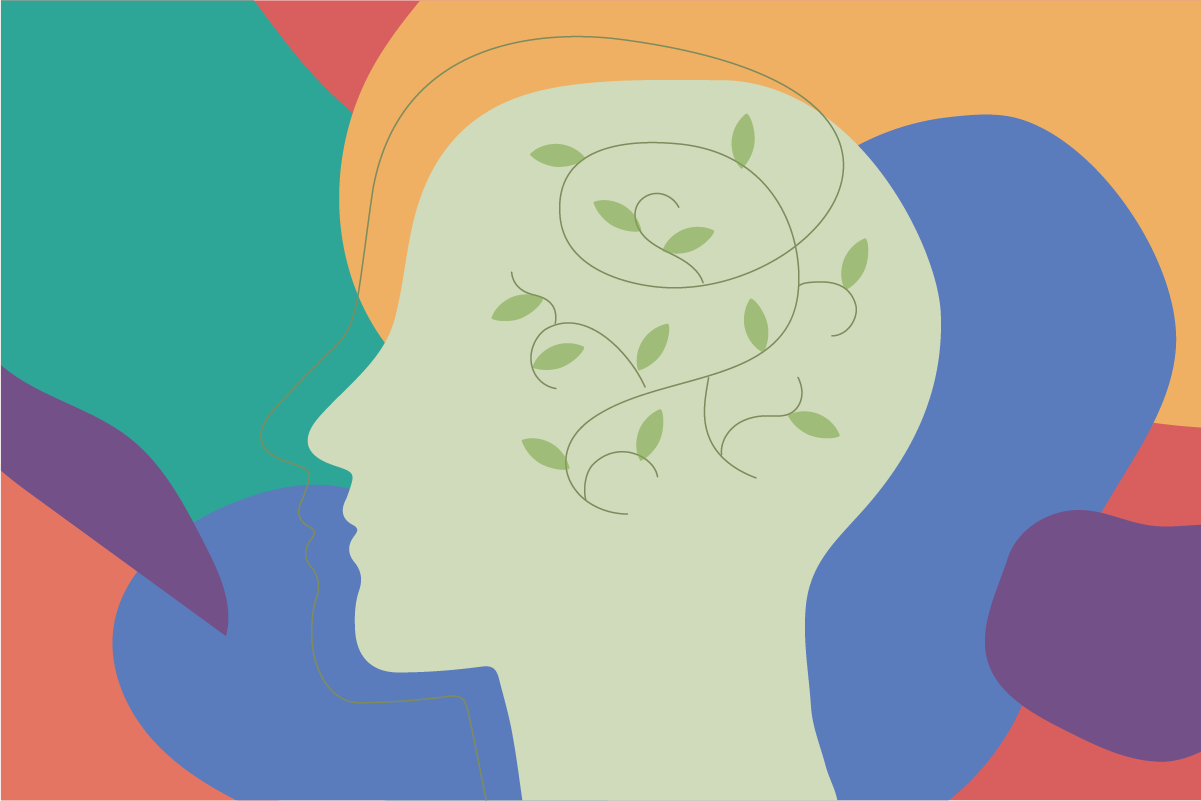
"A mixed bag."
When asked about the emotions they have seen expressed/felt in their classroom since returning to in-person instruction at a recent iThrive Educator Advisory Council meeting, Lauren Geschel, a HS teacher and co-creator of iThrive Curriculum: A Moment in Time, shared this response. For many educators and students, the back-to-school experience can be described in a similar way: a mixed bag of emotions—some that point to pain from what's been lost over the course of this pandemic, but also many that point to possibility in what's to come.
Tending to the emotions that come with this moment in education requires both understanding and empathy. At iThrive Games, we use play as a tool to foster better understanding of self, others, and the world in high school classrooms, crafting game-based, social and emotional learning experiences that support educators in creating connection and presence, while honoring the wholeness of the teens they teach. So, when Lauren later shared the journal writing exercise that got her HS seniors present, engaged, and reflecting on the 'mixed bag' of emotions they've experienced over the last year and a half, we knew we had to share it.
Activity: Pandemic Shifts
Providing in-class opportunities for students to explore their emotions helps create community in the classroom. Try dedicating some time during your next class session to Pandemic Shifts, a social-emotional learning activity that supports teens in being self-aware and reflecting on the shifts they've experienced and witnessed over the last 20 months:
- In preparation for this activity, legibly write the following five-question prompts on five large sheets of paper (one per paper), then post them throughout your classroom:
- What was the most shocking part of the pandemic period for you?
- What was one positive that came out of the pandemic for you personally?
- What have you realized about yourself during this time?
- What do you think has changed about the world that will never go back to the way it was before the pandemic?
- What scares you the most about the future?
- Have students take out five sheets of paper. Read each of the questions above aloud, allowing two to three minutes after each for students to respond to it. Let them know that their responses can be anonymous.
- When students are done, ask them to tape their responses under the respective question prompts posted throughout the class. Allow 10-12 minutes for students to walk the room and read their peers' responses.
- Once students have had a chance to read through their classmates' responses, allow 10-12 minutes for reflecting together about the activity. Remind students to be respectful of their peers. Here are some sample debriefing questions:
- How did that experience feel?
- What are some common threads and throughlines you noticed in your classmates' responses?
- What are some norms we can create this school year that consider these responses?
For educators who bring this activity to their classrooms, we would love to hear how it went with your students. Please share your experience with us at contact@ithrivegames.org, and be sure to stay updated with our growing library of social-emotional learning offerings by signing up for our newsletter today.
iThrive, Middlebury Institute Awarded DHS Grant for New Simulation Game

Earlier this week, iThrive Games, in a joint project with the Middlebury Institute of International Studies, was awarded one of 37 grants from the Department of Homeland Security (DHS) under the Fiscal Year 2021 (FY21) Targeted Violence and Terrorism Prevention (TVTP) Grant Program.
iThrive Games and the Center on Terrorism, Extremism, and Counterterrorism at the Middlebury Institute for International Studies will work together to create a novel, game-based learning experience that educates and empowers adolescents to become more aware and more resistant to radicalization, thus building resilience within their local networks.
Our approach to role-playing simulations embeds social and emotional learning and integrates tech and online play. iThrive Sim's role-playing simulations illuminate systems in the world that can be largely invisible until a person is invited to work and improvise within them. Experiences like these can propel students' curiosity and motivation to explore new ways of interacting and making decisions that can improve dysfunctional systems, counter extremism, and produce a better world for all.
"Using games to foster belonging and connection is what we are about," said Susan E. Rivers, Ph.D., Executive Director at iThrive Games. "We are saddened by the weaponization of belonging to advance radical agendas. This project is aligned with our mission to use game-based learning to support teens in recognizing true belonging and strengthening prosocial behavior."
Since teens are highly attuned to their emotions and social status, the experiential approach of role-playing meets them right where they are developmentally. The role-playing simulation game that will be created as a result of this grant will be designed to offer students opportunities to think about and practice self-awareness, social awareness, self-management, relationship skills, and responsible decision-making.
Part of the work of the grant will be supporting the local community-building the capacity at the administration and school level for delivery of the game-based learning experience.
According to a press release issued by the DHS, "The FY21 TVTP grants expand on the Department's new approach to prevention, which centers on providing local communities with evidence-based tools to help prevent violence while protecting civil rights and civil liberties and privacy rights. These grants will help local communities strengthen online and in-person prevention efforts, including by addressing early-risk factors that can lead to radicalization and violence."
High School Teachers, Share Your Feedback on the New, Improved iThrive Sim

iThrive Sim, designed to support high school educators in providing a deep civics learning experience role play through the lens of social-emotional learning, will soon be ready for teachers to facilitate! Since its debut, iThrive staff have facilitated the learning experience. We heard that educators want to be in the drivers' seat, running the simulations in a way that responds to their needs. We listened and are developing a new teacher-friendly interface for our three iThrive Sim scenarios that allows educators to run their own simulations in their in-person, virtual, or hybrid classroom.
Are you new to using iThrive Sim with your students? Each game merges online gameplay, immersive tech, and a content-rich storyline to engage HS students in a unique civic learning experience where they step into the role of leaders to make high-stakes decisions that impact the communities they represent. The new, self-guided versions of our iThrive Sim games are a great way to bring play, civics, and social-emotional learning to your high school classroom. Experience the best of our games, with the added benefits of being in the drivers' seat:
- Logistical Flexibility. Need an activity to engage your high school students on the spot? Want to run a simulation over multiple class periods? With self-facilitation for an iThrive Sim scenario, you'll have as much flexibility as you need. No need to schedule your classroom's Sim with a facilitator.
- Customize Roles and Groups. You know your students best. Think a particular student would benefit from a challenge? Or do you have students that are extra competitive or reserved? With you as the facilitator, you will have a full range of assigning roles and groups to meet your high school students' needs best. Place them where you know they will thrive and have the best experience possible.
- Engage with Your Students: Good facilitating fosters authentic engagement. When you know you're leading the discussion, you'll naturally be more engaged throughout the entire simulation and your high school students will too.
- Continued Support: Self-facilitating an iThrive Sim scenario does not mean you'll be totally on your own. When you sign up, you'll receive resources, checklists, prep materials, accompanying lesson plans and more, to support you in running a successful Sim for your class of high school students. Plus, our team is just an email away; we're always happy to answer any questions and provide technical support.
- Tie the Sim to Other Lessons: When you're in the driver's seat of an iThrive Sim scenario, you can easily reference previous lessons you've completed when relevant to the discussion and student experiences. In turn, you can challenge your high school students to draw more connections between content, resulting in a holistic learning experience.
Interested in using an iThrive Sim scenario in your high school classroom?
We're looking for high school educators who can pilot our new self-guided version of iThrive Sim, and give us feedback on the new teacher-friendly interface and process. We know you're busy, so we are paying $100.00 for your time. The pilot program will include:
- A meeting before running an iThrive Sim play session with your students;
- Running an iThrive Sim play session with your students using any of our three games (iThrive Sim: Lives in Balance, iThrive Sim: Leading Through Crisis, and iThrive Sim: Follow the Facts);
- Letting us know when (day and time) you'll run the session so we can be there to support you; and
- A follow-up conversation to hear about your experience
Sign up below and we'll be in touch to get you and your high school students set up to play!
Stories Add Heart to History. This Project Uses Them to Teach About Migration.

This summer, iThrive Games, Ronald Reagan Presidential Library and Museum, Re-imagining Migration, Got History, and the Herbert Hoover Presidential Library and Museum invited educators to collaborate on Moving Stories: From Personal to Policy, a project sparked by a desire to support teachers in facilitating challenging conversations with students around topics and events in history.
The north star of the collaboration was three-fold:
- To model co-creation of learning experiences that are inspiring and help students not only learn about a historical moment but also connect more deeply with their own identity, realize the connection of personal story to policy, and take away a new commitment to/plan for advancing justice through civic engagement.
- To create model learning experiences that can help shift the historical teaching paradigm away from single-narrative content-sharing to a place- and document-based democratic pedagogy that incorporates inquiry, awe, and play to achieve deep learning on core ethical, civic, and historical concepts.
- To expand the networks and communities of practice of some amazing educators looking for cutting-edge ways to engage students.
Over the course of the four days, participants dove into primary source materials, co-created lesson plans, and had the opportunity to listen deeply to and learn from each other about how the topic of migration touches their personal lives and family stories.
"Migration is a theme that connects all of humanity, and that was obvious in hearing the stories of each individual who made up this learning community," said Michelle Bertoli, Senior Director of Learning at iThrive Games. "It was amazing to see everyone's unique perspective and teaching/content expertise blend into cohesive peak learning experiences, with embedded social and emotional learning opportunities, that I feel confident will engage teachers and students in new and deeper ways of teaching and learning."
The endeavor was not without challenges, such as finding ways to approach and meaningfully use primary sources with often an abundance of language that is now considered outdated, offensive, and exclusionary. One member of the learning community challenged the group to make sure they were not promoting "learning at the expense of someone else's trauma." With migration as a sensitive topic that's intimately tied to themes of othering, marginalization, xenophobia, oppression, and violence, participants contended with questions such as "How do we approach this critical topic in a way that invites rather than shuts down emotional engagement, for whom, and to what end?"
Participants also discussed the tension between historical sources that are in themselves "neutral" and the very real experience that reading them can cause deep pain, anger, and even feelings of shame for people who belong to and identify with groups who have historically been marginalized.
These tensions highlight the need for social and emotional skill-building to be embedded within the learning experience.
"Both self and social awareness, especially as they relate to refining identity and building empathy, were central throughout this process," said Bertoli. "Coming to the awareness that migration touches and connects us all and that even that common experience can play out so differently for people across backgrounds and contexts was a key theme of the workshop."
Ultimately, the educational materials created are meant to serve teens in engaging more deeply with history so they can play a role in charting a new path forward.
"The activities we participated in and created made history feel alive, relevant, and emotional in a way that I have rarely experienced," said Bertoli. "I believe teens will truly come to the table for this type of experience: one where their personal, emotional, and familial connection to topics in history is not just included but actively highlighted and centered in the service of deep engagement, social and emotional development, and motivation to act justly in the present. I think these resources will invite those teens who avoid or merely "put up with" learning history to think and feel differently about engaging with and applying it."
The next steps for this project include refining the materials before sharing them more broadly and building on the co-creative process the group engaged in. For participants, moving the work forward remains essential.
"Migration is essential to our shared social and economic future," said Adam Strom, Executive Director, Re-Imagining Migration. "Yet, approaches to migration in schools are often fragmented or incomplete. As educators, we need to be laser-focused on developing the knowledge, skills, and habits that will prepare the next generation to work and live with people whose cultures, experiences, identities, and accents will increasingly be different from their own. Programs like this one are essential because they build understanding and support for reimagining the way we talk and teach about these foundational experiences."
Stay updated with our work co-designing learning experiences with history and social studies teachers by subscribing to our monthly newsletter!
Teens Have Big Emotions. How Can We Help HS Students Navigate Them?
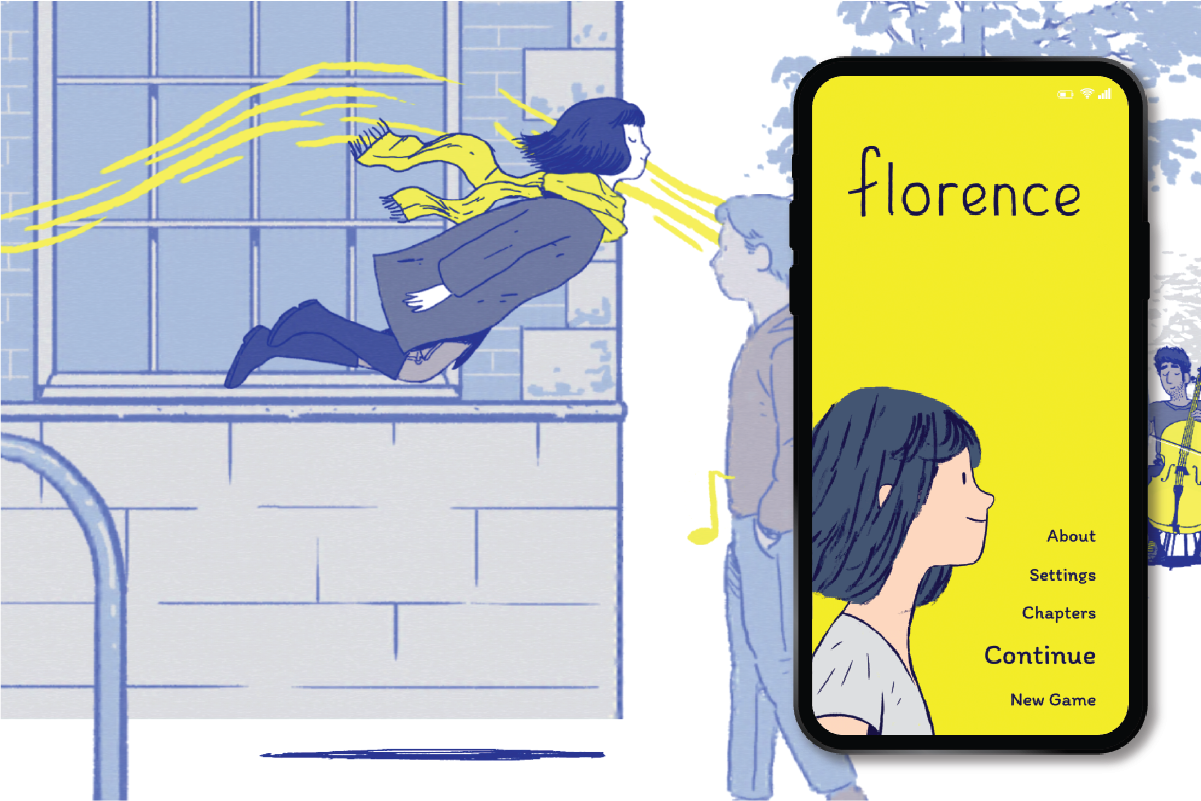
Teenagers have big emotions, and many already have a lot of unresolved grief at that age. Normalizing big emotions and offering tools for navigating this reality can is why social-emotional learning tools are necessary in high school classrooms.
I have been teaching high schoolers for about 20 years, and I am always asked how I manage the classroom so effectively and get them to be so responsive and receptive to my lessons. The short answer is that I recognize them as individuals. I validate their feelings. And I help them be self-aware and deliberate.
Even though many students need their hand held when it comes to recognizing and then communicating emotions and feelings, many of them are more than willing to do so in a safe space. If you can create such a space for your students and if you can reach them on a deeper personal level, the results will astound you. So, how do I do that? One way is to start with iThrive Curriculum: A Moment in Time.
iThrive Games invited me to co-create a lesson plan that would pair with the immersive media game Florence. The first step was to download the app and "read" the story: one that navigated the day-to-day life of Florence, an Asian-Australian 25-year-old whose aimless nature is universal and timeless for many young people.
There was much to unpack before I set about writing the lesson plans. What would I want my students to get out of this story? What lessons could be learned? What universal truths appear?
I immediately saw an opportunity to showcase lessons on non-verbal communication and symbolism, both of which can apply to real life. The story was told entirely with no words spoken; even when the characters are arguing, there is sound but no words. The power of communication was shown through images, sounds, movement, and gestures. This created an opportunity to discuss how these kinds of communication are prevalent in the students' everyday lives, even though they may not realize it or even think about it. The beauty of Florence is that it can be used in any classroom, especially in classes for English Language Learners (ELL), due to this nature of storytelling.
Symbolism plays a major part, too, and I definitely saw a way to help students relate to this, especially with two of the main characters having Asian and Indian heritage. It opened up many opportunities for students to discuss what cultural symbols they have in their life and how their background shapes who they are as a person. Having students choose objects that have significance helps reinforce the importance of sentimentality and the potential deeper meaning of objects in their lives.
But the real meat of the journey of Florence really lies in the weighty and emotional themes. One of the first themes I felt was important in this story is one of self-realization and identity. While Florence is significantly older than the students who will be reading her story, all can relate to the task of trying to figure out what their place is in the world. I believe so many students feel very lost about where they are headed, but I also believe that very few admit this out loud (or even to themselves). Showing them that self-realization and awareness is a long journey and that people often make mistakes along the way is an important lesson to be gleaned from Florence.
Overall, this story hits on so many levels and so many themes: including relationships, love, self-awareness, growing up, and ultimately (and the most impactful)-dealing with grief and loss. No matter who they are, every student has experienced grief or loss: of a loved one, of a friendship, of a piece of themselves that no longer exists, of a special place, etc. Tapping into this and showing them that grief over loss of so many things in their lives is not only normal but also incredibly understandable and expected is so important for teenagers who often lack the coping skills to grapple with such ponderous emotions.
iThrive Curriculum: A Moment in Time opens up the door to these ideas and shows students that everyone struggles in one way or another and that it is all about how one learns to deal with their issues.
Game-Based Learning Reads: Three Books That Will Make You a GBL Believer
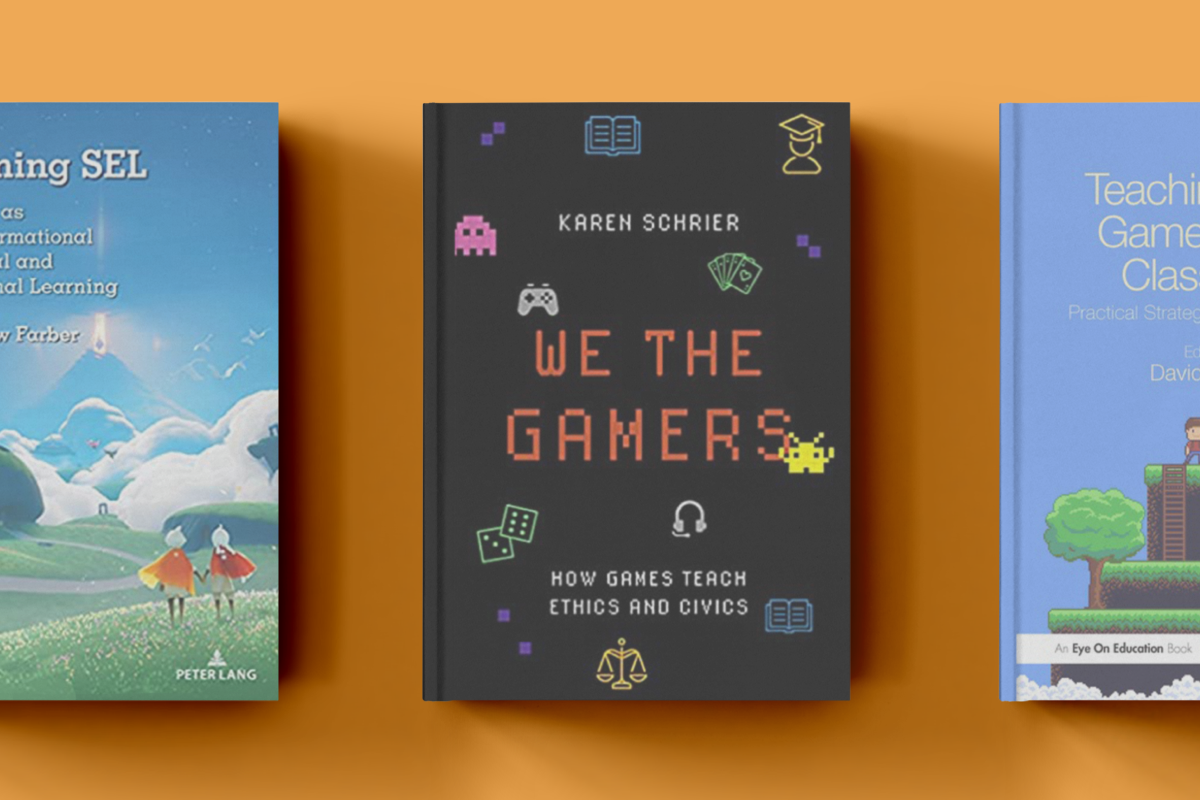
Game-based learning is part of iThrive's DNA as we support educators in bringing the power of play into the classroom. From impactful play and deep learning to personal transformation and social and emotional skill-building, the reasons to thoughtfully include games in educating young people continue to grow. Recently we have enjoyed the contributions of authors Matthew Farber, Karen Schrier, and David Seelow, who have written books adding to the body of knowledge related to game-based learning.
Karen Schrier, We The Gamers: How Games Teach Ethics and Civics
In this useful tome, Karen (Kat) Schrier explores the use of games in multiple contexts, from teaching ethics and civics, to creating connection and community, as well as for knowledge and action, and for critical thinking and inquiry.
Written during the pandemic, the book begins by exploring the many ways games were of great support to humanity during the stay-at-home orders and beyond. The author then takes a balanced approach by questioning when and how best to use games alongside learning, while acknowledging the limitations of games.
For educators who want to explore the power of games in the classroom, this one is a must-read.
Matthew Farber, Gaming SEL: Games as Transformational to Social and Emotional Learning
One thing that comes through in Matthew Farber's book on games and social and emotional learning is his deep love of and expertise in both. And we know that not only from the pages of this book but also because Matthew is a long-time collaborator with the team here at iThrive, having co-created Museum of Me.
Also written during the pandemic, the book is a very readable cornucopia of topics that span first-person accounts of gameplay and thought-provoking explorations of the neuroscience of games to comparing social and emotional learning models and contending with how games do or don't teach compassion, empathy, and mindfulness.
With practical information from links, lessons, and games, to well-woven-in peer-reviewed research, this book is useful to educators and caregivers who want to use games and understand why and how they are an asset for young people.
David Seelow, Teaching in the Game-Based Classroom
In this collection of strategies for game-based learning, editor David Seelow has culled the best teachers, researchers, and games to provide hands-on guidance for adults looking to introduce games into their classroom or youth encounters.
The introduction also stresses the multiple pathways one can take to succeed with game-based learning and ultimately help transform both teacher and student learning.
With contributors such as Paul Darvasi, Lindsay Portnoy, Claudia-Santi F. Fernandes, and more, the strategies offered within span empathy-building and support for wellness to project-based learning and useful feedback loops. A useful book for educators who want to use games to transform learning.
Interested in integrating game-based learning in your classroom this fall? Check out our iThrive Curriculum units and newest iThrive Sim role-playing simulation games, Follow the Facts and Leading Through Crisis, to get started!
Burgeoning Journalists Try on Their Roles in New Media Literacy Game

Media literacy incentivizes good journalism. In early June, two dozen high school students enrolled in the Summer Journalism Institute at the Walter Cronkite School of Journalism and Mass Communication, Arizona State University, stepped into a simulated newsroom to play iThrive Sim: Follow the Facts and discovered this. Follow the Facts is a media literacy-centered, role-playing simulation game where players, acting as journalists, sift through information and sources to find and share the truth about a mysterious illness and an impending storm in New Orleans.
Playing the roles of Lifestyle Reporter, Metro Reporter, Government Reporter, Opinion Reporter, and News Editor, students (in teams of five) engaged with in-game social and print media, practiced effective sourcing of information, explored bias, and engaged in collaboration. In a collaborative gaming experience that combined media literacy skill-building, social-emotional learning, and civics education, the 24 students who played got the chance to:
- Describe how the media shapes public opinion and behavior.
- Collaborate to see the bigger picture of a situation and create accurate news.
- Successfully rank the quality and value of varying sources of information.
- Practice effectively sourcing information in a digital world, an integral media literacy skill in the 21st century.
- Become aware of and describe bias and its impact on reporting, selecting, and interpreting the news.
- Demonstrate self-management while under stress.
- Practice clear communication.
The burgeoning journalists were highly engaged. Halfway through the game, they shared their learnings around journalism and media literacy, such as:
- "[I learned] To pay attention to details, work in teams, [and] make important formal decisions."
- "I learned that it's important to gain public trust by putting out specific and true information."
- "I learned how to make beneficial decisions under pressure. It also gave me the experience of being a journalist."
- "I learned that journalists have to handle a lot of information at once and work together to make decisions."
- "[I learned] journalists have a limited amount of time and must prioritize what they think is the best thing to do."
- "[I learned] That you really need to communicate with your team to have all of the information."
- "I learned that getting the facts/right info depends on how you choose your sources."
- "[I learned] only take information from verifiable sources."
Staff were energized by the engagement and thoughtfulness of the players.
"It was validating to see the students really deliberating over the decisions in the game and collaborating with each other to make the best choice," said Michelle Bertoli, Senior Director of Learning. "There aren't easy answers, just like in real life. It's such a great opportunity to dig deep and practice managing your own attention and emotions while you work closely with others towards a common goal."
To close out the experience, iThrive staff will lead a debriefing session based on the pre-written curriculum that accompanies the media literacy-centered simulation game. Follow the Facts is now available for summer enrichment programs and other youth-serving experiences. Sign up today to play the game with your students!
Add Play to Your Summer School Schedule: Virtual Conferences in July

After an unprecedented year, summer school programs are underway in several states across the nation, with an increased focus on students' social and emotional health. Game-based learning uniquely aligns with the times. When games are used in the classroom, they offer students a space to immerse themselves in new information, actively apply that information while problem-solving, try on new perspectives, and work in self-directed independent ways. The connective power of games also supports community-building and empathy, making play a springboard for responsible civic engagement.
As school administrators and teachers explore ways to enrich their classrooms this summer and later this fall, we're excited to continue putting game-based learning and SEL front and center at upcoming conferences where iThrive staff will be presenting. If you're interested in bringing games to your summer school program or classroom next school year, here are some interactive meetings to put on your calendar this month:
2021 Games for Change Virtual Festival (Monday, July 12th to Wednesday, July 14th, 2021)
The 2021 Games for Change Virtual Festival will feature virtual sessions hosted by an array of thought leaders on the transformative power of games and immersive media. iThrive's Executive Director and Chief Scientist, Susan E. Rivers, Ph.D., will be part of a session titled "Disinformation Games," where she'll discuss iThrive Sim: Follow the Facts, our new role-playing simulation game that supports media literacy skill-building. Join in on the session happening on Wednesday, July 14th at 5:30 ET/2:30 PT for a rousing discussion by registering here.
2021 NASSP National Principals Conference (Wednesday, July 14th to Friday, July 16th, 2021)
The theme of this year's NASSP National Principals Conference is "Together, We Will," with strands centering on equity, wellness, and innovation. We're excited to share our vision of how play supports each of these strands with all who'll be in attendance. In our interactive session, attendees will play iThrive Sim: Lives in Balance, our online role-playing simulation game that focuses on federalism and states' rights and uses a pandemic as the backdrop for practicing negotiation and decision-making. Players, acting as state governors and federal officials, will be tasked with moving the action forward themselves, aided by online gameplay and iThrive Sim's dynamic tech. They must work individually and as a group to assess the information at hand, defend their points of view, and make decisions that produce the desired outcomes in time. Register here to attend this conference, get in on the game, and learn how play can enrich your summer school program or school this fall.
More Ways to Meet
This fall, we'll be back on the road, virtually and in person, to share more on games, play, and their contribution to students' academic growth and social and emotional learning. There are many ways to engage with us. Learn about our game-based learning curricula and role-playing simulation games guaranteed to boost student engagement in your summer school classroom. Send us an email. Or sign up for our newsletter to stay in the loop with exclusive playtesting opportunities.
We look forward to connecting with you!
History Informs Our Understanding of Our Country. Let’s Tell It Truthfully.

This June, the last surviving liberator of Auschwitz died at the age of 98. According to CNN, David Dushman was one of the soldiers who liberated the people being held at the Auschwitz concentration camp. Over time, Nazis murdered over one million Jewish people there.
As one of our staff read the article, she was reminded of meeting her college friend's grandmother, who was a Holocaust survivor and still bore the tattooed numbers on her body. Seeing the tattoo she had only read about in history textbooks was a visceral and impactful experience for her.
As survivors and liberators of atrocities pass away, it begs the question, who has the courage to tell their story? How do we keep history and the past mistakes in our collective minds enough so that we don't recreate them in the present or future? And, how do we do this in a way that supports healing and does not stymy it? What role does our educational system play in making sure students know about past societal harms so that they can learn from history and do their part to create a world where those types of atrocities no longer happen?
To us, these questions are worth exploring. Our Executive Director and Chief Scientist, Susan E. Rivers, Ph.D., has said that "Empowering teens as changemakers means engaging youth and communities in drawing on the past and present to create new knowledge." We think that teens are more than capable of contending with history to make choices that will result in a better future.
Teens' brains are undergoing the last major restructuring of development, one nearly on par with early childhood brain growth. That means the teen years provide the perfect opportunity to build habits to support a healthy, productive, and engaged life. Teens are at a developmental moment defined by many strengths. Because of where their brains are developmentally, teens are at a place where they can examine the role of race and racism in history and our society and then use that understanding to envision how to relate to one another in ways that move us forward, toward greater equity for all. One hallmark of the teen developing brain is an aptitude for risk-taking; they can leverage this inclination to envision and offer up completely new ways of working together, being in community, and participating in democracy.
Rather than viewing history as something to choose from selectively, teens are ready and willing to look at the whole with open eyes. And they can be supported in that when guided by skilled and compassionate educators in an educational system that promotes critical thinking and responsible participation in democracy.
At iThrive Games, we are dedicated to thriving. And for us, thriving comes from facing and acknowledging hard truths and tough emotions and choosing to contend with those truths and emotions in service of taking action to build a more equitable and just for all humans. Whether it's with our game-based learning units that explore identity and relationships or our 21st-century skill-building simulation games, we believe in creating opportunities for teens to learn from history and flex the muscles they'll need to envision and enact an equitable future where all can thrive.
Media Literacy and Responsible Civic Engagement Go Hand-in-Hand

We know that media literacy is essential. Misinformation and disinformation campaigns from various entities have influenced everything from our elections, public sentiment, and individual decision-making. Media literacy is part of the solution to combat misinformation. Educators who teach media literacy are helping students contend with important questions. How do we detect biases? What sources of information can we trust? How do we apply critical thinking to the information that we take in through written and visual media?
We think it's imperative that teens have the opportunity to practice media literacy in the classroom. Young people are curious, consume tons of media, and are more than equipped to think and talk through these hard questions. So we created iThrive Sim: Follow the Facts to assist educators in exploring media literacy in their classroom. In this role-playing simulation, students play reporters sifting through information and sources to find and share the truth about a mysterious illness and an impending storm in New Orleans.
iThrive Sim: Follow the Facts was created in collaboration with subject matter experts such as Elizabeth Smith, Assistant Professor in the Communications Division at Pepperdine University. We asked Ms. Smith to share her thoughts about the power of media literacy in the lives of young people.
Q: WHY DO YOU BELIEVE MEDIA LITERACY IS SUCH AN IMPORTANT TOPIC FOR HIGH SCHOOL STUDENTS TO LEARN?
A: I believe media literacy is an important topic for people of all ages because, like it or not, we are surrounded by media all the time. The more literate we can become, the better we will be at understanding the origin, nature, and effects of our media consumption. More specifically, I think it is critical for us to invest in news literacy education with all learners, starting in kindergarten. High school students show us that they are not uninformed about news topics but find that many news outlets do not cover topics that they find relevant to their lives. Additionally, many high school students are confronted with news being shared on social media but aren't always clear what makes credible news, how news information evolves (especially in breaking news simulations), and what to think of the work of journalists. However, as high school students grow into adulthood, they will be asked to make informed decisions that will rely on credible, rigorously vetted information as news is. Knowing who and what is high-quality news information will help these emerging adults make informed decisions and understand others better.
Q: WHAT ELEMENT DID YOU THINK WAS MOST IMPORTANT OR TRANSFORMATIVE IN ITHRIVE SIM: FOLLOW THE FACTS?
A: I think the most transformative element in iThrive Sim: Follow the Facts is making decisions about what information to share. This pushes students to make relatively quick decisions about what is correct. Sometimes the details that differentiate two different pieces of information are subtle, which means students have to pay close attention to make quick, timed decisions. They talk about these decisions with their teammates. I think two elements are important: 1) The decisions are timed, so they are making decisions about information to share in real-time, just as a journalist does but also just like they do when they are more casually using social media in their personal lives; 2) Discussing the decisions helps them to share and build knowledge.
Q: HOW DO YOU SEE MEDIA LITERACY SUPPORTING RESPONSIBLE CIVIC ENGAGEMENT?
A: Media literacy, but more specifically, news literacy, helps individuals understand what the news is and what questions to ask about news information. News literacy does not promote that individuals or communities should blindly trust the news. Rather, news literacy should empower individuals to ask good questions and understand the process behind reporting and news production.
Q: WHAT'S YOUR FAVORITE PART OF THE GAME?
A: Honestly, I love the whole thing! My favorite part of the game is watching teams work together and hearing the way they support each other to make solid, informed decisions.
BRING MEDIA LITERACY SKILL-BUILDING TO YOUR CLASSROOM
If you'd like to bring Follow the Facts to your high school classroom or summer program, let us know! You can sign up here to learn more information or to request a time slot for your class. The "news office" opens on Friday, June 25, 2021!
Learn about the Power of Play at these Upcoming Conferences

2021 SERIOUS PLAY CONFERENCE
The Serious Play Conference this year features different tracks and multiple sessions with the common theme of using games or simulations in training and education. Our session on Wednesday, June 23, 2021 from 2 to 3:15pm ET will be presented by Executive Director and Chief Scientist Susan E. Rivers, Ph.D., and Senior Director of Communications Nicole Taylor. Stress Storm/New Norm: How Role-Playing Simulations Can Help will explore how role-playing simulations can be used in the workplace to assist leaders in identifying opportunities for coaching people managers and staff members.
The ability to practice social and emotional skills such as self-management, emotional awareness, social awareness, and responsible decision-making under stress is necessary for a healthy culture and optimal performance. Being able to observe how leaders perform under stress is a high-value opportunity provided by role-playing simulations. Using iThrive Sim: Lives in Balance, Susan and Nicole will share how a role-playing simulation can be used both to observe stress behaviors, assist people managers in identifying and working with their stress response, and provide opportunities for coaching to improve how staff members manage themselves and others. If this lights you up, register here.
2021 ASCD CONFERENCE: EMPOWERED AND CONNECTED
The theme for this year's ASCD conference is Empowered and Connected. The annual conference is full of sessions that will accelerate your summer learning plans and help get you prepared for the school year. At our session, Susan Rivers will be joined by educators Paul Darvasi and Mira Cohen to present Play to Thrive: A Game-Based Approach to Social and Emotional Learning for High Schools. If you're heading to ASCD, this session will allow you to:
- Walk away with free, classroom-ready game-based social and emotional curriculum and tools to use immediately for in-person and distance high school humanities courses.
- Understand how game-based learning approaches align with teens' specific developmental, social, and emotional needs.
- Discover a roadmap for infusing core curriculum with playful, tech-supported interaction for high school students' social and emotional growth.
Sound useful for your classroom? Register for ASCD Empowered and Connected.
COALITION FOR JUVENILE JUSTICE (CJJ) 2021 ANNUAL CONFERENCE
The Coalition for Juvenile Justice (CJJ) is a nationwide coalition of State Advisory Groups (SAGs) and allies dedicated to preventing children and youth from becoming involved in the courts and upholding the highest standards of care when youth enter the juvenile justice system. At CJJ's 2021 virtual annual conference, iThrive's Susan Rivers, Transition HOPE's Janelle Ridley and iThrive youth designer Bernardo S. will be sharing a session on Friday, June 11th from 10 to 11:30am ET entitled "Designing Games with Youth Experts to Dismantle Unjust Systems." They'll share the story of youth game designers who created a game called The Run Around to delineate their lived experiences in the juvenile justice system and advocate for changes to it. They'll also share how decision-makers can bolster supports for the well-being of incarcerated youth. You can register for this event here.
MORE WAYS TO CONNECT
Next month, we'll share the conferences iThrive is presenting at for the remainder of the summer. There are many ways to engage with us, and we look forward to connecting with you.
Civics Ed and Social-Emotional Learning Today, A Stronger Democracy Tomorrow

A new report by the National Academy of Education, titled Educating for Civic Reasoning and Discourse, states that while content knowledge about our government's structure is important, so are the more subtle aspects that prepare us to participate responsibly in democracy.
"Also of crucial importance is the development of dispositions to value the exploration of complex issues, to consider multiple points of view, to weigh evidence and to empathize with others. So is the development of the ability to reason about moral and ethical issues rooted in basic democratic values. Such moral and ethical issues are often embedded in our democratic decision-making," writes Carol D. Lee, president-elect of the National Academy of Education, in a recent Washington Post article.
CIVICS EDUCATION, SEL, AND RESPONSIBLE, DEMOCRATIC DECISION-MAKING
At iThrive Games, we wholeheartedly agree, and we have created iThrive Sim scenarios for the classrooms where students work to build these skills. Responsible decision making is central to participation in democracy, from choosing whom to vote for to choosing how to engage during times of community and societal change. We have seen evidence over the last year regarding the importance of these skills, as the nation has contended with addressing systemic racism and police brutality, navigating the pandemic, and managing the fallout from the January 6th insurrection.
Our civics role-playing simulations are designed to support the development of the dispositions Ms. Lee writes about in the passage above. Core to the learning objectives of all three of our role playing simulations are the social and emotional learning competencies of responsible decision-making and self-awareness.
We create experiences, such as our Leading Through Crisis scenario, in which youth role-play civic engagement by doing the following:
- Practicing making high-stakes decisions with far-reaching consequences under time pressure.
- Demonstrating self-management while under stress.
- Collaborating with others who have different immediate goals.
- Practicing clear communication.
- Summarizing a decision-making approach, including exploring pros and cons for a set of choices and thinking about the impact of including or omitting the perspectives of different individuals and groups.
We believe that the decisions we make impact not only ourselves, but others, and our community. Our hope is that civics role playing simulations such as ours will help prepare teens to practice civic reasoning and discourse in the way we will need to do in order to create the future we want.
Click here to learn how to bring an iThrive Sim virtual field trip to your classroom.
Use this SEL Activity to Help Your Students Process Pandemic Grief and Loss

For many teens this last year, grief and loss have been a part of life. For some it was the loss of in-person schooling and the accompanying social activities and for others it was missing or needing to adapt milestones and rites of passage, or grief that stemmed from sick family members or the over 500,000 souls in the U.S. lost to Covid. Whatever the specifics were, loss has been palpable both personally and collectively.
And now, as vaccinations are on the rise and we begin to emerge, the opportunity to see the rainbow after the rain is also here. We created iThrive Curriculum: A Moment in Time, to support teachers and teens in navigating these emotions together.
GRIEF AND GROWTH IN ITHRIVE CURRICULUM: A MOMENT IN TIME
A Moment in Time is a game-based learning unit for high school English Language Arts classes. Created in collaboration with iThrive staff, high school ELA teachers, and teachers in training, the unit uses the interactive story and video game Florence as the central text. Students follow Florence's journey through a few major life changes and see how she copes and grows as a result. It's a wonderful opportunity to support students in reflecting on their own journey with grief, loss, and change this past year, and exploring some positives that were on the other side of that storm.
According to one 10th grade teacher who piloted the iThrive Curriculum: A Moment in Time, "The students really got into it and went into a lot of depth in their reflections."
We look forward to educators' downloading the unit when it is launched at the end of May. In the meantime, we'd like to preview one exercise from the unit that can be of service as a standalone activity before the year ends, to help students process how they experienced the grief and loss of the pandemic.
AN SEL ACTIVITY FOR GRIEF AND LOSS: "AFTER THE RAIN, THE RAINBOW"
Step 1: Invite students into present-moment awareness using a tool of your choosing. We like to set a timer for 45 seconds and invite students to take 10 belly breaths during that time.
Step 2: Offer these journaling prompts for their self-reflection:
- How have you coped with a loss in your own life? Write down a strategy or two.
- What have you discovered about yourself in processing the loss?
- What is one positive thing that came out of the experience, even though there was loss?
Step 3: After sufficient journaling time, put students into pairs and allow them to discuss their answers to journaling prompt #3.
Step 4: As a class, invite anyone to share with the whole group.
This social and emotional learning exercise invites students to nurture their self-awareness and self-management skills while reflecting on their experiences of grief and loss. The iThrive Curriculum: A Moment in Time unit touches on the same themes across eight pre-written lessons for 9th and 10th grade ELA and humanities classes. Bring it to your classroom today!
iThrive Sim: Lives in Balance Named a 2021 GLAMi Award Winner

BOSTON--iThrive Sim won a bronze award in the GLAMi Award 2021's Interactive and Immersive category. Created by iThrive Games in partnership with Ronald Reagan Presidential Library and Museum, iThrive Sim is an innovative virtual augmented reality experience that provides an opportunity for meaningful and engaging experiences. The sim is currently used with museum-based, hybrid, and virtual visitors, and in traditional educational spaces.
According to the website for MuseWeb, the host of the GLAMis, "The annual GLAMi (galleries, libraries, archives, and museums) Awards recognize and celebrate innovative projects in the cultural heritage sector."
Susan E. Rivers, PhD, Executive Director and Chief Scientist at iThrive, sees immersive games as a true opportunity to support visitors in social and emotional learning: "Play is important for all of us," she said. "It brings us together in community. Play helps us create new solutions to problems...solutions we wouldn't have thought of otherwise."
iThrive Games is pleased to offer three iThrive Sim civics scenarios for learners who are high school aged and older: Lives in Balance, which explores collaboration and compromise during a pandemic, Leading Through Crisis, which explores responsible decision making during a critical event, and Follow the Facts, which explores media literacy during a natural disaster.
Mira Cohen, Director of Education at Ronald Reagan Presidential Library and Museum, says the virtual simulation was an important way to keep visitors connected during the pandemic, and beyond. "Through engaging audiences in meaningful and fun in-depth experiences, using historical records and government documents, we are able to increase our audience base, keep our current audience base engaged and further appreciation for the value of record keeping to our democracy, she said."
To learn more about iThrive Sim, visit https://ithrivegames.org/ithrive-sim/. To learn more about additional programs at Ronald Reagan Presidential Library and Museum, visit https://www.reaganlibrary.gov/.
###
Media Contact
Eghosa Asemota
eghosa.asemota[at]ithrivegames.org
About iThrive Games
iThrive Games prepares teens to thrive by meeting them where they are and working in partnership towards a world where all have the voice, choice, and agency to reach their full potential. We use games and game design to equip teens with the social and emotional skills they need to be healthy and resilient.
Exploring Juvenile Justice and Mental Health with Teen Game Designers (Part 2)

Part 1 of this series includes an overview of iThrive's Juvenile Justice System project and the framework for the Game Design Studio program. Click here to read Part 1.
It's called The Run Around. The goal of the board game is to be the first player to move all of your game pieces out of Maximum Security prison to Home. It's hard. It's frustrating. There are tons of setbacks. And it reflects the experiences of the youth designers who made it. The creative act, in the game design process, is part of how the designers cope with their experiences.
‟We tried to shape the game the way the justice system is," said K.C., one of the designers of The Run Around. ‟And we tried to base our directions and rules on what would happen in real life. One of them was like, when we are on parole or talk to our case worker, any little thing can get us put back into the predicament that we were in before. So we made the rules and regulations in the game to show that. It was to show how hard it is for you to get out."
While the subject matter was intense, K.C. found the design process enjoyable.
‟It was so fun," she said. ‟It was fun to see the finished product. It was fun making the rules and seeing other people get frustrated playing it [because our experience in the system is just as frustrating]. It was like when we were making the game, we were making it so people would get irritated because they wouldn't be able to win. And then seeing that they really did get mad. It was fun watching it become what it is now."
Another game designer was lit up by the aesthetic of the game.
‟I like the graphic designs of what we created," said R.D. "I like the clothes they have on. It looks very much like society right now."

K.C. agreed, saying, ‟They each have their own individuality."
Players advance their character through the game via the Choice cards. The Choice deck is stacked though. Only a few of the cards will actually allow you to leave prison. But watch out for traps! Landing on a Trap spot—and there are many—will cause you to move backward, lose a turn, or be sent back to prison.
R.D. sees the toughness of the game as a key design choice to add realism.
‟For guys who have been in jail, I feel like they can relate to it," he said. ‟A lot of stuff said in the scenarios in the game...it's realistic."
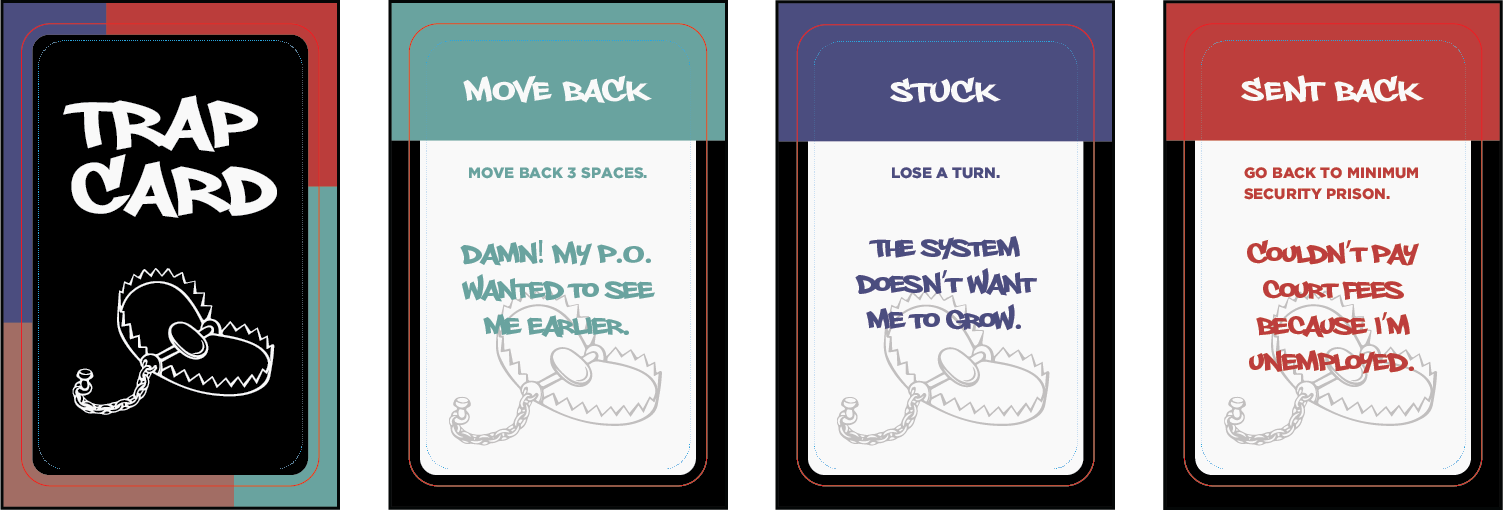
The game designers put a lot of intentionality into the design of the six characters, named Naomi, Marven, Jay, James, Ty, and Ace.
‟I created Marven," said M.A. "I relate a lot to Marven because my charge was similar. He gets caught up with friends and drugs and has to go to trial. People rat each other out."
For M.A, it wasn't just the circumstances that he channeled into the game. It was also the emotions.
‟The same thing with depression and anxiety happened to me while I was waiting for trial," he said.
And the final step of the game design process, which is to act, is set to happen over the next few months. The game designers will use The Run Around in workshops they are both designing and facilitating for stakeholders from the juvenile justice system in Boston beginning in May. They are also set to share their experiences at Games For Change this June. They are hoping that by sharing their experiences, decision makers can begin to create better support for youth who are system involved.

‟Anyone who goes through this has these feelings and the fact that it's a person of color doesn't make it any better," said M.A.
The Science of Political Division and How SEL Skills Respond to It

It's no secret that division and political sectarianism are on the rise. How and when do they spill over into the classroom? As teachers teach civics, their role is to highlight the work of participating in democracy. Though they are not advocating for one party over another, the end goal is to help students understand how each person can responsibly engage in democracy.
This video from the Washington Post sparked in us a few ideas about how tools such as our role-playing simulation platform, iThrive Sim, might help teachers give students the opportunity to practice bridging this division and come to shared understanding.
First, experts in the video share a few of the building blocks of political division:
- Othering: Seeing people as part of an out group, and having a favoritism for the in group
- Aversion: Having a deep distaste or dislike for the out group
- Moralization: Seeing people from the out group as on the other side of a moral divide and having different values than you
These components of political division can make us feel threatened by what we perceive as the "other side," activating our fear response. An unchecked fear response can result in a range of behaviors, from not talking to or associating with those you perceive to be on the "other side" to out-and-out violence. This cycle is exacerbated by an eroded sense of shared reality (which will sound familiar if you read the RAND report on Truth Decay).
The experts offer a few suggestions for interrupting this cycle of political division:
- De-escalate conflict by talking about values that the other person cares about
- Take a step back and do a gut check to see if the threat you're feeling is real or perceived
- Ensure you still see the humanity in the other person and are not seeing them as a caricature
Interrupting the Cycle of Political Division with SEL and Play
We believe that the connective power of play supports the nurturing of social-emotional skills that help interrupt cycles of political division. Our civics-centered role-playing simulations are built on this belief, helping teachers prepare students to navigate conflict as they engage in democracy today and in the future.
Our SEL-rich role-playing simulation, iThrive Sim: Lives in Balance, invites students to play the role of government officials who are navigating making the best possible decisions for their constituents during a pandemic. Students practice social-emotional skills aligned with interrupting the cycle of division, such as:
- Describing the balance of individual rights and responsibilities in an organized society
- Practicing negotiating and compromising with people who don't share their point of view
- Advocating for their own and others' interests
- Demonstrating self-management while under stress
Additionally, our social and emotional learning-focused curricular surrounds support students in practicing emotional awareness and doing deep reflection. To learn how to bring this free experience to your classroom, visit our website.
We know this isn't the solution to the deep divide that teachers help students learn to navigate, but we see it as a step toward our desired future—a future that upholds democracy, regardless of political affiliation, while creating an equitable environment for all.
Conflict Resolution: Using Role Play to Practice Disagreeing Respectfully
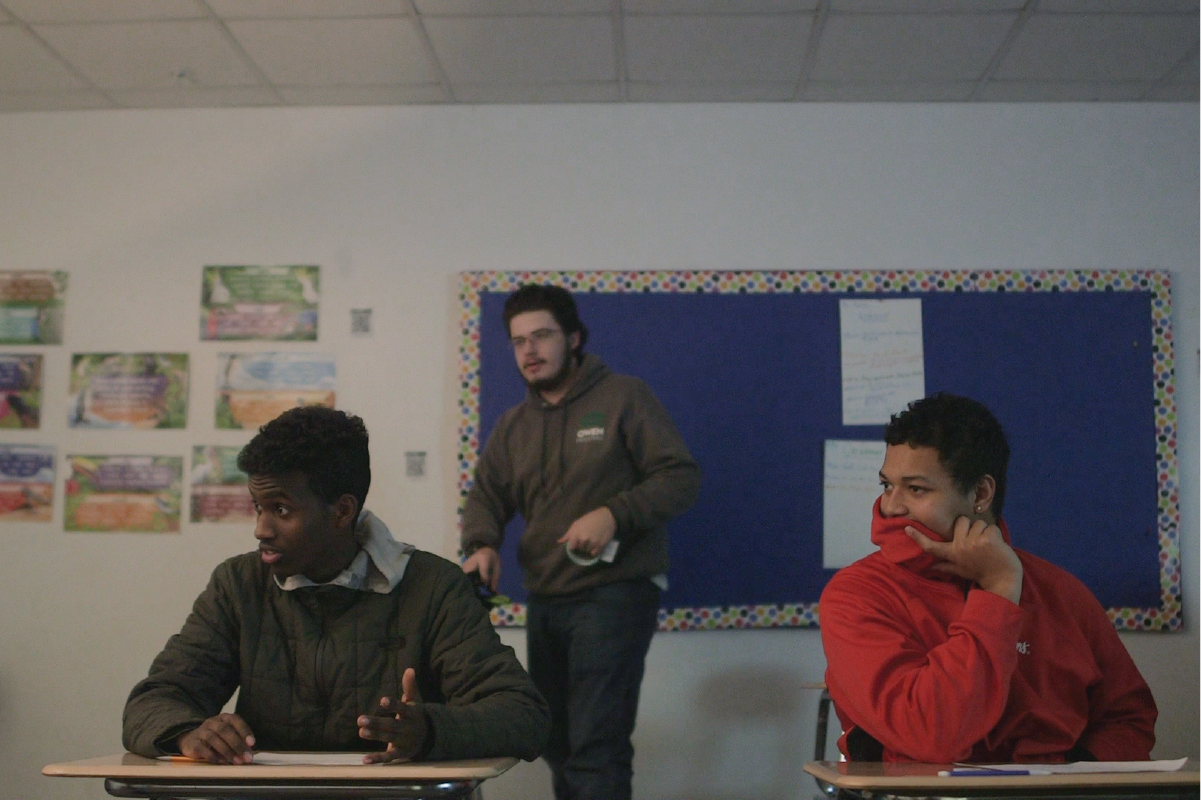
Solutions to big problems can arise from good debate. There is power in learning to disagree well, which we believe means maintaining respect for the humanity of the other person. A foundational aspect of our view that high school civics skills are skills for life is that disagreeing well is part of being an active participant in democracy. And being able to resolve conflict is part of being in relationship with others.
The good news is that disagreeing well is a skill that can be taught, especially in the context of play. Teens today benefit from game-based educational experiences such as iThrive Sim, which teaches them how to disagree with respect so they and their peers can solve problems by collaborating across different perspectives.
When we look to science to see how to disagree well, one theme that comes up is to find common ground. A recent study in Nature Neuroscience found that when volunteers agreed, they had more confidence in their own decisions and the decisions of others, and when they disagreed, they began to have less confidence in the view of others. This may seem anecdotally obvious (been in an argument lately?) but it does point a way toward disagreeing well-and that is to find common ground. Many disagreements, when we take the time to dig deeper, may have some hidden overlapping beliefs.
With iThrive Sim, high school students practice finding common ground through role-playing scenarios. In our Lives in Balance scenario, students play the role of government officials trying to decide how to govern during a global pandemic. We have watched hundreds of students play the game and find ways to practice conflict resolution as they discuss different decisions. The most interesting playtests are those in which the students begin to grapple with what they have in common even as they debate their competing interests.
Lives in Balance enriches social studies and civics classes as teens try on negotiating and compromising with people who don't share their point of view and they balance advocating for their own and others' interests—all while practicing responsible decision-making.
We are also playtesting two new scenarios: Leading Through Crisis, where students play members of a crisis response team grappling with the 25th amendment, and Follow the Facts, where students play journalists practicing information literacy as they report on a natural disaster with differing accounts of what's true.
Bring Lives in Balance to your class or contact us to playtest our other two scenarios.
10 YA Novels by Authors of Color for Your HS English Classroom

As part of the commitments we made in our anti-racist statement back in June, we are reviewing our educational offerings for opportunities to make them more equitable and to see where we can uplift and center voices of color and those from underrepresented communities. One way we can do this is in our curricular units, such as iThrive Curriculum: Sam's Journey—an English Language Arts and humanities unit for high school students. The narrative at the center of Sam's Journey is the game A Normal Lost Phone, which is unpacked message by message as players unlock information in Sam's phone.
In our equity review of the unit — and inspired by the game's mechanism of telling a story largely through text messages and emails — we found there were opportunities to extend the unit by linking it to epistolary novels we love (or that have been recommended to us) that were authored by writers of color.
We combed through our favorite YA books and asked our teacher friends for recommendations. Here are 10 awesome young adult epistolary books by authors of color that you may wish to use in your classroom:
- Monster, by Walter Dean Myers. In movie script format, 16-year-old Steve Harmon tells the story leading up to the most pivotal event in his life.
- To All the Boys I've Loved Before, by Jenny Han. Lara Jean writes love letters to every boy she's loved and keeps them safe in a special place. Everything changes when the letters make their way out into the world.
- Dear Martin, by Nic Stone. Justyce Mcalister has had a brush with police brutality. In trying to make sense of it, he begins journaling to Dr. Martin Luther King Jr., inquiring about the usefulness of those teachings today.
- The Absolutely True Diary of a Part-Time Indian, by Sherman Alexie. Junior is growing up on the Spokane Indian Reservation, and he tells his story through a mixture of writing and art.
- The White Tiger, by Aravind Adiga. Balram Halwai shares the story of his life in India through a letter to a Chinese political figure.
- Between the World and Me, by Ta-Nehisi Coates. In letters to his adolescent son, author Ta-Nehisi Coates shares the experiences that have evolved his understanding of his place in the world as a Black man.
- The Color Purple, by Alice Walker. In letters to God, Celie shares the story of her life and her journey toward self-acceptance.
- Tears of a Tiger, by Sharon Draper. In letters, homework assignments, and articles, the story of high school student Andy's journey of grief and guild is unveiled.
- In the Time of Butterflies, by Julia Alvarez. This novel shares the story of four sisters who fight against an authoritarian regime in the Dominican Republic.
- Zenzele: A Letter for My Daughter, by J. Nozipo Maraire. A mother writes letters to her daughter, sharing life lessons and her experience of Zimbabwe's struggle for independence.
You can find many of these books on commonsensemedia.org to assess their themes and age appropriateness for your classroom. We hope this list is helpful in building out resources for high school classrooms that elevate the voices of people of color.
Self-Awareness: Nurture It in Your Students with This SEL Exercise on Values

Last summer, in iThrive's statement in response to the killing of George Floyd, we revisited our values and made commitments to ensuring that everything we put into the world upholds justice and serves humanity. Over the course of this year we'll be sharing our progress, to hold ourselves accountable for continuing to take action toward being an anti-racist organization.
One of our commitments was to "continue our education on anti-racism and our journey toward becoming an anti-racist organization." One way we have continued that journey is to refresh our organizational values to be sure they reflect our commitments. We now have a shared, documented guidepost for our interactions with each other and with our collaborators. This same guidepost also informs our English Language Arts curricular units and our civics-based role-playing simulations and curricular surrounds, ensuring that they invite students into these same themes. Here are iThrive's values:
- Whole Self: I am welcome to bring my full humanity and my gifts to work in service of collaborating and helping iThrive meet its mission. And I honor the full humanity and gifts of my colleagues.
- Connection: I foster personal and professional relationships with colleagues and collaborators, which supports iThrive in creating offerings that center relationships as well.
- Joy: I make time to weave authentic joy, appreciation, celebration, and play into my workday and into iThrive's offerings.
- Communication: I communicate honestly and transparently in service of fostering collaboration, maintaining good relationships, and keeping the organization running smoothly.
- Integrity: I embody wholeness by acting ethically and in alignment with our values in my work and my interactions.
- Diversity and Inclusion: I work to understand, be curious about, and center a variety of perspectives and experiences in my interactions on the team and my contributions to iThrive's offerings. I contribute to an anti-racist lens at iThrive.
- Commitment to Learning: I approach work and interactions with the acknowledgment that I always have more to learn about myself, my colleagues, our work, and the world. I use curiosity to support a focus on growth rather than being right.
- Impact-driven Innovation: I use design thinking to fully understand problems and help to create real solutions that make a difference and foster transformational impact for teens.
We hope this transparency is helpful in letting our stakeholders know what we are about and what's important to us. There's power in naming your values and holding yourself accountable to them. Here's a discussion prompt to help your high school students reflect on their values and the ways they embody them.
- Imagine your best day, when everything is clicking. Imagine your interactions with others, how you feel inside, how you're connecting with others, how you're contributing to the world around you. Picture this day with detail...what are you wearing? Who do you see? What are your surroundings? Stay with this image until it feels very real.
- Once you have the feeling, write down the elements that were a part of the day. What went into making it your best day? How did you show up? How did you show up for your community? How were you in relationships? In what ways did you make good choices or decisions? What beliefs or principles allowed that day to be as good as it was? Write these down, whether they are a sentence or a paragraph.
- Set a timer for 60 seconds and take a few breaths, just being present with how you feel. When the timer goes off, take a second look at the list and ask yourself what might be missing. Take a few moments to add that. Reflect on whether you'd be willing to show up this way even when circumstances are not ideal.
- Now craft a short definition for each of the themes or values. Keep it short and simple so you can use it as a touchstone.
- Keep this for yourself or find a partner and share a bit about your best day.
Let us know how this tool works with your students. We are happy to create English Language Arts and Social Studies resources that help these values become a reality. Sign up for our newsletter to learn more about our offerings.
Purpose: Helping Students Explore How to Impact the World Around Them

The riot at the Capital and other events over the past two weeks have made many who wish to uphold democracy think, "I wish there was something more I could do." Meaningful changes happen in this world when people combine their unique passions and skills into collective actions.
At iThrive, we make tools to help high school educators create civics-centered contexts for teens to practice social and emotional skills, preparing them for meaningful and transformative civic engagement in three primary areas: self, community, and the world. Last week, we shared a tool for presencing feelings in the classroom to help teachers support students in cultivating emotional awareness in times of crisis. This week, we are thinking about tools for the community and the world. We have found that exploring purpose can help high school students begin to navigate how they are best suited to contribute to their community and to the world.
Seeking to define a purpose — where things we love and are skilled at overlap with a need in the world — is an important developmental step for teens and one that contributes to greater well-being. Teens shouldn't be rushed to choose a purpose, but they do need plenty of opportunities to consider and experiment with what resonates deeply with them and motivates them to give their best.
Activity: The World
For educators, giving students an opportunity to tap into their sense of purpose may be one antidote to the difficulties our society is facing. Try opening your next class with this brief set of prompts that students can journal about or discuss in pairs:
- What's an issue or challenge in the world I care a lot about? What makes me say, "I wish I could do something?" (e.g. preserving democracy, achieving racial justice, eradicating poverty, ensuring animal welfare, etc.)
- What's my vision for the world in 10 years, as it relates to this issue?
- What unique ability, strength, talent, or skill do I have that I can start contributing to this vision?
- What's one small step I can take in the next week to use my skills in the service of this vision?
Taking it Forward
At iThrive, we believe that since civics is social and emotional, we should teach it that way. We hope this tool is helpful for assisting students in exploring how they might engage in civics from a place of purpose, now and in the future. Learn how we're using play, SEL and tech to prepare high school students for transformative civic engagement.
An Insurrection Happened. Here’s an SEL Tool to Help Students Process It.

On January 6th, a mob stormed the Capitol building to halt the work of governing the United States of America-specifically the work of certifying incoming president Joseph Biden as the winner of the 2020 election. The news was filled with images of an angry mob of people, some holding confederate flags, descending on the Capitol building, gaining access to it, vandalizing certain offices, removing property, and antagonizing police and government officials. We were shocked and dismayed at scenes of government officials cowering under desks while the mob tried to gain access to them.
That day or the next, teachers did the work of helping students to make sense of what they saw, to process their feelings about it, to put it in a historical context, and to practice media literacy. We are grateful to every teacher who shouldered this heavy lift.
Here at iThrive, as we did our own processing of what we were seeing, many of us were struck by emotions not only associated with the event at hand, but also emotions associated with variance in how those participating in the insurrection were treated and what might be at the root of the difference in how they were treated as compared with protesters who were marching for Black lives. So there were feelings upon feelings to be present with.
At the behest of our Executive Director, Dr. Susan Rivers, we turned to a tool that we use often to get present with how we feel. It's our version of a tool created by Dr. Kathlyn Hendricks of the Hendricks Institute. We offer it below, for adults to process and then for adults to use with the youth in their lives, specifically teachers with students.
We hope that this social and emotional learning (SEL) tool is of support in the days and weeks to come.
Activity: Befriending Feelings
This exercise can be used to get present with the emotions you are feeling and to experience them fully without feeling the need to take action immediately. Choose an issue or situation or event that you'd like to explore.
- For a few minutes talk about (or journal about) your thoughts and feelings about the situation.
- Turn your awareness to your body. Having just expressed yourself, notice what you feel in your chest and throat area. Write that down or draw how you feel. Notice how you feel in your upper back and neck area. Write that down or draw how you feel. Notice how you feel in your belly area. Write that down or draw how you feel.
- If you noticed sensation in your chest and throat area, complete the following sentence: "I feel sad that ______."
- If you noticed sensation in your jaw and shoulders/neck area, complete the following sentence: "I feel angry that _____."
- If you noticed sensation in your abdominal area, complete the following sentence: "I feel scared that ______."
- If you noticed sensation in multiple areas, try completing each of the sentences.
- Take a moment to appreciate that you gave yourself the time and space to be with your feelings. Noticing how you feel is an important step to take before you take any action. Think of a person or a place where you feel safe and loved. Allow yourself to feel that sense of safety and love for yourself for being okay with having big feelings.
DOWNLOAD THE BEFRIENDING FEELINGS ACTIVITY (PDF)
At iThrive, we believe that since civics is social and emotional, we should teach it that way. Learn how we're using play, SEL and tech to prepare high school students for transformative civic engagement.
2020 Wrap-Up: A Gameful Year of Connection, Creativity, and Play

2020 was not an easy one by anyone's standards. Educators scrambled to learn how to deliver distance learning and to change all of their lesson plans to an online format. Students struggled with the loss of much of their in-person social life and with the transition to learning from home. Parents managed working while trying to help their children with online learning. And nationally, as we grieved our pandemic-related losses, we also collectively faced systemic racism, with many finding ways to begin to make changes from where they stood.
While not easy, there was still the opportunity for social and emotional learning and joy in 2020. Whether we found new ways to connect with family and friends through play online or whether we had a lot of obstacles to overcome, we made it—because we are still here.
Like everyone else, at iThrive we had our ups and downs and lots to adjust to in 2020. We were happy to officially release iThrive Curriculum: Museum of Me, to collaborate with educators on the creation and release of iThrive Curriculum: Sam's Journey, to playtest our new role-playing simulation, iThrive Sim, with over 400 students, and to collaborate with our colleagues at the Situation Room Experience to create the civics-based Lives in Balance and Leading Through Crisis scenarios for our simulation game.
We appreciate you for the many ways you engaged with us, whether it was downloading one of our game-based learning units, attending one of our webinars, playtesting our role-playing simulation, or reading our articles. Below are the blog posts you read the most this year.
Top Five Blog Posts of 2020:
- Social Distancing and Staying Connected Through Games: Read about how playing games together at home can relieve stress, bring joy, and foster connection.
- Urban Assembly Students Create COVID-19 Choose-Your-Own-Adventure Story: Read about our first virtual Game Design Studio, held with students from Urban Assembly. We co-designed an interactive story game reflective of the students' experiences navigating the social upheaval of the pandemic.
- COVID Self-Care Package: Practicing #SELatHome: Try out our 14-day challenge to practice social and emotional learning (SEL) and self-reflection at home. Social and emotional skills are even more useful in times of confusion, crisis, and abrupt change.
- Games to Play While Social Distancing: MMORPGs: Read about how massively multiplayer online role-playing games (MMORPGs) can be a safe space to wander, explore, and connect with others.
- Staying Connected While Social Distancing: Games for Emotional Coping: Take a look at our gameful recommendations to help you practice self-care, savor life's best moments and experiences, and turn inward to explore, accept, and express what's challenging about this moment.
We hope that each of you has a wonderful holiday season. We'd love to stay connected with you. Click here to receive our monthly newsletter with resources and updates. Here's to more creativity, connection, and play in 2021.
Civics Is Social and Emotional. We’re Using Play to Teach It That Way.

The events of 2020 have forced into the national consciousness the foundational need for both responsible civic engagement and attending to young people's social and emotional well-being. As the pandemic and its ripple effects have endured, social and emotional connection and skill development have become a non-negotiable anchor for many school communities. At the same time, the power of individual choices to impact the well-being of whole communities has been thrown into high relief.
It is timely that in the past few years, thinkers and practitioners at the leading social and emotional learning organization (such as CASEL) have prioritized connecting young people's social and emotional competencies to larger questions of civic responsibility and justice. CASEL defines transformative SEL as "a process whereby students and teachers build strong, respectful relationships founded on an appreciation of similarities and differences, learn to critically examine root causes of inequity, and develop collaborative solutions to community and societal problems." This definition aligns with iThrive's view that civics is social and emotional, and that social and emotional skills enable responsible civic engagement.
iThrive embeds social and emotional learning opportunities into civics role-playing simulations for high school students through iThrive Sim, a role-playing platform and accompanying SEL-rich scenarios that invite teens to experience the very human factors in all civic endeavors in a visceral way.
We see educators creating civics-centered contexts for teens to practice social and emotional skills, preparing them for meaningful and transformative civic engagement in three primary areas: self, community, and the world.
Self
At the intrapersonal level, all students must be able to see themselves — and believe they deserve to be seen — in the story, purpose, and future of our democracy. The stories we tell in classrooms, both in words and in actions, must enhance self-awareness by reflecting the diversity of the students we teach. This can spark in all students, and particularly those traditionally excluded from mainstream education, a sense of belongingness, motivation, and efficacy to engage in the democracy we all must steward into the future.
Community
Interpersonally, students (and all adults) must come to view individual and cultural differences as rich assets. They also must cultivate self-management, social awareness, and relationship skills, including the ability to manage discomfort and pause to investigate their habitual biases in order to fully see those with whom they disagree. Without these skills, we cannot hope to meet on common ground to tackle our society's most intractable challenges.
The World
Students must both see and understand systems of injustice and foster the beliefs and skills needed to advocate for changes that make a more just society for themselves and others. They should develop the skills to make responsible decisions that enhance not only their own best interests but the interests of the collective, global community. A genuine concern for the just and ethical treatment of all members of our society starts with seeing ourselves in each other, and believing that we all deserve to play an important role in realizing our country's highest ideals.
If we consider school communities as microcosms of democracy, wherein we norm and enact the values of our civic society writ large, the fact that civic and social and emotional values are the fabric of school environments becomes obvious. The question is whether or not we are making them tangible, speaking about them directly, and using them to elevate learning and connection. We have a responsibility and an exciting opportunity to do so.
Virtual Classroom Management Tips: Supporting Connection With Play

The move to remote learning highlights some of the limitations of a virtual classroom. Trying to build resonance and create connection among people over video conference requires intentionality.
At iThrive, we see interpersonal connection as a sense of warmth, belonging, feeling seen, and feeling respected. In virtual environments, cultivating this requires some different strategies than we use when we're in person. As part of the curricular surrounds for our new virtual civics game, iThrive Sim: Lives in Balance, we have created a number of ways to support teachers in building this intentional connection.
We appreciated the work of the game-loving experts behind Zoom Jam, presented by USC Games and Situation Lab in partnership with The Higher Education Video Game Alliance. We included Mute-iny, our favorite game from Zoom Jam, as part of an activity teachers can do at any point, but particularly before engaging in online play, such as our role-playing experience. This activity can help to focus attention on how each class member can contribute to an inclusive and engaging virtual space.
Step 1: Reflect and Discuss
Share with students that to stay connected from a physical distance in the virtual classroom, you might need to use some different strategies than you use when you're together in person. Ask students to reflect and share:
- What does feeling connected mean to you?
- This year as we have practiced social distancing, how have you stayed connected to friends and family?
Step 2: Tune in Through Play
- Introduce the lip-reading game Mute-iny and orient students to it with something like, "Let's see how closely we can pay attention to one another."
- Play Mute-iny. This simple game works with any video conferencing software with video and chat functions.
- Have each student who'll be playing prepare one sentence that they will say on mute while others try to guess what they are saying.
- Tip: You may want to have each role-play group of 6 play this game together in breakout rooms (if that is allowed in your school). If you want to play as a whole class, ask 6 students to volunteer to say sentences while the rest of the class guesses what they're saying.
Directions (Source: https://zoomjam.org/):
- Everyone is muted, and the volume is turned down.
- Pick an order for people to go (for instance, number each person 1, 2, 3, 4...).
- One person starts by counting down from 3, then says a sentence really slowly.
- Everyone else - type and send your response to the group chat and see what everyone else said!
- Have the next person signal or post in the chat that they're starting, and repeat steps 3-5 until everyone has had a chance.
- Once everyone has finished their turn, unmute yourselves and reveal your sentences!
Step 3: Briefly Discuss
- Ask students to reflect and share: What did you notice about how we connected and tuned into each other while we played Mute-iny?
What strategies have been working for you to enhance connection in your classroom? We love hearing from you, so if you'd like to share, email us at contact@ithrivegames.org. And be sure to visit our website to learn more about using iThrive Sim, our role-playing simulation, in your high school civics class.
iThrive Games to Join The Great Exchange: Student Engagement Summit
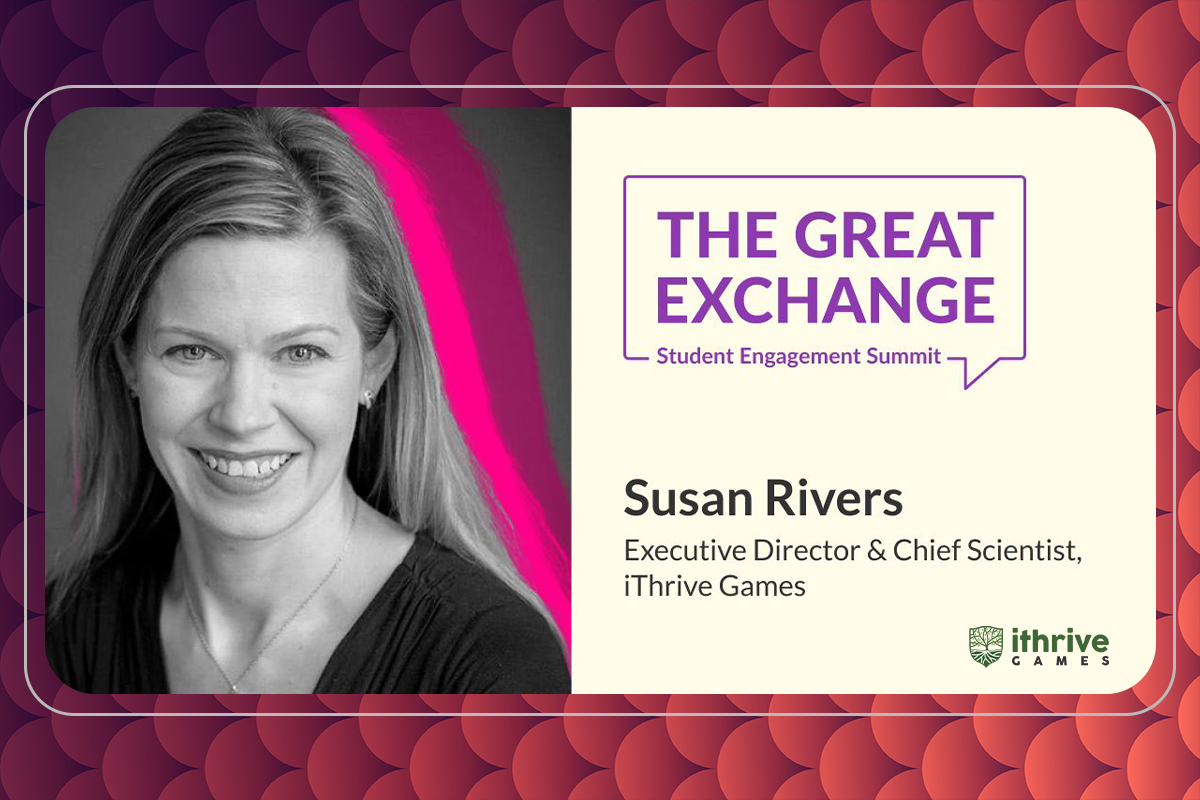
CLICK HERE TO REGISTER FOR THE #GREATEXCHANGEDU: STUDENT ENGAGEMENT SUMMIT
Susan E. Rivers, PhD, Executive Director and Chief Scientist at iThrive, is looking forward to speaking at The Great Exchange: Student Engagement Summit, produced by Classcraft and Google for Education. This virtual event, on Thursday, October 29th, brings together education innovators from across the sector in service of sharing practices for engaging students more deeply.
Dr. Rivers will be part of the panel discussion "How can games promote equity?" along with David Adams of Urban Assembly, Jennie Magiera of Google, and Devin Young of Classcraft. They'll discuss how games can engage all students by making learning more culturally relevant, reducing unconscious bias, and fostering intrinsic motivation.
"Distance learning is an opportunity for us to be even more intentional about embedding social and emotional learning and finding new ways to engage students," said Dr. Rivers. "I look forward to discussing how game-based learning invites students to try on new identities and gain new perspectives."
This virtual event is free of charge so that anyone who wants to learn and engage can do so. Click here to register for The Great Exchange: Student Engagement Summit. Stop by our booth at the virtual expo, where we will be sharing more about our civics game iThrive Sim: Lives in Balance. Hope to see you there!
iThrive’s Juvenile Justice System Project Fosters New Partnerships
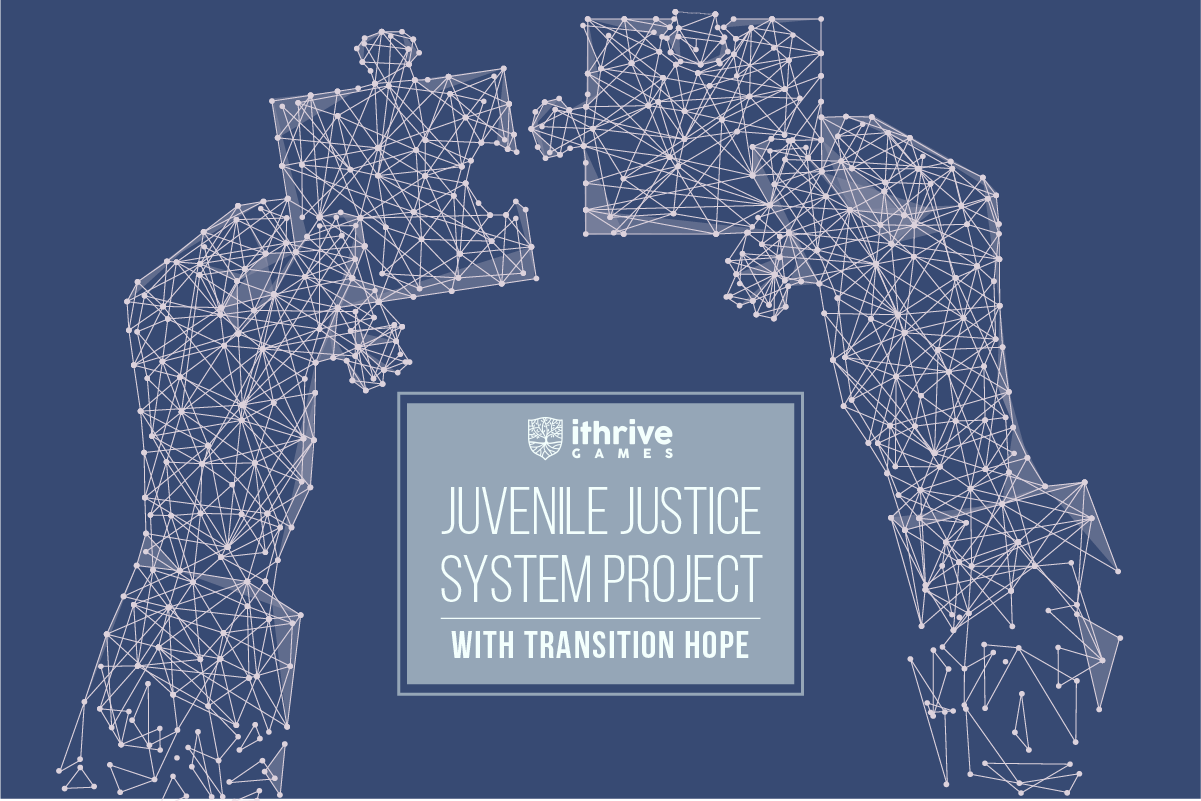
Racial disparities in the juvenile justice system continue to grow even as youth arrest rates decline overall, and black youth face particularly egregious disparities. Inequity in the provision of mental health services on the basis of race before, during, and after incarceration negatively impacts the health, well-being, employment opportunities, educational attainment, and relationships of individuals of color who are or were system-involved.
Last year, with a grant from William T. Grant Foundation, iThrive began setting the groundwork for a project to increase understanding of the lived experiences of youth of color within juvenile detention centers. The project was set to use iThrive's co-design approach, Game Design Studio, to authentically engage with youth and explore opportunities and barriers to supporting their mental health.
The COVID-19 pandemic hit just before the project was set to launch, disrupting the planned work. We could no longer work in-person with the youth; the detention centers were closed to all visitors indefinitely and travel restrictions were in place across the country. Staff explored and tested options for working with the young people at the chosen site in Georgia remotely, but the lack of reliable remote access and the nature of the work prohibited a distance approach.
After a few months of exploring other potential partners, staff found an excellent collaborator in Janelle Ridley. Bringing over 15 years of expertise to the project, Ms. Ridley currently sits on the Governor's Juvenile Justice Advisory Board and was previously a District Coordinator for System-Involved Youth for the Boston Public Schools where she worked with youth most impacted by the school-to-prison pipeline and sought to intentionally foster educational equity while actively working to dismantle the school-to-prison pipeline. Ms. Ridley is founder of Transition HOPE, a program intentionally designed for youth who are system-involved. Transition HOPE has been able to assist and bridge the needed resources for youth to continue moving forward. HOPE is an acronym for holding High Expectations for each and every young person; providing Opportunities that are realistic and within their perspective; helping the youth envision Pathways to Success by taking ownership of decisions for desired long-term outcomes; and providing Encouragement to help youth acknowledge that success is theirs to claim and define irrespective of the past.
In this new iteration of the project, iThrive staff will work closely with Ms. Ridley and a group of youth who will serve as Peer Leaders using our game design studio workshop model. Within the game design studio, peer leaders design games that draw from their lived experiences to think about the impacts of systems on their lives, and to imagine re-designed systems that would better support their well-being and mental health. In addition to designing games, peer leaders will build their facilitation skills and will lead meetings across the year with stakeholders, including other youth, city officials, educators, among others. In those meetings, peer leaders will use the games they design to launch discussions and explorations around systemic change, with particular focus on their lived experiences and on their well-being and mental health.
The peer leaders will work with youth stakeholders across multiple sessions using the game design studio approach, where the youth stakeholders will be invited to share their experiences in the system, iterate on the game designs to better reflect their needs and experiences, and then engage in conversations and game-play sessions with stakeholders.
"My goal is for those in positions of power and change to recognize that those with the lived experience are the experts, and they need to be at the forefront of change," said Ms. Ridley. "My hope is that these youth will see the value they are able to bring forth and although their journey has been those of trials, tribulations, and oppression, their journey is not over yet."
iThrive staff are grateful to Ms. Ridley and the youth for their partnership and also look forward to collaborating with AGNCY, a Boston-based nonprofit design firm that engages user-centered design to work with stakeholders toward systems change; and Beverley Evans, associate professor at the Graduate School of Education at Lesley University, who focuses much of her teacher training on building empathy amongst her students for young people and families most impacted by the school-to-prison pipeline.
"We are thrilled to have found partnerships to advance this important work," said Susan E. Rivers, PhD, Executive Director and Chief Scientist at iThrive Games. "We look forward to engaging with this group of young people in service of supporting youth-initiated systemic changes, changes that are long overdue."
Virtual Classroom Management Strategies: Norm Setting in 3 Steps

In a time that asks us to reevaluate what we think of as normal classroom management, one way educators and students can co-create a sense of stability in the virtual classroom is to collaborate on setting norms.
Whether you're a few weeks or a few months into the school year, revisiting norms can be a helpful part of your virtual classroom management plan.
As we work to support teachers in amplifying their civics curriculum with our role-playing game iThrive Sim: Lives in Balance, we have found that a key part of inviting students into deeper engagement is to collaborate with them on a set of key norms. These are touchstones for everyone to observe and come back to during interactive and unscripted play and learning sessions.
Having agreements in place can help build connection and investment and prevent misunderstandings. Norm setting also gives students language and tools to advocate for themselves. It emphasizes that responsibility for making the learning experience a success belongs to all class members.
Below is a three-step process you can use to facilitate norm setting in a virtual classroom. You can set aside 25 minutes for the full discussion.
Step 1: Facilitate a discussion. Use the following prompts:
- What's different for you in your experience of learning when we are together in the classroom compared to when we are together virtually?
- What do you know you need to do to stay alert and engaged?
- How will we signal to each other that something isn't okay and needs to change?
- What do we each commit to doing to support an environment where we can all participate and learn?
Step 2: As a class, vote on and rank the most important norms.
Step 3: Make a list of the key behaviors, strategies, and signals the class has agreed are most important. Consider "pinning" this list in the chat box of the video conferencing software used in your virtual classroom or other shared online space so everyone can revisit it regularly.
What strategies have been working for you to enhance connection and foster helpful norms in your classroom? We love hearing from you, so if you'd like to share, email us at contact@ithrivegames.org. And be sure to visit our website to learn more about using iThrive Sim, our role-playing simulation, in your high school classroom.
classroom management norms virtual classroom
Self-Care Tips for Educators: Discover New Practices at The Lounge on 10/28
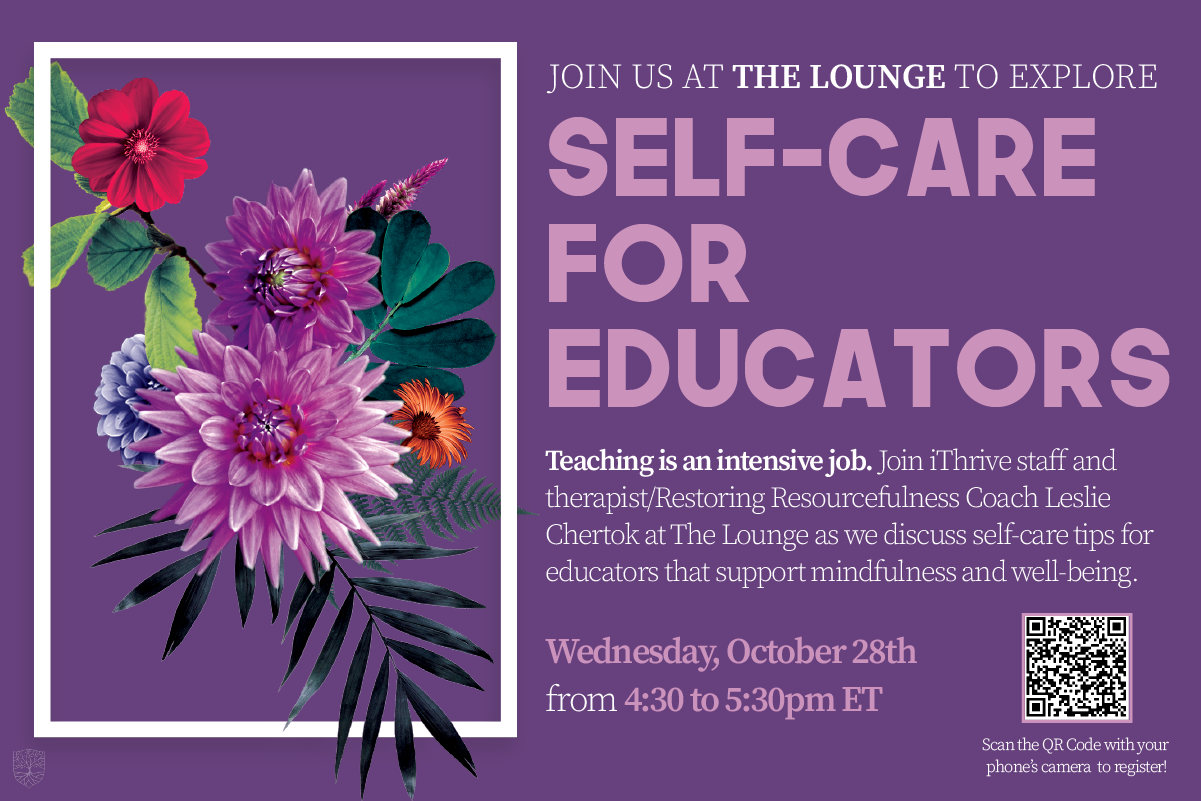
RSVP TO JOIN US AT THE LOUNGE on WED, 10/28!
Thank you to those who attended our first meeting of The Lounge—A Place for Teachers to Connect and Share Ideas. For those who missed it, in our inaugural gathering iThrive's Executive Director and Chief Scientist Dr. Susan E. Rivers shared classroom management strategies for supporting emotional awareness along with self-care tips for teachers interested in incorporating social-emotional practices at home. We'd love to share it with you so we've embedded the video below for those of you who couldn't make it.
What's Next?
Join us in The Lounge on Wednesday October 28th from 4:30-5:30 pm ET. Therapist and Restoring Resourcefulness Coach Leslie Chertok will offer self-care tips for educators. Engaging through online learning platforms all day can leave you feeling a bit drained. Leslie will share a breathing exercise that you can do alone or with your students to support classroom management, and she'll share an attention refresher called Loop of Awareness. Please take a moment to register here. See you in The Lounge!
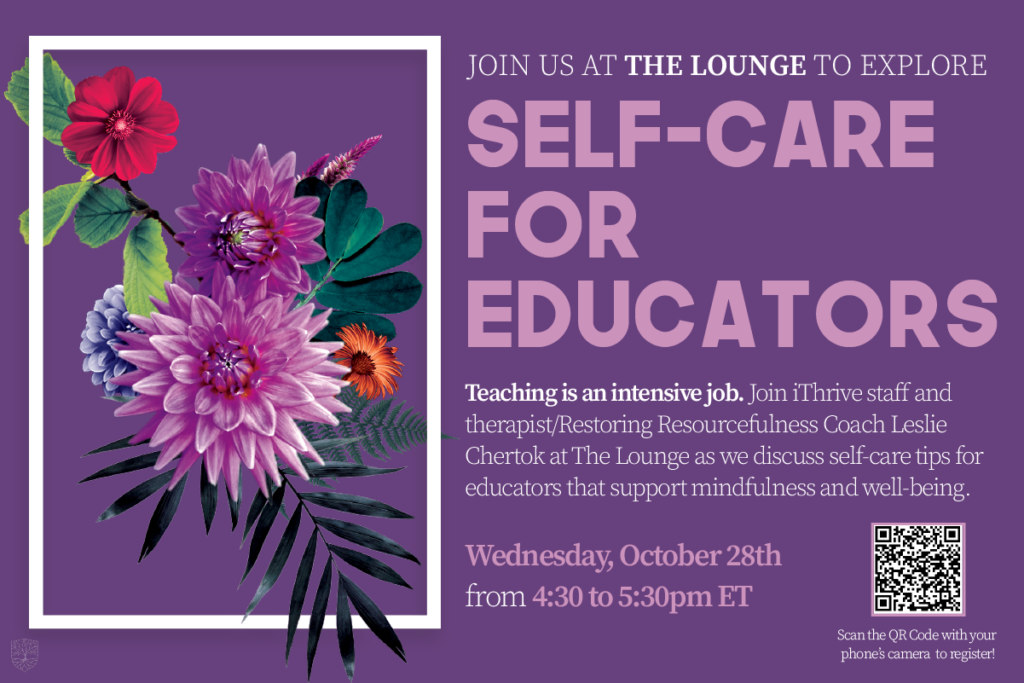
Welcome to The Lounge: A Place for Teachers to Connect and Share Ideas
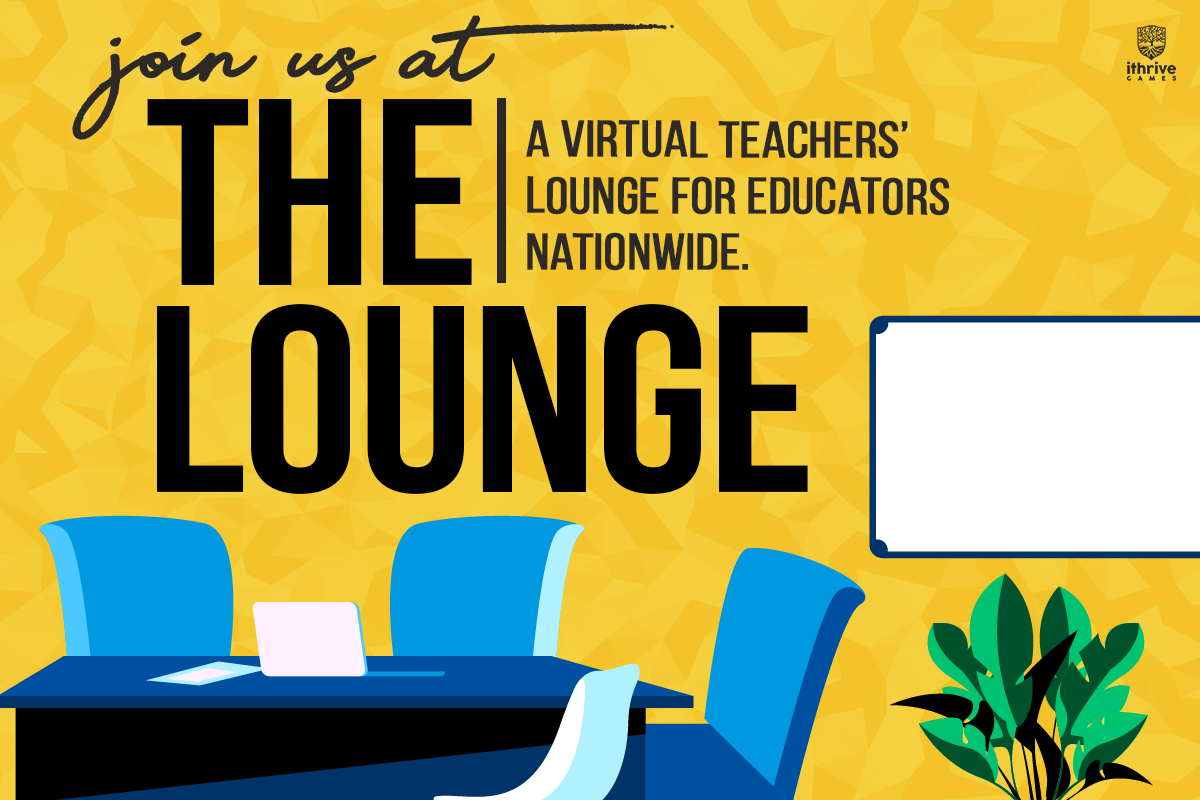
Favoring connection. That's what we are up to as we navigate the current circumstances. We wanted to create an online space for teachers to favor connection with each other after they do such a good job connecting with students.
So grab a snack or drink and join us at The Lounge—a virtual teachers' lounge where educators can connect, vent, and share ideas with other teachers across the nation. Topics will be in the space of social and emotional learning, game-based learning, and high school education.
This month's topic is emotional awareness in the classroom. How are you practicing it at home and with your students? Hear from our Executive Director Dr. Susan E. Rivers as she shares tips on how to set up a classroom in ways that support social and emotional learning.
Come into The Lounge on Wednesday, Sept. 30th at 3:30pm ET. Click here to register. After registering, you will receive a confirmation email containing information about joining the meeting.
Hope to see you there!
Call for Abstracts: Volume 3 of Journal of Games, Self, & Society

Journal of Games, Self, & Society (JGSS), a peer-reviewed journal created and edited by iThrive Games and published by ETC Press, publishes original research and scholarship examining the benefits to humans and to society when games include humanity as a core design element. We encourage interdisciplinary research, community, and conversation focused on how games, game design, and gameplay contribute to a deeper understanding of learning, health, and humanity. We enthusiastically seek original works that push the boundaries of what we know—or what we think we know—about the qualities of games that can benefit our lives emotionally and socially.
The theme of our next issue is games as fuel for connection and transformation for teens.
As society navigates the COVID-19 pandemic and charts a path forward, games continue to be integral to learning and connection at home, in our communities, and in educational spaces (be they virtual or physical). This is especially true for adolescents. We seek papers that highlight real-world applications of the science of gameplay's benefits for relationships, learning, and well-being during this critical developmental period.
We are pleased to announce that Claudia-Santi F. Fernandes and Grace Collins will join us as guest editors for this issue.
We invite educators, researchers, scholars, and game designers from across academic disciplines and industries to submit extended abstracts for consideration in the next issue of Journal of Games, Self, and Society.
Successful abstracts will meet the following criteria: (1) examine the use of games in settings with teens with a focus on relationships, learning, or well-being; (2) demonstrate applications of or commentary on theory and/or an evidence base, (3) are found to be of good fit, adequate rigor, and theoretical or practical soundness, and (4) make a new contribution to the field. We encourage submitted manuscripts to consider and include implications for theory, policy, and/or practice in the discussion section.
Manuscripts published in the journal typically include empirical research using qualitative or quantitative methods (including case study approaches); literature reviews, and detailed descriptions of the game(s) or game design that is the focus of the piece. Submissions may focus on the design approach and analysis of a specific game, use of one or more games in learning settings, applications of policy, or other innovative approaches examining the journal's area of impact.
Please explore previous issues of the journal for examples of works previously published. The journal audience is interdisciplinary and includes designers, researchers, educators, and other practitioners.
Extended abstracts are due by November 20, 2020. Invitations for full articles will be made in November. Full papers are due by May 1, 2021, and will undergo blind peer review. Notifications of acceptance will follow in May 2021 and revisions will be due by July 1, 2021. Accepted works will be published in Volume 3 of the journal in the fall of 2021.
How to Submit
Extended abstracts should be anonymized and follow APA formatting. Abstract should not exceed 1,000 words, excluding references. Please include in your abstract a brief introduction to your research topic, an overview of the theoretical or empirical underpinnings and relevant literature, methodology (if relevant), findings of interest, and implications for theory, policy, and/or practice. Abstracts should also include a brief statement about how the full paper will address the topic of this issue—games as fuel for connection and transformation for teens—and how it advances the mission of the Journal of Games, Self, and Society to foster a deeper understanding of learning, health, and humanity through games.
Abstracts should be sent to jgss@ithrivegames.org no later than 11:59 PM ET on November 20, 2020. More information about the journal can be found here.
About Our Guest Editors
Claudia-Santi F. Fernandes, Ed.D. LPC, MCHES, NCC, is associate director of the play2PREVENT Lab at the Yale Center for Health & Learning Games and an associate research scientist at the Yale School of Medicine. Claudia is an adolescent (mental) health expert with experience in public schools, clinical settings, and research institutions.
Grace Collins is founder and CEO of Liminal Esports. Grace previously taught high school computer science and led games and education policy at the U.S. Department of Education.
Call for Nominations: iThrive Games’ Educator Advisory Council
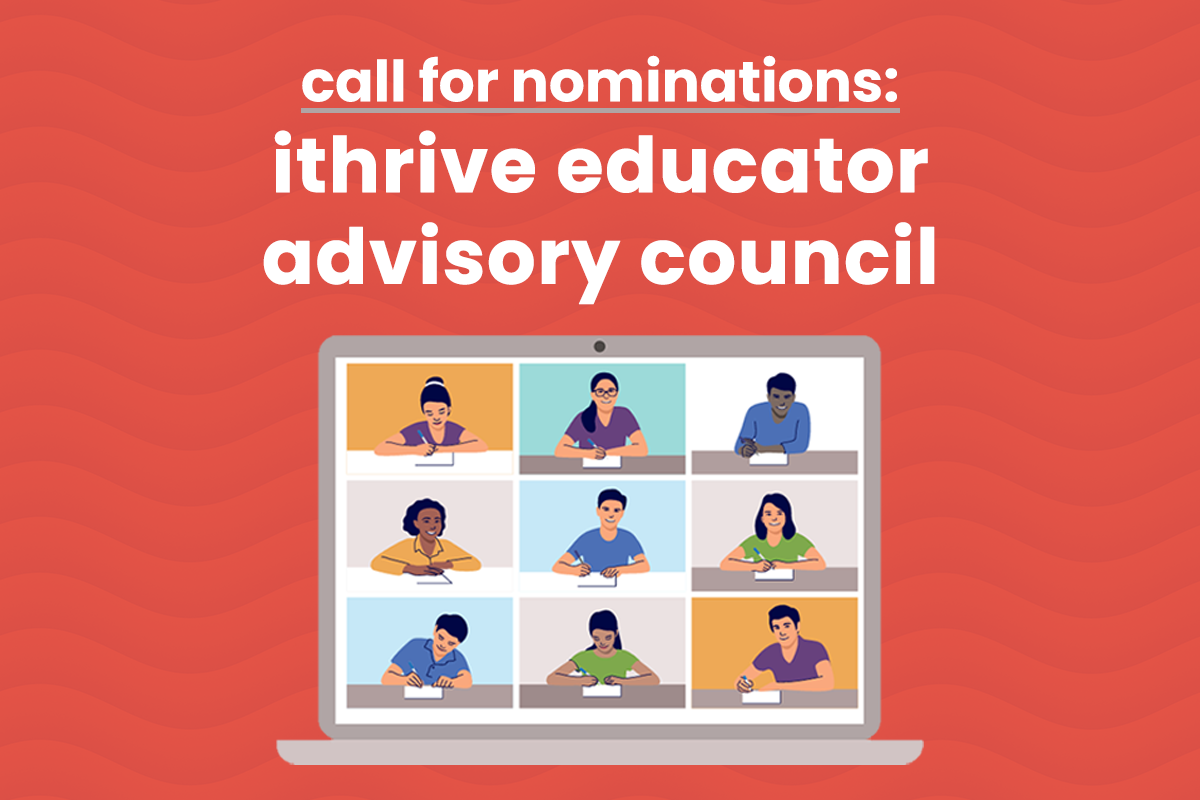
The iThrive Educator Advisory Council is a national hub of teachers that advises and supports iThrive Games Foundation in its mission to use games to equip teens with the skills they need to be healthy and resilient, the tools that support and protect their mental health and well-being, and the systems thinking they need to recognize inequity along with meaningful opportunities to imagine and design a better world.
Councilmembers are high school social studies and English Language Arts teachers and administrators who bring the perspective of passionate educators with deep insight into who teens are as people and as learners. Councilmembers will offer feedback on and promote resources for educators and teens that encourage student engagement, deep learning, and meaningful connection.
iThrive commits to working with teens from traditionally marginalized groups, especially people of color, women, members of the LGBTQ community, those living with disabilities, English language learners, and those from working class backgrounds. We believe educators who teach these groups must be centered in the work that we do, so teachers who bring these experiences are encouraged to apply.
Benefits:
- Virtual meeting that requires no travel
- Meet new peers, connect with other teachers and engage in enriching conversations in community
- Gain insight into deep knowledge on game-based learning and social and emotional learning
- Visible listing on the iThrive's website as an iThrive Educator Advisory Council member
- Honorarium for quarterly meetings and playtesting encounters
Responsibilities:
- Bring your innovative, inspired perspective that contributes to forward thinking
- Commit to one term (two years of membership)
- Attend quarterly advisory committee meetings online
- Provide feedback on iThrive programs and initiatives
- Notify colleagues of education program offerings at iThrive
You can nominate yourself or someone you think would love collaborating with us. Please fill out this form to apply or nominate a teacher you know, and contact us here if you have any questions. Nominations are open and will be considered on a rolling basis.
Urban Assembly Students Create COVID-19 Choose-Your-Own-Adventure Story
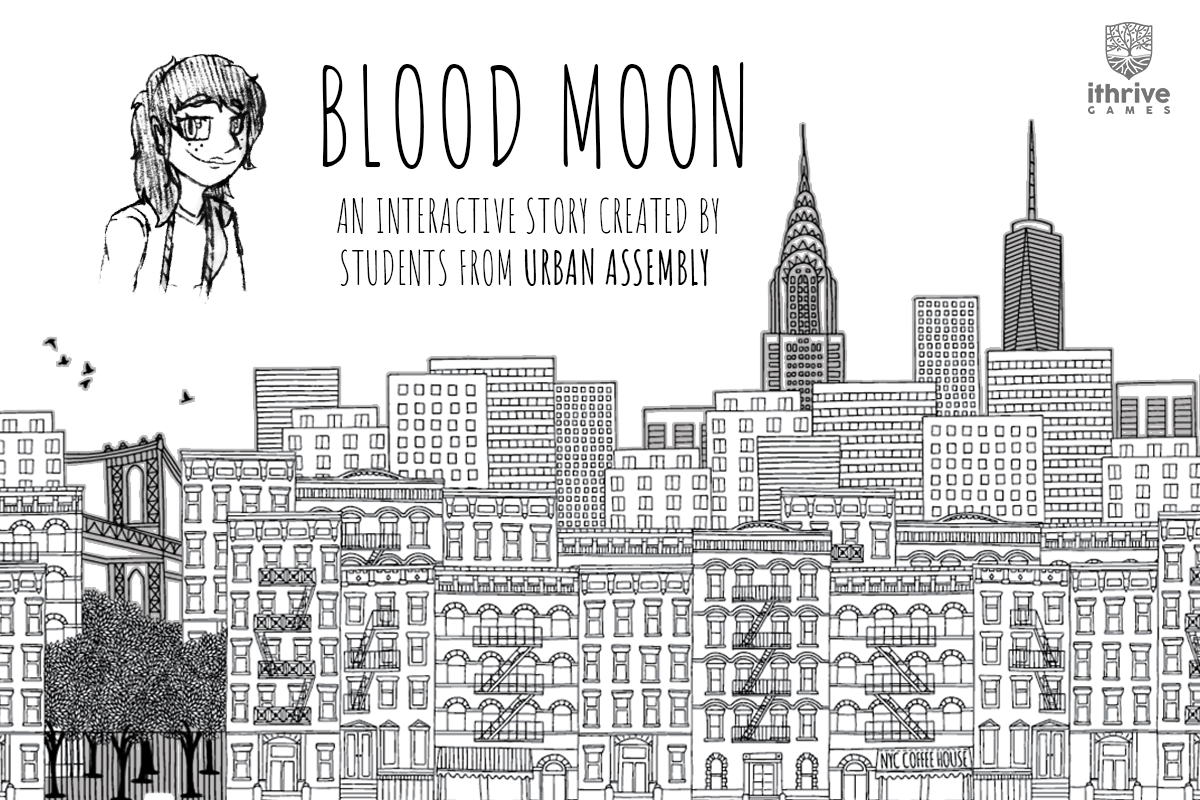
This spring, a cohort of high school students from Urban Assembly joined iThrive staff online for a design thinking and social and emotional learning co-design experience. The virtual Game Design Studio engaged teens in self-reflection, creativity, and systems thinking using the framework of game design. Over the course of six sessions, the students brainstormed ideas for a game that would share the perspective of teens living through the COVID-19 pandemic.
The end result was an interactive story game called Blood Moon. Choose your own adventure and play the game here. The main character is Brooklyn teen Artemis, who wakes up from a long nap during the COVID-19 shelter-in-place orders. Her parents, hospital workers across town in Manhattan, should have returned from their shift by now. Where are they? Artemis must strike out of quarantine and into the streets of New York in search of her parents. Along the way she encounters helpers on her journey, runs into trouble both with the law and the locals, and even meets a super-sleuth delivery dog named Issac who won't leave her side until she is safely reunited with her family.
In order to track down her missing parents she will have to use all the tools in her social and emotional toolbox—she'll need self-management and self-awareness to keep herself strong, while her social awareness, relationship skills, and responsible decision-making will help her make connections and collaborate to solve the mystery.
Art Imitates Life
Early on in the development of this interactive story, the students wanted to create characters that reflected their world. There's Artemis, Ari for short, brave, and bold like the hunter for which she is named. This young Latinx powerhouse has a huge heart and the power of empathy, turning connections into relationships when she can, and setting healthy boundaries when she needs to.
Ari meets Issac, a dog just as scrappy as she is. As a delivery dog for DoggoPrime, Issac knows how to get around the city, and he has a few tricks—and treats—tucked away in his knapsack to keep himself and Artemis on the trail of finding a family. He might just find a new family, too.
There's also Apollo, Ari's brother, who is the leader of the pack in their neighborhood and is just as bold as his sister. But while Ari looks for Mom and Dad, Apollo has a different journey to keep the city safe. He'll just have to keep everyone from thinking he is on the wrong side, including his sister Ari and that little mutt following her everywhere.
Other characters featured in the interactive story include Frank, the owner of a hot dog kiosk near the train station, who has seen it all, and knows Ari and Apollo are in more trouble than they know; Laura, Frank's sister, who is a master procurer who may or may not be able to help Ari find her parents but doesn't intend to stop trying; Captain Max, an officer who is here to make sure everyone shelters in place, but is starting to wonder if he is on the right side, or if he is quarantined from the truth; and Timmy, who lost his mind to COVID, is looking for family, and believes that helping Ari find her parents can help him back to himself.
Game Mechanics
Blood Moon is a branching narrative Twine game that can be played alone or with a group. The Urban Assembly students, who met via Zoom, wanted to create a game that teens could play by reading the interactive story together in Twine and then talking through the best ways for Artemis to make her way across the city by drawing on her social and emotional skills.
Students can debate Artemis' choices, and think about the ways that they use social and emotional skills in their own lives with friends and family. Blood Moon is text based and includes prompts for discussion, asking young people to talk about each of the social and emotional skills and learning.
Social and Emotional Learning
The interactive story applies social and emotional skills to the troubles teens face maintaining relationships during COVID, navigating family ties in stressful times, and managing the social upheaval of this year. Talking together provides teens with space to learn together and to practice the tools that will help save Artemis. In practicing those tools, the social and emotional skills are there for them when the game is over.
Visit the For Teens, By Teens page of our website to check out this interactive story game and other games created during iThrive's game design sessions with teens.
This work was supported through generous funding from the William T. Grant Foundation and the D.N. Batten Foundation.
Three Reasons Embedded Social and Emotional Learning Works
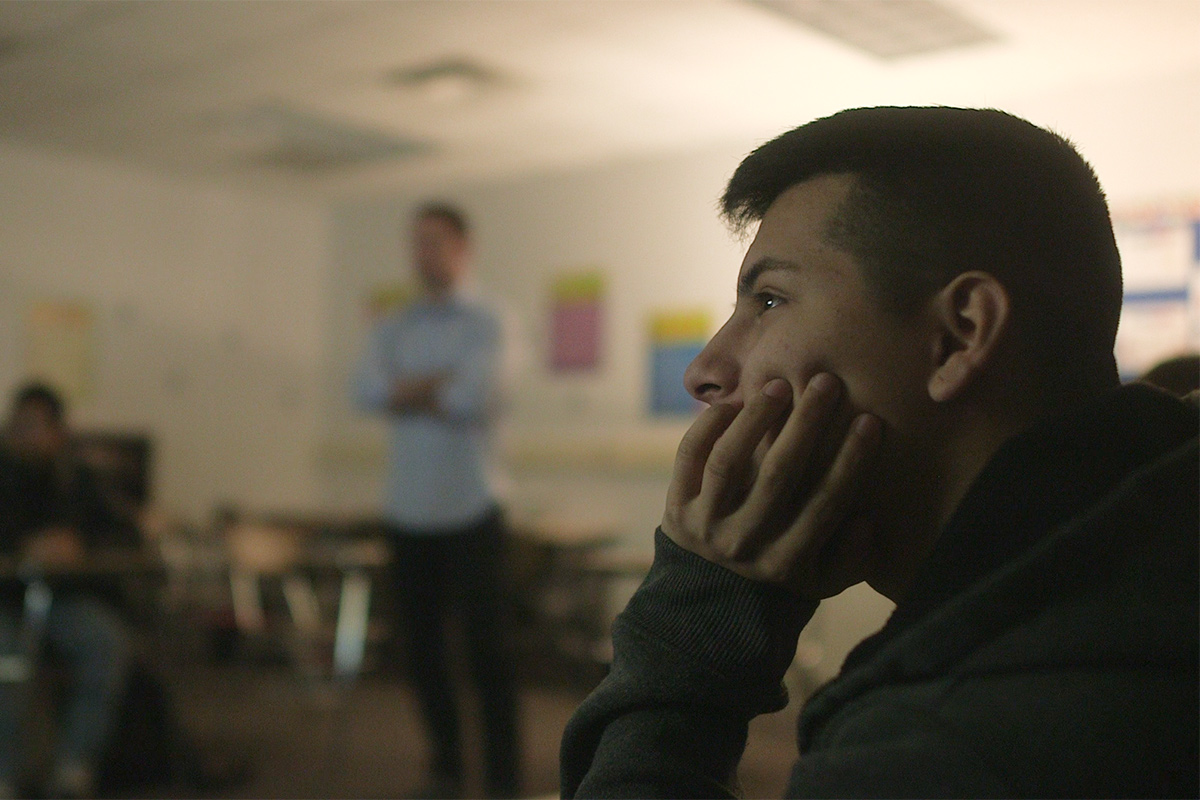
Social and emotional learning (SEL) works exceptionally well when embedded in an academic context. This has informed our approach at iThrive and has been reinforced by feedback from the educators and students that we have served.
Teens benefit from classroom settings that embed the five competencies of social and emotional learning: self-awareness, self-management, social awareness, relationship skills, and responsible decision-making.
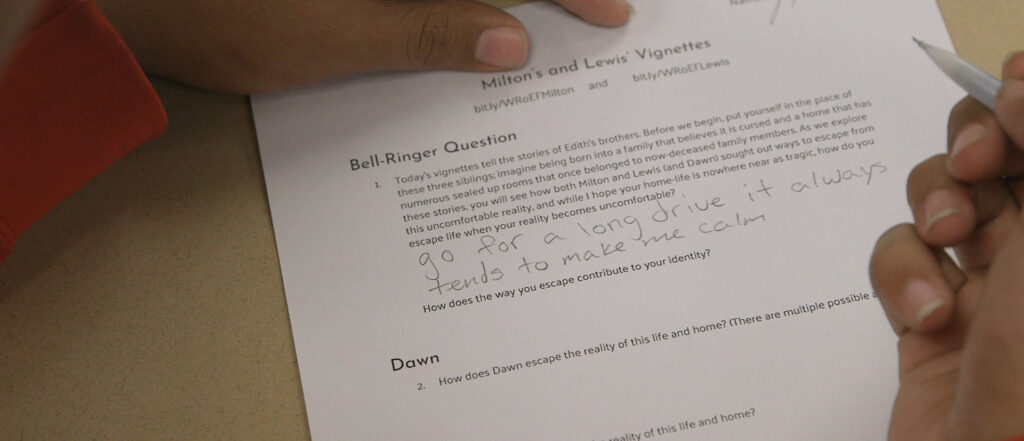
A snapshot of an in-class assignment included in iThrive Curriculum: Museum of Me, a game-based, social and emotional learning curriculum for high school English classrooms.
Our tools—game-based curricular units, role-playing simulations, and game design studio—embed opportunities for SEL not only because there is ample science to support SEL's critical role in present and future well-being and success, but because it helps teens experience how social and emotional skills and perspectives are relevant to all subjects and aspects of life.
Why should you consider bringing tools that embed social and emotional learning into your classroom? Here are our top three reasons:
1. The SEL frame provides a solid scaffold for academic content. Whether educators are discussing self-awareness, self-management, and relationship skills in the context of characters and their decisions in an English Language Arts class, or social awareness and responsible decision-making in a civics course, social and emotional competencies have a natural alignment with core academic content.
2. Students find SEL more relevant when embedded in the context of what they are learning. Students who have experienced our game-based learning units in their humanities classes have said that the types of discussions they've had in class are like no other in terms of making them think about identity, relationships, and communication. The meaningful conversations in class have stood out for them as highlights of their classroom experience.
3. Educators are more likely to employ SEL when they don't see it as an "add-on." Educators find that SEL can be even more relevant and meaningful when it's woven into how they teach core content. The inclusion of social and emotional learning within content that meets academic standards raises the profile from that of a "soft skill" to an educational priority.
Ready to try it in your class? Consider bringing embedded SEL into your virtual or in-person classroom today. Contact us to learn more about our curricular units and role-playing simulations.
Announcing New Game-Based Unit Created for Distance Learning
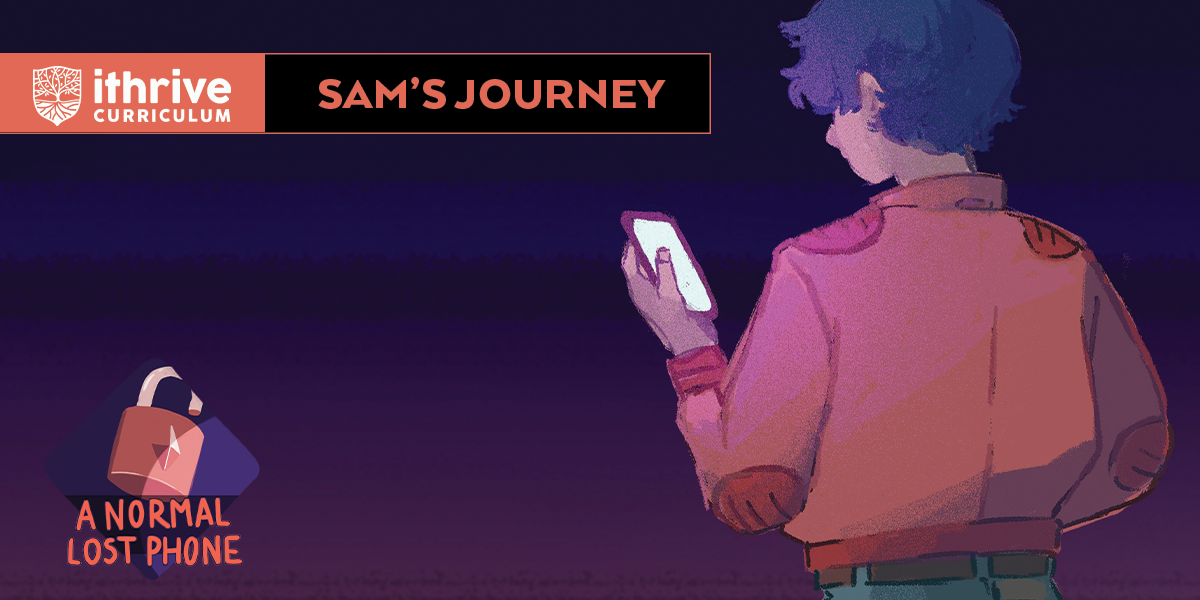
We know that now, more than ever, teachers need tools that support distance learning and encourage engagement and connection. iThrive Curriculum: Sam's Journey, a game-based social and emotional learning unit for high school humanities classes, responds to this need and is now available.
We are so happy to announce the release of iThrive Curriculum: Sam's Journey. Teachers who want to have engaging online sessions with students will enjoy this rich, concise unit. The game-based unit is designed for distance learning and can be used with 11th and 12th-grade students to explore self-expression and communication in relationships through the lens of digital and non-linear narratives.
Using the game A Normal Lost Phone, developed by Accidental Queens, as a text, students will undertake a narrative investigation, piecing together what happened to the game's main character, Sam. At the same time, they will encounter rich opportunities to reflect on and discuss how they express their identity in their own relationships using contemporary communication tools.
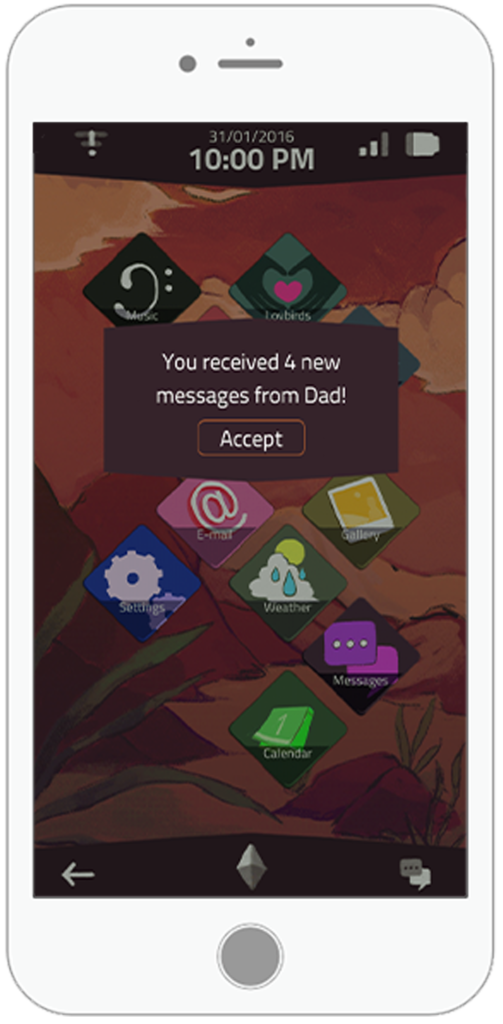
The three-lesson unit meets English Language Arts standards and social and emotional learning goals and is ideal for distance learning. It includes activities, discussion prompts, homework assignments that encourage self-reflection, and grading rubrics. The unit was created in collaboration with Jennifer Guerin, Kathleen Moore, Sophie Rich, Julia Wareham, and Jordana Weiner, students from the Harvard Graduate School of Education.
Dr. Gabrielle Rappolt-Schlichtmann, Kristin Robinson, Dr. Paul Darvasi, Dr. Shawn Clybor, and high school students from Dwight-Englewood School also made important contributions.
We look forward to sharing Sam's Journey with educators who are looking to close out this school year or enrich next year with a short game-based unit that will capture their students' imaginations. Contact us at contact@ithrivegames.org to receive a copy of the unit.
To stay updated with our latest game-based learning tools for high school classrooms and resources for distance learning, subscribe to our monthly newsletter here.
How Game-Based Learning Can Take Your Class to New Heights
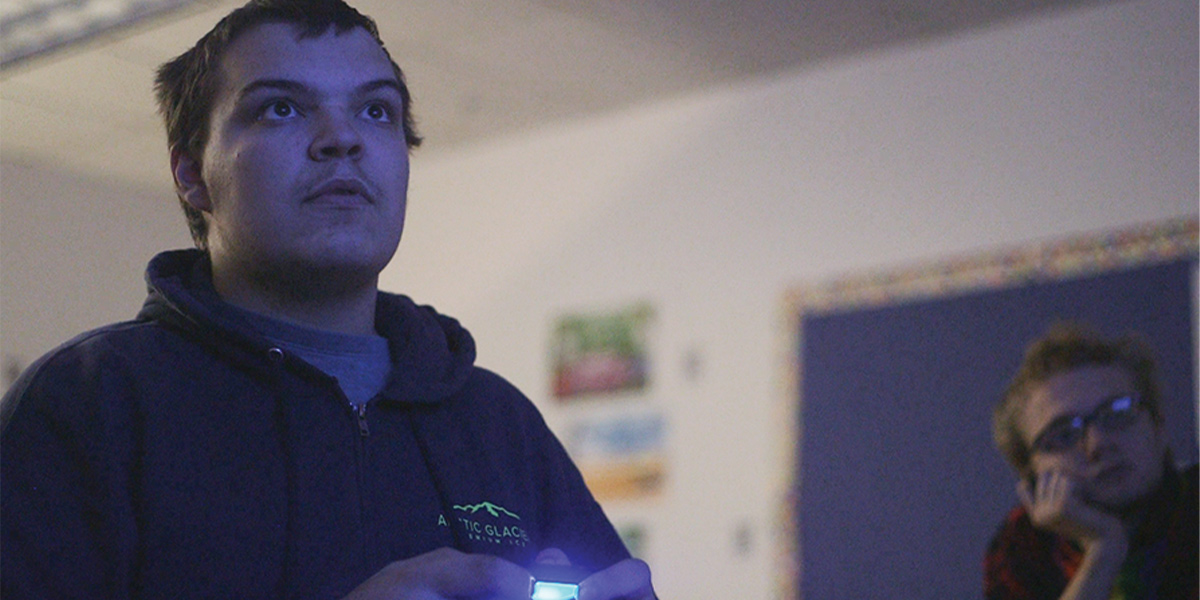
Our game-based learning units were designed to boost engagement and invite creativity in the classroom, virtually and in-person. Here's how integrating games in your classroom can take student learning to new heights.
This moment poses the opportunity to reimagine education. At iThrive Games Foundation, we partner with educators to create new possibilities for learning, whether that's in a physical classroom or a virtual space as we navigate COVID-19. We are inspired by educators who are finding ways to work games into their curriculum, affording students the opportunity to find relevance, engagement, and meaningful connection in their learning.
To help educators offer the best possible learning experiences, we create game-based curricular units that weave together the three things we care about the most: teen thriving, the power of play to support that thriving, and rich opportunities for social and emotional learning.
Deepen engagement in your learning environment through these five elements of our approach to game-based learning:
1. Impactful play: By designing school lessons around video games-a medium that teens are already interested in-we drive innovative thinking and meaningful connection by inviting teens to explore who they are and the world around them in a low-stakes but thought-provoking environment.
2. Deep learning: Many games present opportunities for students to interact with narrative in a completely new way, opening their minds to the storytelling techniques and opportunities all around them in today's digital communication landscape. We design our units around games with rich and creative narratives to invite teens to access texts in new and inspiring ways and to stoke a love of learning.
3. Personal transformation and growth: Games can transport teens to new worlds, enabling their exploration of new places and possibly, new versions of themselves. Curricular units that use games as a text can support students in writing about and reflecting on these explorations.
4. Social and emotional skills: Games stand apart from other media because players of games have agency — and even complicity — in the stories games tell. Since games can provoke feelings of frustration, pride, guilt, elation, forgiveness, and more, they're an incredible tool for supporting teens' social and emotional development.
5. Universal design for learning: Games are an excellent tool for engaging students who are left behind in the classroom due to issues of engagement or accessibility in more traditional learning approaches. Principles of universal design for learning also inform the activities and assessments that comprise our game-based lessons, acknowledging that each teen develops differently and engages with concepts from different access points.
Interested in integrating games in your virtual classroom? Check out our library of game-based learning units and download them at no cost here.
Three Ways to Prepare a Supportive Online or Remote Environment
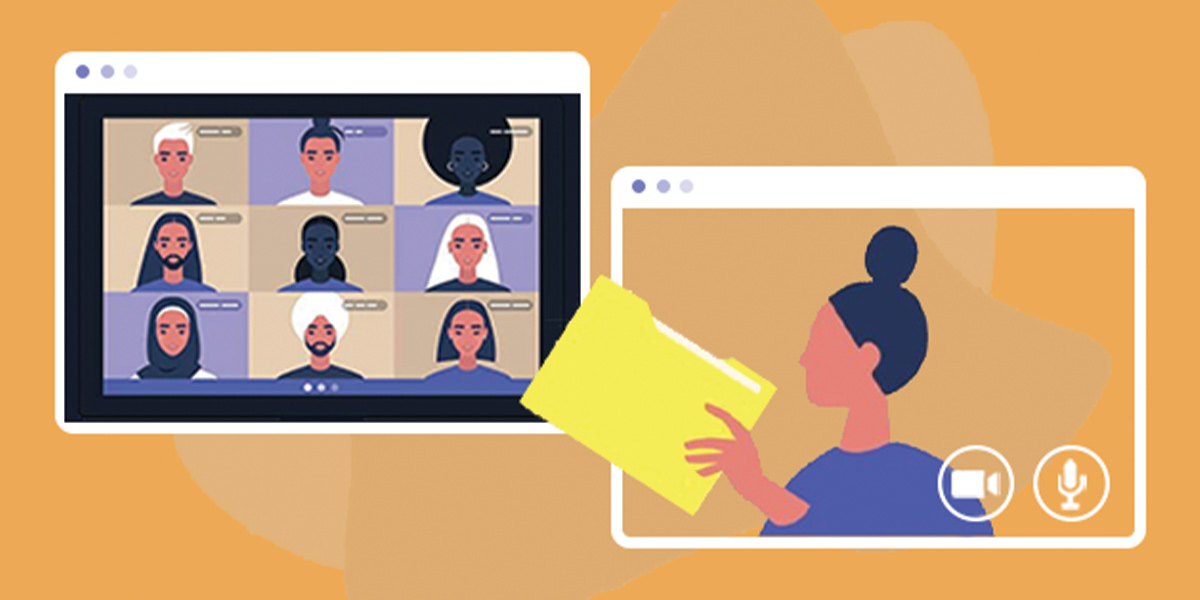
As in-person classrooms shift to virtual spaces like Zoom, we're experimenting with how to support closeness and authentic teen engagement in a remote learning environment. Here's a glimpse at what we've learned so far.
Whether you're in virtual spaces with teens or in person, creating and holding a supportive space is key to generating a sense of safety and promoting engagement and authenticity.
If you're an educator, by now, you've probably forayed into the world of remote learning, and perhaps you're feeling a little shaken by slow progress, chaos, reluctant participation, Zoombombing, or (hopefully not!) all of those things.
At iThrive, holding space for authentic teen engagement is integral to each of our initiatives, whether it's playtesting a new educational simulation, piloting a game-based learning curriculum, or hosting Game Design Studio. As so many educational outreach efforts move online, we're experimenting with how to support closeness and authenticity in this new format.
There are a few things we know to be true about creating a warm, supportive environment in person, and we are translating these into the virtual spaces we're in. We believe these elements are going to be key to successfully holding space in these formats. As we go through our own process of trial and error, we'll be reflecting on how these informed hunches play out. To connect authentically with teens, we are finding that it takes tending to your inner world, tending to your relationships, and tending to the space itself.
1. Show up for yourself before showing up on screen.
We can't stress enough the critical importance of educators' self-care. We have found that you can't show up in authentic connection without attending to your own emotions first. Your emotional state sets the tone for your students. So, how are you doing? Do you feel ready to hold space for your students? If not, what do you need to do in the 20 minutes before the call to be ready? Take time to attend to yourself before initiating a remote learning environment so you can show up from a place of calm and presence. And, if you are grappling with your own difficult emotions, let that center you in a place of empathy and vulnerability so you can make space for students who may be confronting their own.
Here are some ideas that can support you in doing this:
- Try this five-minute writing exercise called Clearing the Pipes — one of many ways to attend to emotions in a way that helps free up your attention for the present moment.
- Set a timer for one minute, close your eyes, and just breathe, making time to notice how you're feeling.
- Take out a piece of paper and free-write for a minute, letting yourself write or draw whatever thoughts or emotions cross your mind.
2. Interrupt and remake virtual norms.
How do you create more closeness in a remote learning environment? Zoom and similar video conferencing services were used primarily (until now) for professional interactions, so they can transmit a "buttoned-up" ethos. We need to think outside the Zoom box to help increase connection. Consider inviting teens to break out of the headshot format by introducing opportunities to stand or move. Allow people to share their environment as they see fit, deciding how much to reveal and share of themselves and their home life. Or, get rid of talking head video chats by using Zoom to share a homemade video where participants show learning in fun, accessible ways. For example, you could try incorporating media ideas from popular social media challenges, such as the #DontRush Challenge used to help students transform into literary characters or historical figures.
Also, keep in mind that Zoom can feel exhausting. The pressure to show up polished on video when we may be feeling less than camera-ready is affecting both youth and adults. Issues of identity around race, class, and gender also affect students' willingness to participate in video classes. Consider video calls without the video, where people can use memes, baby photos, or even a photo of the day as their avatar, creating a visual representation without the pressure to look okay on Zoom when we may be feeling anything but okay. Whatever new norms you decide on, make sure that teens are co-creators of the shared space.
Here are some ideas that can support you in doing this:
- Consider a camera-off option for your call to ward off Zoom fatigue.
- In your check-in, invite students to move; it can help create a more informal and relaxed space for connection.
- Invite students to contribute to group norms by sharing their ideas.
3. Prioritize the space before the content.
Research into computer-mediated communication shows that more time is needed to reach the same level of connection attained in an in-person setting. Time is key to growing student engagement in remote learning. It can be uncomfortable to feel you're slowing the pace of learning by remaking norms and attending to feelings, but the truth is that intentionally leaving spaciousness for emotional connection supercharges learning. By slowing down and authentically connecting before pushing forward on content, you're sending the signal that the space you're co-creating is a safe one in which to share, question, be vulnerable, and make mistakes — all vital components of the learning process. Trust that by seemingly slowing down now to reset the space, you're guaranteeing better engagement. Since video interactions can fatigue our brains in ways in-person ones do not, a general rule of thumb is to take what you had planned for in-person engagement and to cut it by half; that will get you closer to what's realistic to accomplish in a remote learning environment.
Here are some ideas that can support you in doing this:
- Leave space for silence.
- Think 'less is more' for your online lessons.
- Allow the time together to be spacious.
We're here alongside educators, trying to not just survive this time but to create new and fresh ways of connecting that can enrich our interactions with teens now and for the future. We commit to sharing what we learn as we experiment, so please, stay tuned and stay connected.
Staying Connected While Social Distancing: Working from Home Edition
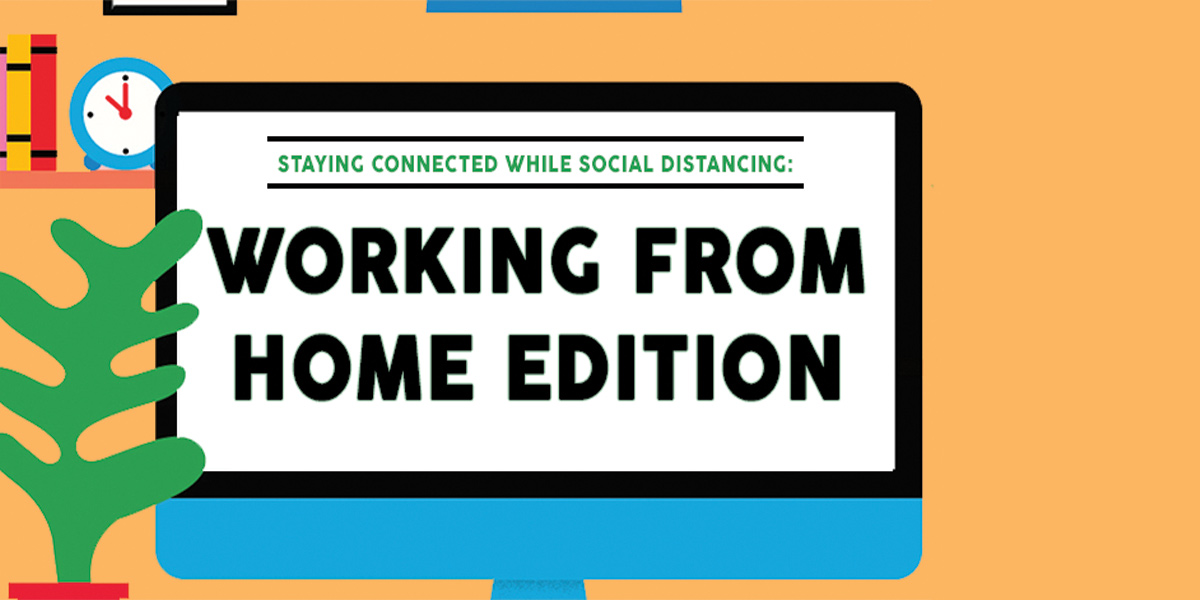
iThrive Games Foundation is a remote office nonprofit, so working from home is not new for us. But working from home during a pandemic is new for everyone across the globe. Whether you're new to this or are a seasoned remote worker, the circumstances have changed. Most organizations are exploring how to be of service in our new reality. Many of our staff have children and other family members at home, which adds another dimension to work. And the psychological impact of finding a new normal during a pandemic in which we are asked to stay at home can't be denied.
We thought we would share some of the ways we are supporting one another at iThrive as we continue our work from home amongst these challenges.
- Make time to play games together. We use games while working from home to have a shared experience, enjoy a laugh, and spur our creativity. Our marketing manager taught us the Song Association Game and we laughed so much during our team meeting while we played it over Zoom. Your turn: Call your friends on Zoom. Make a list of words together. Access an online counter. Share your screen so everyone can see the timer, which you'll set at ten seconds. Assign the first person you can see on your screen a word you randomly choose from the list. Once you say the word, they have 10 seconds to sing either the title or lyric of a song that uses that word. Go around until everyone has a turn.
- Have check-in calls that are not status calls. Check-in calls while working from home allow us to connect as people. We begin with some guided meditation or movement to get present with one another. We share our work and non-work challenges and triumphs. We hold space for those on the team that need it. We share resources from our own personal toolkits for coping, such as gratitude journals and yoga classes over Zoom. Having that space frees up mental energy and allows us to proceed with clearer minds.
- Trust one another and be generous. Everyone is going through something, whether it's related to this coronavirus pandemic or life just happening. The work will get done. We trust one another to meet our deliverables or to ask for help if we need it. Generosity of heart is how we'll get through this.
How are you working from home and faring during these times? We have resources for support, such as our media literacy tips, conversation starters to help you connect with the video game players in your life while social distancing, and bite-sized activities that help with social and emotional skill-building. We hope you are finding ways to stay healthy and support one another as we all do our part to flatten the curve.
COVID Self-Care Package: Practicing #SELatHome
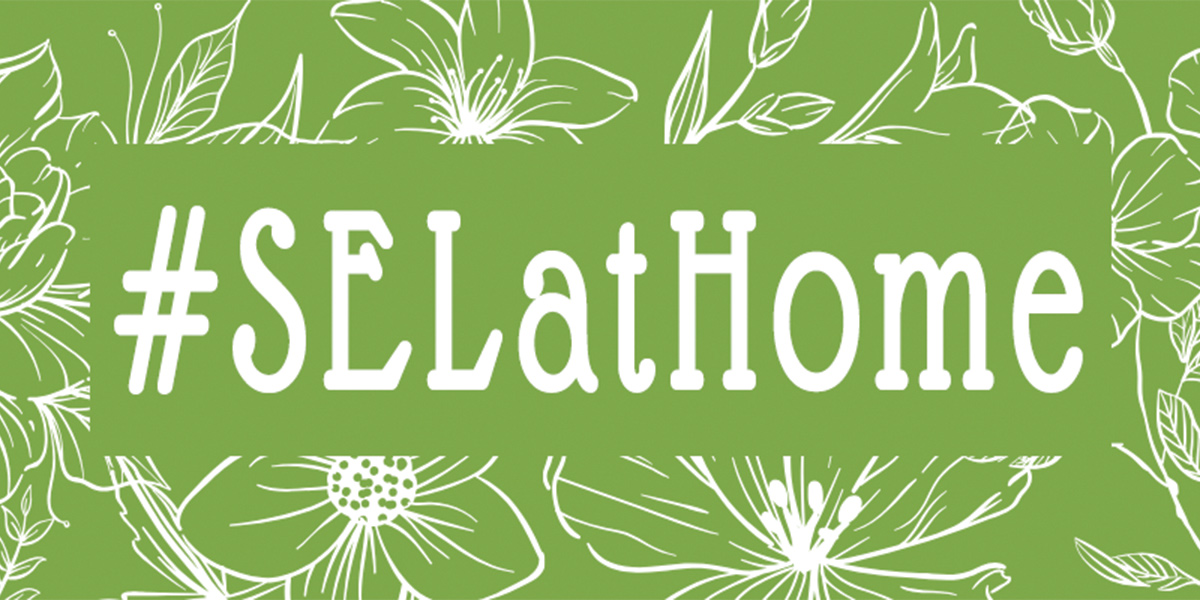
As we talk to the teens, teachers, and parents in our lives about how they are faring during COVID-19, we hear a consistent call for resources for coping. However, they don't talk to us about getting assignments completed or meeting deadlines, they talk to us about dealing with anxiety or restlessness, feeling easily frustrated, and managing conflict as everyone navigates this time together at home. Social and emotional skills, which are like our inner superpowers, can be supportive of these concerns. Below are the five core social and emotional skills, as defined by Collaborative for Academic, Social, and Emotional Learning (CASEL):
At iThrive, social and emotional learning (SEL), teen thriving, and gameplay are important to us. We thought we would support teens, teachers, and parents by creating the #SELathome challenge. Let's take the next 14 days to add some social and emotional skill-building to our lives. We thought we would make it easy to do, fun, and bite-sized, since our goal is to help rather than to add yet another thing to do.
So like us on Facebook, and follow us on Twitter and Instagram at @iThriveGames to join in on the 14-Day #SELatHome Challenge and play. Starting Tuesday, April 21st, we'll be posting a challenge a day on our social media channels. We'll also DM whoever plays the most to find out where to send some iThrive Games' swag. We can't wait to get a glimpse of your comments and the tips that you'll share!
Subscribe to our monthly newsletter here for free, downloadable SEL resources and updates on our game-based products!
Expanding Our Vision for Civics Education: iThrive Sim Intersects Play, Civics, & Social and Emotional Learning
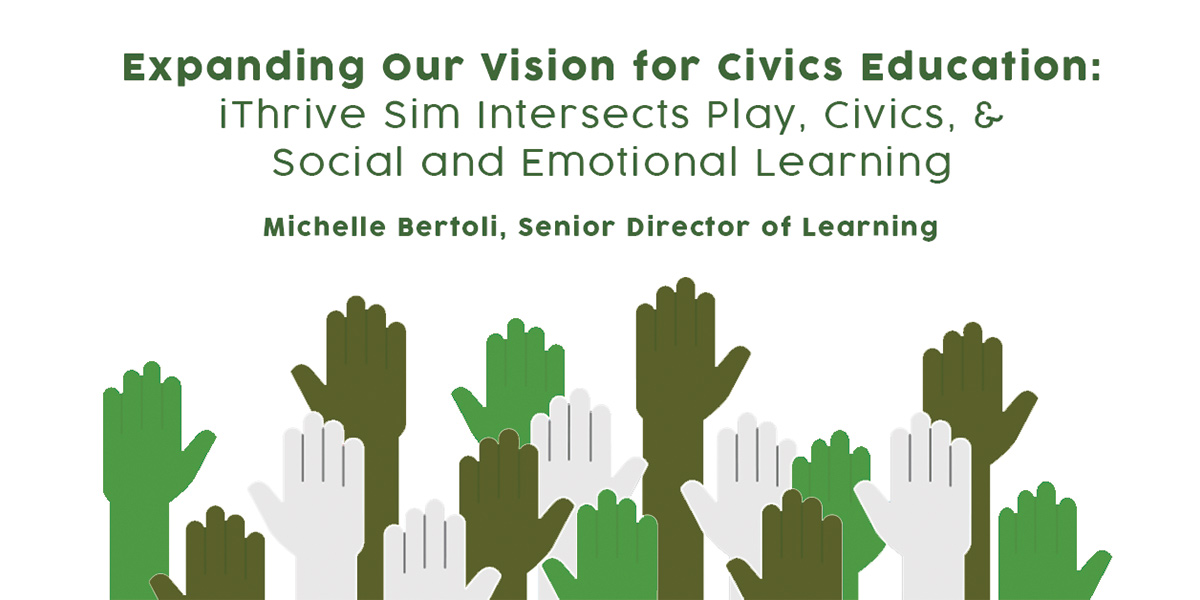
Research has shown that engagement with civics has benefits for individuals and communities as a whole. Yet countless column inches have been used to decry the current state of civics education. Concurrently, high school students across the country are asking "Why should I care?"
Teachers know that the secret sauce in any great civics course is to create the conditions to help young people answer for themselves the question of why they should care and provide them with the tools to effectively and constructively engage.
But how do we inspire teens to engage? What would that look like? Do we have a practice ground? And even when students have information available to them, what tools have we given them to discern whether that information is fact or fake news?
iThrive Games Foundation and the Ronald Reagan Presidential Library and Museum have partnered to create iThrive Sim: Constitutional Crisis, a live-action role-playing game that can be used in place of traditional civics teaching methods. The game, which is based on the Situation Room Experience, allows participants to play unique roles, which creates an experience of immersion in the scenario from a specific perspective. As players move through the scenario, they draw on social and emotional skills while they make decisions, demonstrate critical thinking, absorb information, navigate complex ethical landscapes, and communicate with peers.
This mixture of gameplay, civics, and social and emotional learning is highly engaging to students. Here's how:
- Gameplay: A critical component of iThrive Sim: Constitutional Crisis is embodied, experiential learning. By engaging in a simulation, teens don't just imagine or talk about making decisions under pressure, they experience it. Look at the face of any teen playing an intense video game: the tension is real, even though the stakes are fictional. In iThrive Sim: Constitutional Crisis, teachers see their students practice regulating their emotions, collaborating with others, exercising curiosity, and weighing competing priorities as they make difficult decisions. Students put into practice the social and emotional skills essential for civic engagement: self-awareness, empathy, collaboration, curiosity, and courage.
- Civics: Through iThrive Sim: Constitutional Crisis, students begin to perceive themselves as decision-makers here and now, with the power to impact those around them. They don't have to wait to "be a decision-maker;" they already are. Their actions and decisions, even before they can vote, help to create the communities of which we're all a part. NOT acting is still taking action. What's more, iThrive Sim: Constitutional Crisis provides a memorable shared experience for students to revisit as a frame of reference to scaffold future knowledge.
- Social and emotional learning: At its heart, democracy is about decision-making. The role of a member of the public in our democracy requires choosing to combat bias to build empathy for the experience of fellow human beings, building self-efficacy to combat apathy, and daring to make complex decisions with consequences for individual liberty and the larger social good. By acknowledging and highlighting the social and emotional skills inherent to responsible citizenship, we seek to engage students not just by supporting their understanding of the mechanics of government, but of themselves, their identities, values, and communities. We seek to provide students tools to engage with constructive decision-making techniques and to reflect deeply on how their decision-making affects others. Rather than telling them what is important to them, we engage students in considering these questions for themselves so that they are capable of translating their values into action.
At the heart of this unit is the acknowledgment that the decisions we make as individuals have ripple effects in our families, our communities, our democracy. Students who engage in iThrive Sim: Constitutional Crisis see the impact of those decisions and have the opportunity to learn from them as they consider how to fully engage as young citizens in a democracy they are shaping and will continue to reshape throughout their lives as decision-makers.
To learn more or to pilot iThrive Sim: Constitutional Crisis, email us at contact@ithrivegames.org.
Super Mario Maker 2: No Limits
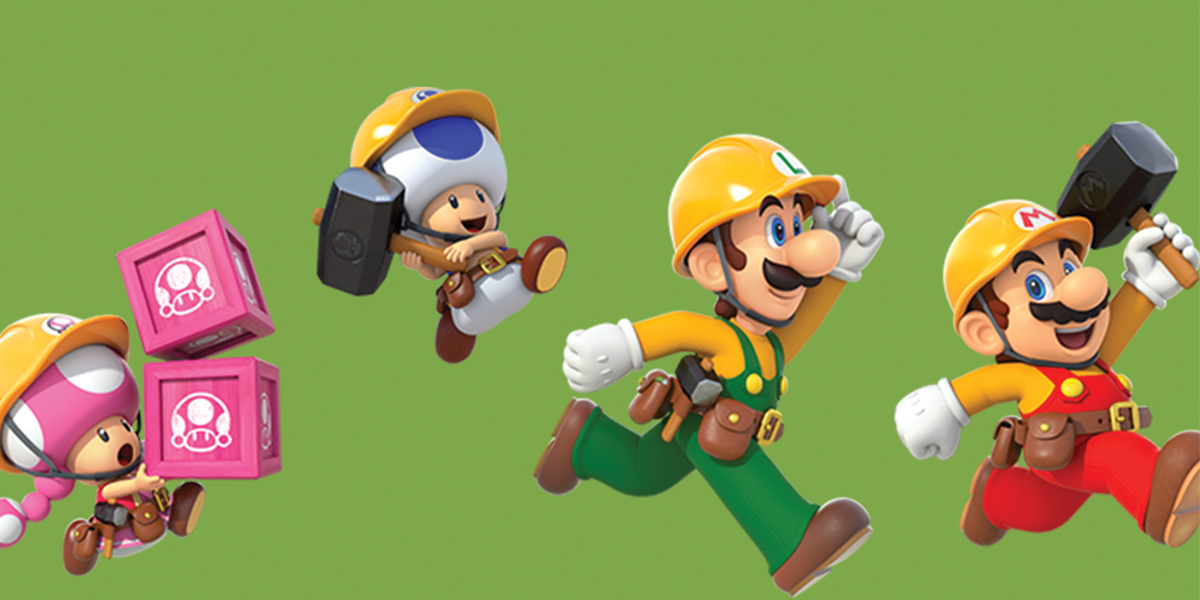
Late last June, the sequel to the beloved Super Mario Maker for the Wii U was released, bringing players back into a vast playground to fulfill their game design dreams. Taking inspiration from the story mode and other player's creations, players set their minds to crafting levels that suit their wildest dreams and astound those who would wish to participate.
While I was unable to play the first game, I was relatively familiar with the system because I spent quite some time watching playthroughs when it first came out. I was in awe of the innovating level design so when the second version came out, I wanted to play and maybe even create something myself someday. Surrounded by brilliant creations, my personal journey into this realm was preceded by a vague hope of creating levels that were just as perfect and fun as those done by the best. Soon enough, I clicked in the Super Mario Maker 2 cartridge and booted up the maker.
I was not the best.
I assumed my first levels wouldn't be the greatest, but I didn't realize just how difficult it was to grasp concepts that seemed intuitive to my peers. I was convinced that I could immediately jump in with mega cohesive levels that taught the player as they went and left them challenged but not cheated. However, all I was left with was a blank canvas, the saccharine blue sky taunting me from the other side of the screen.
After two days, all I did was erase and replace; erase and replace. How could I put anything out there if it's not the best I can do? Every choice was followed by me questioning if it was cheatable or too hard or too easy, and I couldn't bring myself to test it on others for fear of showing my work.
I was not the best at looking at the situation clearly.
After wallowing in my own perceived insufficiencies, I caught wind that one of the many Super Mario Maker 2 level creators crafted a stage based off of Touhou, a bullet hell game which while complex and hard to design, is structurally very different from a Mario game. It didn't fit the mold that I was forcing myself to conform to, but it was an incredible feat of effort. It was then that I realized I may have been missing the point.
Super Mario Maker isn't about making the best level, it's about making your best level and improving your own game design skills over time. I had lost sight of what the freedom of Super Mario Maker meant, which was to design as you pleased. No one's first level will turn out perfect, and if it's not from your own imagination, then what's the point?
Eventually, I booted up the game again, discovered you could take Lakitus off of their clouds and burnt an hour making something I enjoyed making. Messing around by flying across the screen just felt right at the time, so I tried to make something that would let me do that many times. Was it perfect? No. Was it good? Probably. But now I think I'm ready to give it to someone for comment so I can learn from my mistakes and use them to make the next level that much better.

Eleanor Mather is a 17-year-old high school senior at Horace Mann High School in Bronx, New York. She has enjoyed playing games since playing Pokémon Platinum with her brother and friends and has grown to love discussing and developing them in the past years. She is very excited to contribute her thoughts to the conversation on games as a medium and hopes to encourage others to join in.
This year at SXSW Edu in Austin, Texas, we'll be presenting a panel discussion entitled, Teens as Changemakers: SEL Through Game Design, where we'll share insights on the social and emotional learning opportunities that games and game design offer for teens. To learn more about the power of constructionist games like Super Mario Maker 2, check out this blog post written by our SXSW Edu co-presenter Matthew Farber.
Constructing Worlds: Where Games, Making, and Meaning Meet
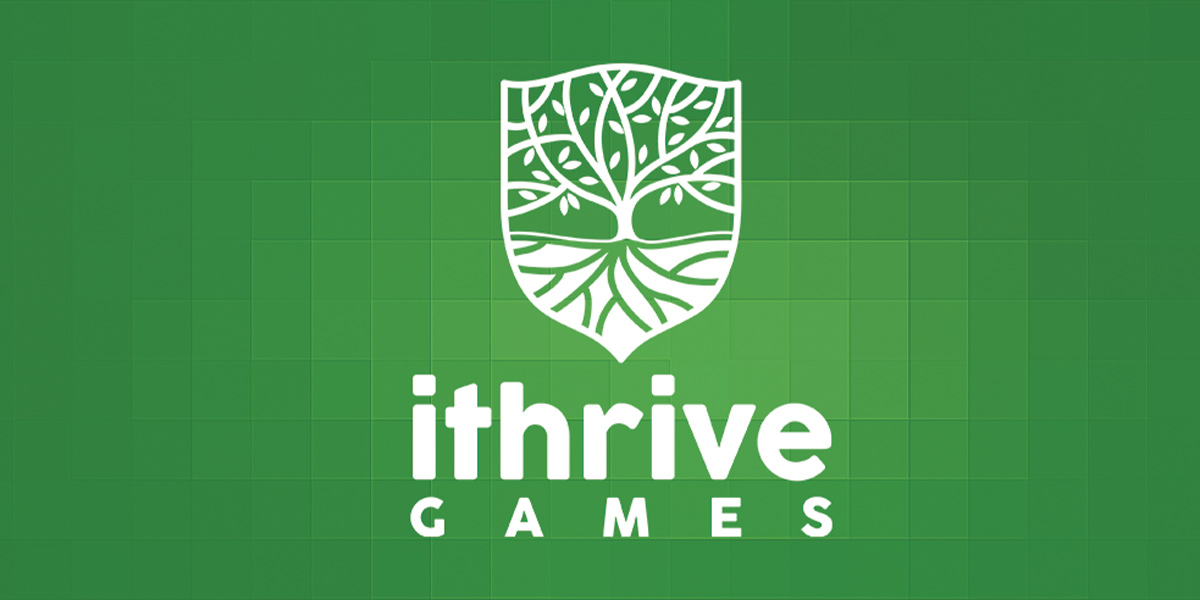
Matthew Farber, our co-presenter at SXSW EDU this year, shares on the power and potential of game design and constructionist gaming in the classroom.
As I reflected on the upcoming session on game design that iThrive staff and I are presenting at SXSW Edu in March, I was reminded of my son. This holiday season, Santa brought my 9-year-old son (and me!) Mario Maker 2 for Nintendo Switch. A twist on the famous side-scrolling platform game that dates back decades, in this version, players can design and play their own Super Mario Bros. levels. The game includes playable game courses as well as a toolkit with blocks, enemies, power-ups, and other game elements that can be added to a grid, played, and also shared online.
Interestingly, my son was already familiar with the game, including some hidden Easter eggs (one including playing as Link from the classic Legend of Zelda series!). I discovered that my son was already in an ecosystem of youth game design, one of his interests. He has designed game levels in the iPad game Geometry Dash, as well as in Minecraft's Creative Mode, and with Scratch. Regarding Mario Maker 2, he came to the game already viewing levels designed, shared, and played by YouTube Kids' star Stampy Cat. Stampy Cat's YouTube channel, stampylonghead, is kid-friendly and has 9.26 million subscribers. Super Mario Maker 2 - Showing My Courses has been viewed (as of this writing) 882,169 times, so there are many other young people engaging in similar play habits.
Watching my son construct worlds in this way reinforced my thinking about the social and emotional learning opportunities that game design presents, which we'll discuss during our SXSW Edu session.
Constructionist Gaming
This cycle of playing, making, reflecting, and sharing games is known as constructionist gaming. Described in a paper of the same name, and later in the book Connected Gaming: What Making Video Games Can Teach Us About Learning and Literacy, Yasmin Kafai and Quinn Burke build upon and extend James Paul Gee's learning principles about playing good games (i.e., games are a series of well-ordered problems) to constructionist notions posited by educator Seymour Papert.
Papert's ideas undergird the maker movement as well as project-based learning as a pedagogical approach to deeper learning in, and outside, of classrooms. Papert believed that children learn by teaching (or programming computers). This flipped the traditional paradigm of computers-as-teachers, what B.F. Skinner called Teaching Machines. Papert wrote that children learn through cycles of making personally meaningful artifacts.
This led me to wonder, what about games that are not like the aforementioned games, with level editors and creative modes?
Constructionism + Gaming
In my research, some teachers who use games in their instruction, use them as models for experiential learning. Then they have students draw on those experiences to build their own games. They may also have students design projects that are not games.
This is important because this approach exemplifies good pedagogy: do not assume games are all-in-one silver bullet solutions. Whereas good educational games balance learning goals with player actions, they may tend to be teaching machines. Good educational games may also be task-centered; when the player performs well on one task, they are rewarded with a more complex challenge.
Good commercial games are different, in that they are designed to evoke emotions from players. When I play a cooperative board game like Pandemic, the game's rules and components create a system that makes us want to collaborate with others. The popular game Untitled Goose Game (my son and I also play on Switch!) evokes humor from players by role-playing as a subversive (and awful goose).
Why Does This Matter?
So, why is any of this important for students, educators, and those who interact with youth?
As mentioned, good games can evoke players to be creative thinkers and critical thinkers. However, good learning should also involve students making and sharing something personally meaningful to them, whether that is a game or otherwise. In my classroom, I have students play one round of the charades game Heads Up, and then give them project-based learning time to build their own decks of cards. In other words, add Creative Mode to all games — and all experiences for that matter. If a child hears a podcast in class, they can then use digital tools to author and share their own.
In summer 2019, with iThrive Games, we ran Game Design Studio to do just that. Youth played many different genres and subgenres of games, both digital and analog. They used these games as mentor texts, not unlike reading poetry and then referring to poems when writing your own. To learn more about this approach, check out our session at SXSW EDU on March 9th: Teens as Changemakers: SEL [social emotional learning] Through Game Design.
Evolving Our Mission and Vision

As 2020 launches, I feel inspired, invigorated, and ready for the year to come. Upon reflecting deeply this last year with our team, collaborators, and thought partners who are all committed to advocating and supporting the adoption of game-based learning products, we have evolved our mission and vision.
This evolution came out of a set of experiences that left me asking the question, "What is ours to do?" Designing meaningful game-based learning experiences with and for teens is the heart of iThrive. Our strengths are in understanding and being genuinely curious about the teen brain, knowing the deep importance of social and emotional skills, and valuing play for connecting and learning.
About nine months ago, we launched the development of our CIassroom Experience, an immersive game-based curriculum where students play critical roles during a constitutional crisis, from government officials to reporters, residents to law enforcement personnel. In the Classroom Experience, students apply and extend their learning of civics through the lens of decision-making, building their social and emotional skills and grappling with information and how to apply and interpret the US Constitution. I saw high school students lose their sense of time as they grappled with uncertainty, negotiated difficult decisions, and expanded their understanding of the constitution, media literacy, and civic engagement. Seeing teens deeply engaged in game-based learning-when it's relevant to their lives and designed to meet them where they are-is impactful. I realized that our method of using games and games design to meet teens where they are and support them as they move forward was unique and valuable.
Over the course of the year, I also engaged in deep explorations around racism and social injustice with peers from other nonprofits, as well as visits to memorials and historic sites, including the National Memorial for Peace and Justice and the Mere Distinction of Colour at James Madison's Montpelier.
Across these experiences, it became clear what is ours to do. Meaningfully engaging teens in social and emotional game-based learning and systems thinking will be our journey, and games and game design will be how we get there. iThrive will continue co-designing meaningful game-based learning experiences with and for teens to support their ability to thrive, and, we will place an increased focus on teens from traditionally underserved communities.
iThrive Games prepares teens to thrive by meeting them where they are and working in partnership towards a world where all have the voice, choice, and agency to reach their full potential. We use games and game design to equip teens with the social and emotional skills they need to be healthy and resilient, tools to support and protect their mental health and well-being, systems thinking they need to recognize inequity, and meaningful opportunities to imagine and design a better world.
We have recommitted to creating scalable, meaningful game-based learning experiences that support teens in building their social and emotional skills and their understanding of the current and historic systems that impact their lives. All of our work is co-designed with teens, from our game-based curriculum Museum of Me, to the Classroom Experience, and other innovations in the works.
We have also received a Reducing Inequalities grant from the William T. Grant Foundation. This funding supports our work in using our co-design approach to increase the understanding of the lived experiences of youth of color within juvenile detention centers. Our co-design approach authentically engages with youth and explores opportunities and barriers to supporting their mental health within "the system." You can read more about the project here.
Ultimately, all of our initiatives, in partnership with teens and the adults who engage with them, pave the way for our evolved vision: a world where teens are seen and valued by society; where adults have tools they need to support teens' development; where there is equal opportunity open to all, including those traditionally marginalized; and where all live healthy and purposeful lives.
Whether you're a teen who has playtested a game with us, an educator who has piloted our game-based curriculum, or a collaborator who has supported our work, we thank you for collaborating with us and look forward to more games, growth, and thriving in 2020.
From Our Founder: iThrive’s Origin Story
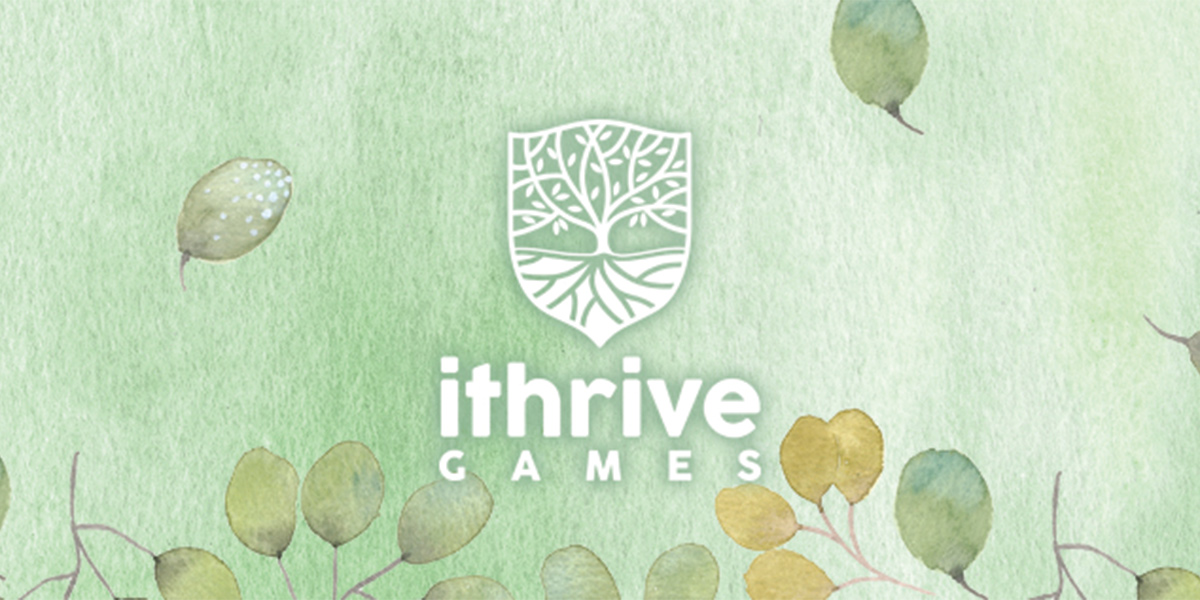
The following piece was authored by Dorothy Batten, founder of iThrive Games and the DN Batten Foundation.
In my life, I've endured bullying, natural disasters, divorce, cancer in the family, accidents, surgeries, physical disability, and two near-death experiences. Still, I consider myself lucky. My life has never come to a standstill, and I have always picked myself up and moved forward. I've sometimes wondered, what is it that makes me resilient?
For one, I've had positive mentors. They have modeled for me the importance of having integrity, being respectful and fair, and making meaningful contributions to my community. Having come from a long line of hardworking and successful business people in my family, I also learned that if I followed my passion, worked hard, treated others well, and sought meaningful experiences, I would thrive.
Second, I've learned from positive psychology that I have a secret weapon to wield in all the roles I play, including businesswoman, philanthropist, counselor, mom, and human: my strengths. According to the VIA Character Strengths survey (which you can take here for free) one of my five signature strengths is perspective, which www.viacharacter.org says includes the ability to see situations from multiple sides, think in meaningful ways about life and how to live it, and to share helpful advice.
Perspective is one strength that's given me the ability to bounce back from hardships. In a way, it also catalyzed the initiative called iThrive. Let me explain. I credit my strength of perspective for the fact that I have always played the role of therapist among my friends. I've also had close relationships with people struggling with depression, anxiety, obsessive-compulsive and bipolar disorders, and substance abuse. I became interested in studying counseling, thinking that if I was going to be the person my loved ones came to for guidance, then I wanted to be well informed. But life and work always gave me some reason not to do it, just yet.
Then, a few years ago, I was in a fluke accident that shattered my leg, requiring three surgeries that left me unable to walk without assistance for a year and a half. Not able to work, I finally decided to take this (quite literal) downtime to get that second master's degree in counseling.
While I was enrolled in the counseling program, I stayed at home a lot with my two teenage sons, nursing my leg back to health while I studied. It was then that I began to notice how much time my boys were spending on the computer playing video games.
At first, like many parents, I nearly made myself hoarse pleading with them to "Pleeeeeease turn that computer OFF!!". I was worried they weren't doing more productive things. I wondered whether they'd be prepared to handle the "real world." Would they have the resilience they needed when hard times inevitably came?
But my angst over their gaming soon transformed into new insight. While working on an independent study, I learned about computer programs designed to deliver mental health interventions. It turned out that they showed promise for improving well-being. It struck me—computer games can be therapeutic! I was excited by this idea, but when I tried a couple of the programs, I was underwhelmed. They were well-intentioned, but I found them so unappealing that they were difficult to stick with. A lightbulb went off for me: "These programs would be so much more engaging if they were more like those games my kids are glued to. And, couldn't video games teens love also offer meaningful experiences that boost their well-being and resilience?"
As I reflected on this, it made more and more sense to me why my sons, and teens in general, were increasingly drawn to video games. Teens are stressed, these days even more than adults. Sure, adolescence was tough and awkward for me too, but I saw my sons and their friends distressed over things my generation didn't face to the same degree. Among them: the increasingly competitive race to get into college, the constant barrage of photoshopped celebrities, and the potential for envy and public embarrassment made possible by a life lived on social media. Video games are worlds where teens can go on their own terms to experiment, be creative, assume different roles and identities, practice expressing themselves, get into the 'flow-zone', and forget about their problems for a while. What a cathartic way to take some of the pressure off! But, I wondered, could these games be doing double duty, teaching kids how to cope better?
Of course, I wasn't the first person to make the connection that video games could teach meaningful skills-research on games-based learning started to really take off around the mid-2000s. But I did see an opportunity to bring another of my passions—positive psychology—into the conversation. Instead of just addressing illness, stress, and disorder, positive psychology says we can foster well-being by looking through the lens of our strengths. I became motivated to make that insight actionable for teens in the virtual worlds where they already are and want to be.
I founded iThrive to ensure that teens are finding in video games the positive, meaningful experiences they need to not only cope with stress but to find their strengths and thrive. Existing games have this potential, but we also could be designing for it more deliberately. And although research on the positive impact of video games is still in its early stages, I believe that under the right circumstances, gameplay can provide opportunities for teens to practice new skills, discover new perspectives (and new things about themselves), learn about others, exchange ideas, and collaborate.
I also witnessed how video games can provide a safe space for teens to practice coping strategies to deal with social challenges and failure. In online social worlds, just like in schools or any other place teens gather, bullying can and does happen. But, as my oldest son told me, he learned by being on the receiving end of aggressive behaviors in video games that reacting to bullies and taking their attacks personally never helped. Instead, he learned to disengage from them, mute them out, and remain focused on his own path.
With each day, video games augmented reality, and virtual reality is becoming more realistic and engaging, making them even more enticing for teens (and adults too!). It makes sense to meet teens where they are already spending so much of their time and to take advantage of the appeal of these technologies to promote teens' positive growth. Because gaming technology is advancing so rapidly, there is almost unlimited potential to create simulated, safe environments, using compelling stories, creative challenges, and evocative dialogue, to help teens gain self-awareness and learn skills that empower them to take the driver's seat on their own path to thriving.
My new perspective: video games can empower teens to thrive. I founded iThrive Games to discover how.
Game-Based Social and Emotional Learning for High School English Class – Part Two

A couple of weeks ago I introduced in an article, Museum of Me, our game-based social and emotional learning curricular unit for English language arts using What Remains of Edith Finch. In case you missed it, you can read all about the details of how we used this game for identity exploration here.
Paul Darvasi, lead creator of Museum of Me, and his high school English class at Royal St. George's College in Toronto were the first ones to complete this unit. The students, all in their final year at the all-boys high school, graciously shared with us their thoughts on the unit as a whole, the game, and their identity explorations. Here are some of their overall impressions of the unit and the activities they completed both in- and out-of-class:
- "This unit was a new and interesting experience I had never done in any classes. I was always very excited for this class due to its nature of new topics and activities."
- "I would describe my experience with this unit as overwhelmingly positive. It allowed for more creative work both in and out of class than almost any other unit I had ever been in. It had strong academic value while also being fun and interesting."
- "It was cool to think about my own identity formation and what objects/moments have attributed to who I am.
GAME-BASED LEARNING: WORTHWHILE TO TEEN LEARNERS?
Gameplay offers an innovative and currently underutilized way to deeply engage students and support them in learning and practicing fundamental social and emotional skills. By using a medium that teens are already excited about, we are able to drive innovative thinking by allowing teens to explore themselves and the world around them in a safe, thought-provoking environment.
Since games are a medium seldom used in the classroom, we wondered if students found the game-based unit relevant and meaningful to their learning. Many of the students felt excited to be able to use a medium that they are interested in already and they also enjoyed the attention-grabbing plot and quality of What Remains of Edith Finch. They told us how games enable them to engage and encounter new experiences that they wouldn't otherwise be exposed to.
- "I think that using games in learning is pretty cool because it is something that everyone our age is familiar with and can use pretty well. It also allows for each person to have their own experience and can learn the way that they feel is best for them."
- "I think most teenagers enjoy playing video games, so when implementing it into school they actually become eager to do their work and will perhaps learn more."
- "They [games] promote a stronger feeling of connection to the educational content that is being shared. Personally, I felt more engaged during class as I was constantly interested in the game material."
- "I think that games are important in learning as they allow someone to explore knowledge in a way that isn't just reading from a textbook or watching a video. I find it very interesting to be able to learn interactively, in-fact I find that I absorb more knowledge in a game than in a textbook."
INDIVIDUAL VERSUS GROUP GAMEPLAY
Throughout the unit, students played What Remains of Edith Finch as a group, which in this case meant one student had the controller while the others watched the gameplay unfold. Students alternated who had the controller during and across each class period, and observing students made requests of the student in control throughout gameplay.
We weren't sure how the students would feel about this experience, as we know that impressions can be very different when watching someone play a game versus actually playing it yourself. We were curious about how students responded to the group play structure, and whether this hindered their learning or expanded it. Overall, students were supportive of the group gameplay, for a variety of reasons, although some definitely wanted to be in control.
- "I think that it doesn't make much of a difference for a game like Edith Finch because it is more like watching a movie, unlike something like Call of Duty where it's more skill-based and is boring to watch if you're not playing. It is sometimes nice because you can just sit back and enjoy the game."
- "It was like watching a movie when others were playing, but more engaging because you could tell the player what to do. I think that it is enjoyable watching, but obviously more enjoyable playing, but also shouldn't really be changed because we were still engaged."
- "It is interesting to see where other people chose to search as well as how others who are not playing interact with the person using the controller."
- "For me it was fine. Obviously I would like to have full control (I actually didn't even play once!) over the game but watching worked as well. It was interesting to see what decisions my classmates made and compare that to the ones that I would have made."
- "It was slightly irritating, as it is not as an enjoyable experience watching someone else set the pace for exploring the game."
- "Edith Finch is a very visually appealing game so there was no problem with me stepping back and observing due to the beautiful graphics. This, in turn, engaged me more as a backseat observer."
OPENING UP ABOUT ONESELF IN CLASS
Students shared with us what was most compelling to them about the thinking, learning, and creating they did during the Museum of Me unit. They really appreciated the class discussions and having the chance to share personal stories with their peers. Some admitted to taking a little more time to warm up to the idea of being personal, but once they did, they expressed how much they learned not only about themselves but about their classmates as well.
- "I really liked the final Museum of Me project at the end of the unit. It took me a while to be comfortable, but in the end I enjoyed working on it."
- "Okay, it was a little uncomfortable being that personal, but by the end of the unit it was fine."
- "I think I did learn a lot from the meme one not only about myself but about other people based on how they view themselves and how they think others view them."
- "I found it allowed us to express ourselves in ways we usually can't."
- "I think this unit builds over time in a very unique way. It starts slowly with a series of simple worksheets and whatnot and it slowly evolves until you reach the Museum of Me assignment. In this latter half is where I think the majority of the learning occurs and is also where 100% of the creativity comes into play. So overall it was very strong on both counts."
- "The promotion of a more personal connection to the unit. No teacher has ever attempted to combine personal with curriculum and it was a pleasant surprise. It allowed me to develop a more emotional connection to the course material."
UNDERSTANDING IDENTITY
One of the key areas of focus in our Museum of Me unit is exploring identity and how our identities are shaped by those around us. We wanted students to think about the roles that they play in school and at home, and the ways that the labels and masks they put on (so to speak) reflect those identities differently. We asked the students, "How did your understanding of identity — both your own and others' — change over the course of the unit?" And here is what they had to say,"I think my understanding of myself definitely changed a great deal, through the Museum of Me project I was able to deal with some aspects of myself that I never really had before. Also through talking about the projects I learned about my friends too."
- "I really noticed how much other people have an effect on one's identity."
- "In terms of understanding my own identity, it changed in the sense that I became more aware of what things have helped to form my identity. I was not aware of just how many items/people/moments have had an effect on my identity formation."
- "This unit really pushed me outside of my comfort zone and took a look at myself. I normally don't talk about myself this much, and this gave me some new retrospect on how I view myself."
- "During my identity of me assignment, I realized how much of my identity was created by my parents when I was young but as I began to grow up, more of my identity is shaped by my friends and my personal choices."
- "I learned a great deal about myself in the construction of it and definitely felt that I knew myself better on the other side."
THE FINAL PROJECT: DESIGN YOUR MUSEUM
The Museum of Me unit ends with a culminating project where students design an autobiographical exhibit to explore their own identity formation. Each student curates a collection of artifacts which may include pictures, letters, journal entries, quotes from role models, and more. Students create narrative labels for each artifact describing its relevance to their own identity journey and they are given free reign for the format of their museum. Some students with Darvasi's class created interactive narratives using Twine while others created journals or interactive, physical objects. Here's what they had to say afterward:
- "The most compelling part of this unit for me was the Museum of Me project. I had to think about myself as a person and what things attributed to my identity formation."
- "Museum of Me was particularly appealing, I found that I was willing to fully invest myself into the project and received greater satisfaction from the final product than I usually do with other projects."
- "I liked Museum of Me because it allowed me to look back into my past and speak about how it formed my identity."
- "Museum of Me project because it allowed us to take our own path and create a fun final product that was enjoyable to make."
- "Museum of Me was absolutely the most enjoyable simply for the fact that it allowed for so much creativity and exploration which is both fun and very intellectually stimulating."
- "I learned most from the Museum of Me project in terms of social/emotional intelligence and learning. I learned how games can be used to tell stories and used to connect with students as well as how they can be used to reflect upon your own life."
- "The most recent assignment, Museum of Me, was the most enjoyable assignment because I got to use things that are part of my identity and showcase them in a portfolio type style of online pictures to show the class."
FINAL THOUGHTS
We designed the Museum of Me unit as a demonstration project to showcase how games can be integrated into meaningful classroom learning in a way that provides engaging and collaborative discussions with teens. The pilot run of the unit showed us that students found it to be both enjoyable and interesting. Even more important, they said it gave them the ability to learn not only a lot about themselves but their peers as well. And, they even said it was cool! (whew!)
- "That it's creatively stimulating and promotes insight on personal identity; as well as, innovation within the classroom. It's important for boys, in particular, to reflect and understand their emotions and learn more about how identities don't reflect everything about you."
- The majority rated it as the best unit they've ever had! And with this sign of support from our most important audience, onward we go to create more game-based units for high school students!"
JOIN US!
If you would like to use the Museum of Me unit in your classroom, download and learn more about the unit here.
Sign up for our newsletter so you can stay up to date on the release of this unit and all the other incredible happenings here at iThrive Games! You can also check out our previous blog on all of the resources we have available for educators and using games to engage the whole teen.
Game-Based Social and Emotional Learning for High School English Class

(Yes, it is possible!)
iThrive Games works to benefit teens at the intersection of game development, education, and mental health. That is why I was so excited at the opportunity to partner with Paul Darvasi, a teacher at Royal St. George's College in Toronto and Matthew Farber, an assistant professor at the University of Northern Colorado's School of Teacher Education, in creating Museum of Me, a game-based learning unit involving Giant Sparrow's, What Remains of Edith Finch.
Developer: Giant Sparrow
Social and emotional learning (SEL) encompasses educational strategies that support students in developing and practicing their social and emotional skills. This includes everything from self-awareness to responsible decision making to relationship skills. Games offer a unique opportunity to support SEL in high school classrooms, where teens need more challenging and realistic content and engagement than the practices used in elementary classrooms. Games help transport teens to new worlds, enabling their exploration of new places and possibly, new versions of themselves. As the Guardian wrote in its 2017 review, "What Remains of Edith Finch is a game that succeeds in recreating the childhood joy of reading a book and being utterly transported into its pages, only to reach the end and realise it's not real."
In talking with EdSurge recently about Museum of Me, Paul Darvasi commented, "Schools are very emotional places that don't invite emotion, and that is a big problem." Many games present challenges that require players to adapt and grow in ways that promote deep learning and self-awareness, allowing players to experience a broad range of emotions. Feelings of betrayal, guilt, forgiveness, frustration, pride, and so much more, can be felt while playing games making them an incredible asset for teen's social and emotional development.
How We Created Museum of Me
I was looking for a game-based learning project for iThrive and knew we needed a special game that would authentically invite teens to explore their own emotions alongside a compelling character study. Paul and Matt knew they wanted to create a classroom unit for What Remains of Edith Finch almost immediately.
What Remains of Edith Finch is a game that follows a girl who is exploring the history of her family through the home that she grew up in. The game invites players to a safe place to explore and learn, while also leaving them feeling humbled and mesmerized by the vast world around them. There's so much in this game for students to immerse themselves in, (thank you, creative director, Ian Dallas, and the team at Giant Sparrow!) and that inspired us to design a teaching unit that would measure up. Matt believes that video games are the "storytelling mediums of the 21st century," and in that spirit, Museum of Me gives students and teachers a way to discuss identity and build on social and emotional skills that are of grave importance beyond the classroom.
GBL + SEL + ELA + UDL
We embraced the rich interactive narrative of What Remains of Edith Finch and knew it would be an ideal catalyst for a game-based learning (GBL) unit on identity exploration, one of the pillars of the resilience framework for SEL, cited and used by iThrive advisor Dr. Rachel Poliner. To design the learning objectives underlying the study we gave equal weight to the game, and standards for both English Language Arts (ELA) and SEL. We landed on a set of learning objects that include exploring identity and character, comparing and contrasting public and personal narratives, examining how possessions represent and maybe even misrepresent aspects of identity and reflection on self.
We used the principles of universal design for learning (UDL) to design the activities and assessments that comprise the lessons. We worked hard to make sure our design choices took into consideration our understanding that each teen develops differently and engages with concepts from different access points. It was very important for us to create opportunities to engage all students deeply in a compelling learning experience, driven by their own interests and ideas. Learning scientist and universal design for learning expert (and an advisor on the unit), Dr. Gabrielle Schlichtmann of EdTogether remarked, "The curriculum authors have worked to build a flexible experience so that teachers can meet the needs of all students - there are many ways for students to access the content, show what they know, and engage in deeper learning."
The Museum of Me's multi-method assessments happens when students create artifacts both in and outside of class. In one assignment students read "Chameleon" and reflect on their own relationship with an item of clothing or some other status-oriented possession that projects identity. They then create two 30-second vlogs introducing two items that express their identity or that are attached to a meaningful personal story. One vlog is to be public-facing and the other is to be private. As students analyze the process of creating publicly- versus privately-facing vlogs, they consider what identity is and how might its expression change depending on the audience.
Students also create memes, based on the one below. They select photos to represent how they see themselves, and how they think their friends, family, teacher, and others see them. Dr. Schlichtmann said of the meme project, "I love this assignment - it is authentic and relevant. I also think that this humorous format can dampen discomfort students might feel."
Not Sure Where to Start with GBL in Your Classroom?
If you are interested in using games in your high school classrooms, check out this video about why educators are using games in their classrooms and our game-based learning guide for some tips to get you started. Also, be sure to check out this great article from our archives by Barbara Chamberlin and Jesse Schell for other terrific pointers.
Join Us in Piloting Museum of Me
If you are interested in trying out the Museum of Me unit in your classroom or after school program, contact us for an early release version.
Let Us Know How You're Using Games with Teens
I love to see games integrated into engaging and collaborative discussions with teens. Gameplay offers an innovative and currently underutilized way to deeply engage students and support them in learning and practicing fundamental social and emotional skills. By designing school lessons around a medium that teens are already interested in, we are able to drive innovative thinking by allowing teens to explore themselves and the world around them in a safe, thought-provoking environment. What will you create? Be sure to let us know — we'd love to feature you on our site!
Sign up for our newsletter so you can stay up to date on the release of this unit and all the other incredible happenings at iThrive Games!
If you want to learn more about game-based learning, check out Matt's recent books, Game-Based Learning In Action, and Gamify Your Classroom, both published by Peter Lang Inc.
iThrive's Senior Director of Learning, Michelle Bertoli, has been invaluable in forging our collaboration with Paul and Matt and supporting their efforts. She's blissfully enjoying her maternity leave and will return in the Spring.
__________
ABOUT THE AUTHOR
Put a Badge On It! Using Digital Badges to Support Social and Emotional Learning

Digital badges have been at the center of discussions around alternative credentialing systems for years. Digital badges—web-enabled tokens of accomplishment that circulate in social networks—rose to prominence as a potential alternative credentialing system in the early 2010s. The idea was that students could earn credit that would be recognized by universities, peer networks, employers, and others for skills built outside of formal schooling. Digital badges are unique in that they contain links to the evidence (projects, products, media) for which the badge was awarded.
Digital badges have the potential to motivate learners and promote important social and emotional learning (SEL) skills. Skeptics of badges "worry that students will focus on accumulating badges rather than making connections with the ideas and material associated with the badges-the same way that students too often focus on grades in a class rather than the material in the class, or the points in an educational game rather than the ideas in the game" (Resnick, 2012). But badge proponents find promise in having a new way to assess learners apart from the "current multiple-choice form of testing" that "doesn't measure all that is being learned and de-motivates true curiosity" (Davidson, 2012).

Digital badges can provide direct links to "evidence" of how and when they were earned. Image source
What if badges were not designed to replace grades? What if badges could be designed to promote SEL in ways traditional classroom grades couldn't? I describe some ways digital badges can (and have been) designed to promote SEL. Specifically, badges can and should be designed: (1) for collaboration; (2) to map learning pathways; and, (3) to leverage self- and peer-assessment practices.
[NOTE: These insights come from analyses of 29 projects in the Design Principles Documentation Project funded by the MacArthur Foundation. For more information go to: http://dpdproject.info/. Special thanks to Dan Hickey who was the lead on this project.]
Badges can be designed for collaboration
One core competency of SEL is relationship skills: "the ability to establish and maintain healthy and rewarding relationships with diverse individuals and groups" (CASEL). At the core of building relationship skills is an emphasis on creating environments and opportunities for collaboration where these relationships can be developed and maintained. Digital badges can be designed and implemented to promote these skills in collaborative environments. For example, digital badges can be awarded for group accomplishments, or for an individual's role in a group collaboration.

Examples of digital badges awarded for demonstrating social and emotional skills. Image source
Earning a badge for a group accomplishment could entail asking students to provide evidence of working together to reach a common goal. For example, creating a movie requires multiple individuals to fill the roles of director, cinematographer, screenwriter, and actor. An individual's role in a group collaboration could be rewarded by awarding badges to individuals, for example, for connecting with peers and teachers in the pursuit of further developing specific skills.
Many of the negative effects of competition around badges, as mentioned earlier, can be avoided by honoring group accomplishments. When competition is paired with collaboration, we would expect to see beneficial outcomes for learners in those environments allowing all learners to participate in competition (see Hickey, 2003).
Badges can be designed to map learning pathways by helping earners set goals.
Setting goals is an important self-regulated learning process (Zimmerman, 1990) and a core component of SEL related to self-management (CASEL). For teens to be successful at accomplishing large tasks, they must develop the ability to set and keep track of specific smaller goals that build up to the larger one. Digital badges can encourage teens to set goals through: user-created badges, using badges to display goal trajectory, and allowing for users to determine their own goal trajectory.
Badges could be awarded in a sequence for skills that build on themselves (for example by completing different missions related to an overall goal), thereby displaying a goal trajectory. By allowing students the ability to plan out and monitor their learning through user-created badges, the learner has to establish a set of standards on which to award the badge and can more thoughtfully plan and reflect on the experience. With user-determined goal trajectories, learners are able to reference a learning pathway and can decide what badges to pursue and see the steps to earning them. Users can track their progress by seeing what badges they have earned on the way to the larger goal.
Badges can be designed to leverage self- and peer-assessment practices.
Self-assessment is a practice that encourages learners to carefully cultivate accurate self-perceptions and recognize their strengths, which directly maps onto the self-awareness competency proposed by CASEL. A defining feature of a self-assessment badge is the ability for learners to have a role in defining the criteria for the badges they set out to earn.
Assessment has clear links with motivation and SEL. Certain characteristics of assessment, such as who does the assessing, may matter for the amount of effort a learner puts into a task. Learners who are asked to assess themselves on a task may reflect more deeply on their own learning. Learners who are assessed by their peers may put more effort into the task based on their need to appear competent in front of their peers. The incentive of allowing learners to be peer mentors and assess their peers may be motivating for learners because students feel in charge and are eager to help their tutees improve. As a byproduct, they often put forth more effort and learn more themselves (Chase, Chin, Oppezzo, & Schwartz, 2009).
Final thoughts
It is difficult to make assumptions about the outcomes of earning badges on SEL without understanding the context in which these badges are designed. Digital badges could be seen as more effective in promoting SEL skills if the teens earning the badges value them. While establishing the value of badges for this age group might be difficult at first, it is no doubt a prerequisite to seeing digital badges used successfully. The badge may also mean more for the earner if it circulates in social networks. For example, when an earner shares a badge with friends over Facebook or Twitter, friends can click on that badge, learn more about the accomplishment and the learning opportunity, add their own comments, and bring it to the attention of others. Incentives in themselves do not necessarily have positive or negative motivational influences. Rather, it is studying them in the contexts in which they operate that provide valuable insight about their impact.
__________
About the Author

Katerina Schenke, PhD is a Senior Researcher at CRESST|UCLA. Her research is on understanding how and under what circumstances students are motivated towards learning, how we can measure motivation and engagement through digital games, and how we can develop models of assessment that are informative to students and teachers. Katerina received her Ph.D. in 2015 from the University of California, Irvine, and B.A. from the University of California, Los Angeles in 2009 in psychology and German. She completed a postdoctoral position in psychometrics at UCLA in 2015-2016. In her spare time she is developing a game to help kids learn about causality and the digestive system, incorporating all of the lessons about motivation "goodness" from her work into her passion project.
iThrive’s Resources for Educators: Using Games to Engage the Whole Teen
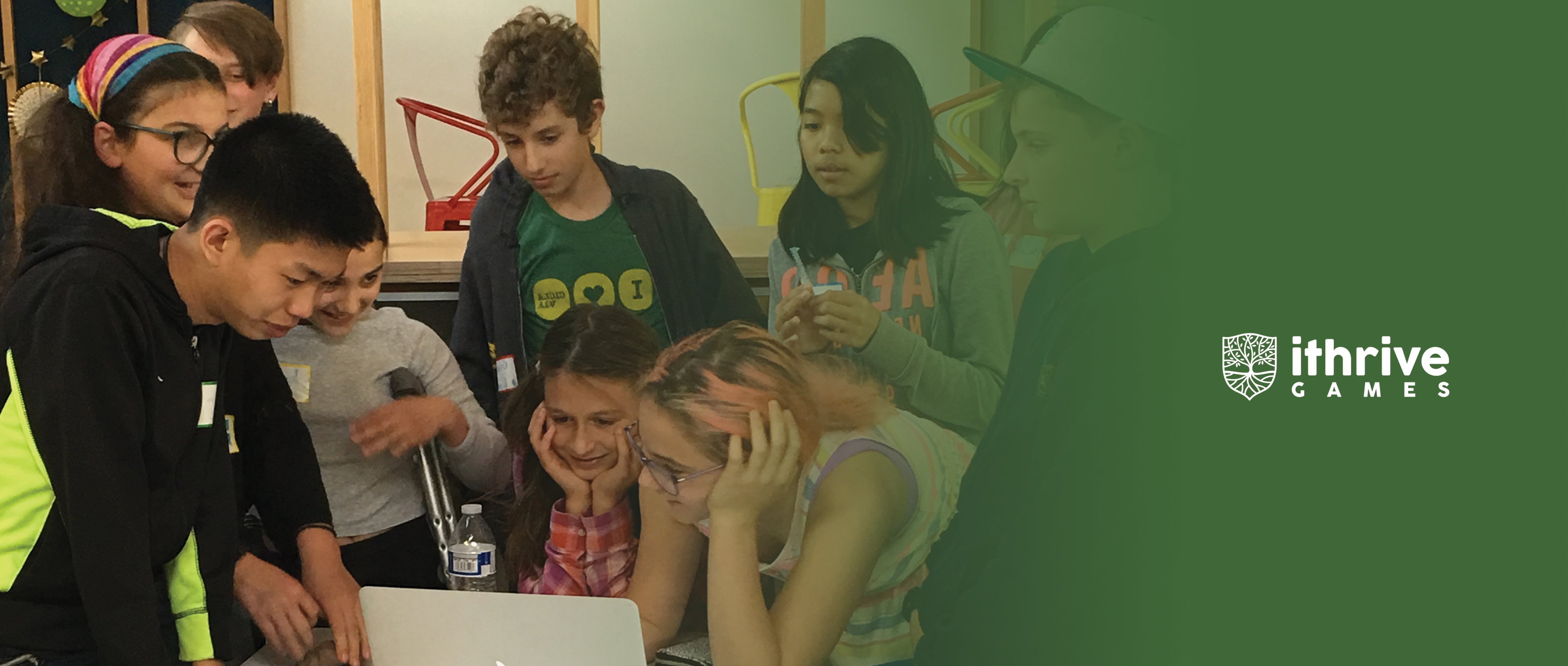
iThrive Games, founded in 2014, is a nonprofit committed to providing meaningful growth experiences for teens, both in and outside of the classroom. Through our education initiatives, launched in 2017, we strive to empower educators to integrate game-based learning in the classroom to support the development of the "whole teen," meaning attending to teens' cognitive, social, and emotional selves.
As iThrive collaborator and veteran social and emotional learning expert, Rachel Poliner, likes to say: "The whole teen is never NOT in front of you." Hoping to isolate the "cognitive self" of a teen — to get them to just pay attention and learn — is impossible and, in fact, counterproductive. Positive emotions and relationships facilitate learning. Only when teens feel safe, connected, and respected is full academic engagement possible. Teens' social and emotional selves are essential to learning.
Video games, both educational and commercial, have been used successfully in education for years, but have been used much less often with teens of middle and high school age than with younger children. They also have been used far too rarely to support social and emotional growth through practices like collaboration, self-reflection, good digital citizenship, and media literacy. Games are often excluded from secondary education in favor of more traditionally "acceptable" media like books and films. This is a huge missed opportunity. We believe that integrating video games into the secondary school classroom can facilitate teaching the whole teen, and we are partnering with innovative educators who are doing just this.
In line with our focus on developing the whole teen, iThrive provides resources and professional development opportunities to teachers to support integrating meaningful video gameplay into education. We invite you to explore our website for materials and updates on our offerings for educators, including our:
Curated Games Catalog
Our Curated Games Catalog is a library of meaningful video games from many genres, along with their age ratings, descriptions, and links to developers' websites. The catalog, curated by iThrive's team of psychologists and game designers with input from our network of experts, can assist you in choosing games that may support skills and habits that teens need to thrive, including Empathy, Curiosity, Growth Mindset, and Kindness. More games and practices are continually being added. Let us know if there's a game you don't see here that you think should be featured!
Article Series
In our games and education article series, we invite teachers and experts in game-based learning — as well as teens who have learned something valuable from their gameplay! — to share tips and resources for integrating video games successfully in the classroom to support rich learning experiences. Read insights from experts like Paul Darvasi, Barbara Chamberlin, and Jesse Schell, and look out for more engaging content that we're adding all the time:
- Game-Based Learning in the Classroom: 3 Essential Questions, by Barbara Chamberlin and Jesse Schell
- An Interview with Kinful: Bringing Cross-Cultural Empathy to Schools with VR, by Michelle Bertoli
- Meaningfully and Realistically Using Games in the Classroom, by Barbara Chamberlin
- Wallop! You Died (Again): Growth Mindset and Cuphead, by (teen contributor) Ian McDonald
- Putting It in Context: Using Commercial Video Games in Education, by Paul Darvasi
- We Can't Design Games for Teens Without This, by Susan Rivers and Gabrielle Rappolt-Schlichtmann
- How Bad Data Have Given Video Games a Bad Rap (and How to Read Beyond the Headlines), by Kelli Dunlap
- Zest in Video Games: Teens Need Some Excitement, by Michelle Bertoli and Heidi McDonald
- Purpose in Games: Empowering Teens to Explore Who They Are, by Michelle Bertoli and Heidi McDonald
- Video Games: A Safe Place to Wonder, by Michelle Bertoli and Heidi McDonald
- I Haven't Leveled Up...Yet: Growth Mindset in Video Games (Part 1), by Michelle Bertoli
- Video Games Can Boost Empathy, by Michelle Bertoli and Heidi McDonald
- Why Do Teens Play Video Games?, by Isaac Handley-Miner
Curricular Resources
iThrive has partnered with a large network of experienced secondary educators to develop rich curricular units around meaningful video games. Our initial efforts are focusing on the visually rich, deeply emotional What Remains of Edith Finch (rated 13+ years) and the heartbreaking social simulation and survival game, This War of Mine (rated 14+ years). These and other in-development units are designed to teach core subject matter in the humanities as well as key social and emotional skills for resilience, including social competence, autonomy, a sense of purpose and future, and problem-solving skills. Over the coming year, iThrive will develop, test, and share these curricular resources for teachers to use and adapt to the specific needs and interests of their teen students.
In the meantime, our Educator's Guides provide a quick overview of games like these that have been used successfully by our educator partners to teach meaningful social and emotional skills in the middle or high school classroom. Check out the guides here and consider how this type of gameplay might enrich your classroom:


We look forward to connecting with an ever-wider network of teachers who believe that meeting teens where they are, in both their virtual and physical worlds, to facilitate meaningful learning is key to their social and emotional growth and resilience. Contact us to get involved!
An Interview with Kinful: Bringing Cross-Cultural Empathy to Schools with VR

How do we prepare today's students to thrive in an uncertain world? One proven technique is for schools to wholeheartedly support students' social and emotional development — their empathy, their ability to bounce back after failure, and their capacity to connect meaningfully and sensitively with diverse people across the world. Schools are demanding effective social and emotional learning (SEL) approaches now more than ever, and Michael Auerbach and Sam Williamson, co-founders of Kinful, are two of the visionaries rising to meet the need.
The Kinful curriculum is designed to build five key social and emotional skills in students from elementary through high school. Among SEL programs, one really unique thing about Kinful is that it leverages the power of virtual reality (VR) to empower students to connect in meaningful and empathy-building ways across geographical boundaries.
Students in Kinful classrooms — so far in New Jersey, New York, Texas, Washington, South Africa, Turkey, and soon the Ukraine — create 360-degree videos to share their daily activities, interests, thoughts, and feelings with peers across the country and the world. iThrive caught up with the Kinful team to find out more about their inspiration, their successes and obstacles, and their hopes for the future of the program.

Students using Kinful's VR headsets react to 360-degree videos created by students from another country. Image source
iThrive: You have shared that Kinful's mission was inspired by your Peace Corps service. From there, how did you decide to use VR in schools to support cross-cultural empathy?
Kinful: Peace Corps exemplifies a powerful aspect of humanity: the innate ability of humans to empathetically connect with one another despite vastly different cultural backgrounds. Peace Corps volunteers and host-country nationals instinctively laughing together, crying together, and caring for one another highlights how empathy can transcend cultural boundaries. The idea that empathy is the thread that binds humanity together is a central inspiration for Kinful.
We knew we needed active engagement, as opposed to passive engagement like watching a documentary, in order to recreate the Peace Corps experience in the classroom. The immersive aspect of VR provides the exact type of active engagement needed!
iThrive: What are the key components of the Kinful curriculum?
Kinful: A typical Kinful lesson consists of non-sequential workstations where students rotate between activities. Half of the workstations are VR-related (viewing and filming), and half are "standard" SEL activities (e.g., teamwork games, group reflections, etc.).The VR and the 360 filming activities within that rotation are fundamental to Kinful's vision and impact, but they make up only a portion of the greater Kinful whole. The tech and non-tech activities support and extend each other. As students move from one workstation to the next, they experience and reflect on SEL themes individually, in groups, and through someone else's eyes (VR).
The Kinful kit comes with a range of engaging materials — including VR headsets — teachers can use to support students in building 5 key social and emotional skills. Image source
iThrive: What is it like when a student first connects with a peer from another place and way of life? What emotions do you see being shared, and what kinds of stories?
Kinful: It's all smiles when a student puts on a headset — but to be honest it's hard to tell if the smile is coming from the inherent delight in identifying with someone else in a different country, or if it's coming from the awe of using VR presumably for the first time. It's probably a little bit both, which is fine with us!
iThrive: What about after the connection — what do you see or hear from students? How do they talk about the experience?
Kinful: In an effort to get students to relate to one another, we always prompt students to share videos of universal experiences like spending time with family/friends or taking care of responsibilities. Of course, these things will look different across cultures, but the general concept is always recognizable and relatable.
From there, students usually come out of a Kinful video saying something like, "I eat lunch with my friends too!" or "I also have to do house chores after school!" These simple and universally translatable experiences help bridge cultures — moving us away from a more removed, academic understanding (fun facts of a foreign country) and getting us closer to a more personable familiarity ("Mohammed from Senegal loves walking his dog in the morning. So do I!").
iThrive: What has surprised you most about what students want to share with each other through the videos they create?
Kinful: What they want to share hasn't been particularly surprising (again, our prompts revolve around everyday stuff), but how they've been sharing has been surprising. By that, I mean their eagerness! I anticipated awkward hesitation in our students' first videos (probably because I could easily imagine my twelve-year-old self awkwardly talking about my Warren G CD or Green Day blacklight poster). But no — teachers tell us their students love filming themselves!
A student uses a head-mounted camera to create 360-degree video for Kinful peers around the world. Image source
iThrive: What's your biggest (or favorite) success story to date?
Kinful: Our biggest success story to date has been our adoption of "standalone" VR headsets, which are headsets with an operating system and screen built in. Prior to this adoption, we used a smartphone + headset setup to view VR videos through a Kinful app, which involved two central hurdles: 1) procuring a smartphone and 2) Wi-Fi connection to stream videos.
Standalone headsets solve these two hurdles because: 1) the price of a standalone headset is a fraction of the cost of a smartphone and 2) standalone headsets allow us to upload our entire VR library onto the device, bypassing the need for Wi-Fi to stream (smartphones typically don't have the capacity to store our library).
iThrive: What are some of the obstacles to extending the reach of a program like Kinful into poor and rural areas across the globe? What are some solutions you are using or planning to use?
Kinful: The biggest obstacle was internet access needed to view our VR videos. Our recent adoption of standalone headsets with our VR library preloaded has solved this problem. Now, we're able to send a Kinful kit to a partner site with everything needed to execute Kinful programming (VR hardware, activity supplies, etc.).

A student donning the Kinful VR headset. Image source
iThrive: What advice would you give a developer who wants to design tech- or game-based experiences that promote or support empathy?
Kinful: Our mission is to encourage students come to their own conclusion that what binds humanity together is greater than what divides us. We want students to watch these videos and notice the similarities they have with students from all over the world. Once those connections start being made, empathy naturally follows. That's why we've stocked the Kinful video library with universal, relatable experiences.
In that vein, we've thus far shied away from creating traumatic reenactments to promote empathy, like first-person angles of bullying for example. That's not to suggest we believe such a video would be ineffective — it's just that we've found students to be more open and vulnerable when engaging with less threatening material.
iThrive: It's no secret that it can be really challenging to get both SEL and tech-based programs adopted and implemented widely in schools. What obstacles have you faced and how do you get around them?
Kinful: The biggest challenge has been schools figuring out how to pay [for Kinful]. Most schools we've talked to don't have an SEL budget, but they do have a tech budget. Problem is, Kinful doesn't neatly fit into a tech category since we're not targeting tech outcomes. With our main focus being SEL, we've had the most success engaging with schools that already have SEL initiatives taking place.
iThrive: What advice would you give to a teacher who is uncomfortable using technology in the classroom? What about teachers who struggle with teaching SEL?
Kinful: The first bit of advice for a teacher uncomfortable with using technology or integrating SEL would be that there's no need to reinvent the wheel! There are a lot of high-quality resources out there that present best practices, materials, and tutorials for both.
We definitely wanted to try and get out in front of any potential unfamiliarity with tech or SEL by creating a curriculum that is largely student led. Teachers who are uncomfortable with tech and SEL have in Kinful a simple yet high-quality way to get started without the pressure of creating their own programming. With all materials and directions supplied, the teacher just stages the room and follows the steps to facilitate the lesson. We designed Kinful to be as useful to a savvy veteran teacher as it would an inexperienced summer camp counselor.
iThrive: What's your vision for what's happening at Kinful in 5 years?
Kinful: Kinful is ultimately building towards creating a global community of schools, an international network of students and educators discovering connections and growing together towards a more empathetic future.
However, as we've designed Kinful to be molded by students (prompts are open-ended, and we encourage students to film and share what matters most to them), we imagine that as the years pass they will change and shape the program, bringing us to a place we had never even imagined!
__________
To learn more about the Kinful curriculum, visit www.kinful.org and check out the team's orientation video for partner schools:
GUIDE: A Video Game for Challenging Your Fears

"The voice in your head is not always a truthful guide, and the journey of fighting your fear starts by making the choice to question your own narrative." - www.guidethegame.com
You are Fia, a baby phoenix just born back into the world from a pile of ashes. Lightning strikes the tree you call home and you fall from your nest, only to awaken flightless and alone on the forest floor in thick darkness. A mysterious orb of light floats towards you and urges you to follow. It is a friend, it seems. It will take you to safety.
You take some cautious steps forward, the orb of light illuminating your way. Then the light urges you to jump across a wide chasm. "You will make it," your guide says, stoically.
You take a running leap, but miss the ledge and fall down, down, down into a world of dead ends, shadows, and ever-vigilant eyes. Maybe your guide isn't so trustworthy, after all...
* * *
This is the introduction to GUIDE, a puzzle platformer about anxiety and the value of challenging the fearful voice in our heads. Made by University of New Brunswick alumni Rebecca Goodine, Elliot Coy, Jade Yhap, and their teammates,* GUIDE won second place in the international student design competition for empathy games that iThrive Games co-hosted with Games4Health in 2016.
GUIDE was a standout among the submissions owing to its charming art style, unique mechanics, and compelling theme of questioning the inner voices that keep us stuck. Since the competition, the team has had time to build on the original concept, so we checked back with them to find out how GUIDE is coming along and what's next for the intriguing empathy game.
Michelle Bertoli: What inspired you submit an entry to the empathy design competition iThrive co-judged with Games4Health? Why does empathy in games matter to you?
GUIDE Team: We were approached by one of our professors (and now team member), Jeff Mundee, with the collaborative iThrive and Games4Health empathy competition. The theme was immediately intriguing, as it stood out from a lot of other themes in similar competitions at the time, and it also aligned with our personal design and research interests. We wanted to design a game about social anxiety because it was a condition that had affected us and people we knew. Empathy was an important vehicle through which we could address the issue of social anxiety. GUIDE attempts to prompt empathy in an experiential way, but also can be a catharsis for those who identify with anxiety.
MB: Why is it important to you to give players a window into how social anxiety feels?
GT: Social anxiety can be a very isolating and internal experience, and with GUIDE we wanted to show that struggle in a way that allows players to relate to Fia and these very personal battles. Our goal is that the game allows players to reflect on their own struggles, or helps them better connect to a friend or loved one with social anxiety.
MB: GUIDE encourages players to question the internal voices/narratives that keep them stuck in fear. How does this contribute to empathy?
GT: The internal voice or narrative is represented in GUIDE by a small light who leads Fia through the game's forest. The AI for the Guide hovers towards geometry the player needs to see to progress through levels. This light from the Guide, like the thoughts in our heads, "clearly" illuminates the path the Guide wants us to follow. However, over the course of the game it becomes apparent that the Guide is not always right, and the player should start to question the Guide, since there are other, sometimes better, roads to travel. In this way, GUIDE players must begin to acknowledge the perspective of others and how it differs from theirs.
The eyes that hide from the Guide's light in the game represent social anxiety. Players feel like they are being watched and may be able to empathise with Fia's fear. They can start to relate to how people with social anxiety feel like they are being scrutinized. Players also learn that the voice of the guide is an internal voice, like the voice in their heads that can sometimes lead them astray.
MB: Why is it important for teens and young adults to challenge their own internal narratives?
GT: Teens and children are bombarded with messages from all angles, and at such a vulnerable life stage, it is important for them to know how to question the ways they think about themselves. We hope that our game can be used as a springboard for learning such self-improvement skills.
MB: Fia can flap her wings to light fires and burn down obstacles to move forward. It's a really fun and unique mechanic! Where did you get that idea, and what's its significance?
GT: It was important for us to represent Fia's internal journey through external and player-visible mechanics. As Fia progresses in the game and learns about herself, she also gains greater control of her phoenix powers, like fire and gliding.
As a phoenix, players go through a transformation before the game even begins, watching in the introduction as Fia burns out and becomes a chick once again. This shows how Fia in a sense is a blank slate; all her experiences are new once again. We want players to recognize that Fia is new, her experiences are new, her actions are new, that she does not know what the world is like anymore and that she has only a Guide to trust moving forward. This shows how someone with anxiety may see the world, that their inner voice may not be so trustworthy.
MB: How does GUIDE's art design contribute to the emotional impact of the game?
GT: The art of GUIDE is designed to be "storybook"-esque, evoking feelings and memories from childhood. This is designed to help put the player in a state of greater openness towards and acceptance of our game's metaphors. It also allows them to engage in a form of "dangerous" play. That is, they can explore a stressful situation in a contained environment that provides a level of safe abstraction, "levelling up" their empathy skills by relating to the content in an affectively risky, but not truly harmful, way. Through our research we have found that one way that people can gain empathy is to first experience and simulate those skills in a safe, virtual environment.
MB: You have done some playtesting of GUIDE in after-school programs. What has stood out most to you about young players' reactions to the game?
GT: The reaction to Fia stands out the most to us. Players have been receiving her well, commenting on how it is cool to be the "bird that can light things on fire." Players really enjoy playing through the levels using Fia and her abilities, and they seem to think that the challenge/flow state is enjoyable.
MB: You are working to design some curricular materials to accompany GUIDE. How do you envision teachers using GUIDE with their students?
GT: The curricular materials are discussion guides. We believe that the lesson of GUIDE is best received through a short discussion, otherwise a player may misinterpret the message. The vision for GUIDE in a classroom situation would be for teachers to briefly introduce the idea of GUIDE, have students play it, then have a classroom discussion, asking students to expand on what they thought about the message of the game as well as some of the concepts that may be difficult to grasp immediately. GUIDE could also be used by guidance counsellors to help children work through anxiety, by creating an avenue to talk about how Fia may be feeling, and associating her character with themselves. GUIDE is a game first and foremost. It is meant to be a fun experience. At the end of the day, if a child played our game, had fun doing it, and learned a quick lesson on empathy, that's the best way they could have learned.
MB: What have you learned about designing a game for empathy that you most want to share with other game developers?
GT: We have found it very helpful to draw on our own personal experiences with anxiety in the creative process, as it allows us to connect to what we are making in a tangible way. However, it is also important to research the subject you are interested in to ensure that you are portraying the subject matter in an accurate way.
MB: The current version of GUIDE ends with "To Be Continued." What can you tell us about what's next for GUIDE, both in terms of the narrative and in terms of GUIDE's exposure? Congrats on GUIDE's acceptance to the Smithsonian American Art Museum Arcade in August!
GT: Thank you! We are indeed excited to be presenting GUIDE at the Smithsonian SAAM Arcade in Washington on August 5th and 6th, 2017. We also were recently featured at the Jalloo Festival of Animation and Games, Congress 2017, and the Women Making Waves film festival.
In terms of plot, GUIDE will be delving into the perspective of a character introduced at the end of the current version of the game: the "Thunderbird." Players will learn about the background of the Thunderbird and why it is pursuing Fia. They will understand why the Thunderbird seems to be so angry and aggressive, so that they may begin to empathise with the character.
Interested readers can check out our progress on GUIDE at www.guidethegame.com and follow us on Facebook and Twitter: @GuideTheGame.
* * *
*The GUIDE team:
Rebecca Goodine: Team lead, story, level design, and art. For more of her games-related work, please see www.rebeccagoodine.com.
Jade Yhap: Research, story, level design, and networking.
Elliot Coy: Lead programmer.
Jeff Mundee: Advisor.
Virginia Alecia: Art and illustration.
Jordan Roherty: Audio, music, and sound effects.
Nick Tremblay: The newest addition to the GUIDE team, Nick will implement new features and polish the existing game.
Zest in Video Games: Teens Need Some Excitement

This article is part of a series that captures game industry experts' opinions on game titles and mechanics that might boost habits, mindsets, and skills that empower teens to thrive. These insights arose from discussions at an iThrive Games-sponsored think tank with game developers and scholars.
Teens are wired to venture out, take risks, and discover who they are in the world during what should be an exhilarating time of life. So it's troubling that so many teens report mostly feeling bored, stressed, and tired at school, and excited less than 5% of the time. Developmental psychologist Diana Divecha told us that teens can get disconnected from their natural enthusiasm for life outside of school, too, when they experience too much stress or family conflict or have too many energy-draining activities scheduled in their day. Teens need time to reset, rebuild their energy, and explore the things they're enthusiastic about on their own terms. And since teens' brains are incredibly plastic, the teen years are an important time to cultivate and protect their zest for life.
What exactly is zest? Zest is sometimes described as vitality or "feeling alive." It means embracing experiences or life in general with positivity, enthusiasm, and energy, and it looks different in different kinds of people. For instance, an extravert might show zest by energizing others to join a cause, and an introvert might show zest by exploring a personal passion in a quiet, reflective way. But however it manifests for any one person, studies have found that teens who report higher levels of zest also report greater satisfaction with life, fewer symptoms of anxiety and depression, and greater feelings of self-efficacy, meaning they believe they are in charge of and capable in their own lives.
There are many ways to support zest. Practicing healthy habits like exercise, healthy eating, mindfulness, and getting enough sleep are important for good physical energy. People can also support zest when they savor life's good experiences, practice optimism and gratitude, and maintain good social relationships. And video games are another tool that might empower teens to reconnect with the enthusiasm and energy that they don't often feel in school (and to engage in other habits we mentioned, like exercise and social connection. More on that below). We talked to game developers and scholars about how exactly this might work. Besides the fact that video games are a ton of fun, what specific features and mechanics can support teens in tapping into their energized enthusiasm?
VIDEO GAMES MIGHT SUPPORT ZEST WHEN THEY:
- Feature whimsy, humor, lightheartedness, and joy. Video games that use bright colors, upbeat music, and funny dialogue and characters can contribute to a high-energy, positive mood. Pikmin (10+ years) and Zoombinis (8+ years) feature cute, whimsical characters and entertaining sound effects. Grim Fandango (13+ years) and Monkey Island (12+ years) are silly and playful with over-the-top memorable characters, quirky art styles, and funny circumstances that inspire happy, energized feelings.
- Let players take risks and be daring in a safe environment. In the Assassin's Creed (18+ years) and Infamous (16+ years) series, players feel the thrill of doing parkour without the physical risk. In Tony Hawk's Pro Skater HD (13+ years), players can dare to try awesome skateboarding tricks without getting hurt. Just be sure teens are realistic about how risky these activities can be in the real world.
- Allow innovation and exploration. Goat Simulator (11+ years with certain settings) and Octodad: Dadliest Catch (10+ years) both have an absurdly silly premise. They allow the player to be able to do almost anything and to see their experimentation pay off in unexpected and hilarious ways. Minecraft (8+ years) gets players fully absorbed in building anything they can imagine within a gigantic open world that features soothing music and vibrant colors.
- Encourage a sense of exhilaration and adventure. The Elder Scrolls V: Skyrim (18+ years) and Uncharted series (14-15+ years) inspire a sense of adventure, allowing players to explore lavish, beautiful environments and to uncover stories of intrigue. Classic adventure games like Myst (13+ years) and Monkey Island (12+ years) intrigue players with fun puzzles.
- Require real-world motion. Sports and fitness games like Wii Sports Resort (8+ years) and Kinect Sports Rivals (10+ years) and rhythm and dance games like the Dance Dance Revolution series (6-13+ years) give players a chance to move and groove, which helps boost energy levels and may even help teens meet physical activity guidelines. Since not everyone is physically able to play these games, simulating high-energy movement in games can also be exhilarating. Endless runners like Temple Run (9+ years), Sonic Dash (6+ years) and Jetpack Joyride (13+ years) have colorful visuals, catchy, upbeat music, and constant motion to keep energy levels high.
- Let players make social connections and fun memories. Party games like Charades or The Metagame (14+ years) have players interact with, perform for, and play off of each other in fun, creative, sometimes physical, and often silly ways.
- Give players a chance to contribute to a meaningful cause. Some players might be really motivated and energized by real-world positive outcomes of their gameplay. Check out our post on purpose in games like Sea Hero Quest (E for Everyone) and Foldit (all ages) for more.
- Keep players engaged right to the end. "Completionists" show their zest through their dedication to exploring, doing, and collecting everything possible inside a favorite game. Open-world games like Elder Scrolls V: Skyrim (18+ years) can inspire this, and so can games like Pokémon Go (13+ years) with their emphasis on creature collection ("Gotta catch 'em all!").
When have games helped you to feel zest, enthusiasm, and energy? What games or mechanics have we missed? Share with us!
Purpose in Games: Empowering Teens To Explore Who They Are

This article is part of a series that captures game industry experts' opinions on game titles and mechanics that might boost habits, mindsets, and skills that empower teens to thrive. These insights arose from discussions at an iThrive Games-sponsored think tank with game developers and scholars.
Only about twenty percent of high school-aged teens already know what they want and where they're going in life, and that's probably just as it should be. Adolescence isn't about nailing down a life course. It's about searching for one. In the words of developmental psychologist Diana Divecha, "Teens, especially 11-15, need room to explore and pursue their temporary interests, whatever they might be." And teens who are actively engaged in an authentic exploration of their purpose experience more well-being and hope than their less purpose-oriented peers.
Unfortunately, it's no secret that typical high schools have a long way to go towards prioritizing students' free, trial-and-error process of self-discovery. Patrick Cook-Deegan, who leads an initiative to create "purpose-provoking" experiences for teens, laments, "Our current model of high school rewards perfection and discourages risk taking,...students are either rewarded for being perfectionists or shamed for failing." Given this high-stress, high-stakes approach, where can teens turn to engage in the critical process of exploring their purpose in a low-risk, supportive environment?
The rich experiential learning opportunities video games provide can offer teens meaningful experiences with the potential to shift their perspectives, attitudes, and knowledge about their own interests and capabilities and may open their eyes to needs and possibilities that exist in the world that they weren't aware of before. Together with expert game developers and scholars, we brainstormed some of the ways video games might serve as one of many settings where teens can take the lead on building self-awareness about who they are and what they might eventually want to accomplish. Games might support teens' path to purpose by:
- Prompting self-discovery. Games of all types support self-directed exploration in an environment where risk and failure are just a fun part of the journey. Games offer the agency and low-risk experimentation that teens rarely get in traditional learning environments but sorely need to discover who they want to be. Intriguing open-world sandbox games like Minecraft and The Sims inspire teens to set their own goals and explore what interests them most. What are they most drawn to doing when the options are nearly limitless? Role-playing games let teens explore the skills, traits, and mindsets of many archetypes (mage, warrior, healer, etc.) and decide what abilities and characteristics are most important to them to hone.
- Modeling purpose through a character's noble quest. The list of beloved, purpose-driven characters in games is a long one. Think Link and Mario's never-ending missions to rescue Zelda and Peach in Legend of Zelda and Super Mario Bros., respectively. (Sure, the damsel-in-distress thing is antiquated, but you've gotta admire their commitment.) Aloy's search to discover her identity and prevent calamity in Horizon Zero Dawn is another mission teens can get behind. The torch-bearing avatar in Road Not Taken conquers increasingly bewildering puzzles to rescue children lost in a storm and reunite them with their families. When teens take part in the hardships their characters endure to save the world, stave off extinction, solve a mystery, rescue someone, or defeat evil, it reinforces the power of a (wo)man on a mission and shows how not to give up on a cherished goal.
- Connecting teens with "something bigger." Feelings of awe can inspire purpose by showing teens that they are part of something larger than themselves, counteracting feelings of meaninglessness. Games are a powerfully immersive way to remind teens that they exist in an interconnected web within an amazing world and that their action (or inaction) has important consequences for that world. Eco makes tangible teens' place within and impact on Earth's fragile ecosystem. Abzu sparks awe by depicting in beautiful depth and color the amazing wonders worth protecting under the ocean's surface, and lets teens restore health and beauty to neglected areas. Kerbal Space Program sparks awe and curiosity about the vastness of space and encourages teens to expand their minds and skills in order to travel there.
- Sparking epic cooperative efforts. Video games help demonstrate what can be accomplished when many hearts, minds, and fine motor skills unite. Gameplay in the service of a noble purpose can do authentic good for the world: it can literally help scientists progress towards curing diseases like HIV/AIDS, cancer, and Alzheimer's. Foldit asks everyday people to put their puzzle-solving abilities to work in the service of discovering all the myriad ways proteins can fold, a key to understanding disease processes and therapies, and something computers still can't do quickly enough. Sea Hero Quest, a charming mobile navigation game for all ages, has already helped scientists collect many decades worth of data on spatial navigation skills across the lifespan to inform the diagnosis and treatment of dementia. By playing and (optionally) sharing anonymous data with the scientists, teens can play a key role in advancing the process of curing a devastating disease.
Teens stand to gain important insights about their interests and skills and to learn more about what's possible to do in the world through rich gameplay experiences, perhaps especially when gameplay is designed with that purpose (pun intended) in mind. How else can developers make games to deliberately encourage teens to think about their purpose, explore their strengths, and reflect on the tenacity and effort it takes to make progress on their chosen path? What games have we missed here? Let us know in the comments!
***
VIDEO GAMES THAT MIGHT INSPIRE PURPOSE:
- Abzu (10+ years): Dive below the ocean's surface, exploring awesome underwater ruins and observing deep-sea creatures as you work to restore neglected areas.
- Eco (all ages): Work collaboratively with others to save the world from an impending meteor strike by building new technologies, but don't ruin the environment in the process.
- Foldit (all ages): Solve 3D protein-folding puzzles that help scientists test potential therapies.
- Horizon Zero Dawn (13+ years): Lead warrior huntress Aloy on her quest to discover where she came from and what destroyed the civilization that came before her in this visually stunning role-playing game.
- Kerbal Space Program (8+ years): A rocket-building sim that lets you launch missions to "the Mun" and other destinations in the Kerbal universe using real rocket science principles.
- Legend of Zelda series (8+-12+ years): Solve a series of clever puzzles on the way to banishing villains and rescuing Zelda in this classic action-adventure role-playing game.
- Minecraft (8+ years): Move through a virtual "sandbox" with nearly endless possibilities for what you can create from the resources you gather.
- Road Not Taken (10+ years): Solve tricky puzzles to rescue children who were lost in a blizzard and reunite them with their families.
- Sea Hero Quest (E for Everyone): Steer your boat through magical seas to find unique creatures in this mobile game that gives scientists real spatial navigation data they can use to understand and treat dementia.
- Super Mario Bros. (6-10+ years): What wouldn't Mario do to save Peach? Fight the bad guys, conquer Bowser, and save the princess in the many manifestations of the Mario universe.
- The Sims series (12-16+ years): Choose your ultimate aspiration and help your Sim achieve it in this life simulation where almost anything is possible.
Video Games: A Safe Place to Wonder

"Games are driven by a curiosity over what's in the next level, what's in the next chest, or who the next boss will be." - Mark Filipowich
EDITOR'S NOTE: This article is part of a series that captures game industry experts' opinions on game titles and mechanics that might boost players' positive habits, mindsets, and skills. These insights arose from discussions at iThrive-sponsored think tanks with game developers and scholars.
Without a desire to explore our world, how could we learn? In fact, how could we have survived at all if our ancestors had not ventured into new territory to find food or experimented with ways to start a fire? They had to control their fear of the unknown in order to get the big payoff of expanded knowledge and resources. And in order to overcome fear, something powerful had to motivate them—something like curiosity.
THE POWER OF CURIOSITY.
Curiosity is so rewarding to the brain that it activates the same circuits as sugar. But it is better than sugar, because curiosity helps us learn. When we are curious, we pay closer attention. We think about information more deeply and remember it better. Plus, curiosity gives us a dose of feel-good dopamine, making it a reward in itself. Curious teens report feeling greater life satisfaction, positive emotion, purpose, and hope than their less curious peers.
Generally speaking, people are naturally curious. But fear can get in the way of exploring novelty because, well, the unknown is risky. Venturing outside of our comfort zone can result in failure, or worse. For example, some scholars have argued that traditional education in subjects like science can actually shut down kids' curiosity when it focuses too much on getting the right answer and avoiding mistakes.
"Teens need self-directed opportunities to express their curiosity and explore to their imagination's content within safe boundaries." — Diana Divecha, PhD, developmental psychologist
Teens' brains are especially sensitive to rewards, and they are driven to take risks that broaden their understanding of the world and their ability to navigate it independently. However, the stakes of failure in traditional academic and social settings may hold teens back from fully diving into the trial-and-error process of learning on which curiosity thrives. To engage with new and (for some) intimidating topics like science and technology, or the exploration of personal identity including sexuality, teens can benefit from environments where they feel safe enough to make mistakes and have the freedom to direct their own actions and find personal meaning in the content.
ENTER VIDEO GAMES: A SAFE SPACE FOR CURIOSITY.
Video games are a fantastic playground for curiosity because they are (arguably) a perfect blend of risk, reward, and safety. Players constantly fail but usually stick with it for the promise of great rewards (and often a great story). And when players fail, the stakes are low—they don't lose much beyond a little bit of pride. Because failure is such a natural part of learning to play a game, the process is perhaps less distressing than it might be in "real life." What's more, game developers' skills mixed with technological advances make for virtual worlds that are incredibly intriguing, sometimes purely for their visual splendor and mystery. It's no wonder that teens are drawn to exploring these worlds for hours at a time, testing the limits of what's possible within them.
At iThrive, we are interested in how games can provide a powerful outlet for feelings of curiosity about topics that are constructive, meaningful and relevant to teens' lives and aspirations. We seek out great games that provide opportunities to put curiosity to good use to build skills and learn about the world.
We spent time with expert game developers and scholars to come up with a list of games in diverse genres that are especially promising for channeling teens' curiosity—the strength of seeking out new knowledge and experiences for their own sake, and embracing uncertainty. We share their insights here:
GAMES MIGHT ENCOURAGE CURIOSITY WHEN THEY LET PLAYERS SOLVE A MYSTERY, LIKE IN:
- Her Story (16+ years): More an interactive film than a game, players use a police computer to solve a murder mystery via video clips and searchable transcripts.
- Kentucky Route Zero (10+ years): A point-and-click adventure game/interactive novel "about a secret highway in the caves beneath Kentucky, and the mysterious folks who travel it." - http://kentuckyroutezero.com/
- Nancy Drew series (10+ years): A series of point-and-click mystery adventure games. Players interview characters and search for clues to solve the mystery at hand. Bonus: Depending on which game from the series players choose, they might learn about topics like physics and electricity or become more familiar with other cultures as they play.
- Myst (13+ years): Players explore and examine objects on a mysterious island to reveal secrets about an injustice that they can then help to right.
- Broken Age (13+ years): Players switch between two teenage characters living in very different worlds. They combine objects and explore the world to ultimately discover how the characters' destinies intertwine.
GAMES MIGHT ENCOURAGE CURIOSITY WHEN THEY LET PLAYERS NAVIGATE WORLDS THAT TURN THE LAWS OF PHYSICS AND GRAVITY ON THEIR HEADS, LIKE IN:
- Portal 2 (10+ years): In this spatial puzzle-platformer, players help their robot companion to "find the portal gun, rescue other test subjects, and rebuild the dilapidated facility...Players have to figure out where to shoot portals, how to jump through them, and at what velocity and angle." - www.commonsensemedia.org
- Monument Valley (7+ years): Players experiment with physics and gravity to move a silent princess through a beautiful world of MC Escher-inspired architecture.
- This Is The Only Level series (6+ years): A set of online games where the level stays the same, but the mechanics constantly change. Guide the elephant to the exit...once you figure out the rules!
GAMES MIGHT ENCOURAGE CURIOSITY WHEN THEY LET PLAYERS EXPERIMENT TO CREATE NEW THINGS, LIKE IN:
- Spore (11+ years): An evolution simulation where players create their very own species and guide creatures through 5 stages mirroring real-world evolution: Cell, Creature, Tribe, Civilization, and Space.
- Little Alchemy (8+ years): A simple but delightful online game. Players start with just four elements (air, earth, fire, water) and combine them to create over 500 different objects.
- Minecraft (8+ years): Players move through a virtual sandbox featuring nearly endless possibilities for what they can create from the resources they gather.
GAMES MIGHT ENCOURAGE CURIOSITY WHEN THEY LET PLAYERS DISCOVER THE SECRETS OF FANTASY WORLDS, LIKE IN:
- The Legend of Zelda franchise (8+-12+ years): A classic action-adventure role-playing game with a series of clever puzzles to solve and massive dungeons to explore on the way to banishing villains.
- Dreamfall (18+ years): A mature adventure game that takes place in a future world where the ability to dream is in jeopardy. "An epic adventure across continents, and visit exotic locations in an action-packed and emotional storyline." - www.dreamfall.com
- Dragon Age: Inquisition, (18+ years): An open-world fantasy role-playing game that offers opportunities to explore a massive world and complete quests that interest the player.
- The Elder Scrolls V: Skyrim (18+ years): A fantasy role-playing game with a vast, beautiful world to explore, and countless quests players can opt to take on or ignore. Choices shape who the player becomes.
GAMES MIGHT ENCOURAGE CURIOSITY WHEN THEY LET PLAYERS EXPLORE THE FAR REACHES OF THE "REAL WORLD," WITH SOME TWISTS, LIKE IN:
- 80 Days (13+ years): Players race to make it around the world in 80 days, meeting fellow explorers and learning about 19th-century cities along the way.
- Kerbal Space Program (8+ years): A rocket-building sim that lets players launch missions to "the Mun" and other destinations in the Kerbal universe (similar to our own) using real rocket science principles.
- Abzu (10+ years): Players dive below the ocean's surface, exploring underwater ruins and observing sea creatures as they work to restore neglected areas.
- Pokémon Go (13+ years): An augmented reality game where players explore the real world to catch virtual Pokémon and train them to be strong fighters. The game intrigues players with the shadows of mysterious creatures they haven't yet seen.
GAMES MIGHT ENCOURAGE CURIOSITY WHEN THEY LET PLAYERS EXPERIMENT WITH SOCIAL ROLES, INTERACTIONS, AND IDENTITIES, LIKE IN:
- The Sims 4 (12+ years): This life simulation game lets players fully customize the appearance and personality of their sim and then experiment with interacting with other sims in a variety of kind, mean, and romantic ways.
Video games are a safe and intriguing setting for teens (and all of us!) to let curiosity reign and to freely explore the worlds and topics that interest them as they discover their identity and purpose. Have these or other games let you explore the far reaches of your imagination, or learn about new cultures, places, or eras? What other ways have games let you use or expand your curiosity? Tell us on Twitter at @iThriveGames!
Curiosity Takes Us to the Mun an Beyond
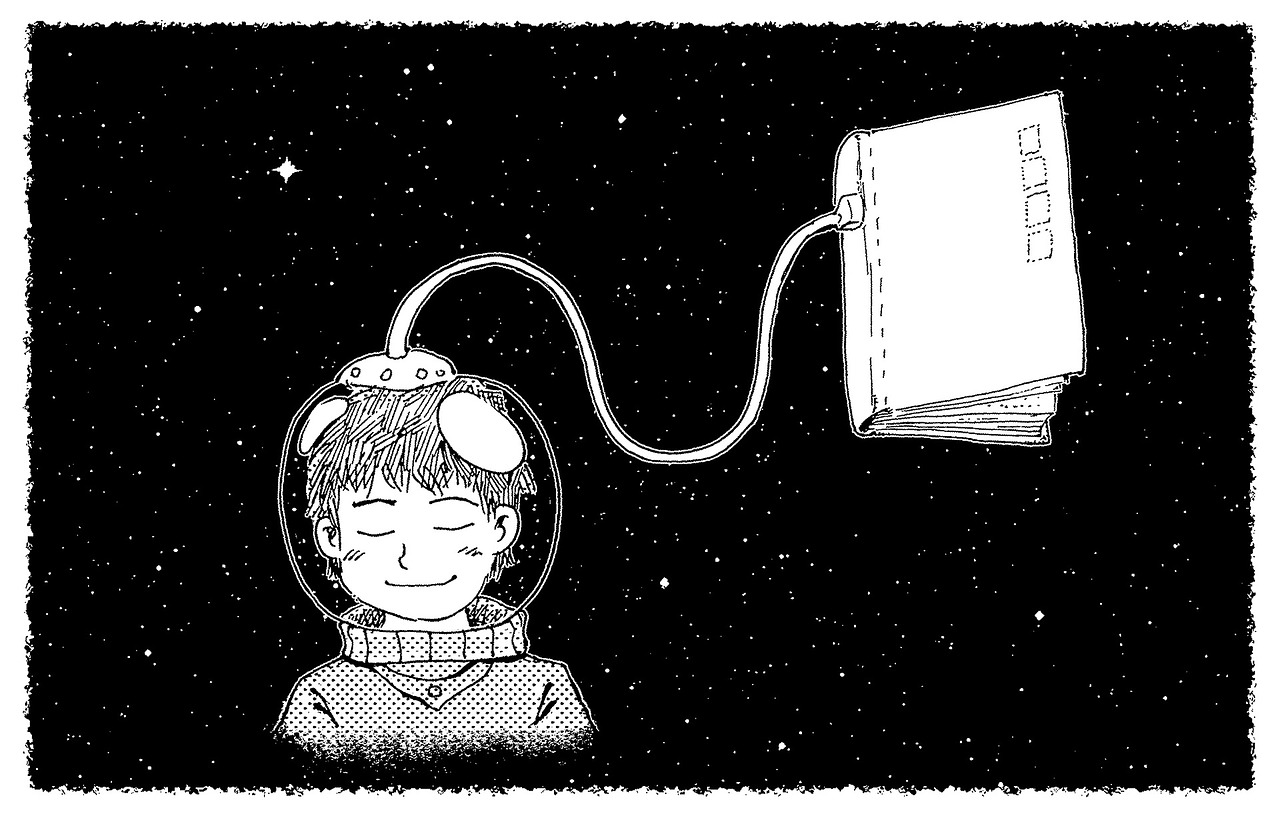
"Curiosity is nature's built-in exploration bonus. We're evolved to leave the beaten track, to try things out, to get distracted and generally look like we're wasting time. Maybe we are wasting time today, but the learning algorithms in our brain know that something we learnt by chance today will come in useful tomorrow." - Tom Stafford
This week's exciting news of the discovery of several Earthlike, potentially life-sustaining planets 40 light years from our own solar system is the perfect illustration of the big payoffs of curiosity, a strength of character that drives us as individuals and as a species to explore the vast unknown and to gather knowledge and experiences for their own sake. Curiosity about space is one area of inquiry that's found an outlet for expression in video games, and games like Kerbal Space Program can, in turn, stoke the fire of teens' curiosity about science and technology. iThrive's Creative Director, Heidi McDonald, shares a story about her son's experience with Kerbal:
"A couple of years ago, my (then) 10-year-old son—who is not especially passionate about science (he's more of a performer at heart)—became obsessed with trying his hand at rocket launches thanks to the video game,Kerbal Space Program. This rocket-building simulation game lets players use concepts from actual rocket science to conduct space explorations and send Kerbals—adorable green creatures that resemble the Minions from Despicable Me—to the "Mun" and other destinations in the Kerbal universe. My son's favorite character in the game was a Kerbal named Jebediah, and he poured hours into finding a way to get that lovable creature to the Mun.
"The day came when the in-game mission was a go. My son sat rapt, watching as the rocket containing his friend Jebediah went up, up, up toward the Mun...but then missed the Mun completely, and flew directly toward the sun. Apparently, the calculations were a bit off. All my poor boy could do was sob as he watched his favorite Kerbal float helplessly toward the Sun.
Fortunately, the Kerbal Space Program developers weren't so cruel as to have Jebediah char to a crisp. Instead, Jebediah's ship was now in constant orbit around the Sun. From then on, whenever my son played, he would sigh deeply each time he saw Jebediah make another revolution—a sad reminder of how he had failed his buddy. "I'm so sorry, little dude!" he would say every time.
We talked about whether or not he should just reinstall the game. The potential issue with doing that was it might mean that he'd never see Jebediah again, depending on the way the game was designed. Games like The Sims randomly create a set of characters to populate the world for gameplay. This is called procedural generation. My son and I didn't know whether the Kerbals were procedurally generated or not. If they were, he could reload the game, but Jebediah would not exist in that new version. My son wondered, do I continue to watch my friend orbit the Sun forever, or do I reload with a chance of never meeting him at all? It was the most intense existential crisis I've ever seen a 10-year-old have.
As it turned out, I was headed to IndieCade that October. Kerbal Space Program was going to be exhibiting there, and my son begged me to ask the developers about procedural generation in their game. When I approached Kerbal animator Daniel Rosas (not at all crying or grabbing him by the lapels and explaining my son's desperation!) he kindly invited my son to email him directly with his questions. As it turns out, most characters in Kerbal Space Program are procedurally generated, but there are six which were specifically created...and Jebediah is one of the six! This gracious developer also explained that it was possible, using the real science in the game, to mount a rescue mission and bring Jebediah back from the Sun!
My son was THRILLED to hear this. He emailed the developer and in return got a few tips on how to mount that rescue mission. He was adamant that he didn't want the answers—only clues to help him figure it out for himself. It took him seven more months, but, with curiosity as his motivation, he was finally able to rescue his favorite character. And he eventually conducted a successful space mission that put Jebediah on the Mun."
Games have the power to inspire our curiosity about science, technology, and the world around us, and this was clear watching a 10-year-old boy play Kerbal Space Program. Heidi reports that she had never seen her son so passionate about wanting to explore what he didn't know as when he was playing the game. Suddenly, he was asking philosophical questions, questions about the design of the game itself, and questions about things like torque and trajectory that he needed to investigate to get Jebediah home and to the Mun. His curiosity gave him the tenacity to go straight to the developers for answers.
Kerbal Space Program created a fantastic environment for a young boy to exercise his curiosity about how things work, and it made him want to mount his own space missions. The developer went one step further to individually encourage and reward his curiosity. We don't know if he will ever be motivated to scan the skies for habitable planets as a career, but if he is, there's a good chance that the seed of his curiosity was planted by a great video game.
Check back with us next week, when we'll dig into other ways games might prompt players to practice curiosity.
What games have made you curious about science, game development, or the wider world?
I Haven’t Leveled Up…Yet: Growth Mindset in Video Games (Part 2)
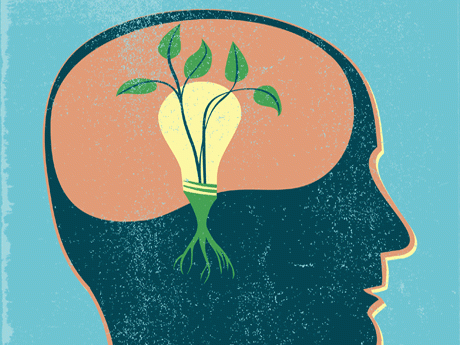
Note: This article is part of a series that captures game industry experts' opinions on game titles and mechanics that might boost players' positive habits, mindsets, and skills. These insights arose from discussions at an iThrive-sponsored think tank with game developers and scholars.
Last week, we introduced the idea that video games like The Sims might encourage what Carol Dweck calls a growth mindset—the belief that abilities are not fixed but can improve through effort.
Research with thousands of young people has shown that a growth mindset boosts achievement, motivation, and persistence. The research on growth mindset in digital games, however, is limited and has focused on "serious games" (those with a primary purpose other than entertainment) like Refraction, a math game that uses a "brain points" incentive system to reward effort and use of strategies instead of just correct answers.
We at iThrive were curious about how existing entertainment games might also foster the mindset that abilities can be built one step at a time. So we asked some experts to weigh in.
ITHRIVE DESIGN HIVE
We hosted a think tank ("Design Hive") with six video game experts to gather some insights about the potential for entertainment games to boost skills like growth mindset that are important for teen thriving. These industry experts—a mix of developers and scholars—met with us over a long weekend to trade reflections on games and design features that open the door to positive practices like growth mindset, even if by accident.
Here are seven ways the experts thought games might support a growth mindset:
- The Buster Principle. The Buster Principle encourages game developers to ensure that games "recognize" when players have hit a wall. In the "brain points" version of Refraction, for example, players have the option to start a new level after 3 minutes of struggle without success. It is important for growth mindset that players don't give up completely just because they don't (YET) have the skill to succeed at one specific task. The Buster Principle urges game developers to design for sustained perseverance by making the task just a little easier when players have repeatedly failed, arguing that, "A small decrease in the difficulty may be the difference between an unhappy player throwing the controller across the room and an ecstatic player rejoicing and pumping their fists upward with a sense of accomplishment." - 100 Principles of Good Game Design
- Leveling up. This basic feature of role-playing games (RPG's) like World of Warcraft is one reason so many people find them endlessly engaging. Similar to the brain points system of Refraction, small actions completed over time in RPG's accumulate experience points (XP), skills, and stats that let players "level up," becoming more powerful and effective.
- Learning how NOT to die. It turns out that both adults and children with a growth mindset pay more attention to what they do wrong. It might sound counterintuitive to thrive by focusing on your errors, but what it really means is that people with a growth mindset aren't afraid of their mistakes. They know that mistakes contain super important information. In some video game genres, including platformers like Super Mario Bros., errors in timing = virtual lives lost (just Google "Ways to die in Super Mario Bros"). This is fantastic motivation for paying close attention to errors: ensure they'll teach you how to survive longer next time. Video games may be safe spaces to learn from failing, instead of letting it shut down effort (or the player).
- Visualizing the growth you're headed for. Games have many methods for showing players where they're headed if they persist. Progress maps show players where they've been and what's left to explore, lending meaning and direction to each small step. Ability trees in games like World of Warcraft and Final Fantasy XV let players plan for which skills they will choose when they level up, giving a concrete destination for incremental progress. These games tend to feature visual reminders of the effort put in over time, such as more intimidating armor for players who have achieved more.
- Literal growth through effort. Games like Dominion, Castles of Mad King Ludwig (both tabletop games), Clash of Clans, and Civilization highlight the literal move-by-move strategic growth of a kingdom, castle, or empire. In games like these, effort and persistence manifest as expanded influence and control and bigger and more impressive castles. In Pokémon Go, players' persistent effort enables them to evolve the creatures they've collected into bigger, more powerful fighters.
- Rewarding dogged persistence. Masocore games and challenging platformers like Spelunky, with its ever-changing levels and traps, reward players who stick with it. Games like these may not make much use of the Buster Principle—they're designed for those who really want a challenge, like gamers with a Mastery motivation. It would be interesting to learn if players who already practice growth mindset are more interested in mastery and more attracted to games like this in the first place.
- Gamifying real-life growth. "Helper apps" and websites with game-like elements such as Fitbit, Lumosity, and Happify track incremental progress towards physical, cognitive, and emotional fitness, respectively. They are built on the premise that growth through effort is possible, and they make that growth measurable and accessible through game-like interfaces.
Because games are designed to be beatable and fun, there is an inherent optimism that we can succeed, given enough time and effort. We expect games to challenge us and to present a learning curve, but we also trust that they will teach us the strategies and skills we need to progress. And some games will inevitably do this better, or more intentionally, than others.
Our Design Hive experts recommend these games (and gamified "helper apps") that are developmentally appropriate for teens and may provide opportunities to practice growth mindset*:
- Fitbit: A wearable tracker that charts progress towards healthy habits like exercise.
- Lumosity: Online brain training that hones players' mental speed, flexibility, memory, attention, and problem-solving skills.
- Happify: Online "games" that help build habits like gratitude that boost happiness.
- The Sims series: Players create and customize characters, then guide them through the ups and downs of life, befriending other Sims and building a range of interesting skills from charisma to alchemy.
- Pokémon series: Gotta catch 'em all! Players explore their surroundings to catch Pokémon, then train and evolve them into powerful battlers.
- Spelunky: A platformer set underground where levels are randomized, challenging players in new ways every time.
- Super Mario Bros. series: A classic platformer with many variations and lots of chances to hone timing skills.
- Dominion: A card game where players are ambitious monarchs, challenging one another to build the largest, most civilized kingdom.
- Castles of Mad King Ludwig: A tile-laying board game with the goal of building an extravagant castle room by room.
- Civilization series: A turn-based strategy game centered on building an empire.
- Clash of Clans: A strategy game where players train raiders to fill their coffers.
- RPG's: Role-playing games like Final Fantasy XV and World of Warcraft let players aim to achieve a set of skills in areas that interest them, and see their persistence pay off one level at a time.
Have you played any of these games? How have they (or other games) helped you or someone you know to practice growth mindset? Share your story!
For more guidance on adopting a growth mindset, read this.
*Note: iThrive produced the curated games list in a joint effort with expert game developers and scholars. Their recommendations are rooted in evidence-based definitions and examples of growth mindset provided by iThrive. These games have not been scientifically proven to boost growth mindset, but they contain features that appear to provide opportunities to develop it.
I Haven’t Leveled Up…Yet: Growth Mindset in Video Games (Part I)
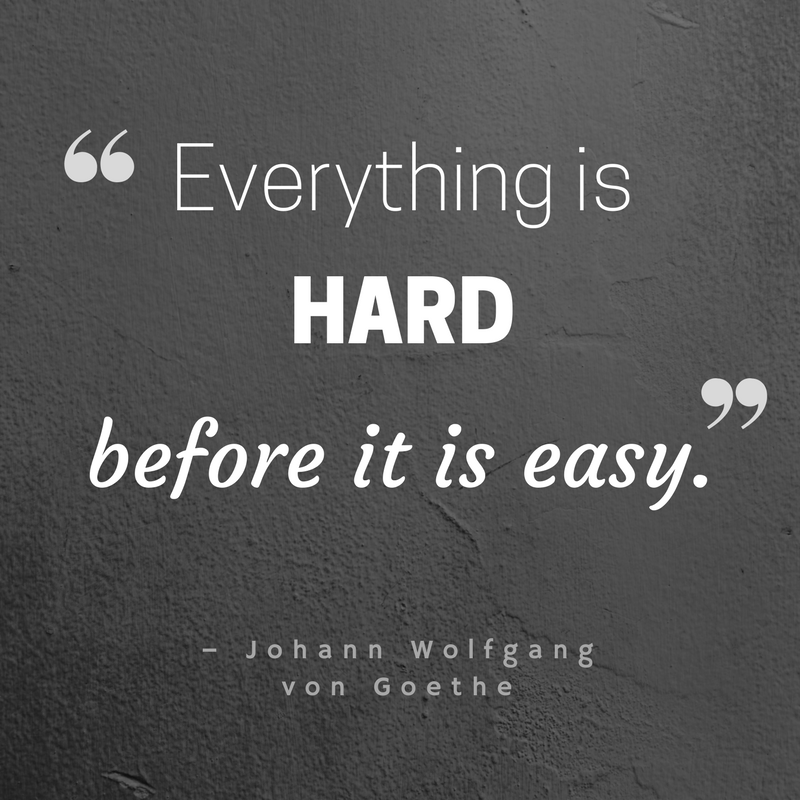
The first time that I realized that social skills can be developed was, ironically, not in my job at a social and emotional learning research lab. It was when I first played The Sims 3.
I had spent maybe 20 minutes lovingly putting the finishing touches on my Sim, getting her eyebrow shape and her personality quirks just right, until she was a (slightly thinner) mini-me named Victoria. I was, for whatever reason, thrilled by the prospect of guiding her through the mundane activities of daily life in miniature on my computer screen.
I bought her a house and set her off on her daily tasks of burning spaghetti, falling asleep in random places when I didn't get her to bed on time, and going to the bathroom, like, a lot. But it was delightful.
I was getting into a routine when a message popped up on the screen. "Victoria wants to socialize! Invite some people over to give your Sim a mood boost." I hovered the mouse over "Throw a party" and saw that I'd have a limited amount of time to host a get-together which would be judged by my guests. I hesitated but clicked, curious to see what would happen.
When Sims of all shapes and sizes strolled through the front door and started making themselves comfortable in Victoria's house, my heart actually started beating a little faster. In real life, I hate throwing parties. The pressure to have fun and be fun is sometimes too much for this introverted homebody. So, my Sim guests put me a little on edge. Sure, they were just NPC's, but I felt almost the same urgent need to impress and entertain them as I might in real life.
I greeted a Sim named Tom and was taken aback when a bright red minus sign lit up over his head, indicating that I had said something he didn't like. "Tom thinks Victoria is being boring," a notification informed me. And, after another attempt, "Tom thinks Victoria is being awkward."
Fantastic. I am hopelessly awkward and even the game knows it! There's nothing I can do about it. About a million middle school social traumas flooded my mind.
I turned to my (real-life) husband and demanded, "Why don't these dumb Sims like me?!" "Well," he grinned, noticing I had maybe spiraled just a little, "it usually starts out like that. But you can compliment your guests and joke around to win them over. Just keep doing it over and over again."
He patiently showed me the dialogue options with the best chances of success, and soon I had triggered enough plus signs (see photo) to get feedback like "friendly" and "amusing." Aha! I could grow my social skills here little by little. First impressions didn't mean everything. After several interactions, Tom became my friend.
It occurred to me after some practice striking up and maintaining friendships in The Sims 3 that, in real life, there are concrete, meaningful actions anyone can take to build and nurture friendships despite shyness or anxiety. Regular contact, sharing jokes, giving sincere compliments, and showing genuine interest in other people's likes and feelings are deposits in the friendship bank that add up over time.
This was easy for me with some people in my life, but when I was meeting someone for the first time or felt some anxiety in a new group, I found myself conjuring up memories of Sims gameplay as a reminder to get to the basics of social interaction—smile, tell a joke, compliment. Having played out the scripts in a virtual space and getting positive feedback (and new friends) was crossing over to my life outside of the game.
I began to visualize an imaginary Sims-inspired "friendship meter" filling up in my real life each time I struck up a conversation with someone new or finally scheduled that coffee date with an old friend after too many months. My usual anxiety of meeting new people was not as high. (Thanks, Sims!)
GROWTH MINDSET
The Sims, I would argue, is one example of a digital game that plants the seed of what Carol Dweck calls "growth mindset." Growth mindset is the belief that abilities aren't fixed or static, but that trying and effort make a difference in how sociable or proficient in math a person can become. It doesn't mean that everyone has the same potential in every area. It does mean that applying optimism, effort, and effective strategies has the potential to move the dial on the skills you'd like to improve.
Dweck and colleagues including Eleanor O'Rourke recognized the potential for digital games (in this case, an educational computer game called Refraction) to train growth mindset. They collaborated with game scientists to create a modified incentive system that, in their words, was "designed to reward the micro behaviors that are indicative of productive struggle." In other words, their "brain points" system rewards small, incremental actions like trying a new strategy or starting over, instead of rewarding only the slightly longer-term achievement of completing the level.
The researchers found that the 7,500 students who played the version of Refraction with the "brain points" reward system stuck with the game longer and used more strategies than the students who received traditional "level completion" rewards—and they also were more engaged and persistent.
The research on growth mindset in digital games is limited and has focused on serious games—games designed for a primary purpose other than entertainment. But experiences with entertainment games like The Sims made us at iThrive wonder what other types of games already out there could be mined for growth mindset principles. And what would happen if more developers deliberately designed games to boost skills like growth mindset using principles of great game design?
We've sat down with expert game developers and scholars to discuss just that. Check in with us next week for Part 2 to see what we discovered!
Has a game ever helped you or someone you know to practice growth mindset? Share your story!
For more guidance on adopting a growth mindset, read this.
Thriving Teens Use Their Superpowers

DISCOVERING AND USING STRENGTHS IS A PATH TO TEEN THRIVING.
Teens have superpowers. Need evidence?
Consider Malala Yousafzai. At just 15, she defied the Taliban by insisting on her (and all girls') right to go to school. The Taliban shot her in the head, and she survived. Then, she strode right back into the classroom and the public eye to promote equal access to education for all. At 17, she became the youngest Nobel Peace Prize winner ever. Her superpowers: bravery, a thirst for learning, perseverance, and a passion for justice.
Malala's superpowers are on display for the world to see. But each teen has his or her very own set (even if they're hidden under a Peter Parker hoodie for the moment). What are these superpowers? They're the strengths of character that form the foundation of a person's unique impact on this world.
TEENS SET THE STAGE FOR THRIVING WHEN THEY DISCOVER AND USE THEIR STRENGTHS.
Using strengths to thrive is a keystone of positive psychology. Martin Seligman and Christopher Peterson, founders of the field, identified 24 universally valued strengths—including hope, zest, and kindness—that form the pillars of thriving. According to Seligman's model of flourishing, individuals who discover and use their strengths are taking active steps to generate the 5 components of well-being in their lives: positive emotions, engagement, achievement, good relationships, and meaning. Put simply, teens can use their strengths to feel good, do good, do well, and connect both with others and a greater purpose.
Research backs up the link between strengths and well-being for teens, and even shows that strengths can give teens an academic advantage in school. What's more, some studies suggest that cultivating strengths may have a bigger payoff for personal growth and well-being than "fixing" weaknesses.
HOW DO TEENS DISCOVER AND BUILD THEIR STRENGTHS?
Like muscles, strengths of character can be enhanced over time with attention and effort. And, compared to adults, teens' efforts to grow their strengths might be especially effective. That's because teens' brains are remarkably plastic. This malleability makes the teen years a perfect time to learn and build positive habits that can last a lifetime.
At iThrive, we encourage teens to take charge of their well-being by finding opportunities in both the real and virtual worlds to practice habits that align with the strengths of positive psychology.
Here are three things teens can do right now to reveal and strengthen their superpowers:
1. BE CURIOUS.
Exploring different identities and possible future selves is a key part of teens' development. Make strengths a part of that exploration. Teens can take the free VIA Youth Survey to discover their signature strengths. Once those are tallied up, teens can ask themselves: Where did my strengths come from? How and where can I use them more often? How far can I take them?
2. ADOPT A GROWTH MINDSET.
How far can teens take their strengths? Time will tell for each individual. But teens are likely to feel motivated to grow their strengths if they believe their abilities can be stretched and magnified through effort. Teens who think in this optimistic and expansive way are practicing what Carol Dweck calls growth mindset, a state of mind that has established links to achievement and resilience among youth. One way to cultivate a growth mindset is to frame failures as opportunities to learn.
3. PLAY!
Play expert, Stuart Brown, argues that humans of all ages are built to play and learn important skills through play. For teens, video games are one socially acceptable way to incorporate playfulness regularly into their lives (Related: Why Do Teens Play Video Games?). And through this type of play, teens stand to improve their self-awareness. Video games prompt players to constantly reflect on their skills and strengths in order to assess their readiness to take on the challenges at hand. Many video games also offer the opportunity to try on a range of identities and roles. Does a particular teen gravitate towards embodying the healer, the warrior, the builder, the explorer? These tendencies may uncover strengths that teens can explore further in their offline worlds.
Have video games ever helped you identify one of your signature strengths? Tell us about it.
